Category
Publishing
17 entries in this category | view all categories
19th Century Game Theory
Posted October 2020 in Alternate Processes, Cameras, Engraving, Games, History of Photography, New Additions, Publishing
19th Century amateur photographers faced trials and tribulations in mastering their new found craft, put into the spotlight after photography itself became a growing mass medium with the marketing of Kodak’s #1 box camera in late 1888.
In 1889, taking advantage of this new large audience-by giving them a fun diversion- the Milton Bradley company of Springfield, Massachusetts produced what is believed to be the world’s first card game on photography, one they called “The Amateur Photographer”. So now, the agony and ecstasy experienced by those dedicated amateurs who owned more advanced cameras and maintained wet darkrooms while embracing art and science could be enjoyed by all. PhotoSeed recently acquired 24 cards of this game from the original set of 36.
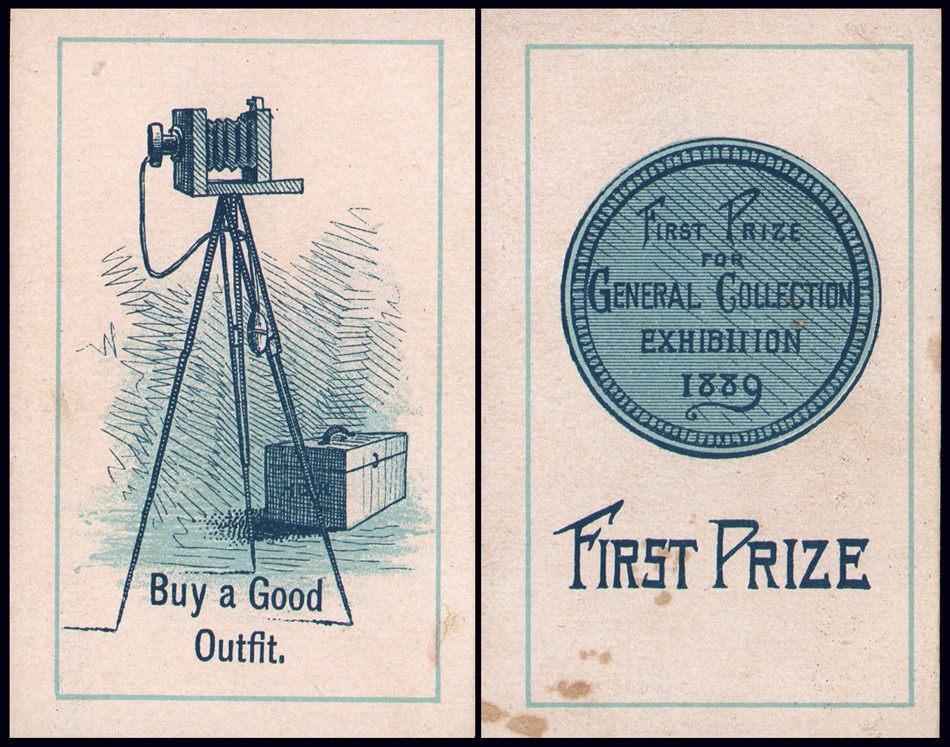 Left: “Buy a Good Outfit” : Right: “First Prize”. 1889. Individual coated-paper lithographic playing cards measuring 8.9 x 5.6 cm (3.5 x 2.25”). Milton Bradley Company, Springfield, MA. The cards making up the game “The Amateur Photographer” were illustrated to show “the triumphs and “hard luck” of an amateur photographer in a way that no member of the craft can fail to appreciate”. From: PhotoSeed Archive
Left: “Buy a Good Outfit” : Right: “First Prize”. 1889. Individual coated-paper lithographic playing cards measuring 8.9 x 5.6 cm (3.5 x 2.25”). Milton Bradley Company, Springfield, MA. The cards making up the game “The Amateur Photographer” were illustrated to show “the triumphs and “hard luck” of an amateur photographer in a way that no member of the craft can fail to appreciate”. From: PhotoSeed Archive
The directions for this Victorian card game can be seen printed below in a vintage advertisement for the 1889-90 Milton Bradley Company “Catalogue of Games, Sectional Pictures, Toys, Puzzles, Blocks and Novelties”.
For the most part up to the present day, physical card ⌘ and board games have never featured the character of the photographer, although video games beginning in the 1990’s have included many, including: “Polaroid Pete” (1992), “Pokémon Snap” (1999), “Dead Rising” (2006): excerpt: “gamers play photojournalist Frank West, who somehow got stuck in a shopping mall in Colorado during the zombie apocalypse. Frank has to fight his way out through hoardes of zombies and uncover the truth with his camera.” and “Spiderman 3” (2007).
Instead, popular culture has taken the lead, with the larger than life character of the photographer (for good and bad) celebrated in films taking hold in our collective imaginations. Some that come to mind by this writer include James Stewart’s character spying out his apartment window using a telephoto camera lens in Alfred Hitchcock’s masterful film “Rear Window”, (1954) and Peter Parker’s more recent alter-ego occupation sans Spiderman suit. Enjoy the following select game cards from this surviving set.
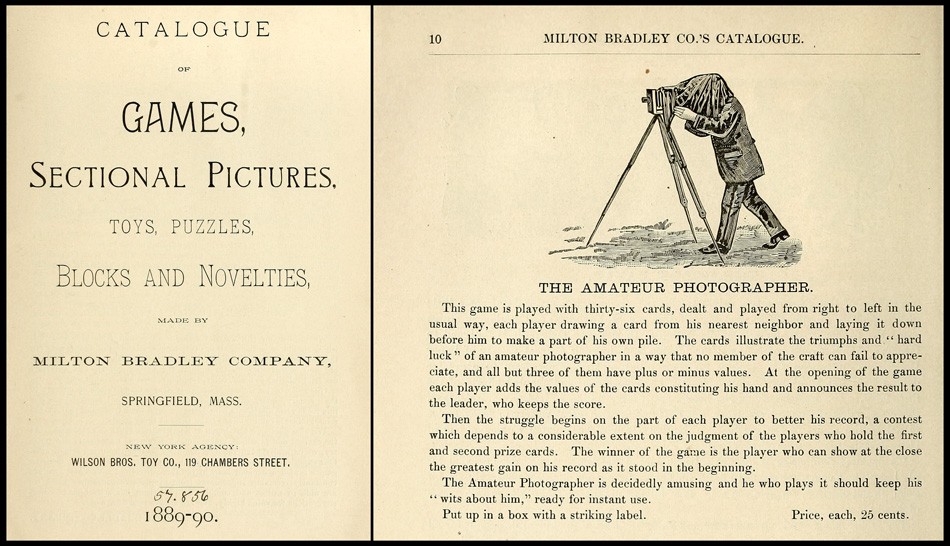 Left: Title Page from “Catalogue of Games, Sectional Pictures, Toys, Puzzles, Blocks and Novelties Made by Milton Bradley Company”. Right: Catalogue listing for card game “The Amateur Photographer” in same volume, 1889-90. (p. 10) Courtesy: Internet Archive
Left: Title Page from “Catalogue of Games, Sectional Pictures, Toys, Puzzles, Blocks and Novelties Made by Milton Bradley Company”. Right: Catalogue listing for card game “The Amateur Photographer” in same volume, 1889-90. (p. 10) Courtesy: Internet Archive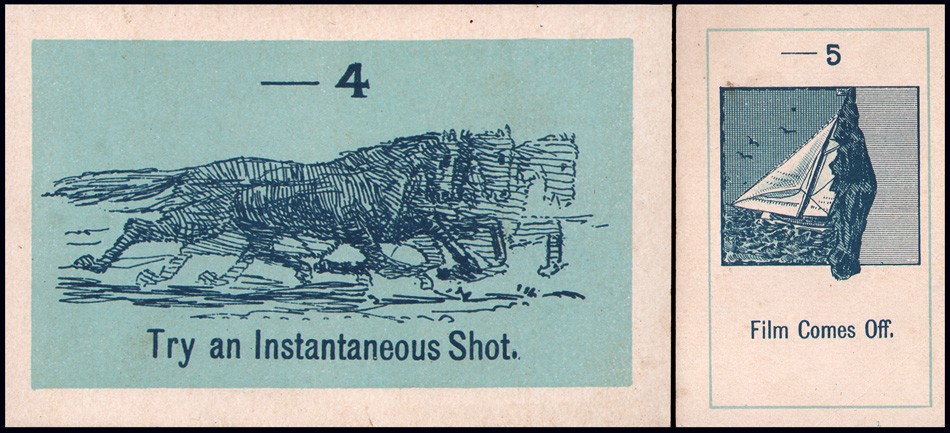 Left: “Try an Instantaneous Shot” : Right: “Film Comes Off”. 1889. Individual coated-paper lithographic playing cards measuring 8.9 x 5.6 cm (3.5 x 2.25”). Milton Bradley Company, Springfield, MA. The cards making up the game “The Amateur Photographer” were illustrated to show “the triumphs and “hard luck” of an amateur photographer in a way that no member of the craft can fail to appreciate”. These two negative value cards show two common problems: film emulsion sensitivity or improper camera settings on left card reveals the amateur’s error of not being able to “stop” the action of a race horse while the chemical darkroom problem of a peeling film emulsion (washing too vigorously perhaps?) ruining the masterwork of a sailboat photograph at right. From: PhotoSeed Archive
Left: “Try an Instantaneous Shot” : Right: “Film Comes Off”. 1889. Individual coated-paper lithographic playing cards measuring 8.9 x 5.6 cm (3.5 x 2.25”). Milton Bradley Company, Springfield, MA. The cards making up the game “The Amateur Photographer” were illustrated to show “the triumphs and “hard luck” of an amateur photographer in a way that no member of the craft can fail to appreciate”. These two negative value cards show two common problems: film emulsion sensitivity or improper camera settings on left card reveals the amateur’s error of not being able to “stop” the action of a race horse while the chemical darkroom problem of a peeling film emulsion (washing too vigorously perhaps?) ruining the masterwork of a sailboat photograph at right. From: PhotoSeed Archive
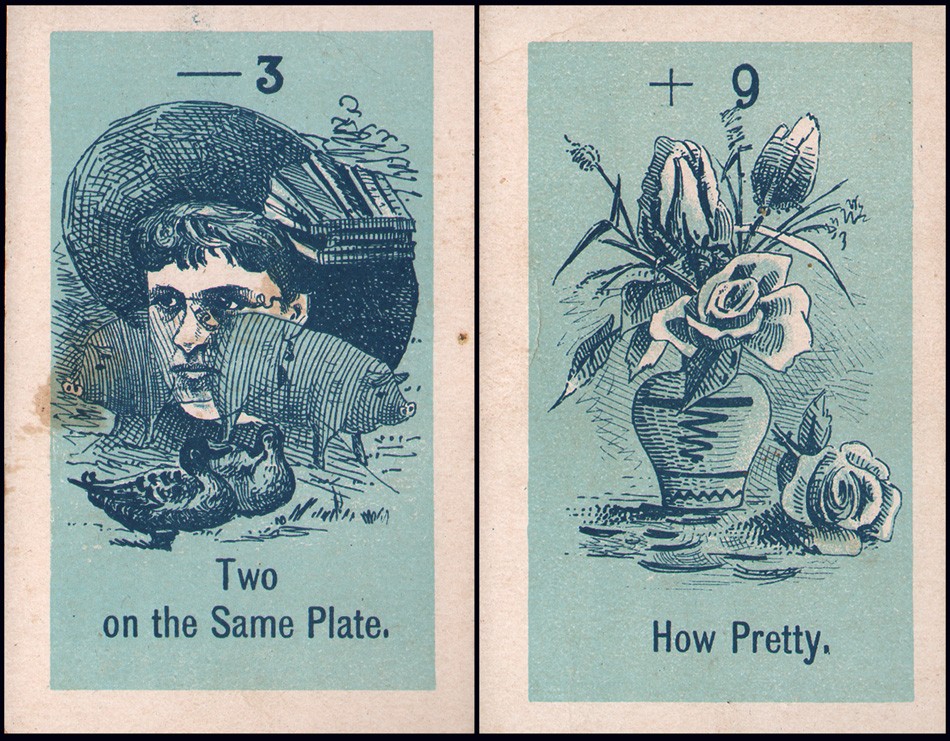 Left: “Two on the Same Plate” : Right: “How Pretty”. 1889. Individual coated-paper lithographic playing cards measuring 8.9 x 5.6 cm (3.5 x 2.25”). Milton Bradley Company, Springfield, MA. The cards making up the game “The Amateur Photographer” were illustrated to show “the triumphs and “hard luck” of an amateur photographer in a way that no member of the craft can fail to appreciate”. The negative value card at left shows the common problem of exposing the same photographic plate twice for two different scenes while at right, a positive value card shows a seemingly perfect picture of a bouquet of flowers. From: PhotoSeed Archive
Left: “Two on the Same Plate” : Right: “How Pretty”. 1889. Individual coated-paper lithographic playing cards measuring 8.9 x 5.6 cm (3.5 x 2.25”). Milton Bradley Company, Springfield, MA. The cards making up the game “The Amateur Photographer” were illustrated to show “the triumphs and “hard luck” of an amateur photographer in a way that no member of the craft can fail to appreciate”. The negative value card at left shows the common problem of exposing the same photographic plate twice for two different scenes while at right, a positive value card shows a seemingly perfect picture of a bouquet of flowers. From: PhotoSeed Archive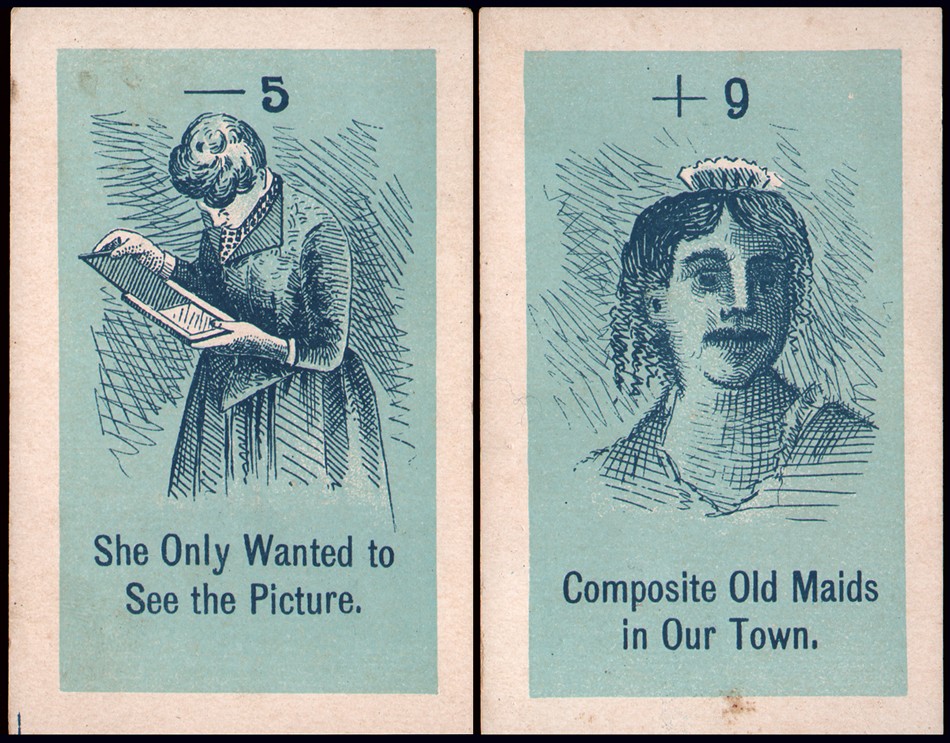 Left: “She Only Wanted to See the Picture” : Right: “Composite Old Maids in Our Town”. 1889. Individual coated-paper lithographic playing cards measuring 8.9 x 5.6 cm (3.5 x 2.25”). Milton Bradley Company, Springfield, MA. The cards making up the game “The Amateur Photographer” were illustrated to show “the triumphs and “hard luck” of an amateur photographer in a way that no member of the craft can fail to appreciate”. Gender sexism depicting the foibles of the female sex was alive and well when Amateur Photography first came into fashion- evidenced by the negative value card at left of a woman peeking at the results of an exposed photographic plate before the negative was properly fixed in the darkroom. Owing to the fact Photography was then a very expensive hobby and career opportunities for women in general were completely lacking, the majority of practitioners were men. But this would soon change, particularly after the dawn of the 20th Century, when Photography actually became one of the few occupations women were encouraged to pursue outside the home. At right, in a twist of this same gender sexism, a positive value card reveals itself in the form of this photographic portrait of an “old maid”, complete with mustache and tiara? or hair comb- with comparisons to later portraits of Queen Victoria by the card artist possibly being the so-called “humorous” intent. From: PhotoSeed Archive
Left: “She Only Wanted to See the Picture” : Right: “Composite Old Maids in Our Town”. 1889. Individual coated-paper lithographic playing cards measuring 8.9 x 5.6 cm (3.5 x 2.25”). Milton Bradley Company, Springfield, MA. The cards making up the game “The Amateur Photographer” were illustrated to show “the triumphs and “hard luck” of an amateur photographer in a way that no member of the craft can fail to appreciate”. Gender sexism depicting the foibles of the female sex was alive and well when Amateur Photography first came into fashion- evidenced by the negative value card at left of a woman peeking at the results of an exposed photographic plate before the negative was properly fixed in the darkroom. Owing to the fact Photography was then a very expensive hobby and career opportunities for women in general were completely lacking, the majority of practitioners were men. But this would soon change, particularly after the dawn of the 20th Century, when Photography actually became one of the few occupations women were encouraged to pursue outside the home. At right, in a twist of this same gender sexism, a positive value card reveals itself in the form of this photographic portrait of an “old maid”, complete with mustache and tiara? or hair comb- with comparisons to later portraits of Queen Victoria by the card artist possibly being the so-called “humorous” intent. From: PhotoSeed Archive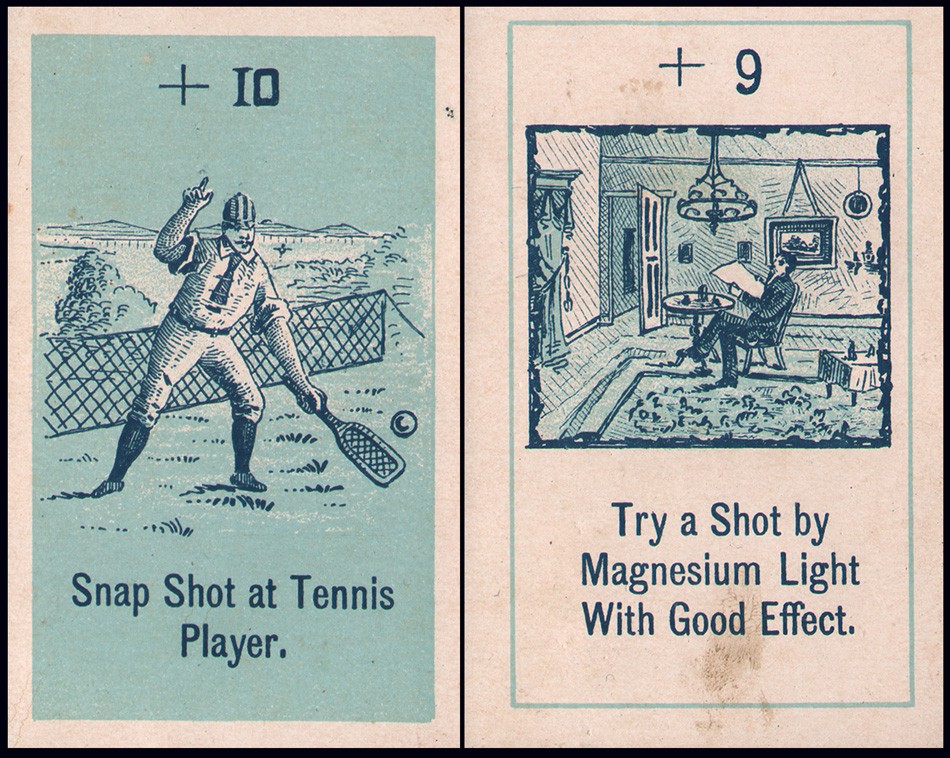 Left: “Snap Shot at Tennis Player” : Right: “Try a Shot by Magnesium Light With Good Effect”. 1889. Individual coated-paper lithographic playing cards measuring 8.9 x 5.6 cm (3.5 x 2.25”). Milton Bradley Company, Springfield, MA. The cards making up the game “The Amateur Photographer” were illustrated to show “the triumphs and “hard luck” of an amateur photographer in a way that no member of the craft can fail to appreciate”. These two high value cards reveal the very tricky technical goal of freezing sports action at left- something rarely attempted at the time- and at right, the undertaking of a so-called “flashlight” photograph. This was achieved on a photographic plate through the intense illumination given off during the ignition of flash powder made up of a mixture of nitrate and magnesium held off camera by the photographer. From: PhotoSeed Archive
Left: “Snap Shot at Tennis Player” : Right: “Try a Shot by Magnesium Light With Good Effect”. 1889. Individual coated-paper lithographic playing cards measuring 8.9 x 5.6 cm (3.5 x 2.25”). Milton Bradley Company, Springfield, MA. The cards making up the game “The Amateur Photographer” were illustrated to show “the triumphs and “hard luck” of an amateur photographer in a way that no member of the craft can fail to appreciate”. These two high value cards reveal the very tricky technical goal of freezing sports action at left- something rarely attempted at the time- and at right, the undertaking of a so-called “flashlight” photograph. This was achieved on a photographic plate through the intense illumination given off during the ignition of flash powder made up of a mixture of nitrate and magnesium held off camera by the photographer. From: PhotoSeed Archive
⌘ One exception found online by this website is the 2016 Japanese card game “Wind the Film!”, a half-frame camera photography themed card game for 2-4 players.
American Love Story
Posted August 2019 in New Additions, Publishing, Significant Photographs
“And I never saw that love did any harm anywhere or was complained about O my brothers when you understood it:
For that’s about all life comes to anyhow—comes to the love we can put into it:
I just give you what I’ve got, dear comrades.” -Horace Traubel
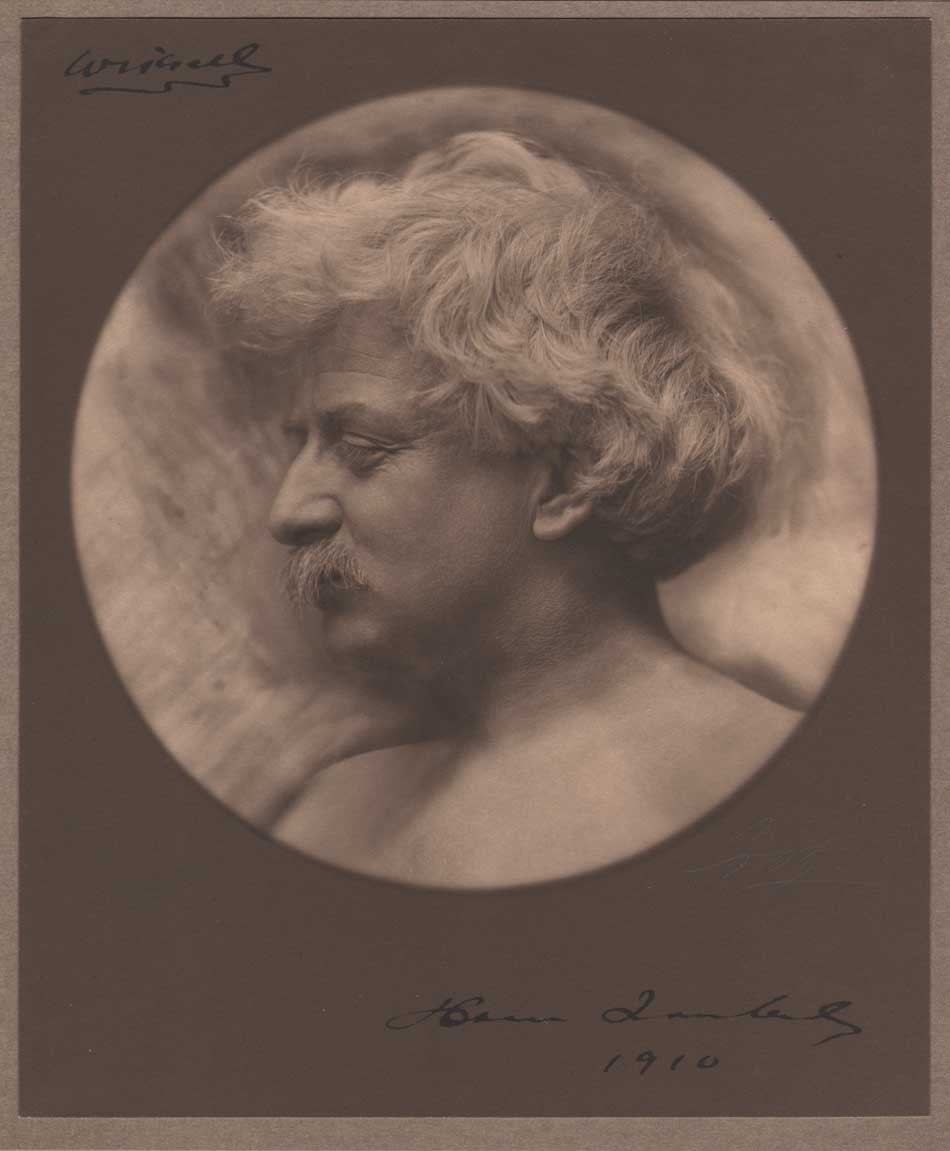 “Horace Traubel: Roundel Portrait” : Allen Drew Cook, American (1871-1923): 1910: mounted platinum print contained within folder: 17.4” roundel on paper 23.7 x 19.6 cm; supports: 24.8 x 20.6 | 28.4 x 23.9 cm. Folder: 29.4 x 48.8 cm. This print dedicated to Gustave Percival Wiksell (1863-1940): “Wiksell” in upper left corner of print recto; signed “Horace Traubel 1910” at lower right. Best remembered as the literary executor and biographer extraordinaire of America’s first national poet Walt Whitman, this uncommon profile portrait features the American editor and poet Horace Logo Traubel. (1858-1919) Traubel, a magazine publisher and committed socialist who held Whitman’s hand on his deathbed and earlier compiled nearly two million words over the the last four years in daily conversations with the poet, later transcribed and ultimately published what would become the nine volume opus: “With Walt Whitman in Camden”. From: PhotoSeed Archive
“Horace Traubel: Roundel Portrait” : Allen Drew Cook, American (1871-1923): 1910: mounted platinum print contained within folder: 17.4” roundel on paper 23.7 x 19.6 cm; supports: 24.8 x 20.6 | 28.4 x 23.9 cm. Folder: 29.4 x 48.8 cm. This print dedicated to Gustave Percival Wiksell (1863-1940): “Wiksell” in upper left corner of print recto; signed “Horace Traubel 1910” at lower right. Best remembered as the literary executor and biographer extraordinaire of America’s first national poet Walt Whitman, this uncommon profile portrait features the American editor and poet Horace Logo Traubel. (1858-1919) Traubel, a magazine publisher and committed socialist who held Whitman’s hand on his deathbed and earlier compiled nearly two million words over the the last four years in daily conversations with the poet, later transcribed and ultimately published what would become the nine volume opus: “With Walt Whitman in Camden”. From: PhotoSeed Archive
In this 200th anniversary year of American poet Walt Whitman’s birth, articles and exhibitions abound, celebrating the continuing relevance of America’s “Bard of Democracy”. But who was largely responsible for initially preserving, and thus memorializing for a larger audience this most important literary voice? A gentleman by the name of Horace Traubel. (1858-1919)
Three years ago I had the good fortune of purchasing a heraldic roundel portrait of Traubel, the one featured above taken by a fellow Philadelphian, pictorialist photographer Allen Drew Cook. (1871-1923)
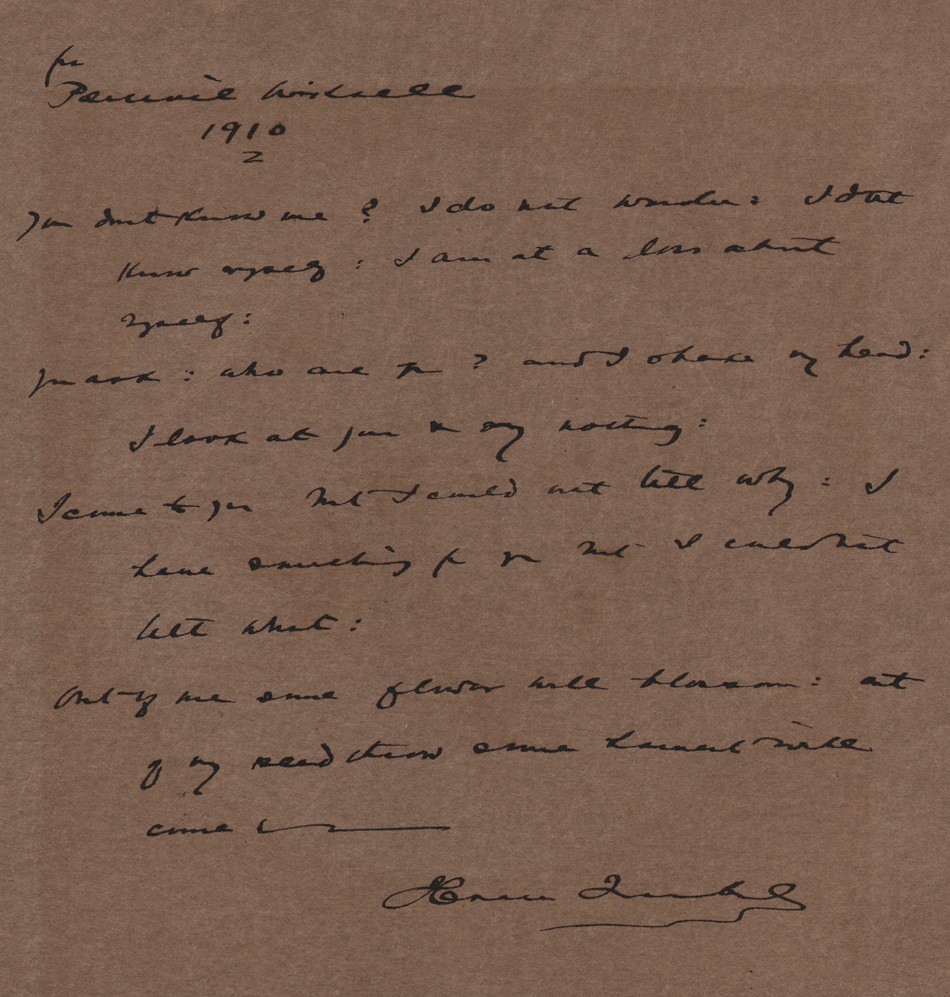 Lines addressed to Gustave Percival Wiksell (1863-1940) from the Horace Traubel poem “I Just Give You What I’ve Got” (from “Optimos”- 1910) in hand of author on inside front cover to folder containing photograph “Horace Traubel: Roundel Portrait”. Wiksell was a Boston dentist who served as president of the Walt Whitman Fellowship from 1903-1919. “You don't know me? I do not wonder: I dont know myself: I am at a loss about myself: You ask: who are you? and I shake my head : I look at you and say nothing: I come to you but I could not tell why: I have something for you but I could not tell what: Out of me some flower will blossom out of my seedthrow some harvest will come. - Horace Traubel”. Writing in the Mickle Street Review No. 16, (2004) U.S. scholar Michael Robertson’s article “The Gospel According To Horace: Horace Traubel And The Walt Whitman Fellowship” outlines Traubel’s and Wiksell’s relationship: “However, Traubel’s letters to Wiksell move beyond comradeship into physically explicit expressions of desire. “I dream of … the little bed in your paradise and the two arms of a brother that accept me in their divine partnership,”(114) Traubel wrote shortly before traveling to Boston. After his visit, he wrote longingly, “I sit here and write you a letter. It is not a pen that is writing. It is the lips that you have kissed. It is the body that you have traversed over and over with your consecrating palm. Do you not feel that body? Do you not feel the return?”(115) These and other letters leave little doubt that the two men had a sexual love affair, an affair that seems to have been remarkably guilt-free. Wiksell’s letters to Traubel refer to his own wife and child and mix heavy-breathing passion with cheery greetings to “Annie and Gertrude,”(116) Traubel’s wife and daughter.”(114-“I dream of”: Traubel to Wiksell, 3 Jan. 1904, WC.; 115-“I sit here”: Traubel to Wiksell, 12 May 1904, WC.; 116-“Annie and Gertrude”: Wiksell to Traubel, 30 Dec. 1901, TC.) From: PhotoSeed Archive
Lines addressed to Gustave Percival Wiksell (1863-1940) from the Horace Traubel poem “I Just Give You What I’ve Got” (from “Optimos”- 1910) in hand of author on inside front cover to folder containing photograph “Horace Traubel: Roundel Portrait”. Wiksell was a Boston dentist who served as president of the Walt Whitman Fellowship from 1903-1919. “You don't know me? I do not wonder: I dont know myself: I am at a loss about myself: You ask: who are you? and I shake my head : I look at you and say nothing: I come to you but I could not tell why: I have something for you but I could not tell what: Out of me some flower will blossom out of my seedthrow some harvest will come. - Horace Traubel”. Writing in the Mickle Street Review No. 16, (2004) U.S. scholar Michael Robertson’s article “The Gospel According To Horace: Horace Traubel And The Walt Whitman Fellowship” outlines Traubel’s and Wiksell’s relationship: “However, Traubel’s letters to Wiksell move beyond comradeship into physically explicit expressions of desire. “I dream of … the little bed in your paradise and the two arms of a brother that accept me in their divine partnership,”(114) Traubel wrote shortly before traveling to Boston. After his visit, he wrote longingly, “I sit here and write you a letter. It is not a pen that is writing. It is the lips that you have kissed. It is the body that you have traversed over and over with your consecrating palm. Do you not feel that body? Do you not feel the return?”(115) These and other letters leave little doubt that the two men had a sexual love affair, an affair that seems to have been remarkably guilt-free. Wiksell’s letters to Traubel refer to his own wife and child and mix heavy-breathing passion with cheery greetings to “Annie and Gertrude,”(116) Traubel’s wife and daughter.”(114-“I dream of”: Traubel to Wiksell, 3 Jan. 1904, WC.; 115-“I sit here”: Traubel to Wiksell, 12 May 1904, WC.; 116-“Annie and Gertrude”: Wiksell to Traubel, 30 Dec. 1901, TC.) From: PhotoSeed Archive
Best remembered as the literary executor and biographer extraordinaire of Walt Whitman, Horace Traubel was also a magazine publisher and committed socialist who held the poet’s hand on his deathbed and compiled nearly two million words over the last four years in daily conversations with him, later transcribing and publishing in his lifetime the first three volumes of what would become his nine volume opus: With Walt Whitman in Camden. (completed 1996)
Unlike Whitman, whom The Guardian newspaper notes in an article published this year “was also the 19th century’s most photographed American writer”, (1.) there are only a smattering of photographs featuring Traubel-most being credited to Cook. By and large, Horace Traubel is a figure in American letters most people have never heard of.
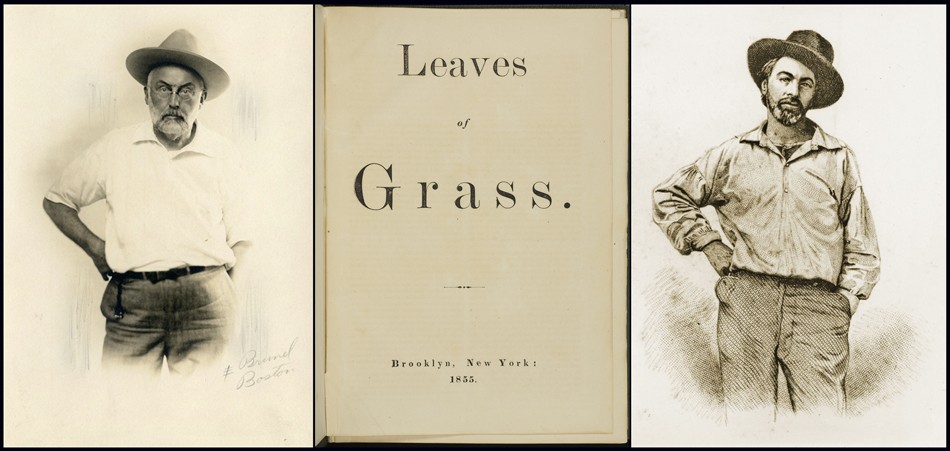 Left: “Gustave Percival Wiksell as Walt Whitman”: Undated gelatin-silver print by Emile Brunel Studio, Boston, ca. 1915-25?: Wearing similar clothing, Wiksell strikes a pose similar to one Whitman made from a lost daguerreotype by Gabriel Harrison later made into a steel engraving by Samuel Hollyer. Boston dentist Gustave Percival Wiksell was an ardent devotee to Walt Whitman and president of the Whitman Fellowship from 1903-19. Photograph © All rights reserved by tackyspoons/flickr. Middle: 1855 first edition title page to Leaves of Grass, Brooklyn, New York. Courtesy The Lilly Library, Indiana University. Right: Original Samuel Hollyer steel engraving of frontispiece portrait of Walt Whitman used for the 1855 and 1856 editions of Leaves of Grass.,Gabriel Harrison’s original 1854 daguerreotype showed the 35-year-old Whitman wearing laborer’s clothing. The Whitman Archive provides the following description of the original sitting: “Of the day the original daguerreotype was taken, Whitman remembered, "I was sauntering along the street: the day was hot: I was dressed just as you see me there. A friend of mine—”Gabriel Harrison (you know him? ah! yes!—”he has always been a good friend!)—”stood at the door of his place looking at the passers-by. He cried out to me at once: 'Old man!—”old man!—”come here: come right up stairs with me this minute'—”and when he noticed that I hesitated cried still more emphatically: 'Do come: come: I'm dying for something to do.' This picture was the result." Engraving courtesy Bayley Collection: Ohio Wesleyan via Walt Whitman Archive.
Left: “Gustave Percival Wiksell as Walt Whitman”: Undated gelatin-silver print by Emile Brunel Studio, Boston, ca. 1915-25?: Wearing similar clothing, Wiksell strikes a pose similar to one Whitman made from a lost daguerreotype by Gabriel Harrison later made into a steel engraving by Samuel Hollyer. Boston dentist Gustave Percival Wiksell was an ardent devotee to Walt Whitman and president of the Whitman Fellowship from 1903-19. Photograph © All rights reserved by tackyspoons/flickr. Middle: 1855 first edition title page to Leaves of Grass, Brooklyn, New York. Courtesy The Lilly Library, Indiana University. Right: Original Samuel Hollyer steel engraving of frontispiece portrait of Walt Whitman used for the 1855 and 1856 editions of Leaves of Grass.,Gabriel Harrison’s original 1854 daguerreotype showed the 35-year-old Whitman wearing laborer’s clothing. The Whitman Archive provides the following description of the original sitting: “Of the day the original daguerreotype was taken, Whitman remembered, "I was sauntering along the street: the day was hot: I was dressed just as you see me there. A friend of mine—”Gabriel Harrison (you know him? ah! yes!—”he has always been a good friend!)—”stood at the door of his place looking at the passers-by. He cried out to me at once: 'Old man!—”old man!—”come here: come right up stairs with me this minute'—”and when he noticed that I hesitated cried still more emphatically: 'Do come: come: I'm dying for something to do.' This picture was the result." Engraving courtesy Bayley Collection: Ohio Wesleyan via Walt Whitman Archive.
But concerning the roundel portrait of Traubel, what a difference between it and the staid portraits published during his lifetime! The seller described it thus: “Vintage Risque Photo Handsome Shirtless Man w/ Love Poem c. 1910 Gay Interest”. If you are a collector like me, the proverbial eye roll is something experienced practically every day in the course of searches for new treasure. To wit: if it’s a photo depicting two men together- or for that matter, two women- a seller might add the descriptor of “Gay Interest” to the listing. This is laughable on the face of it, as to my mind there is often a complete disconnect between reality often taking over the minds of sellers intent on rewriting photographic evidence for the sole purpose of making a quick buck.
But not always. Fortunately for me, and unbeknownst to the seller, I had a hunch who the sitter of this portrait was. My offer accepted, I only later determined “gay interest” was only the tip of the iceberg.
After some sleuthing, I discovered this portrait had seemingly been published only one time in 1919: as the dust-jacket illustration to a limited-edition posthumous work on Traubel written by his biographer David Karsner, a close friend who describes him as part Karl Marx and Jesus of Nazareth, and “in possession of a point of view which issues a labor-conscious ‘warning and challenge.” (2.)
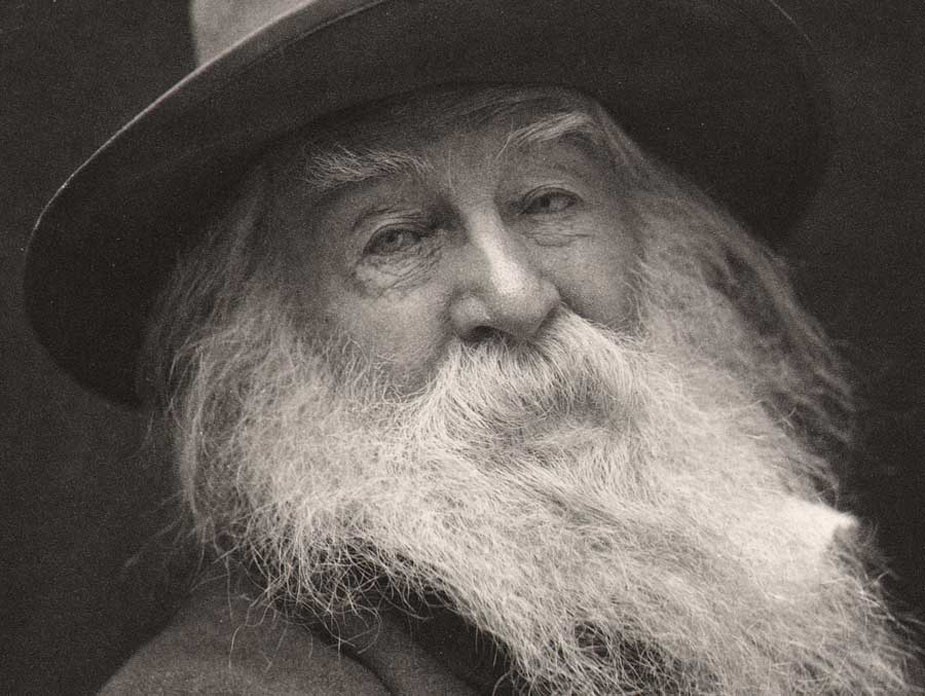 Detail: 1887: Walt Whitman-1819-1892 by George C. Cox: (portrait known as the "Laughing Philosopher") 23.9 x 18.8 cm | 45.2 x 33.3 cm: vintage large format, hand-pulled photogravure printed circa 1905-10 by the Photographische Gesellschaft in Berlin on Van Gelder Zonen plate paper. From: PhotoSeed Archive
Detail: 1887: Walt Whitman-1819-1892 by George C. Cox: (portrait known as the "Laughing Philosopher") 23.9 x 18.8 cm | 45.2 x 33.3 cm: vintage large format, hand-pulled photogravure printed circa 1905-10 by the Photographische Gesellschaft in Berlin on Van Gelder Zonen plate paper. From: PhotoSeed Archive
But unlike the aforementioned staid portraits, which always show him wearing a shirt or jacket- this profile view was unusual for the time in which it was made- 1910-bare-shouldered, and thus sans shirt. When I finally made out the signature of the person this particular print was dedicated to-personally inscribed by the sitter on the print surface recto to someone named “Wiksell” in the upper left corner, it all came together. For on the inside cover of the folder in which this portrait appears (when purchased it was framed) Traubel has inscribed several lines- a love poem, if you will, confirming the sellers hunch, “For Percival Wiksell- 1910” :
You don’t know me? I do not wonder: I dont know myself: I am at a loss about myself:
You ask: who are you? and I shake my head : I look at you and say nothing:
I come to you but I could not tell why: I have something for you but I could not tell what:
Out of me some flower will blossom out of my seedthrow some harvest will come. - Horace Traubel
(From Optimos: “I Just Give You What I’ve Got”- 1910)
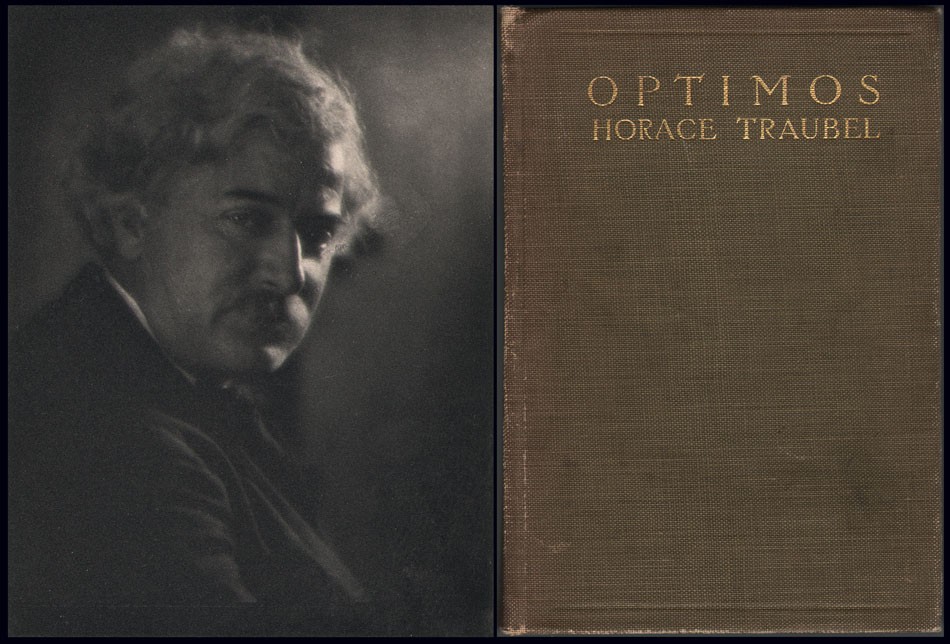 Left: “Frontispiece Portrait of Horace Traubel” (1909) from the book of poetry “Optimos”: Clarence H. White, American: 1910: photogravure: 11.4 x 8.7 | 18.7 x 12.5 cm. From scholar Anne McCauley’s 2017 volume “Clarence H. White and His World: the Art and Craft of Photography, 1895-1925 we learn” : “Reynold’s (Stephen Marion Reynolds (1854-1930) a lawyer who joined the Social Democratic Party in 1900-ed) and Traubel’s recognition of photography as a powerful tool in the class struggle, whether in the form of the dissemination of the fine arts or as a creative means of personal expression if transformed by hand manipulation, caused them to appreciate White’s skills as well as his openness to their political opinions.” (p. 178) Right: Front Cover of “Optimos”, the best-known volume of poetry by Horace Traubel: New York: 1910: B.W. Huebsch (8vo | olive green cloth) From the Walt Whitman Archive online resource, “His own books can be read as socialist refigurings of Whitman's work, each of his titles subtly adjusting Whitman's terminology: …Optimos (1910) redefined Whitman's "kosmos" as an optimized "cheerful whole" (qtd. in Bain 39). And although some in his day declared Traubel as a poet to be Whitman’s successor, there were plenty of critics. Writing in the pages of The Smart Set for July, 1911 under the heading “Novels for Hot Afternoons”, American critic H.L. Mencken, said of “Optimos”: “Horace Traubel fills the three hundred and more pages of his "optimos" (Huebsch) with dishwatery imitations of Walt Whitman, around whom Horace, in Walt's Camden days, revolved as an humble satellite. All of the faults of the master appear in the disciple. There is the same maudlin affection for the hewer of wood and drawer of water, the same frenzy for repeating banal ideas ad nauseam, the same inability to distinguish between a poem and a stump speech. Old Walt, for all his absurdities, was yet a poet at heart. Whenever he ceased, even for a brief moment, to emit his ethical and sociological rubbish, a strange beauty crept into his lines and his own deep emotion glorified them. But not so with Horace. His strophes have little more poetry in them than so many college yells, and the philosophy they voice is almost as bad as the English in which they are written.” From: PhotoSeed Archive
Left: “Frontispiece Portrait of Horace Traubel” (1909) from the book of poetry “Optimos”: Clarence H. White, American: 1910: photogravure: 11.4 x 8.7 | 18.7 x 12.5 cm. From scholar Anne McCauley’s 2017 volume “Clarence H. White and His World: the Art and Craft of Photography, 1895-1925 we learn” : “Reynold’s (Stephen Marion Reynolds (1854-1930) a lawyer who joined the Social Democratic Party in 1900-ed) and Traubel’s recognition of photography as a powerful tool in the class struggle, whether in the form of the dissemination of the fine arts or as a creative means of personal expression if transformed by hand manipulation, caused them to appreciate White’s skills as well as his openness to their political opinions.” (p. 178) Right: Front Cover of “Optimos”, the best-known volume of poetry by Horace Traubel: New York: 1910: B.W. Huebsch (8vo | olive green cloth) From the Walt Whitman Archive online resource, “His own books can be read as socialist refigurings of Whitman's work, each of his titles subtly adjusting Whitman's terminology: …Optimos (1910) redefined Whitman's "kosmos" as an optimized "cheerful whole" (qtd. in Bain 39). And although some in his day declared Traubel as a poet to be Whitman’s successor, there were plenty of critics. Writing in the pages of The Smart Set for July, 1911 under the heading “Novels for Hot Afternoons”, American critic H.L. Mencken, said of “Optimos”: “Horace Traubel fills the three hundred and more pages of his "optimos" (Huebsch) with dishwatery imitations of Walt Whitman, around whom Horace, in Walt's Camden days, revolved as an humble satellite. All of the faults of the master appear in the disciple. There is the same maudlin affection for the hewer of wood and drawer of water, the same frenzy for repeating banal ideas ad nauseam, the same inability to distinguish between a poem and a stump speech. Old Walt, for all his absurdities, was yet a poet at heart. Whenever he ceased, even for a brief moment, to emit his ethical and sociological rubbish, a strange beauty crept into his lines and his own deep emotion glorified them. But not so with Horace. His strophes have little more poetry in them than so many college yells, and the philosophy they voice is almost as bad as the English in which they are written.” From: PhotoSeed Archive
The recipient, Gustave Percival Wiksell, (1863-1940) was a Boston dentist who served as president of the Walt Whitman Fellowship from 1903-1919. So devoted was this disciple to the master that he went to the length of replicating the now famous pose Whitman took from a now lost 1854 daguerreotype by Gabriel Harrison made into an engraving and used as the frontispiece illustration for the 1855 & 1856 editions of Whitman’s masterpiece Leaves of Grass.
Wiksell’s papers are now in the Library of Congress in Washington and he was known to have eulogized Horace Traubell at his funeral in 1919. More than one Traubel scholar lays out the evidence that Wiksell and he were more than good friends, but I will leave that for your own further inquiries. (further attribution can be found in a cutline with this post)
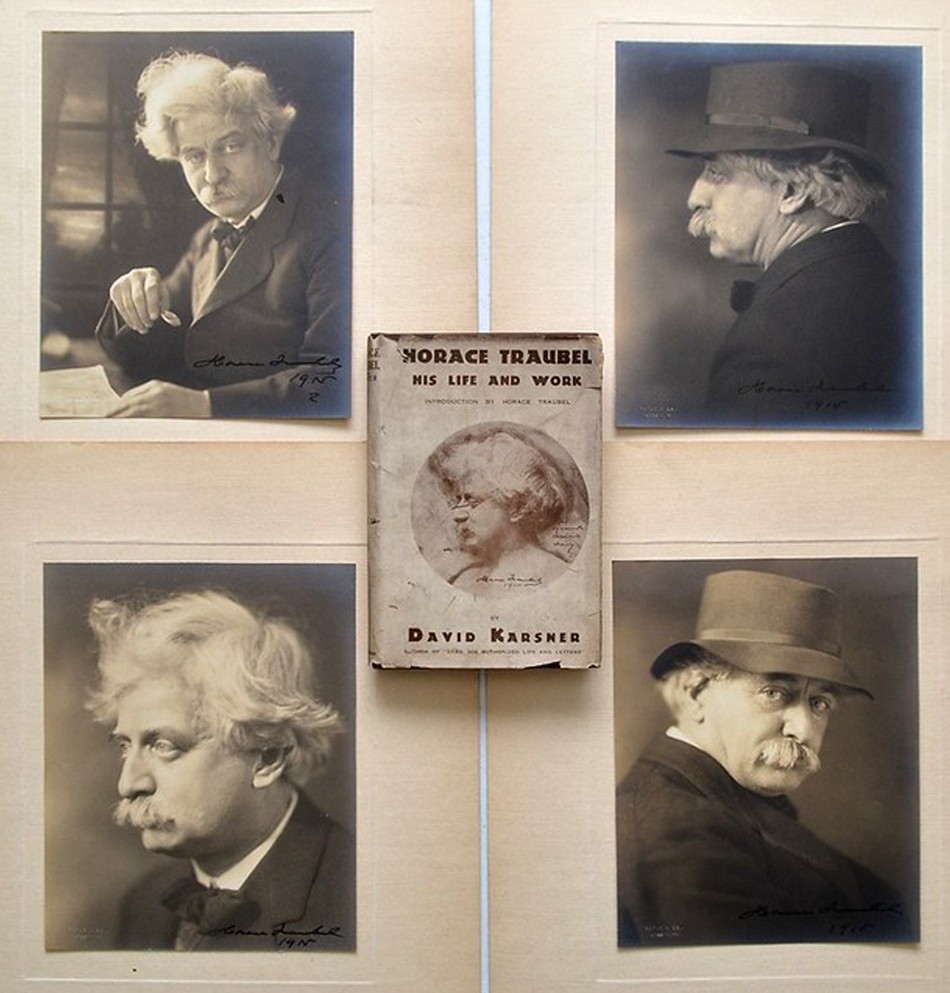 “Ca. 1915 signed and mounted portraits of Horace Traubel” (unknown photographer) surrounding at center: “Horace Traubel: His Life And Work” by David Karsner (New York: Egmont Arens, 1919) with elusive dust-jacket reproducing bare-shouldered 1910 portrait “Horace Traubel: Roundel Portrait”. Commentary on Traubel by Karsner appeared in the online resource Poetrybay in the Fall of 2009: “On the other hand David Karsner, Traubel's biographer… called him “a poet and prophet of the new democracy.” Traubel, suggests Karsner, is part Karl Marx and part Jesus of Nazareth, and in possession of a point of view which issues a labor-conscious ‘warning and challenge.” From Wikipedia: David Fulton "Dave" Karsner (1889–1941) was an American journalist, writer, and socialist political activist. Karsner is best remembered as a key member of the editorial staff of the New York Call and as an early biographer of Socialist Party of America leader Eugene V. Debs. Photographic grouping courtesy The Library of William F. Gable Auction: Savo Auctioneers, Archbald, PA: January 3, 2015.
“Ca. 1915 signed and mounted portraits of Horace Traubel” (unknown photographer) surrounding at center: “Horace Traubel: His Life And Work” by David Karsner (New York: Egmont Arens, 1919) with elusive dust-jacket reproducing bare-shouldered 1910 portrait “Horace Traubel: Roundel Portrait”. Commentary on Traubel by Karsner appeared in the online resource Poetrybay in the Fall of 2009: “On the other hand David Karsner, Traubel's biographer… called him “a poet and prophet of the new democracy.” Traubel, suggests Karsner, is part Karl Marx and part Jesus of Nazareth, and in possession of a point of view which issues a labor-conscious ‘warning and challenge.” From Wikipedia: David Fulton "Dave" Karsner (1889–1941) was an American journalist, writer, and socialist political activist. Karsner is best remembered as a key member of the editorial staff of the New York Call and as an early biographer of Socialist Party of America leader Eugene V. Debs. Photographic grouping courtesy The Library of William F. Gable Auction: Savo Auctioneers, Archbald, PA: January 3, 2015.
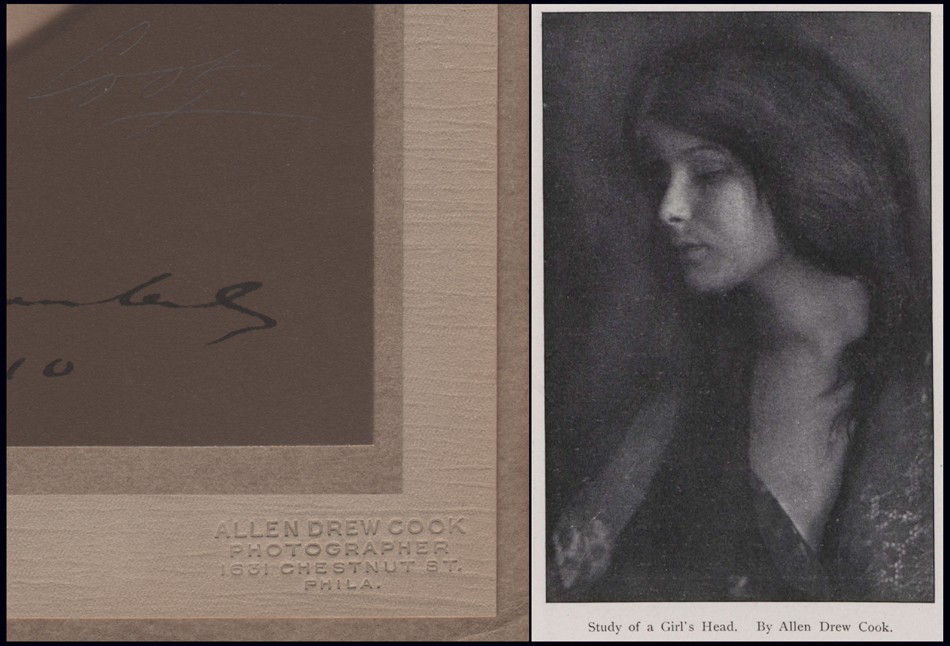 Left: Detail showing blind-stamp for photographer Allen Drew Cook on secondary mount to photograph “Horace Traubel: Roundel Portrait”: Allen Drew Cook, American (1871-1923): 1910: mounted platinum print contained within folder: 17.4” roundel on paper 23.7 x 19.6 cm; supports: 24.8 x 20.6 | 28.4 x 23.9 cm. In upper left of detail is seen graphite signature: “Cook”, underlined outside lower margin of roundel; the blind-stamp additionally lists his address as 1631 Chestnut St. in Philadelphia- the same as for the offices of the The Conservator, a monthly literary magazine edited and published by Horace Traubel beginning in October, 1910. (the magazine, which was started in 1890, previously lists its’ address as 1624 Walnut St. in Philadelphia.) Beginning In 1915 and running into 1916, an advertisement for “Photographic Portraits” by Allen Drew Cook of Eugene Debs, Clarence Darrow, J. William Lloyd and Traubel appeared on the back page of The Conservator. From: PhotoSeed Archive. Right: “Study of a Girl’s Head”, from around 1900, is an early example of a pictorialist photographic portrait entered by Cook in the Third Annual Philadelphia Photographic Salon and reproduced as a halftone in the Salon’s 1900 catalogue. Courtesy: Thomas J. Watson Library Digital Collections - The Metropolitan Museum of Art, New York.
Left: Detail showing blind-stamp for photographer Allen Drew Cook on secondary mount to photograph “Horace Traubel: Roundel Portrait”: Allen Drew Cook, American (1871-1923): 1910: mounted platinum print contained within folder: 17.4” roundel on paper 23.7 x 19.6 cm; supports: 24.8 x 20.6 | 28.4 x 23.9 cm. In upper left of detail is seen graphite signature: “Cook”, underlined outside lower margin of roundel; the blind-stamp additionally lists his address as 1631 Chestnut St. in Philadelphia- the same as for the offices of the The Conservator, a monthly literary magazine edited and published by Horace Traubel beginning in October, 1910. (the magazine, which was started in 1890, previously lists its’ address as 1624 Walnut St. in Philadelphia.) Beginning In 1915 and running into 1916, an advertisement for “Photographic Portraits” by Allen Drew Cook of Eugene Debs, Clarence Darrow, J. William Lloyd and Traubel appeared on the back page of The Conservator. From: PhotoSeed Archive. Right: “Study of a Girl’s Head”, from around 1900, is an early example of a pictorialist photographic portrait entered by Cook in the Third Annual Philadelphia Photographic Salon and reproduced as a halftone in the Salon’s 1900 catalogue. Courtesy: Thomas J. Watson Library Digital Collections - The Metropolitan Museum of Art, New York.
Five years ago on July 4th, America’s birthday, I published a post featuring several vintage likenesses of Walt Whitman- “Oh Say Can you See?” and his importance to capturing the enduring spirit of our country. In this, Traubel certainly will never be magically rediscovered as the good gray poet’s literary successor (none other than H.L. Mencken derided his poetry as “dishwatery imitations of Walt Whitman, around whom Horace, in Walt’s Camden days, revolved as an humble satellite.”) (3.) But his ideals as one spreading love as written in the lines at the top of this post-a socialist ideal in the vein of Whitman- are surely honorable and needed in the fractured American present. Instead of cleaved partisan camps and tribes seemingly taking over our national conversation, how about a bit more love comrades? Socialism has nothing to do with that last word, by the way. Instead, let’s celebrate the ideals of our national melting pot, and give all her citizenry power to the truth of her motto: “E Pluribus Unum” - Out of Many, One.
Just what Horace would have wanted.
Notes:
1. Excerpt: The Guardian (online): Julianne McShane: “Walt Whitman: celebrating an extraordinary life in his bicentennial”: June 12, 2019. One hundred thirty photographic portraits of Walt Whitman have been identified to date.
2. Excerpt: Online resource Poetrybay: Fall, 2009: commentary on Traubel by Karsner.
3. Excerpt: Review: “Optimos” : “Novels for Hot Afternoons”: H.L. Mencken: The Smart Set: July, 1911.
Kodak City: the Sequel
Posted April 2018 in Cameras, Conservation, Exhibitions, History of Photography, Photographic Preservation, Photography, Publishing
Speaking of photography in general, of which this website is particularly enamored of, our recent visit to Rochester, New York and attendance in the three-day conference “PhotoHistory/PhotoFuture” sponsored and organized by RIT Press and The Wallace Center at the Rochester Institute of Technology gave new meaning to their claims for the medium: “there has never been more of it than there is today.” That might be stating the obvious, especially in 2018, but the new meaning part was my own takeaway and inspiration.
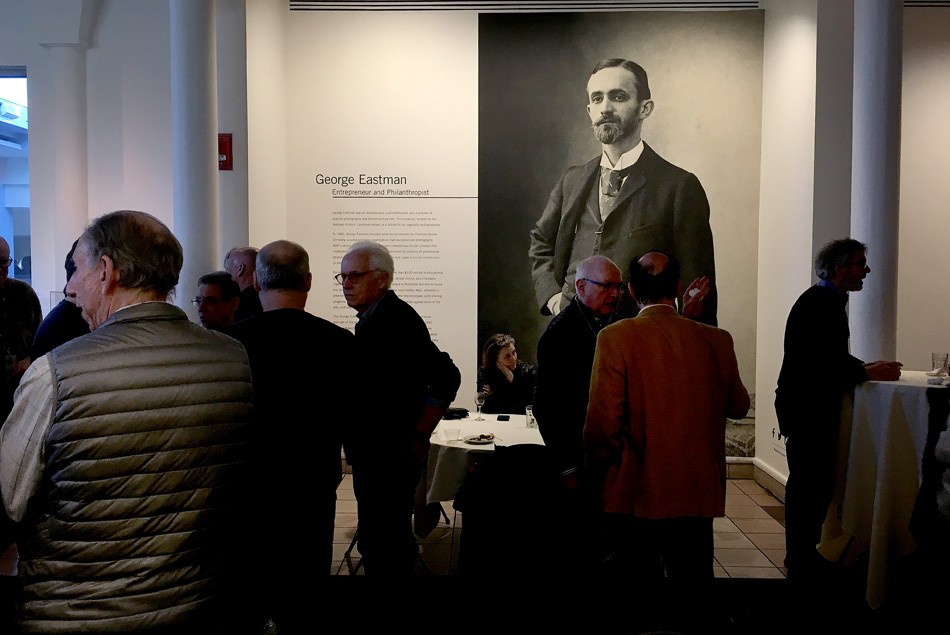 By George, Still Relevant: During a reception at the George Eastman Museum for conference attendees, a young George Eastman,(1854-1932) who founded the Eastman Kodak Company, looms larger than life in a photograph taken in 1890 by Nadar. Entrepreneur and Philanthropist are emphasized on the wall label, and with good reason. From the museum's website:"The George Eastman Museum is located in Rochester, New York, on the estate of George Eastman, the pioneer of popular photography and motion picture film. Founded in 1947 as an independent nonprofit institution, it is the world’s oldest photography museum and one of the oldest film archives. The museum holds unparalleled collections—encompassing several million objects—in the fields of photography, cinema, and photographic and cinematographic technology, and photographically illustrated books. The institution is also a longtime leader in film preservation and photographic conservation." David Spencer for PhotoSeed Archive
By George, Still Relevant: During a reception at the George Eastman Museum for conference attendees, a young George Eastman,(1854-1932) who founded the Eastman Kodak Company, looms larger than life in a photograph taken in 1890 by Nadar. Entrepreneur and Philanthropist are emphasized on the wall label, and with good reason. From the museum's website:"The George Eastman Museum is located in Rochester, New York, on the estate of George Eastman, the pioneer of popular photography and motion picture film. Founded in 1947 as an independent nonprofit institution, it is the world’s oldest photography museum and one of the oldest film archives. The museum holds unparalleled collections—encompassing several million objects—in the fields of photography, cinema, and photographic and cinematographic technology, and photographically illustrated books. The institution is also a longtime leader in film preservation and photographic conservation." David Spencer for PhotoSeed Archive
In present day Kodak city, the power of ideas relating to what made this place significant as an imaging industrial behemoth still exists, but has now gone in a new direction. With all due apologies, but the pun indeed appropriate, a snapshot of those ideas put forth by the conference attendees and speakers shows their passion for the medium’s minutiae both preserves and continues this essential democratic language. Those of memories past surely, but more and more the future in the form of ones and zeroes hurtling forward.
Although the “Big Yellow” of Rochester’s past is long gone, the ideas nourishing photography’s entire corpus continues apace, an alternate reality both present and future. For those curious enough, the RIT conference program along with a list of presenters can be found here, along with a few photos from the weekend courtesy of yours truly. David Spencer-
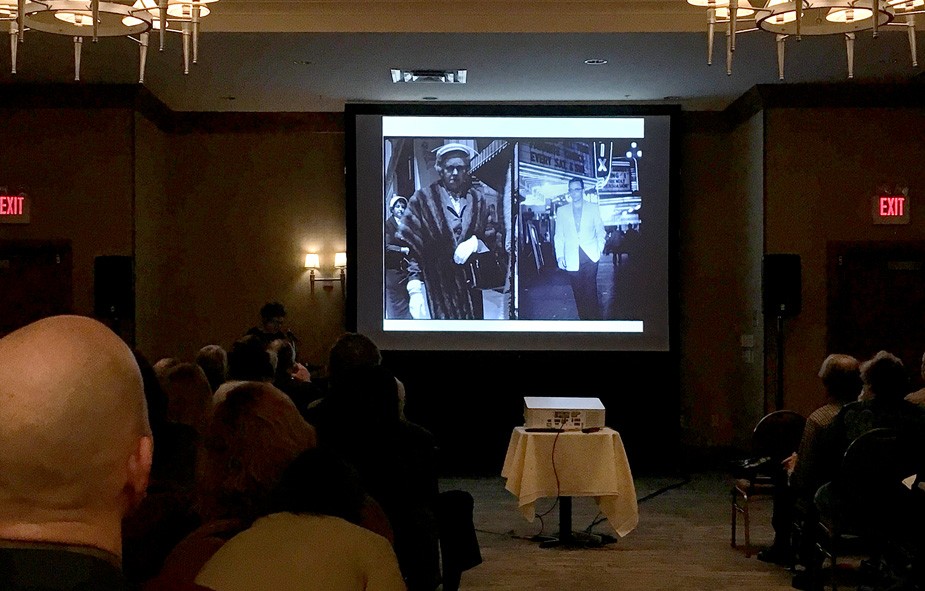 Documentary photography practiced as commerce on busy streets around the world, a genre roughly known as "Movie Snaps" because of the retrofitted movie cameras used in their making, was part of a fascinating presentation under the working title “Street Vendor Portraits Around the World: Czernowitz, Capetown, San Francisco, More!” given by independent scholar Mary Panzar of Rochester. Here, the hybrid look of Winogrand meeting Arbus becomes a document in a projected frame of a woman sporting fur and white gloves at left while a gentleman unaware at right emerges to flash and instant celebrity from a movie theatre on a nighttime street. David Spencer for PhotoSeed Archive
Documentary photography practiced as commerce on busy streets around the world, a genre roughly known as "Movie Snaps" because of the retrofitted movie cameras used in their making, was part of a fascinating presentation under the working title “Street Vendor Portraits Around the World: Czernowitz, Capetown, San Francisco, More!” given by independent scholar Mary Panzar of Rochester. Here, the hybrid look of Winogrand meeting Arbus becomes a document in a projected frame of a woman sporting fur and white gloves at left while a gentleman unaware at right emerges to flash and instant celebrity from a movie theatre on a nighttime street. David Spencer for PhotoSeed Archive
 Triptych in the Dark: Left: During his presentation “Did Talbot Make Daguerreotypes?”, the eminence of English photography pioneer William Henry Fox Talbot (1800-1877) is shown here by an image most in attendance had seen, yet Grant Romer- formerly of the Eastman House but now Founding Director of the Academy of Archaic Imaging, challenged us with another view: a decidedly unflattering profile of the paper/negative pioneer he rightly remarked might have made for a different public perception for the emerging medium had it been the lone evidence of his existence. Middle: a quote of photographic philosophy by American writer Susan Sontag (1933-2004) struck this observer as particularly relevant in the present day- University of Illinois Springfield professors Kathy Petitte Novak and Brytton Bjorngaard used it as supporting evidence while speaking on “The Blurring Distinctions of Taking versus Making Photographs: Teaching Photography in a Digital Culture”. Right: the appropriated late Victorian era reality of the dark underbelly of a small Wisconsin town through the lens of Black River Falls photographer Charles Van Schaik repurposed by author Michael Lesy in his 1973 cult classic "Wisconsin Death Trip" was supporting material for Nicolette Bromberg of the University of Washington, who argued photographic archivists need to understand context in her paper “Loss of Vision: How Art Historians and Critics Misjudge Early 20th Century Photography and How Early Photographers Along with Art Museums and Archives Help to Obscure the Photographic Record”. David Spencer for PhotoSeed Archive
Triptych in the Dark: Left: During his presentation “Did Talbot Make Daguerreotypes?”, the eminence of English photography pioneer William Henry Fox Talbot (1800-1877) is shown here by an image most in attendance had seen, yet Grant Romer- formerly of the Eastman House but now Founding Director of the Academy of Archaic Imaging, challenged us with another view: a decidedly unflattering profile of the paper/negative pioneer he rightly remarked might have made for a different public perception for the emerging medium had it been the lone evidence of his existence. Middle: a quote of photographic philosophy by American writer Susan Sontag (1933-2004) struck this observer as particularly relevant in the present day- University of Illinois Springfield professors Kathy Petitte Novak and Brytton Bjorngaard used it as supporting evidence while speaking on “The Blurring Distinctions of Taking versus Making Photographs: Teaching Photography in a Digital Culture”. Right: the appropriated late Victorian era reality of the dark underbelly of a small Wisconsin town through the lens of Black River Falls photographer Charles Van Schaik repurposed by author Michael Lesy in his 1973 cult classic "Wisconsin Death Trip" was supporting material for Nicolette Bromberg of the University of Washington, who argued photographic archivists need to understand context in her paper “Loss of Vision: How Art Historians and Critics Misjudge Early 20th Century Photography and How Early Photographers Along with Art Museums and Archives Help to Obscure the Photographic Record”. David Spencer for PhotoSeed Archive
 Photographic Preservation: With a mission statement stating they are the "world leader in the development and deployment of sustainable practices for the preservation of images and cultural heritage", conference attendees toured the Image Permanence Institute, (www.imagepermanenceinstitute.org) which opened in 1985 as an academic research laboratory within the College of Imaging Arts and Sciences at RIT. For many visitors, IPI is known for their Graphics Atlas, (www.graphicsatlas.org) an online resource that helps identify photographic and other process print types. In front of a table with various displayed print types including a row of portraits toned with Polysulfide & Selenium Toner, Institute senior research scientist Douglas Nishimura at left chats with a visitor. David Spencer for PhotoSeed Archive
Photographic Preservation: With a mission statement stating they are the "world leader in the development and deployment of sustainable practices for the preservation of images and cultural heritage", conference attendees toured the Image Permanence Institute, (www.imagepermanenceinstitute.org) which opened in 1985 as an academic research laboratory within the College of Imaging Arts and Sciences at RIT. For many visitors, IPI is known for their Graphics Atlas, (www.graphicsatlas.org) an online resource that helps identify photographic and other process print types. In front of a table with various displayed print types including a row of portraits toned with Polysulfide & Selenium Toner, Institute senior research scientist Douglas Nishimura at left chats with a visitor. David Spencer for PhotoSeed Archive
 Conference participants attended the exhibition "The Luminous Print: An Appreciation of Photogravure" organized by David Pankow, Curator Emeritus for the Cary Graphic Arts Collection at RIT now running through June 15, 2018. With beginnings in intaglio printing by artists working in the late 15th Century, photogravure's historical timeline which evolved by the 19th Century as a medium for "images from real life" is showcased by superb examples featuring plates from bound volumes, portfolios and individual works. The pleasure in real life can be seconded by this attendee, with the following observation from the catalogue true to form: "enjoy this exhibition for the beauty of its images alone and discover why it has been said that a photogravure print is endowed with a luminosity unequalled by any other process."David Spencer for PhotoSeed Archive
Conference participants attended the exhibition "The Luminous Print: An Appreciation of Photogravure" organized by David Pankow, Curator Emeritus for the Cary Graphic Arts Collection at RIT now running through June 15, 2018. With beginnings in intaglio printing by artists working in the late 15th Century, photogravure's historical timeline which evolved by the 19th Century as a medium for "images from real life" is showcased by superb examples featuring plates from bound volumes, portfolios and individual works. The pleasure in real life can be seconded by this attendee, with the following observation from the catalogue true to form: "enjoy this exhibition for the beauty of its images alone and discover why it has been said that a photogravure print is endowed with a luminosity unequalled by any other process."David Spencer for PhotoSeed Archive
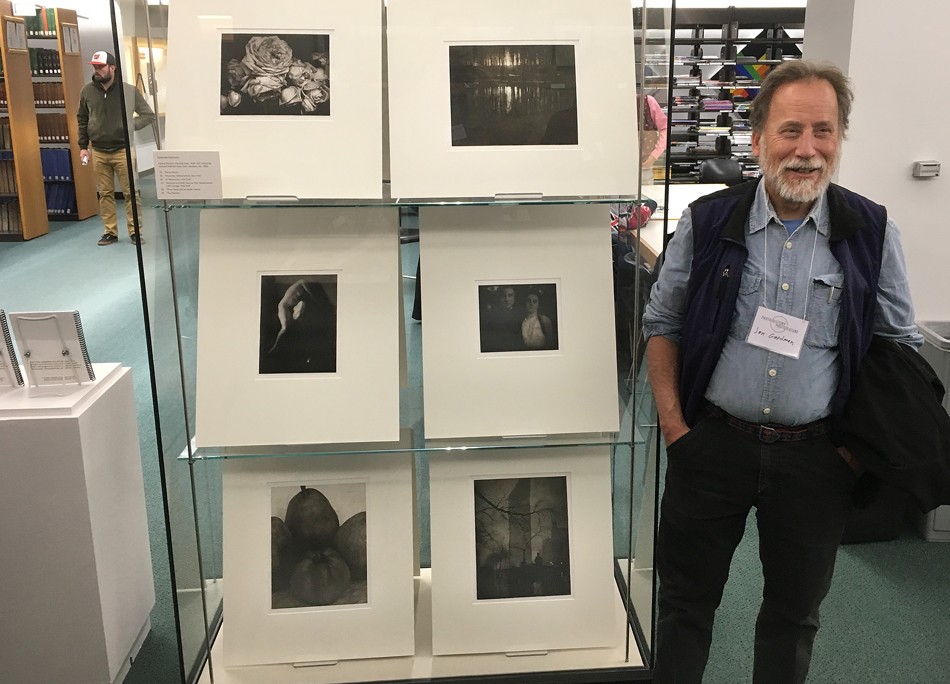 Royal Visit: As an added bonus, conference attendees viewing "The Luminous Print" could rub shoulders with Massachusetts resident Jon Goodman, a master craftsman who has worked full time since 1976 as a photogravure printer specializing in the Talbot Klic photogravure technique . Beginning in 1980 through the Photogravure Workshop, a division of the Aperture Publishing Foundation and their namesake Aperture magazine and the Paul Strand Foundation, Jon has produced sumptuous, superb, and collectable portfolios of the early work of Paul Strand, Edward Steichen, and British photography. His mission continues today in his Florence, MA atelier along with a new interest: carbon printing. Displayed are six of Jon's gravure plates featuring the pictorial work of Edward Steichen from the 1981 Aperture portfolio: "Edward Steichen; The Early Years, 1900-1927". Top to bottom left to right: "Heavy Roses", "Moonrise, Mamaroneck, New York", "In Memoriam, New York", "Steichen and Wife Clara on their Honeymoon, Lake George, New York", "Three Pears and an Apple, France", "The Flatiron". Visit jgoodgravure.com and gravureportfolios.com for more information. David Spencer for PhotoSeed Archive
Royal Visit: As an added bonus, conference attendees viewing "The Luminous Print" could rub shoulders with Massachusetts resident Jon Goodman, a master craftsman who has worked full time since 1976 as a photogravure printer specializing in the Talbot Klic photogravure technique . Beginning in 1980 through the Photogravure Workshop, a division of the Aperture Publishing Foundation and their namesake Aperture magazine and the Paul Strand Foundation, Jon has produced sumptuous, superb, and collectable portfolios of the early work of Paul Strand, Edward Steichen, and British photography. His mission continues today in his Florence, MA atelier along with a new interest: carbon printing. Displayed are six of Jon's gravure plates featuring the pictorial work of Edward Steichen from the 1981 Aperture portfolio: "Edward Steichen; The Early Years, 1900-1927". Top to bottom left to right: "Heavy Roses", "Moonrise, Mamaroneck, New York", "In Memoriam, New York", "Steichen and Wife Clara on their Honeymoon, Lake George, New York", "Three Pears and an Apple, France", "The Flatiron". Visit jgoodgravure.com and gravureportfolios.com for more information. David Spencer for PhotoSeed Archive
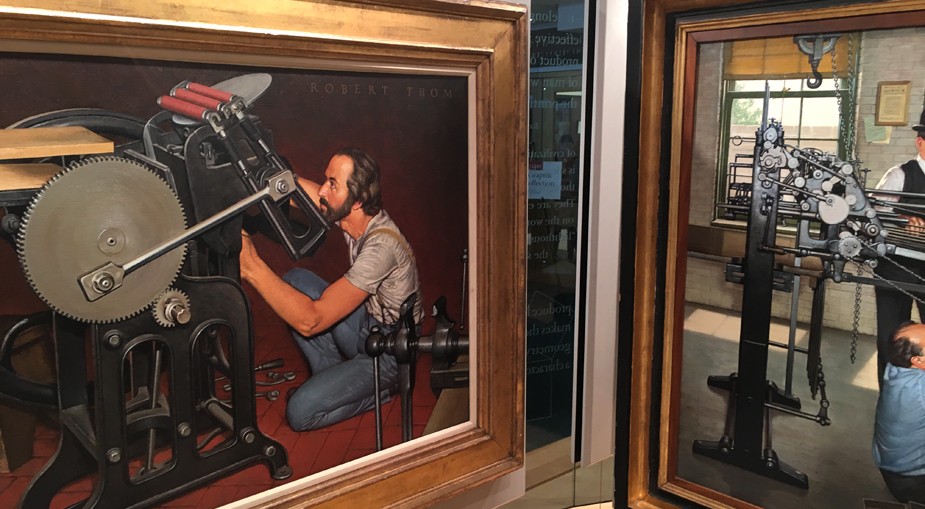 History of Printing: A series of oil paintings by three artists originally commissioned in 1966 by the Kimberly-Clark Corporation commemorating "Graphic Communications through the Ages" hangs within the offices of the RIT Press ( www.rit.edu/press/ ) and the adjoining Cary Graphic Arts Collection at The Wallace Center. This painting shows a detail of the work "George P. Gordon and the Platen Press" done by American illustrator Robert A. Thom, (1915-1979) with a detail at right by Thom: "Ira Rubel and the Offset Press". David Spencer for PhotoSeed Archive
History of Printing: A series of oil paintings by three artists originally commissioned in 1966 by the Kimberly-Clark Corporation commemorating "Graphic Communications through the Ages" hangs within the offices of the RIT Press ( www.rit.edu/press/ ) and the adjoining Cary Graphic Arts Collection at The Wallace Center. This painting shows a detail of the work "George P. Gordon and the Platen Press" done by American illustrator Robert A. Thom, (1915-1979) with a detail at right by Thom: "Ira Rubel and the Offset Press". David Spencer for PhotoSeed Archive
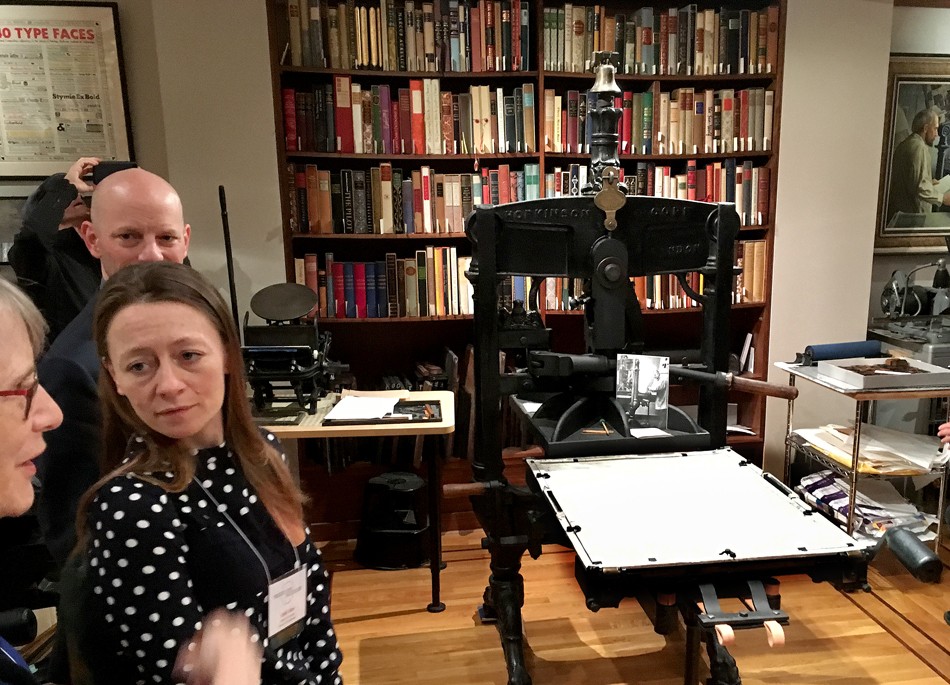 Making an Impression: Taking center stage for visitors is the famed Kelmscott/Goudy iron hand-press featured among other working presses in the Arthur M. Lowenthal Memorial Pressroom within the Cary Graphics Arts Collection at RIT. Visitors learned it was first owned by the English printer William Morris and then Frederic Goudy, two giants of the letterpress printing art. The press was built in London in 1891 by Hopkinson & Cope- an Improved Albion model (No. 6551). Now featuring around 40,000 fine and rare volumes on graphic communication history and practices, The Cary Collection is considered one of the premier libraries on the subject in the United States. ( library.rit.edu/cary ) David Spencer for PhotoSeed Archive
Making an Impression: Taking center stage for visitors is the famed Kelmscott/Goudy iron hand-press featured among other working presses in the Arthur M. Lowenthal Memorial Pressroom within the Cary Graphics Arts Collection at RIT. Visitors learned it was first owned by the English printer William Morris and then Frederic Goudy, two giants of the letterpress printing art. The press was built in London in 1891 by Hopkinson & Cope- an Improved Albion model (No. 6551). Now featuring around 40,000 fine and rare volumes on graphic communication history and practices, The Cary Collection is considered one of the premier libraries on the subject in the United States. ( library.rit.edu/cary ) David Spencer for PhotoSeed Archive
 Alternate History: The coverage by war photographer Robert Capa (1913-1954) for Life Magazine of American troops landing on Omaha Beach on D-Day during World War II was deconstructed after seven decades of public myth to facts by Staten Island, NY independent critic and historian A. D. Coleman. The first photo critic for the New York Times in 1967 and prolific author of books on photography as well as thousands of articles on the medium, Coleman presented his research during the conference titled “Deconstructing Robert Capa’s D-Day: The Unmaking of a Myth” that recently took place over three years helped by the efforts of war photographer J. Ross Baughman, Rob McElroy and Charles Herrick. As a former photojournalist myself for over three decades, I found his presentation convincing and enlightening: I still remember drying strips of film as a young photographer in large upright darkroom cabinets-the focus of some of the research when it was claimed a Life lab tech had melted Capa's film on deadline- the worst I remember was curled film! Please visit capaddayproject.com to learn more. Malcolm Gladwell, (revisionisthistory.com) are you interested? David Spencer for PhotoSeed Archive
Alternate History: The coverage by war photographer Robert Capa (1913-1954) for Life Magazine of American troops landing on Omaha Beach on D-Day during World War II was deconstructed after seven decades of public myth to facts by Staten Island, NY independent critic and historian A. D. Coleman. The first photo critic for the New York Times in 1967 and prolific author of books on photography as well as thousands of articles on the medium, Coleman presented his research during the conference titled “Deconstructing Robert Capa’s D-Day: The Unmaking of a Myth” that recently took place over three years helped by the efforts of war photographer J. Ross Baughman, Rob McElroy and Charles Herrick. As a former photojournalist myself for over three decades, I found his presentation convincing and enlightening: I still remember drying strips of film as a young photographer in large upright darkroom cabinets-the focus of some of the research when it was claimed a Life lab tech had melted Capa's film on deadline- the worst I remember was curled film! Please visit capaddayproject.com to learn more. Malcolm Gladwell, (revisionisthistory.com) are you interested? David Spencer for PhotoSeed Archive
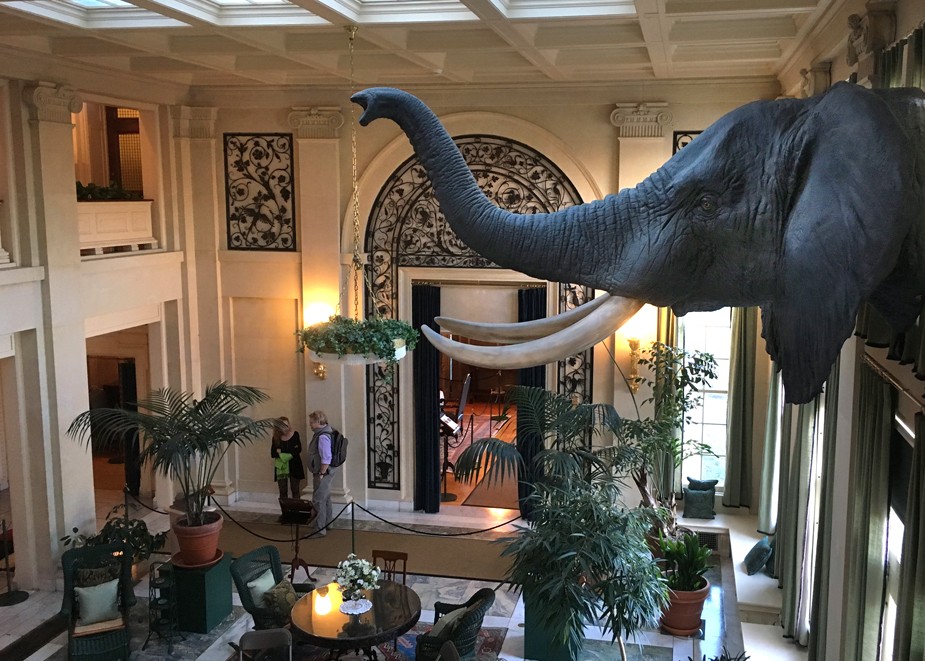 Digital Elephant in Room: Visitors to George Eastman's stately 50-room Colonial revival mansion adjoining the Eastman Museum will always remember the conservatory, where a fiberglass replica mount of an African bull elephant hangs- a conquest by the company founder during a 1928 Sudanese safari. Conveniently- and speaking of elephants in the room, I earlier had thoroughly enjoyed listening and pondering conference presenter Stephen Fletcher's talk: “The Photographic Archivist is Dead, Long Live the Photographic Archivist!”, his call to action for the task of photo archivists in the 21st Century: what do we do and how do we preserve a portion for posterity and history the digital evidence of billions and billions of photographs taken-seemingly, every day? A photographic archivist in the North Carolina collection at the University of North Carolina at Chapel Hill, Fletcher's call to arms would surely have inspired Eastman himself, a hands-on guy who is reported to have overseen every aspect of the construction of his mansion and made sure it contained all the cutting-edge technology of its' day: from the Eastman Museum website: "Beneath this exterior were modern conveniences such as an electrical generator, an internal telephone system with 21 stations, a built-in vacuum cleaning system, a central clock network, an elevator, and a great pipe organ, which made the home itself an instrument, a center of the city’s rich musical life from 1905 until Eastman’s death in 1932. Eastman was involved in every aspect of the construction, paying close attention to detail and requiring the use of high-quality materials." David Spencer for PhotoSeed Archive
Digital Elephant in Room: Visitors to George Eastman's stately 50-room Colonial revival mansion adjoining the Eastman Museum will always remember the conservatory, where a fiberglass replica mount of an African bull elephant hangs- a conquest by the company founder during a 1928 Sudanese safari. Conveniently- and speaking of elephants in the room, I earlier had thoroughly enjoyed listening and pondering conference presenter Stephen Fletcher's talk: “The Photographic Archivist is Dead, Long Live the Photographic Archivist!”, his call to action for the task of photo archivists in the 21st Century: what do we do and how do we preserve a portion for posterity and history the digital evidence of billions and billions of photographs taken-seemingly, every day? A photographic archivist in the North Carolina collection at the University of North Carolina at Chapel Hill, Fletcher's call to arms would surely have inspired Eastman himself, a hands-on guy who is reported to have overseen every aspect of the construction of his mansion and made sure it contained all the cutting-edge technology of its' day: from the Eastman Museum website: "Beneath this exterior were modern conveniences such as an electrical generator, an internal telephone system with 21 stations, a built-in vacuum cleaning system, a central clock network, an elevator, and a great pipe organ, which made the home itself an instrument, a center of the city’s rich musical life from 1905 until Eastman’s death in 1932. Eastman was involved in every aspect of the construction, paying close attention to detail and requiring the use of high-quality materials." David Spencer for PhotoSeed Archive
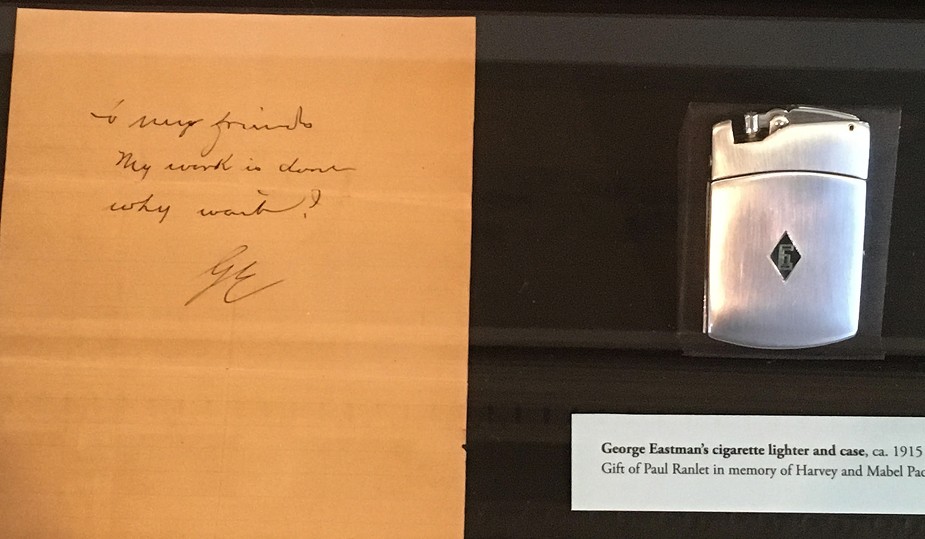 Smoking also Works: Perhaps the most startling object on display in the mansion-at least to those who do not know the intimate details of George Eastman's life- is a facsimile of his 1932 suicide note: "To my friends - My work is done - why wait? GE." Suppressed initially by the Eastman Kodak Company for decades, this news is sobering but important. Eastman had been crippled by a degenerative spinal disease and unable to walk, he shot himself through the heart in his upstairs bedroom. A music lover even after the end, a 1990 New York Times story on the renovation of the mansion noted he "requested a rousing ''Marche Romaine'' by Charles Gounod be played at his funeral". David Spencer for PhotoSeed Archive
Smoking also Works: Perhaps the most startling object on display in the mansion-at least to those who do not know the intimate details of George Eastman's life- is a facsimile of his 1932 suicide note: "To my friends - My work is done - why wait? GE." Suppressed initially by the Eastman Kodak Company for decades, this news is sobering but important. Eastman had been crippled by a degenerative spinal disease and unable to walk, he shot himself through the heart in his upstairs bedroom. A music lover even after the end, a 1990 New York Times story on the renovation of the mansion noted he "requested a rousing ''Marche Romaine'' by Charles Gounod be played at his funeral". David Spencer for PhotoSeed Archive
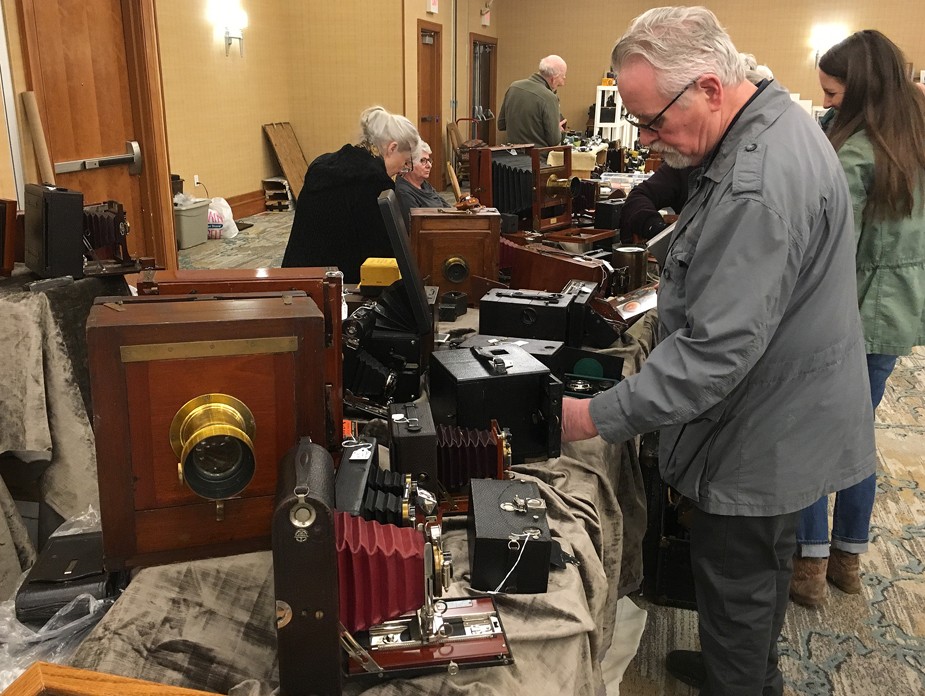 Fancy Box with Hole in It: Collectors and the curious had the opportunity to peruse the physical evidence of the history of photography during the concluding event of the conference, an antiquarian photography show and sale featuring 80 tables of wares including these vintage wooden box and Kodak cameras. Earlier, the RIT Press and Syracuse University Press showed off their latest offerings, including some wonderful photography volumes during the event. David Spencer for PhotoSeed Archive
Fancy Box with Hole in It: Collectors and the curious had the opportunity to peruse the physical evidence of the history of photography during the concluding event of the conference, an antiquarian photography show and sale featuring 80 tables of wares including these vintage wooden box and Kodak cameras. Earlier, the RIT Press and Syracuse University Press showed off their latest offerings, including some wonderful photography volumes during the event. David Spencer for PhotoSeed Archive
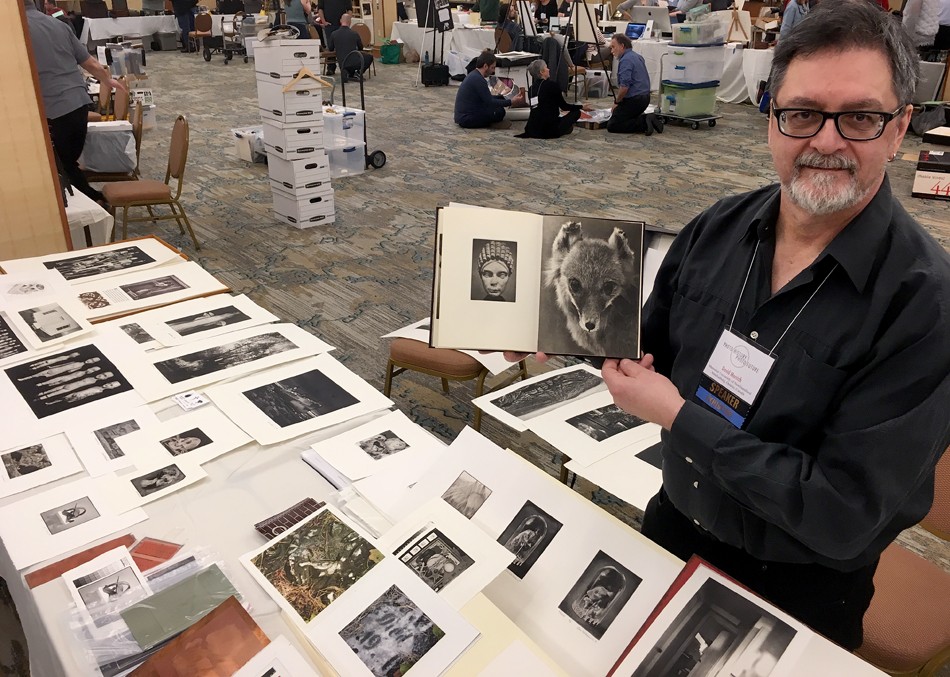 Learned from Jon Goodman: During the antiquarian photography show and sale, Ontario-based visual artist David Morrish, co-author along with Marlene MacCallum of the 2003 volume "Copper Plate Photogravure: Demystifying the Process", shows off a page spread of original photogravures from his 2004 Deadcat Press imprint "Gaze" he was selling along with other work during the antiquarian photography show and sale. Earlier in the conference, Morrish and visual artist MacCallum, former professor in the Visual Arts Program at Memorial University of Newfoundland, presented on "Photogravure: Then and Now" highlighting the gravure process while showing how the medium’s ongoing relevance to contemporary art practice has influenced their own work in the production of print suites and artists’ books. Learn more at marlenemaccallum.com and davidmorrish.com. David Spencer for PhotoSeed Archive
Learned from Jon Goodman: During the antiquarian photography show and sale, Ontario-based visual artist David Morrish, co-author along with Marlene MacCallum of the 2003 volume "Copper Plate Photogravure: Demystifying the Process", shows off a page spread of original photogravures from his 2004 Deadcat Press imprint "Gaze" he was selling along with other work during the antiquarian photography show and sale. Earlier in the conference, Morrish and visual artist MacCallum, former professor in the Visual Arts Program at Memorial University of Newfoundland, presented on "Photogravure: Then and Now" highlighting the gravure process while showing how the medium’s ongoing relevance to contemporary art practice has influenced their own work in the production of print suites and artists’ books. Learn more at marlenemaccallum.com and davidmorrish.com. David Spencer for PhotoSeed Archive
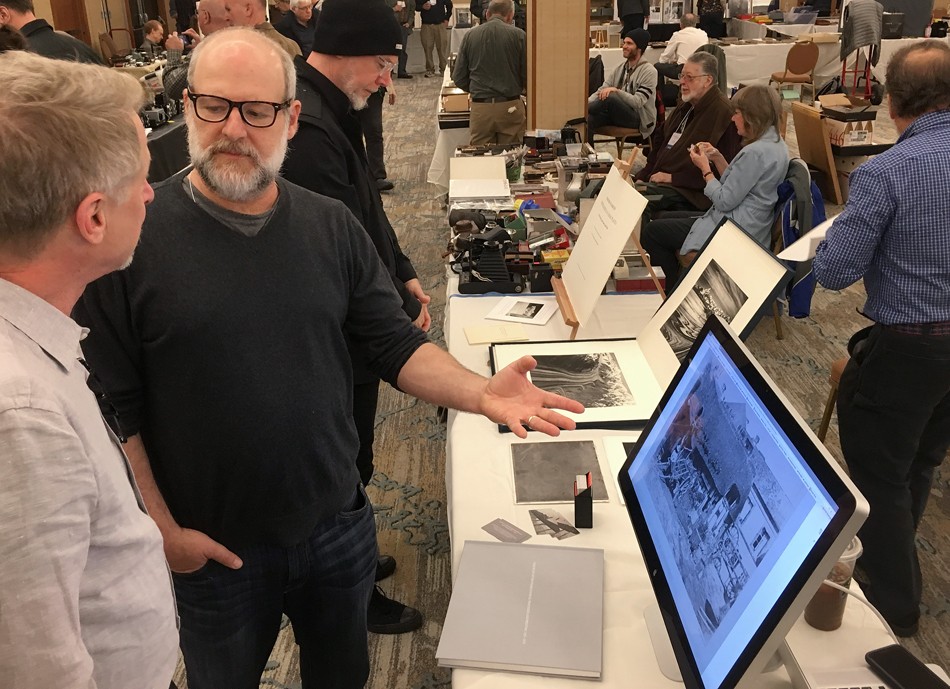 Future with a Past: St. Louis resident and commercial photographer Mark Katzman, the key force in proselytizing for the medium and beauty of hand-pulled photogravure worldwide through his website Photogravure.com, speaks with conference speaker Jeff Rosen during the antiquarian photography show and sale. Curious to learn what a real photogravure is, unlike the many who simply use the term-wrongly-to sell you something not what they claim? Head over to his newly redesigned site, where the mission statement is: "Peeling back a layer of the history of photography, this site examines the role that photogravure has played in shaping our shared visual experience. Through exploring thousands of examples, we learn about the relentless and ambitious 19th century pursuit to reproduce photographs in ink and discover the exquisite, sublime process that resulted. It is our hope that this site firmly establishes photogravure as not only one of the most under-recognized photographic processes, but also an important and beautiful art." David Spencer for PhotoSeed Archive
Future with a Past: St. Louis resident and commercial photographer Mark Katzman, the key force in proselytizing for the medium and beauty of hand-pulled photogravure worldwide through his website Photogravure.com, speaks with conference speaker Jeff Rosen during the antiquarian photography show and sale. Curious to learn what a real photogravure is, unlike the many who simply use the term-wrongly-to sell you something not what they claim? Head over to his newly redesigned site, where the mission statement is: "Peeling back a layer of the history of photography, this site examines the role that photogravure has played in shaping our shared visual experience. Through exploring thousands of examples, we learn about the relentless and ambitious 19th century pursuit to reproduce photographs in ink and discover the exquisite, sublime process that resulted. It is our hope that this site firmly establishes photogravure as not only one of the most under-recognized photographic processes, but also an important and beautiful art." David Spencer for PhotoSeed Archive
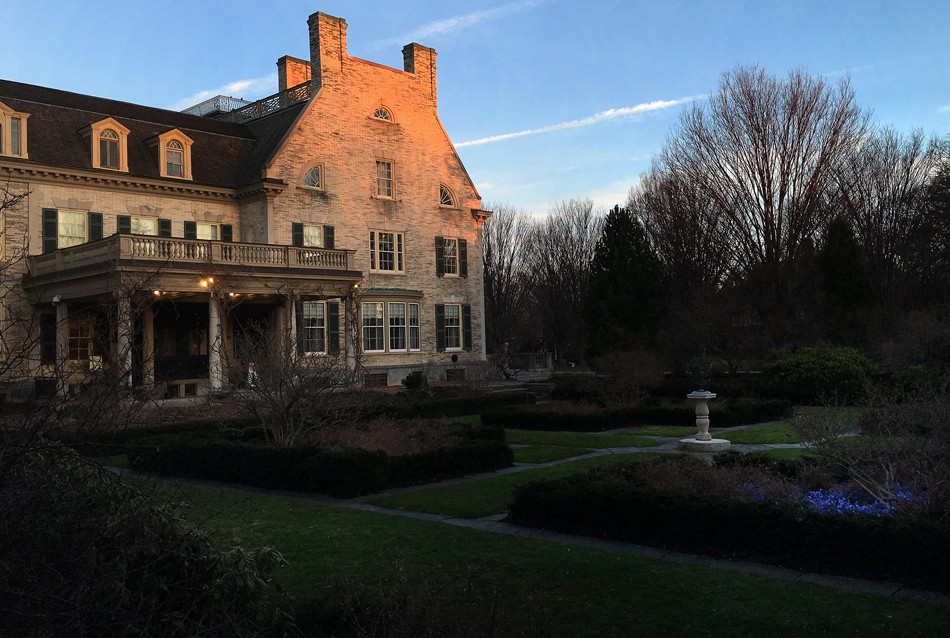 Keeper of Memories: Located at 900 East Ave. in Rochester, New York, the George Eastman Museum, along with a section of his original mansion and gardens on 8.5 acres constructed beginning in 1902, is a grand American repository for the study of photography past, present and future. Besides a growing archive of over 400,000 photographic objects spanning the history of the medium, the museum also features 16,000 + examples of photographic and cinematographic technology- the world's largest. For those interested in the printed legacy, the accessible Richard and Ronay Menschel Library is also onsite, with a special collections and archive division housing "manuscripts, papers, and ephemera, including those of Alvin Langdon Coburn, Lewis W. Hine, Southworth and Hawes, and Edward Steichen, among other photographers, collectors, and inventors." Curious? eastman.org. David Spencer for PhotoSeed Archive
Keeper of Memories: Located at 900 East Ave. in Rochester, New York, the George Eastman Museum, along with a section of his original mansion and gardens on 8.5 acres constructed beginning in 1902, is a grand American repository for the study of photography past, present and future. Besides a growing archive of over 400,000 photographic objects spanning the history of the medium, the museum also features 16,000 + examples of photographic and cinematographic technology- the world's largest. For those interested in the printed legacy, the accessible Richard and Ronay Menschel Library is also onsite, with a special collections and archive division housing "manuscripts, papers, and ephemera, including those of Alvin Langdon Coburn, Lewis W. Hine, Southworth and Hawes, and Edward Steichen, among other photographers, collectors, and inventors." Curious? eastman.org. David Spencer for PhotoSeed Archive
Say It With Flowers . . . . Do It With Dishpans
Posted February 2018 in Advertising, Alternate Processes, Painters|Photographers, Publishing, Significant Portfolios, Typography
In 1926, Minnesota artist Cleora Clark Wheeler made the following observation in an article she wrote explaining her feat of photographing scores of fellow Kappa Kappa Gamma fraternity sisters by means of silhouette portraiture:
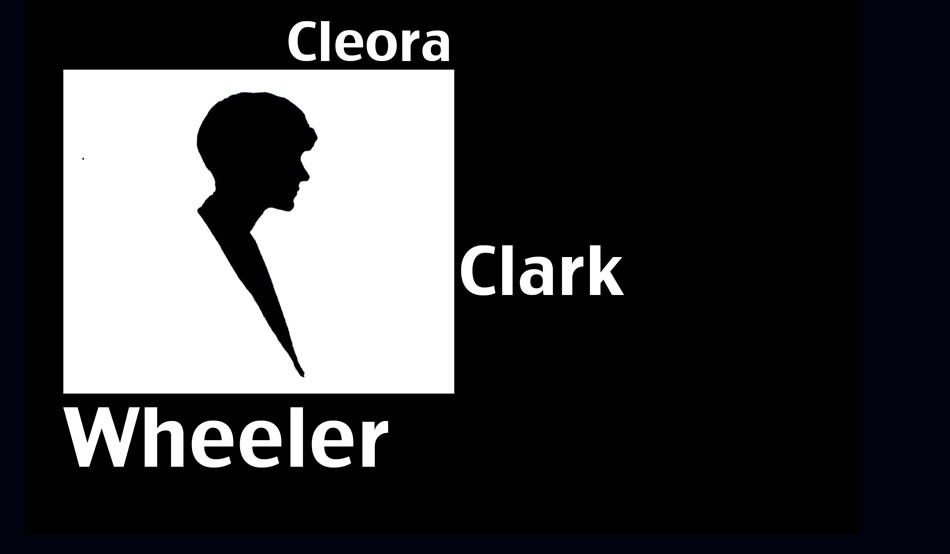 "Silhouette Self Portrait of Minnesota artist Cleora Clark Wheeler" ca. 1926. (typography added by this website) The photograph was used to illustrate an article written by her published in The Key, the quarterly magazine for Wheeler's fraternity Kappa Kappa Gamma in December, 1926. (p. 500)
"Silhouette Self Portrait of Minnesota artist Cleora Clark Wheeler" ca. 1926. (typography added by this website) The photograph was used to illustrate an article written by her published in The Key, the quarterly magazine for Wheeler's fraternity Kappa Kappa Gamma in December, 1926. (p. 500)
“anyone who saw the interested crowd getting their pictures on banquet night just before we all parted, will be sure it proved there is a way to have one’s picture taken without having one’s head turned.”
Using said dishpans in the title to this post, procured from a nearby hardware store outside Oakland, California, Cleora, or Cleo as she was known, went on to secure these pans used as reflectors for the photo shoot using her mother’s wooden tomato supports, placed in the trunk of her car before heading to the annual convention that year at Mills College from her St. Paul, MN home, a journey of 2000 miles.
So we will say it with our own flowers here: on the occasion of PhotoSeed posting a rare surviving folio volume of 23 of her delicate Japan-tissue photogravures of California landscapes taken and printed by Wheeler used as a sales catalogue, some further context into the life of this fascinating and talented woman is necessary in order to fill in the historical record.
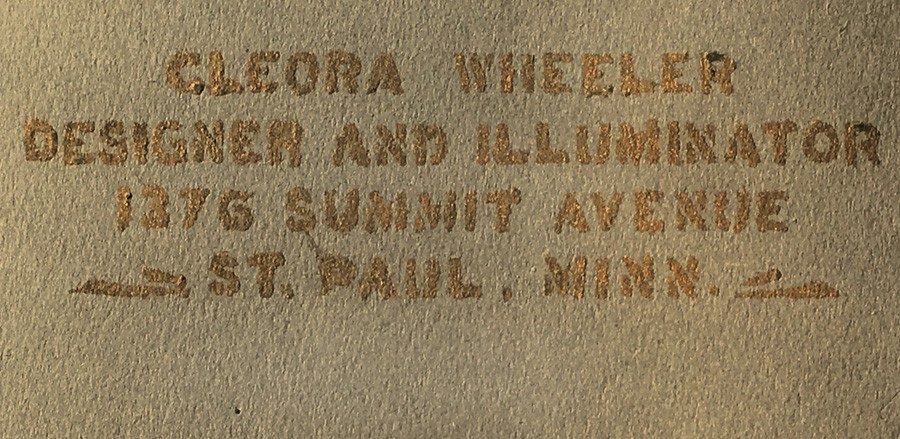 Detail: Title of California Sample Book by Cleora Clark Wheeler, American: 1882-1980: gilt hand-lettering: "Cleora Wheeler Designer And Illuminator 1376 Summit Avenue St. Paul, Minn." 33.0 x 50.0 cm: folded, olive-colored cardstock leaf used as album cover. From: PhotoSeed Archive
Detail: Title of California Sample Book by Cleora Clark Wheeler, American: 1882-1980: gilt hand-lettering: "Cleora Wheeler Designer And Illuminator 1376 Summit Avenue St. Paul, Minn." 33.0 x 50.0 cm: folded, olive-colored cardstock leaf used as album cover. From: PhotoSeed Archive
To be clear, photography was just one of the many talents American artist Cleora Wheeler employed in her 98 years. Although never married, it might be said her significant partner through life was her beloved fraternity, Kappa Kappa Gamma, which she was initiated into at the Chi chapter at the University of Minnesota on October 9, 1899. Graduating in 1903, she went on to serve Kappa her entire life.
A designer and illuminator, as she would often describe herself while working out of the third floor studio of her longtime St. Paul family home, often in the act of creating unique bookplates and greeting cards, Cleora wore many professional hats. Artist, poet, school teacher, women’s advocate, business manager, an expert in steel die stamping, photographer and tireless promoter of her fraternity both locally in Minnesota and around the country were but a few of her passions.
With the knowledge that “Miss Wheeler thinks of California as her second home” as noted in a follow-up article describing her hand-colored photographic work and bookplates on display in 1922 at the St. Paul Public Library, her love of place and record of spirit is evident in pictorial photographic work taken in the American West ca. 1914-1921: a reaffirmation of the cross-pollination taking place in the arts by unconventional practitioners.
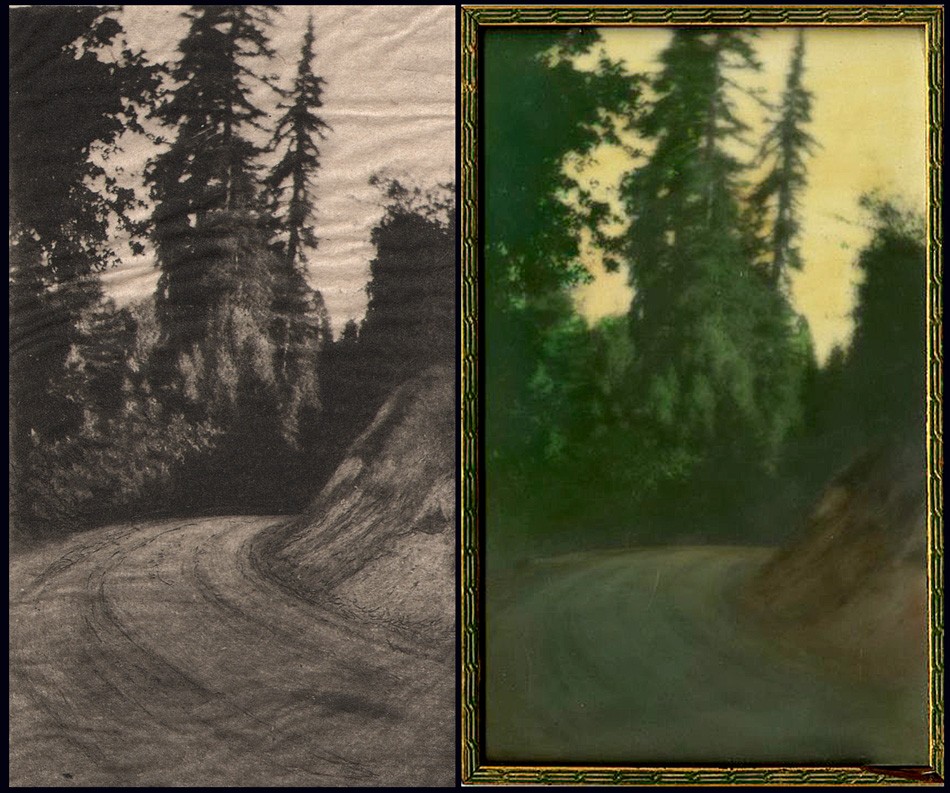 Left: "Redwoods": Cleora Clark Wheeler, American-1882-1980: ca. 1922: hand-pulled Japan-tissue photogravure: 10.7 x 6.2 | 20.8 x 15.1 Gampi | 25.0 x 38.0 off-white handmade paper (folded) | 33.0 x 25.0 cm olive-colored cardstock leaf. From: PhotoSeed Archive. Right: "Redwoods": ca. 1922: Cleora Clark Wheeler: hand-colored gelatin silver exhibition print from the artist's 1922 St. Paul exhibition Atmospheric Studies. A roadway in the Sierra Mountains leads to a stand of soaring redwood trees in this landscape study colored with Japanese dyes. Courtesy: Grapefruit Moon Gallery auction listing, Minneapolis MN.
Left: "Redwoods": Cleora Clark Wheeler, American-1882-1980: ca. 1922: hand-pulled Japan-tissue photogravure: 10.7 x 6.2 | 20.8 x 15.1 Gampi | 25.0 x 38.0 off-white handmade paper (folded) | 33.0 x 25.0 cm olive-colored cardstock leaf. From: PhotoSeed Archive. Right: "Redwoods": ca. 1922: Cleora Clark Wheeler: hand-colored gelatin silver exhibition print from the artist's 1922 St. Paul exhibition Atmospheric Studies. A roadway in the Sierra Mountains leads to a stand of soaring redwood trees in this landscape study colored with Japanese dyes. Courtesy: Grapefruit Moon Gallery auction listing, Minneapolis MN.
The following timeline by year in the life of Cleora Wheeler is meant as a starting point for this remarkable artist. It begins with her birth in Austin, Minnesota in 1882 and concludes with a 1980 obituary printed in her alumni magazine. Although long-winded in some cases, I’ve decided to include some of the expanded background articles written by and about Wheeler in The Key, the Kappa Kappa Gamma quarterly. In addition to photographic work by Wheeler held by this archive, a link to 45 bookplates held in the Helen Brainerd Lay Bookplate Collection at Mount Holyoke College in South Hadley, Massachusetts can be found here, and a general search link to the Wheeler family archive at the Minnesota Historical Society Library catalogue is here. (type in “Cleora Clark Wheeler”) Further suggestions for inclusion are welcomed. Please contact me through the blog or at admin@photoseed.com.
David Spencer- February, 2018
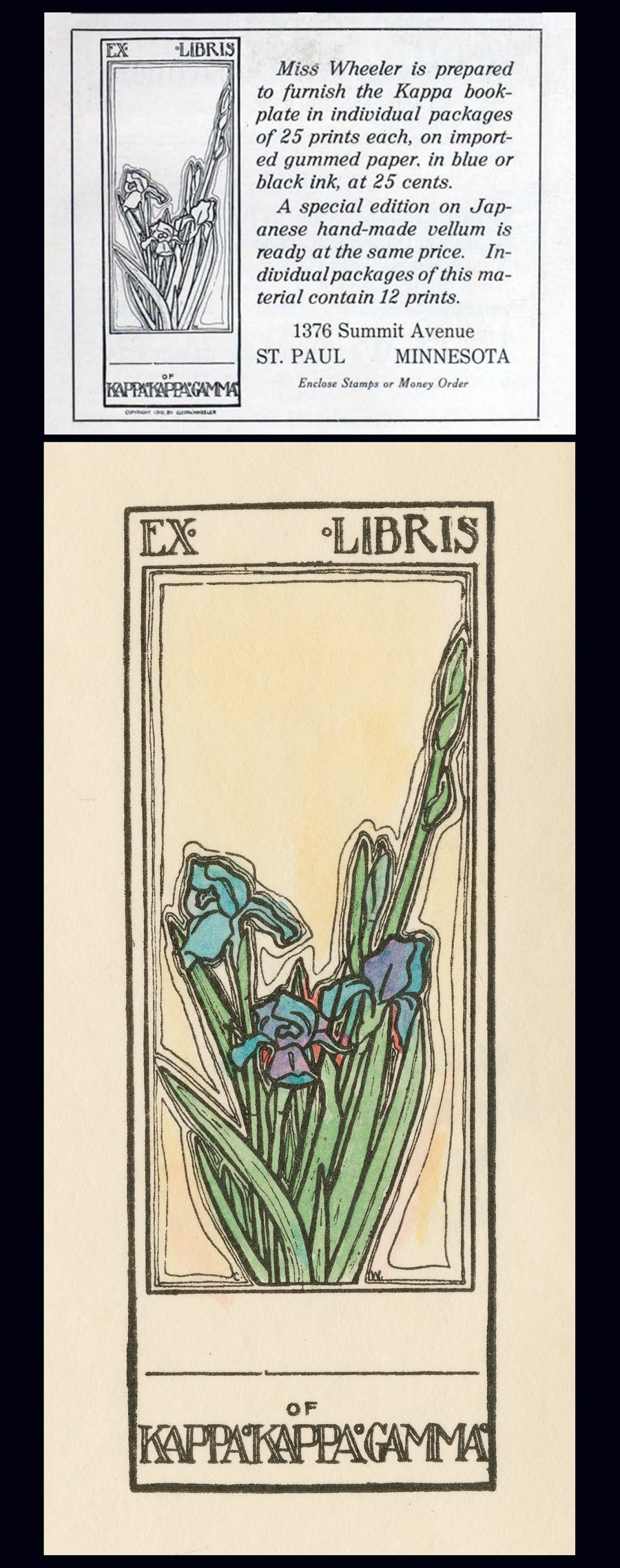 Top: December, 1910 advertisement for new Ex-Libris book plate designed the same year by Minnesota artist Cleora Clark Wheeler as it appeared in The Key, the quarterly magazine of her fraternity Kappa Kappa Gamma. Bottom: "Ex Libris of Kappa Kappa Gamma, by Cleora Clark Wheeler": (American: 1882-1980). Ca. 1920-30. Hand-colored book plate shows the fleur-de-lis iris, the fraternity flower, with the artist's initials CW appearing on opposite sides of the base of cut flowers. Courtesy: Helen Brainerd Lay Bookplate Collection, Mount Holyoke College Archives and Special Collections: Identifier: ms0048-s02-b02-f15-i001.
Top: December, 1910 advertisement for new Ex-Libris book plate designed the same year by Minnesota artist Cleora Clark Wheeler as it appeared in The Key, the quarterly magazine of her fraternity Kappa Kappa Gamma. Bottom: "Ex Libris of Kappa Kappa Gamma, by Cleora Clark Wheeler": (American: 1882-1980). Ca. 1920-30. Hand-colored book plate shows the fleur-de-lis iris, the fraternity flower, with the artist's initials CW appearing on opposite sides of the base of cut flowers. Courtesy: Helen Brainerd Lay Bookplate Collection, Mount Holyoke College Archives and Special Collections: Identifier: ms0048-s02-b02-f15-i001.
Timeline: Cleora Clark Wheeler: 1882-1980
1882: Wheeler is born in Austin, Minnesota. Her father, Rush Benjamin Wheeler, (1844-1930) was an East coast transplant who graduated from Yale. He was a lawyer involved in banking and real estate. Her mother Harriet Sophia Clark Wheeler (1853-1938) was a graduate of the University of Minnesota. Her siblings were two brothers: Frost Montaine Wheeler: 1878-1963 & Ross Clark Wheeler: 1886-1901. The family lived in St. Paul.
1903: Graduates from The University of Minnesota with a Bachelor of Arts degree in English. She later went on to earn certificates of proficiency in engineering drafting and advanced engineering drafting from U. M.
⎯ Moves to California and lives for a year: “Cleora Wheeler’s first work with the Young Women’s Christian Association was in California. Soon after her graduation from the University of Minnesota she was asked by Miss Louise Brooks of New York, national secretary of conventions and conferences, to be her assistant at the student conference at Capitola, Cal.” source: 1921 background on Wheeler in The Key.
⎯ “Miss Wheeler thinks of California as her second home, as she spent a year with Pi after graduating at Minnesota.” -The Key: 1926 (Pi chapter at the University of California, Berkeley)
1904: Named Grand Registrar for the Grand Council of Kappa Kappa Gamma, with offices at 301 Pioneer Press Building in St. Paul, MN. source: The Key, October.
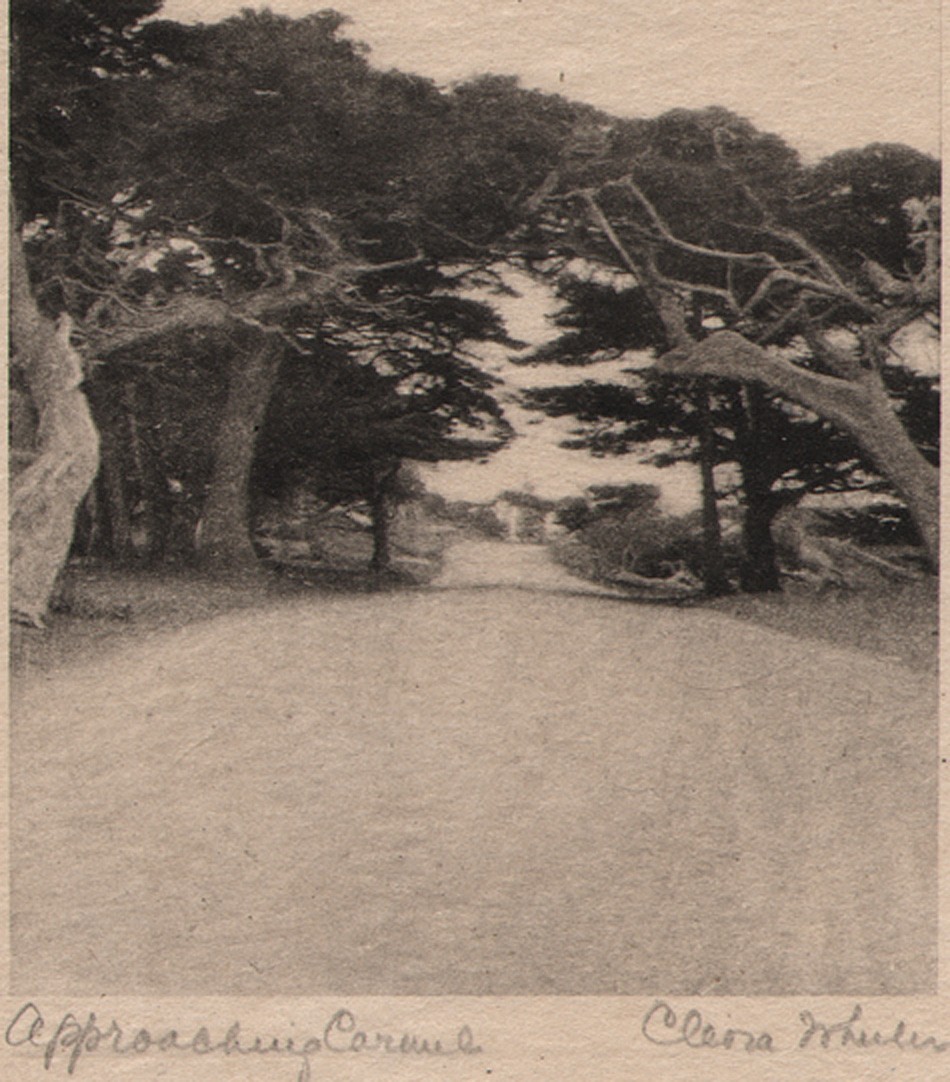 Detail: "Approaching Carmel": Cleora Clark Wheeler, American: 1882-1980. Hand-pulled Japan-tissue photogravure ca. 1922: 10.2 x 7.5 | 21.0 x 15.3 Gampi | 24.2 x 38.0 off-white handmade paper (folded) | 33.0 x 25.0 cm olive-colored cardstock leaf. An archway of cypress trees near Carmel, California frames the famed Seventeen-Mile Drive along the Monterey coastline. From: PhotoSeed Archive
Detail: "Approaching Carmel": Cleora Clark Wheeler, American: 1882-1980. Hand-pulled Japan-tissue photogravure ca. 1922: 10.2 x 7.5 | 21.0 x 15.3 Gampi | 24.2 x 38.0 off-white handmade paper (folded) | 33.0 x 25.0 cm olive-colored cardstock leaf. An archway of cypress trees near Carmel, California frames the famed Seventeen-Mile Drive along the Monterey coastline. From: PhotoSeed Archive
1905: Wheeler’s love of nature, a major theme that would soon emerge in her art, makes an initial greeting as Grand Registrar:
To all in Kappa Kappa Gamma, greetings! The wild thing of the woods has its call; the brook, playing with the bits of forest light and shadow, murmurs to itself; the wind, sighing through the trees, croons its melody and dies away; all nature is at peace, and sings. Song is the outpouring of a soul that cannot contain itself for very joy. Friendship is the life of that soul; a happiness too often unappreciated until perchance it is snatched away, only to leave a memory in its place. May we be worthy of this name of friend, appreciating more fully with each day the fortune that is ours. May we know a courtesy among ourselves that shall unconsciously touch each life we meet. May personal responsibility and devotion broaden into mutual helpfulness, and interest, and charity, until it meet and grace the world of kindly sympathy. (The Key: January: p. 298)
⎯ Writes a poem in tribute to Anne Jones, a fellow Chi chapter member at the University of Minnesota, most likely a personal friend:
Jones. April 5, 1884-July 3, 1905. Initiated into Chi Chapter of Kappa Kappa Gamma October 16, 1902.
As breath of morning gently steals its way O’er sleeping valleys where the morning mist Half timidly awaits the smile of day, Gray mantled, ere the sun has kissed To gold the dim dew-crystaled haze, And gliding soft with footsteps all to fleet For ken of humankind, from out the maze Brings memories, intangible, replete With wonder-fancies, melodies akin To whisperings of heaven; thus she came, Her arms light laden with the green of springA radiance as summer showers win In afterglow, long held ere twilight claim A melody, low borne on evening wing.
-Cleora Clark Wheeler. (The Key: October: p. 534)
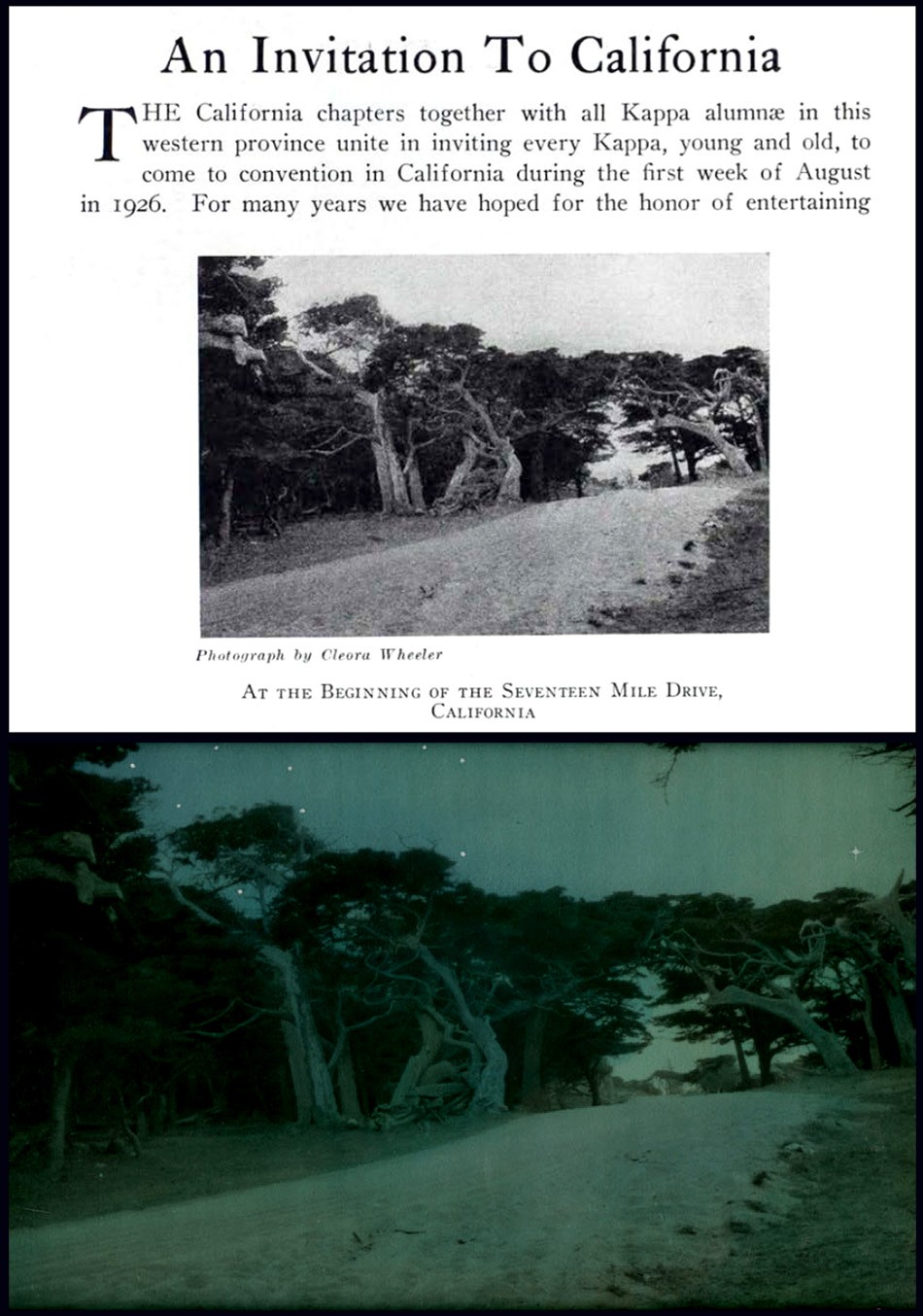 Top: "At the Beginning of The Seventeen Mile Drive": halftone photographic reproduction by Cleora Clark Wheeler used to illustrate article on annual convention for her fraternity Kappa Kappa Gamma. Taken from December, 1925 issue of The Key, the quarterly magazine of the fraternity. The photograph is a variant of her photo titled "Approaching Carmel" seen earlier in this post. Bottom: "After Nightfall": ca. 1922: Cleora Clark Wheeler: hand-colored gelatin silver exhibition print from the artist's 1922 St. Paul exhibition Atmospheric Studies. Another variant of the halftone seen above, Wheeler used Japanese dyes and hand-painted white stars in the sky for this landscape transformed into a nighttime view featuring a twilight blue sky. Courtesy: Grapefruit Moon Gallery auction listing, Minneapolis MN.
Top: "At the Beginning of The Seventeen Mile Drive": halftone photographic reproduction by Cleora Clark Wheeler used to illustrate article on annual convention for her fraternity Kappa Kappa Gamma. Taken from December, 1925 issue of The Key, the quarterly magazine of the fraternity. The photograph is a variant of her photo titled "Approaching Carmel" seen earlier in this post. Bottom: "After Nightfall": ca. 1922: Cleora Clark Wheeler: hand-colored gelatin silver exhibition print from the artist's 1922 St. Paul exhibition Atmospheric Studies. Another variant of the halftone seen above, Wheeler used Japanese dyes and hand-painted white stars in the sky for this landscape transformed into a nighttime view featuring a twilight blue sky. Courtesy: Grapefruit Moon Gallery auction listing, Minneapolis MN.
1906: Wheeler now living in Berkeley, CA, possibly for reasons of health, where she continue her duties as Grand Registrar: Notices:
“Record charts may be ordered by chapters or individuals at any time. One dollar, including postage; twenty-five cents in addition if backed with linen. Address care Corresponding Secretary of Pi chapter, Berkeley, California. Cleora Clark Wheeler.” (The Key: October: p. 262)
1907: Relinquishes her duties as Grand Registrar by January. In February, a confirmed report in The Key (p. 71) states health is the reason for her absence from MN:
“Cleora Wheeler, whom you all met at convention; is spending the winter in California. We miss her very much, but are glad to say that her health is greatly improved.”
1909: Takes up work again with the Young Women’s Christian Association, (YWCA) with a notice in the February issue of The Key that she is now the business secretary of the St. Paul Young Women’s Christian Association. (p. 72)
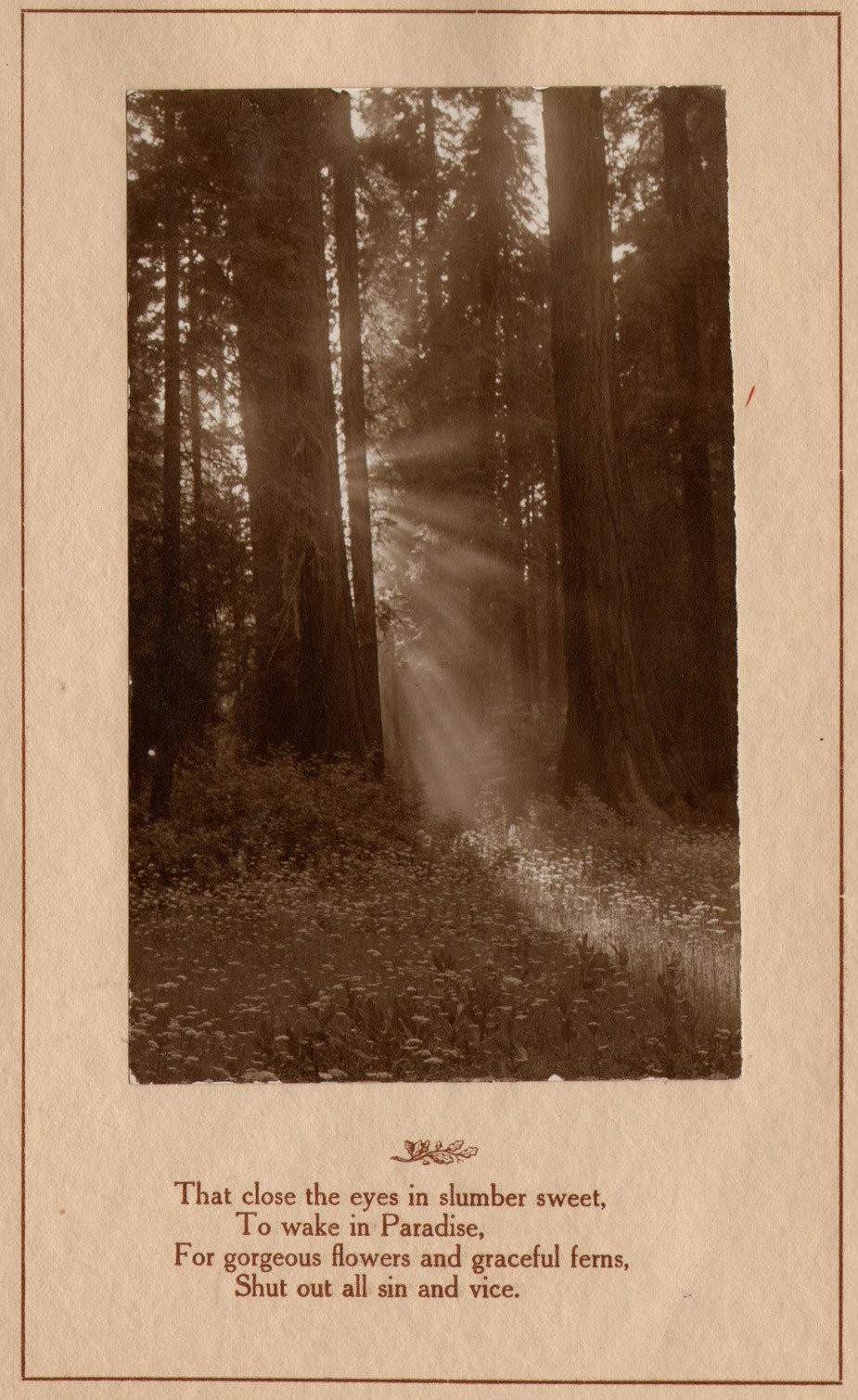 "Sunlight thro' the Redwoods": Lindley Eddy, American: 1873-1946: ca. 1914. 14.0 x 8.5 cm. Tipped to page: 21.5 x 14.0 cm. Sepia gelatin silver print included in volume A Traveler's Prayer of California Mountains, photographs by Lindley Eddy with poems by Olive Hinds Simpson: Visalia, CA: Commercial Printing Co.- copyrighted 1914 by Olive A. Simpson. It would have undoubtedly appealed to the artistic sensibilities of Cleora Clark Wheeler had she come across this volume of poetry featuring ten photographs taken by Eddy in the Sequoia National Forest. The work was published the same year it is believed Wheeler first took up her series of western US photographs in Colorado. From: PhotoSeed Archive (volume for sale: please inquire)
"Sunlight thro' the Redwoods": Lindley Eddy, American: 1873-1946: ca. 1914. 14.0 x 8.5 cm. Tipped to page: 21.5 x 14.0 cm. Sepia gelatin silver print included in volume A Traveler's Prayer of California Mountains, photographs by Lindley Eddy with poems by Olive Hinds Simpson: Visalia, CA: Commercial Printing Co.- copyrighted 1914 by Olive A. Simpson. It would have undoubtedly appealed to the artistic sensibilities of Cleora Clark Wheeler had she come across this volume of poetry featuring ten photographs taken by Eddy in the Sequoia National Forest. The work was published the same year it is believed Wheeler first took up her series of western US photographs in Colorado. From: PhotoSeed Archive (volume for sale: please inquire)
1910: The first advertisement for Wheeler artwork appears in the October issue of The Key for what is believed to be her new book plate, although it’s described as a “plate book”. Showing her business savvy, earlier in August she had registered copyright in her own name for the design:
THE
Official Plate Book of the Fraternity
IN INDIVIDUAL PACKAGES
25 CENTS
Plan to Send Them at the Holidays
ORDER EARLY
Enclose Stamps or Money Order
1376 Summitt Ave. Cleora Wheeler St. Paul, Minn.
⎯ A notice in the December issue of The Key along with an accompanying photograph of the artist that Wheeler had indeed designed the official bookplate for her fraternity:
THE KAPPA BOOK-PLATE
There have been a number of inquiries as to the designer of the Kappa Kappa Gamma book-plate, which was adopted by the Grand Council at Convention Session as the official book-plate of the Fraternity. The plate was designed by Cleora Clark Wheeler, of Chi Chapter, who was Grand Registrar from 1904 to 1906. Miss Wheeler was particularly happy in her choice of the fraternity flower for decoration; for the fleur-de-lis with its long stem and heavy blossom lends itself with special effectiveness to composition. The Kappa bookplate should be an incentive to the growth of our chapter-house libraries; for the chapter name may be used in it, just as well as that of the individual owner.
(note: At the 1890 convention, the fraternity chose the fleur-de-lis “as the Kappa flower for its dignity and grace and because in it the two blues are combined.”)
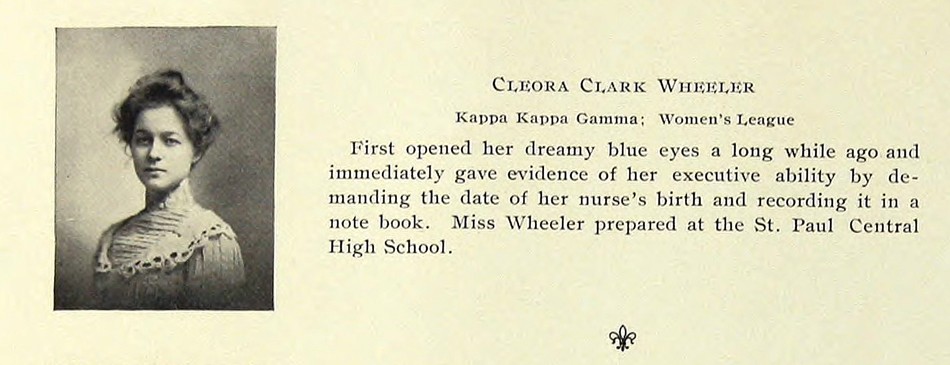 The senior portrait and entry for Minnesota artist Cleora Clark Wheeler as it appeared in her 1903 University of Minnesota Gopher yearbook. Wheeler, 1882-1980, graduated that year with a Bachelor of Arts degree in English and went on to earn certificates of proficiency in engineering drafting and advanced engineering drafting from U. M. Source: online pdf of The Gopher: Vol. 16, 1903: p. 78.
The senior portrait and entry for Minnesota artist Cleora Clark Wheeler as it appeared in her 1903 University of Minnesota Gopher yearbook. Wheeler, 1882-1980, graduated that year with a Bachelor of Arts degree in English and went on to earn certificates of proficiency in engineering drafting and advanced engineering drafting from U. M. Source: online pdf of The Gopher: Vol. 16, 1903: p. 78.
1911: With the rough design of a new Kappa crest duly recorded in a 1910 committee report, the intent of the adoption of an official coat-of-arms for Kappa was soon becoming reality. (discussions began in 1905) Because of this and given her proven design expertise on behalf of the fraternity, and with the aim of surely involving her in other design decisions regarding fraternity insignia, Wheeler is appointed by February as new Custodian of the Badge, an important oversight and secretarial role for the official fraternity Badge, a piece of jewelry in the shape of a golden key stamped with the Greek letters for Kappa and worn by chapter members. Wheeler’s role would have been to make sure changes to the key were permissible, and she held the position as Custodian through 1917.
⎯ In the October issue of The Key, two separate advertisements for Wheeler’s new book plate design featuring the fleur-de-lis iris appear. One, for correspondence cards, are stamped in gold and priced at 35 cents a dozen. Another is for her bookplate:
The KAPPA BOOK-PLATE
Several times the size
of this cut
In Individual Packages
of 25 Prints
Blue or black ink on English
gummed paper -25 cents
Black ink on Japanese handmade Vellum-50 cents
Tinted prints-50 cents a dozen
The design same size as the Book-Plate
adapted to Dinner Cards and Folders ⎯
Cards : Untinted, 30 cents a dozen
Tinted, 50 cents
Folders: Untinted, 50 cents a dozen
Tinted, 75 cents
Address: CLEORA WHEELER
1376 Summit Ave., St. Paul, Minn,
Enclose Stamps or Money Order
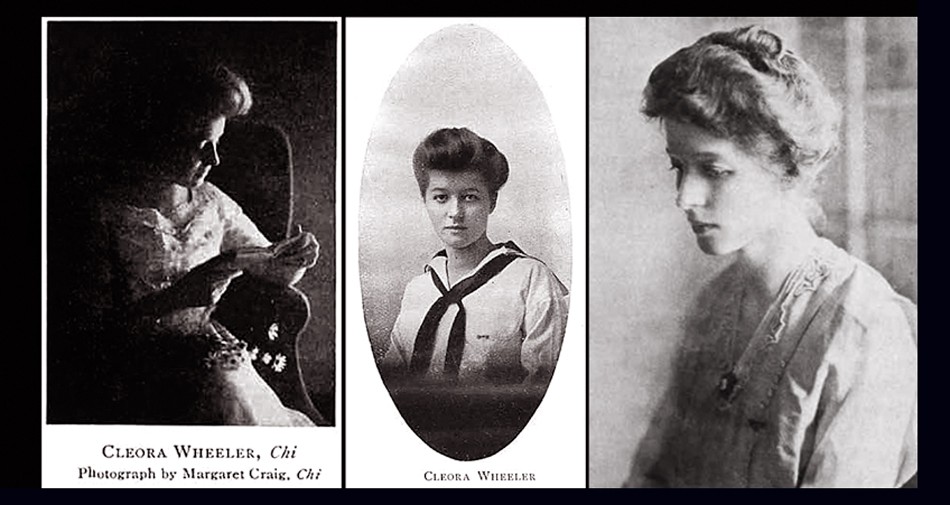 An early triptych of halftone portraits of Minnesota artist Cleora Clark Wheeler. Left: Studying a book, perhaps taken while she was still an undergraduate at the University of Minnesota in the very early 20th Century. Photo by fellow Kappa Kappa Gamma Chi chapter member Margaret Craig published in a 1910 issue of the fraternity quarterly The Key. Middle: Portrait of Wheeler in a sailor-inspired tunic as it appeared in the February, 1913 issue of The Key illustrating an article she wrote titled "Character By Handwriting- And Otherwise." Right: a photograph of Wheeler taken ca. 1911-17 when she was Custodian of the Badge, an important oversight and secretarial role for the official fraternity Badge, a piece of jewelry in the shape of a golden key stamped with the Greek letters for Kappa and worn by chapter members. Photo reproduced in the Fall 1977 issue of The Key.
An early triptych of halftone portraits of Minnesota artist Cleora Clark Wheeler. Left: Studying a book, perhaps taken while she was still an undergraduate at the University of Minnesota in the very early 20th Century. Photo by fellow Kappa Kappa Gamma Chi chapter member Margaret Craig published in a 1910 issue of the fraternity quarterly The Key. Middle: Portrait of Wheeler in a sailor-inspired tunic as it appeared in the February, 1913 issue of The Key illustrating an article she wrote titled "Character By Handwriting- And Otherwise." Right: a photograph of Wheeler taken ca. 1911-17 when she was Custodian of the Badge, an important oversight and secretarial role for the official fraternity Badge, a piece of jewelry in the shape of a golden key stamped with the Greek letters for Kappa and worn by chapter members. Photo reproduced in the Fall 1977 issue of The Key.
1912: Wheeler becomes artistically involved in creating metal dies for the new fraternity coat-of-arms (also referred to as the crest) after consulting with the British College of Arms. Earlier in 1910, A National Committee for Kappa, with Margaret Brown Moore appointed Chairman, produced the new coat-of-arms. Brown designed it with advice and help from Joanna Strange, BZ-Iowa, head of the reference department of the Carnegie Library in Pittsburgh, as well as from J. F. Hopkins, the designer of the Sigma Nu coat of arms. Moore’s design was then put on paper in the form of a watercolor sketch by Philadelphia heraldry expert Mark J. Rowe: “Margaret urged the Fraternity to protect the design so that “the technically perfect coat-of-arms will not be lost to us.” She expressed a wish that there should be perfect dies for stamping in gold and silver as well as plates for printing on documents and reports. Cleora Wheeler, Minnesota, prepared such plates and dies. The College of Arms in England was consulted before Cleora cut her die in filigree and it was made after the others that were modeled in the regulation way. When these were done, Margaret Moore declared that perfect reproductions had been made.” (1.)
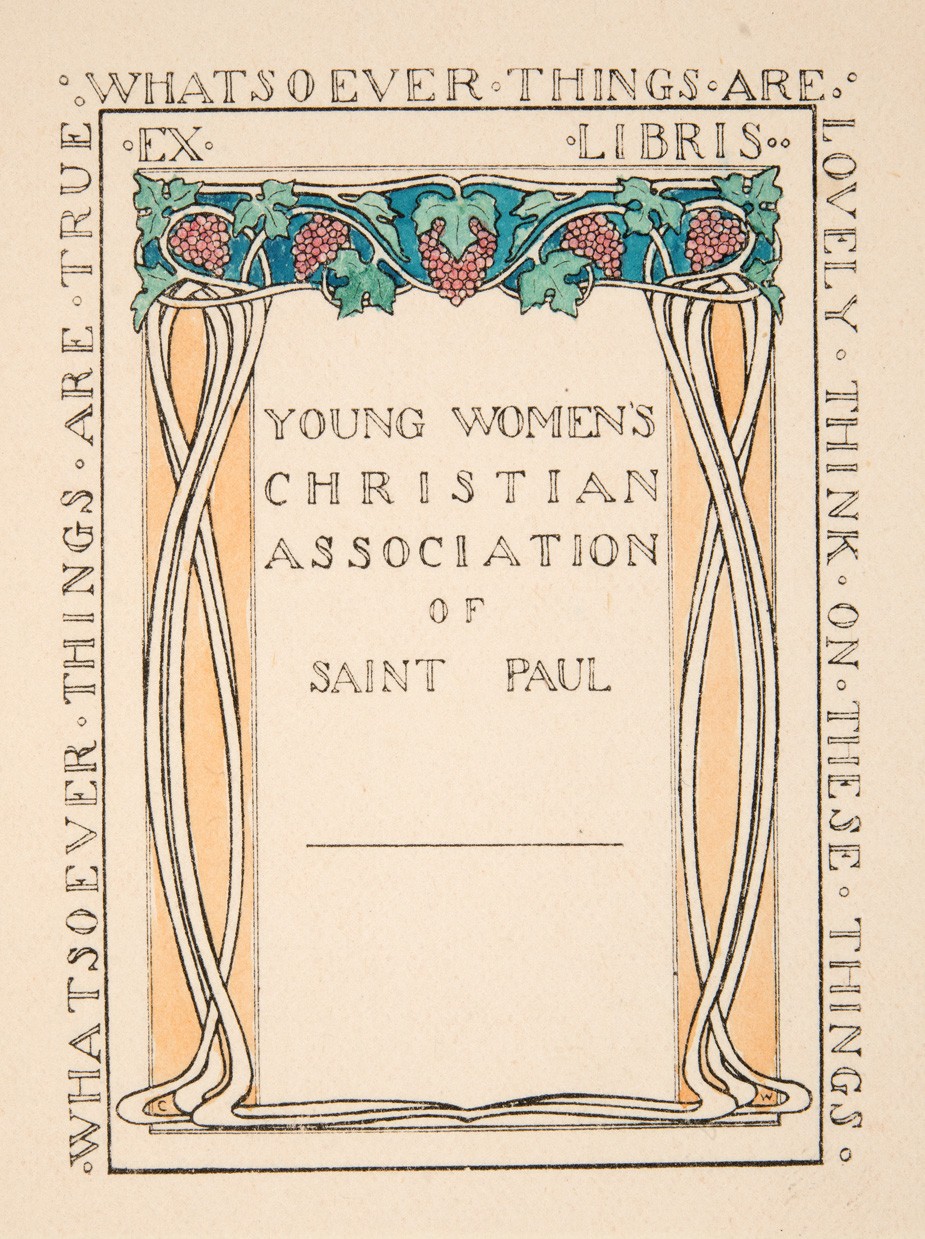 "Ex Libris Young Women's Christian Association of Saint Paul, by Cleora Clark Wheeler": (American: 1882-1980). Ca. 1915-25. Hand-colored book plate shows an archway of grape clusters with stems forming a pair of opposing columns. The YWCA organization is spelled out at center while the whole is surrounded by extracted Bible verses from Philippians 4:8: "Whatsoever Things Are True - Whatsoever Thing Are Lovely - Think On These Things". Wheeler first worked with the YWCA in California in late 1903 after her graduation from the University of Minnesota and in 1909 became business secretary for the St. Paul chapter. A 1921 article in The Key profiling Wheeler's accomplishments stated: "The national bookplate of the association used in all of the books at the National Training School, and in association libraries throughout the country is designed by Miss Wheeler". Courtesy: Helen Brainerd Lay Bookplate Collection, Mount Holyoke College Archives and Special Collections: Identifier: ms0048-s02-b02-f15-i011.
"Ex Libris Young Women's Christian Association of Saint Paul, by Cleora Clark Wheeler": (American: 1882-1980). Ca. 1915-25. Hand-colored book plate shows an archway of grape clusters with stems forming a pair of opposing columns. The YWCA organization is spelled out at center while the whole is surrounded by extracted Bible verses from Philippians 4:8: "Whatsoever Things Are True - Whatsoever Thing Are Lovely - Think On These Things". Wheeler first worked with the YWCA in California in late 1903 after her graduation from the University of Minnesota and in 1909 became business secretary for the St. Paul chapter. A 1921 article in The Key profiling Wheeler's accomplishments stated: "The national bookplate of the association used in all of the books at the National Training School, and in association libraries throughout the country is designed by Miss Wheeler". Courtesy: Helen Brainerd Lay Bookplate Collection, Mount Holyoke College Archives and Special Collections: Identifier: ms0048-s02-b02-f15-i011.
1912-13: Wheeler moves to New York City and attends classes at The School of Fine and Applied Art, (now Parsons School of Design) where she studied color harmony. Two folders of notes, including those by Wheeler made during lectures given by Frank Alvah Parsons, are held by the school in the present day, as well as a set of her bookplates in the Kellen Design Archives. Sources: WorldCat and Minnesota 1900: Art and Life on the Upper Mississippi, 1890-1915: 1994, Newark: University of Delaware Press.
⎯ An article in the October issue of The Key for 1912 states Wheeler issues the limited edition book “Kappas I Have Known” in 250 copies:
A novelty in college scrap books was presented at Convention by Cleora Wheeler, Chi, in “Kappas I Have Known, ” which can be used not only in college, but as a life time fraternity record. The book is divided into sections, under the heads, “My Chapter,” ” National Officers”, and “Kappas From Other Chapters;” and further space is provided for songs and other miscellaneous entries. The book is bound with stubs, so that clippings and snapshots may be pasted in to illustrate the careers of the notable Kappas therein enrolled. And a particularly pretty Kappa touch is added by the Fleur-de-lis design on each page, and the blue and blue binding. (p. 257)
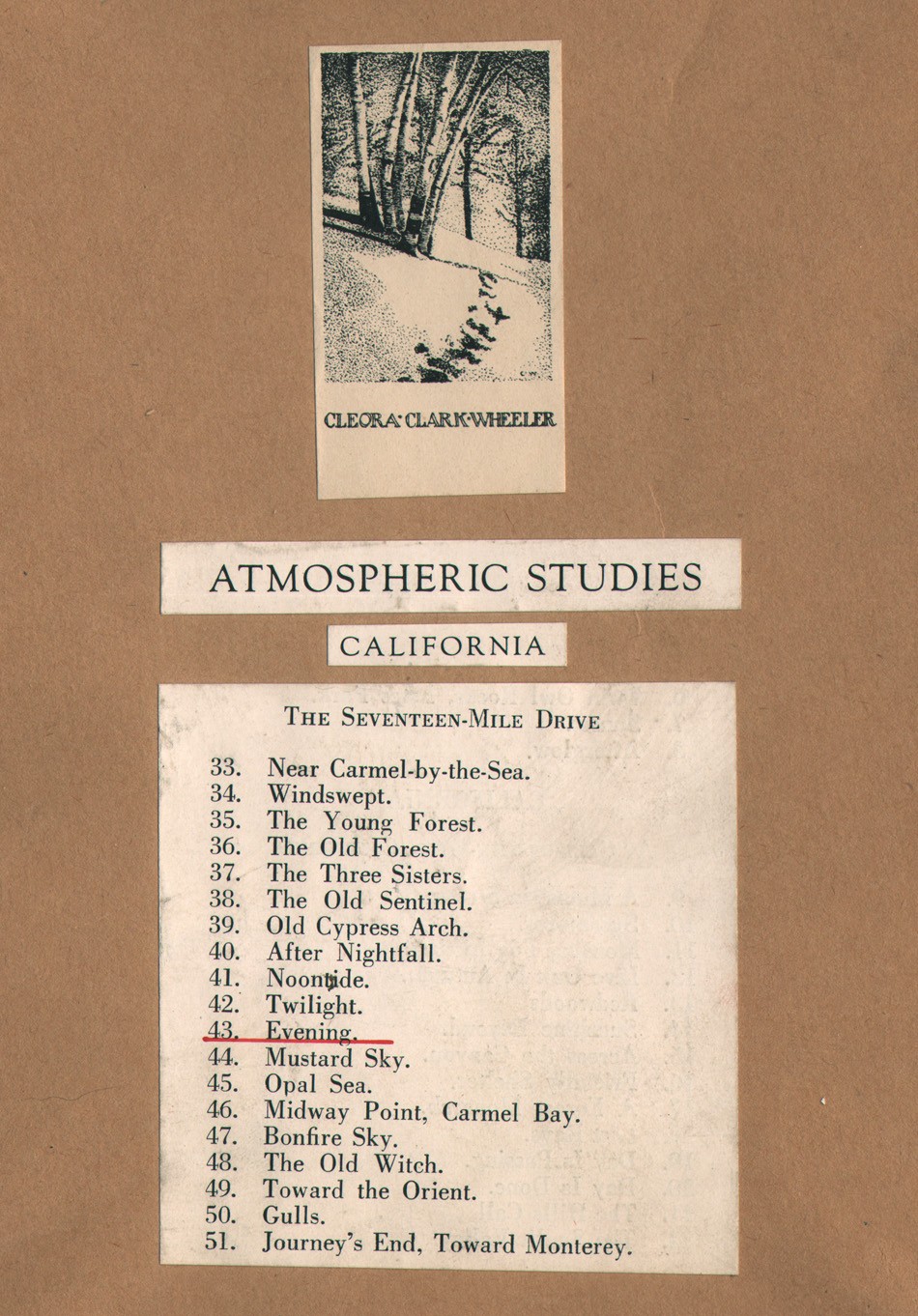 Detail: Frame verso: "Evening", by Cleora Clark Wheeler, American: 1882-1980. ca. 1922: 24.7 x 19.8 cm. The original series of framed photographs appearing in Wheeler's 1922 St. Paul photographic exhibition "Atmospheric Studies" (& also most likely the 1926 San Francisco Paul Elder exhibition) were each finished off on the frame verso with one of several trimmed and pasted book plates identifying Wheeler as author of the work seen at top. Below it is a pasted and engraved listing for photographs included in a separate subheading for the exhibition that were taken in a particular region. This example shows "Evening" held by this archive and listed as #43 in the overall exhibition under Monterey's famed Seventeen-Mile Drive subheading. From: PhotoSeed Archive
Detail: Frame verso: "Evening", by Cleora Clark Wheeler, American: 1882-1980. ca. 1922: 24.7 x 19.8 cm. The original series of framed photographs appearing in Wheeler's 1922 St. Paul photographic exhibition "Atmospheric Studies" (& also most likely the 1926 San Francisco Paul Elder exhibition) were each finished off on the frame verso with one of several trimmed and pasted book plates identifying Wheeler as author of the work seen at top. Below it is a pasted and engraved listing for photographs included in a separate subheading for the exhibition that were taken in a particular region. This example shows "Evening" held by this archive and listed as #43 in the overall exhibition under Monterey's famed Seventeen-Mile Drive subheading. From: PhotoSeed Archive
Further details are included about this book, illustrated by a photograph in the advertising section for the December issue of The Key:
Bound in two-tone blue cloth with gold stamping; page decorations and headings in gray-blue ink to harmonize. Sewed by hand. special attention being given to the reinforcement of the back by transverse tapes, and by stubs arranged to offset extra bulk of Kodak Prints and Clippings. In this way the book not only offers space for such additions, but also overcomes the possibility of having it stand open when only partially filled. Edition Limited to 250 copies. Price $1.50 net $1.65 by mail.
1914: This may have been the first year Wheeler undertook her series of Western U.S. photographs that would eventually appear in her 1922 St. Paul exhibit Atmospheric Studies, under the exhibition heading Out Where The West Begins : Colorado. Sometime in the Fall, Wheeler travels to Boulder as part of fraternity business as noted in the December issue of The Key:
“We were very glad to have Miss Cleora Wheeler with us for luncheon, on her way home from a visit with Beta Mu at Boulder. We enjoyed hearing of the rushing season there, and also the interesting convention news from Miss Wheeler and the five Sigma girls who attended.”
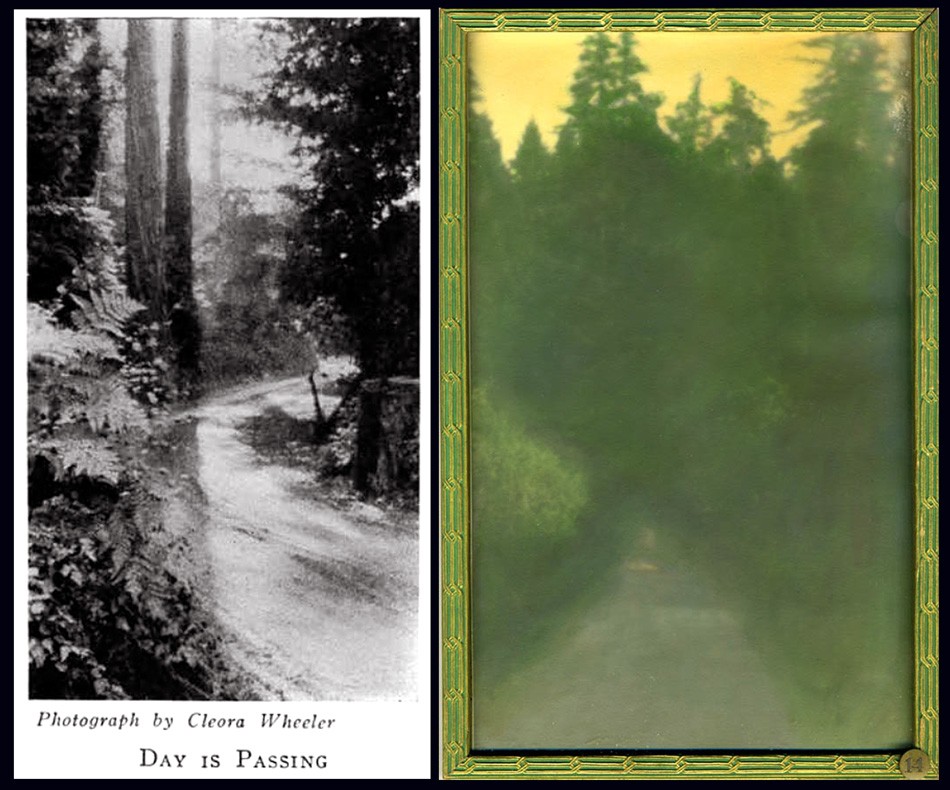 Two examples of photographs taken ca. 1914-1921 in the northern California Redwood region by Cleora Clark Wheeler were later first exhibited in her 1922 St. Paul, MN exhibition Atmospheric Studies. Listed under the subheading "At Call-Of-The-Wild, California", they are: Left: "Day Is Passing" (#19 in St. Paul): seen here as a halftone as it appeared in the February, 1926 issue of The Key. Right: "Sunshine Beyond" (#14 in St. Paul): ca. 1922: hand-colored gelatin silver exhibition print shows a roadway in the Sierra Mountains with a stand of Redwood trees in background all cast in a yellow glow. The effect was achieved with Japanese dyes. Courtesy: Grapefruit Moon Gallery auction listing, Minneapolis MN.
Two examples of photographs taken ca. 1914-1921 in the northern California Redwood region by Cleora Clark Wheeler were later first exhibited in her 1922 St. Paul, MN exhibition Atmospheric Studies. Listed under the subheading "At Call-Of-The-Wild, California", they are: Left: "Day Is Passing" (#19 in St. Paul): seen here as a halftone as it appeared in the February, 1926 issue of The Key. Right: "Sunshine Beyond" (#14 in St. Paul): ca. 1922: hand-colored gelatin silver exhibition print shows a roadway in the Sierra Mountains with a stand of Redwood trees in background all cast in a yellow glow. The effect was achieved with Japanese dyes. Courtesy: Grapefruit Moon Gallery auction listing, Minneapolis MN.
1915: Wheeler’s photographic skills come into play as she visits the U.S. states of Oklahoma, Kansas, Louisiana, Texas and Missouri while reporting on Kappa chapter houses for the article “Chapter Homes I Have Known”, accompanied by several halftones appearing in the December issue of The Key. (pp. 317-21)
⎯ The magazine cover design for The Key changes with the addition of a new hand-drawn crest (coat-of-arms) designed by recent Xi chapter graduate Ruth Anthony beginning with the May issue. This cover design was used through mid 1927 when it was replaced by a simplified navy blue crest against a gray background.
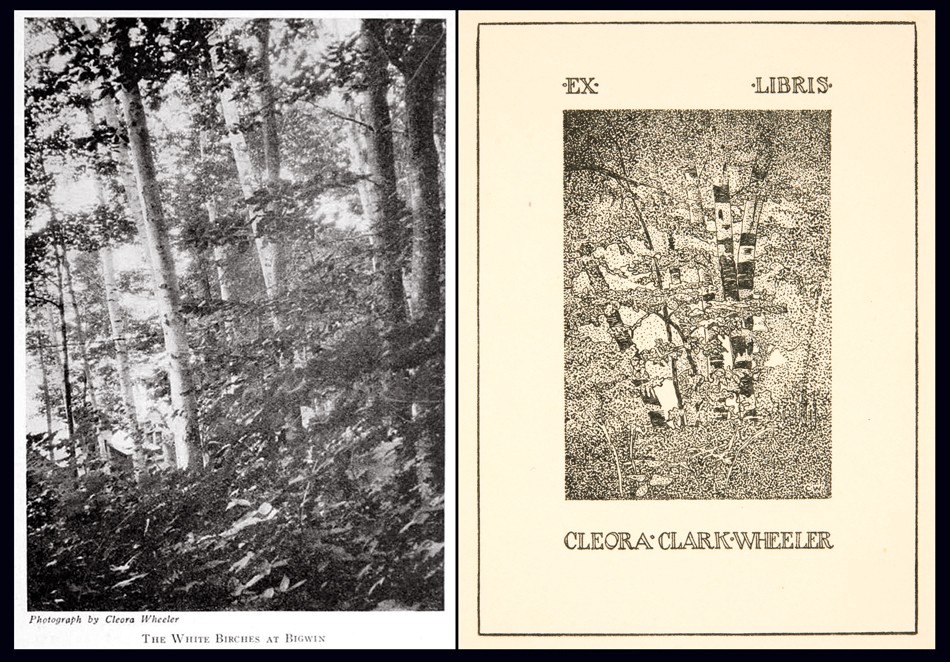 Several photographs by Cleora Clark Wheeler were most likely used as the basis for custom book plates engraved by the artist, as seen in this pairing. Left: "The White Birches At Bigwin" was a photograph taken in June, 1924 during the national Kappa Kappa Gamma convention held in Toronto, Canada at the Bigwin Inn and subsequently published as a halftone in the October, 1924 issue of fraternity quarterly, The Key. Right: "Ex Libris Cleora Clark Wheeler, by Cleora Clark Wheeler": This book plate drawn free-hand by the artist shows a similar grouping of White Birch trees. Examples of this book plate are known to have been pasted to the verso of more than one framed exhibition print included in Wheeler's 1922 exhibition Atmospheric Studies along with the additional designation of "California". This leads one to believe these frames were the ones shown in the 1926 Paul Elder Gallery exhibition in San Francisco. Courtesy: Helen Brainerd Lay Bookplate Collection, Mount Holyoke College Archives and Special Collections: Identifier: ms0048-s02-b02-f15-i029
Several photographs by Cleora Clark Wheeler were most likely used as the basis for custom book plates engraved by the artist, as seen in this pairing. Left: "The White Birches At Bigwin" was a photograph taken in June, 1924 during the national Kappa Kappa Gamma convention held in Toronto, Canada at the Bigwin Inn and subsequently published as a halftone in the October, 1924 issue of fraternity quarterly, The Key. Right: "Ex Libris Cleora Clark Wheeler, by Cleora Clark Wheeler": This book plate drawn free-hand by the artist shows a similar grouping of White Birch trees. Examples of this book plate are known to have been pasted to the verso of more than one framed exhibition print included in Wheeler's 1922 exhibition Atmospheric Studies along with the additional designation of "California". This leads one to believe these frames were the ones shown in the 1926 Paul Elder Gallery exhibition in San Francisco. Courtesy: Helen Brainerd Lay Bookplate Collection, Mount Holyoke College Archives and Special Collections: Identifier: ms0048-s02-b02-f15-i029
1916: Wheeler expands her offering of Kappa designs in a full page advertisement for book plates, dinner cards, social stationary and other items appearing in the February issue of The Key.
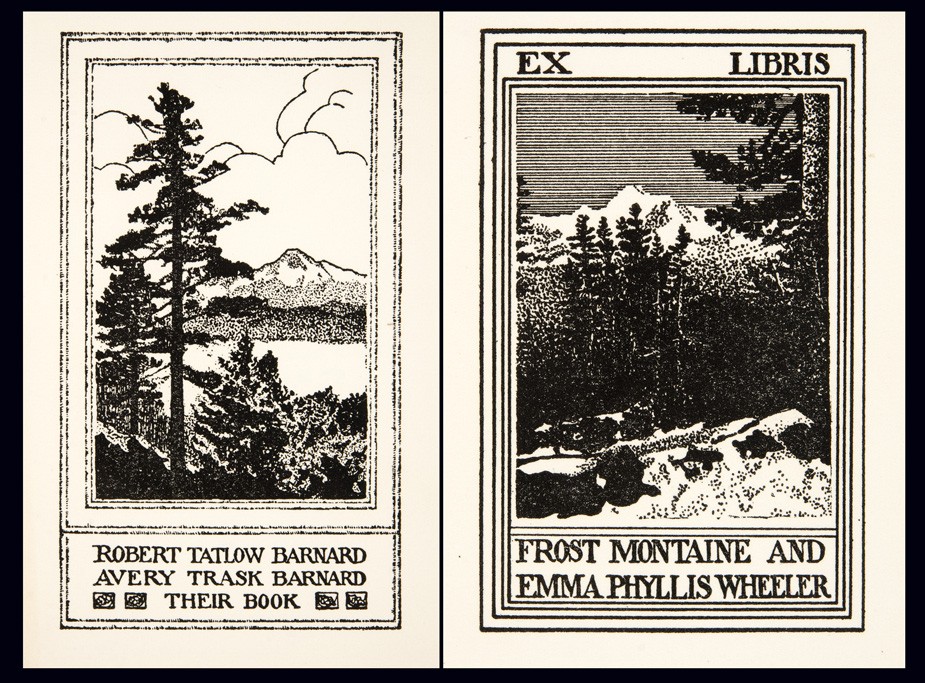 Believed to depict scenes in Colorado or California and may have been done from source photographs, examples of these bookplates by Cleora Clark Wheeler were exhibited at her 1922 St. Paul exhibition Atmospheric Studies. Left: "Robert Tatlow Barnard Avery Trask Barnard Their Book," by Cleora Clark Wheeler": ca. 1915-25. (Identifier ms0048-s02-b02-f15-i022). Right: "Ex Libris Frost Montaine and Emma Phyllis Wheeler," by Cleora Clark Wheeler": ca. 1915-25 (Identifier ms0048-s02-b02-f15-i021). Both courtesy Helen Brainerd Lay Bookplate Collection, Mount Holyoke College Archives and Special Collections.
Believed to depict scenes in Colorado or California and may have been done from source photographs, examples of these bookplates by Cleora Clark Wheeler were exhibited at her 1922 St. Paul exhibition Atmospheric Studies. Left: "Robert Tatlow Barnard Avery Trask Barnard Their Book," by Cleora Clark Wheeler": ca. 1915-25. (Identifier ms0048-s02-b02-f15-i022). Right: "Ex Libris Frost Montaine and Emma Phyllis Wheeler," by Cleora Clark Wheeler": ca. 1915-25 (Identifier ms0048-s02-b02-f15-i021). Both courtesy Helen Brainerd Lay Bookplate Collection, Mount Holyoke College Archives and Special Collections.
1918: In May, Wheeler becomes Director for the newly formed St. Paul Vocational Bureau for Trained Women:
1015 Commerce Building, St. Paul
MISS CLEORA WHEELER, DIRECTOR
Backed by the Women’s College Clubs of the Twin Cities, a Bureau for Trained Women was opened in Minneapolis within the last six months. The original idea was to open a branch office in St. Paul, with Miss Cleora Wheeler of St. Paul in charge. It came to be realized, however, that the work in the two cities would be sufficient in importance and scope to warrant the opening of two independent bureaus, so on the morning of May 8 the St. Paul Vocational Bureau for Trained Women opened its office for business. It is conducted under the auspices of the St. Paul College Club, the Vocational Committee assuming the responsibility of its organization and management, while Miss Wheeler is in charge as director.
Miss Wheeler was for five years chairman of the Vocational section of the St. Paul Association of Collegiate Alumnae, and served on the Board of Directors of the Minneapolis bureau during its organization period and until joining their salaried staff as temporary assistant. She was their representative at the February convention of the Association for the Promotion of Industrial and Vocational Education in Philadelphia; and visited the Collegiate bureaus of Philadelphia, New York, Boston, Detroit and Chicago. She also visited the headquarters of Women’s Work in Washington that the St. Paul office might fully cooperate with them and with the government.
The St. Paul bureau is particularly fortunate in securing office accommodations with the Ramsey County Women’s War Organization, and it is fully expected that this arrangement will prove mutually beneficial. (2.)
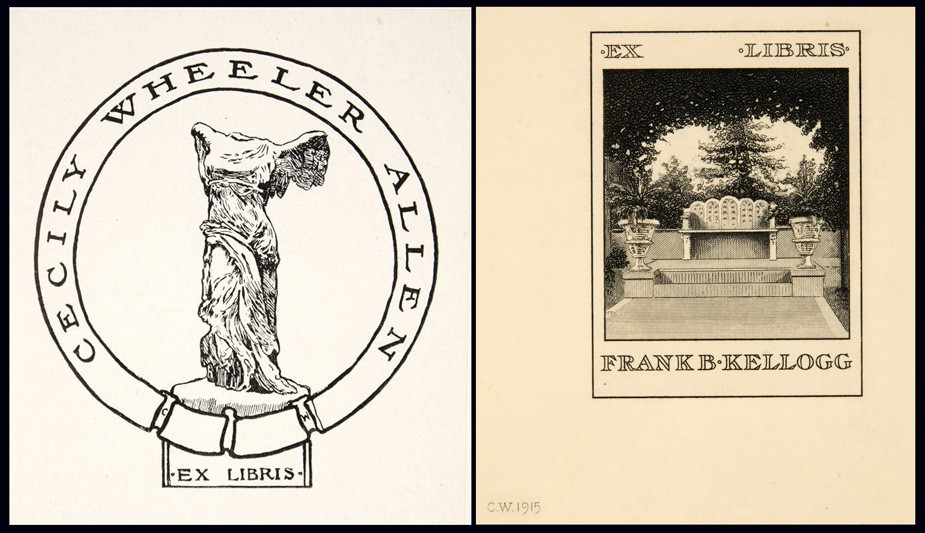 Examples of bookplates by Wheeler: Left: "Cecily Wheeler Allen Ex Libris, by Cleora Clark Wheeler" : ca. 1930-40. (Identifier ms0048-s02-b02-f15-i045). Right: "Ex Libris Frank B. Kellogg," by Cleora Clark Wheeler": 1915. This bookplate was shown at the artist's1922 St. Paul exhibition Atmospheric Studies. (Identifier ms0048-s02-b02-f15-i020). Both courtesy Helen Brainerd Lay Bookplate Collection, Mount Holyoke College Archives and Special Collections.
Examples of bookplates by Wheeler: Left: "Cecily Wheeler Allen Ex Libris, by Cleora Clark Wheeler" : ca. 1930-40. (Identifier ms0048-s02-b02-f15-i045). Right: "Ex Libris Frank B. Kellogg," by Cleora Clark Wheeler": 1915. This bookplate was shown at the artist's1922 St. Paul exhibition Atmospheric Studies. (Identifier ms0048-s02-b02-f15-i020). Both courtesy Helen Brainerd Lay Bookplate Collection, Mount Holyoke College Archives and Special Collections.
⎯ First publicized notice of Christmas cards designed by Wheeler appear in the February issue of The Key. They are sold to raise money for French orphans impacted by WWI: “Epsilon made twenty dollars for the French children by selling the Christmas cards designed by Cleora Wheeler.” (p. 56)
1921: Accompanied by a reflective portrait of the artist, the December issue of The Key publishes a lengthy professional background story on her:
Cleora Wheeler’s first work with the Young Women’s Christian Association was in California. Soon after her graduation from the University of Minnesota she was asked by Miss Louise Brooks of New York, national secretary of conventions and conferences, to be her assistant at the student conference at Capitola, Cal. Soon after this she was elected business secretary of the St. Paul Association which was just organizing.
In a city association the business secretary banks the money, issues the membership cards, registers the gymnasium and educational classes, inspects rooming houses, acts as hostess, and audits the money if the association raises $250,000 in a whirlwind campaign for a new building. After helping in this way in her own city for two years, Miss Wheeler did county organization work under the state committee, assisting in the organizing of Mower County, Minn., the third county to be organized in the United States. It meant riding on freight trains to little towns throughout the county, arranging mass meetings and then lecture places for the state nurse, domestic science teacher, and sewing teacher who were sent down by the Agricultural Department of the university to give a ten-weeks’ course of lectures, the university collaborating in extension work with the association.
The next year under the National Board of the Young Women’s Christian Association Miss Wheeler was one of the two business managers of the student and city conferences at Lake Geneva. The national bookplate of the association used in all of the books at the National Training School, and in association libraries throughout the country is designed by Miss Wheeler. (p. 292)
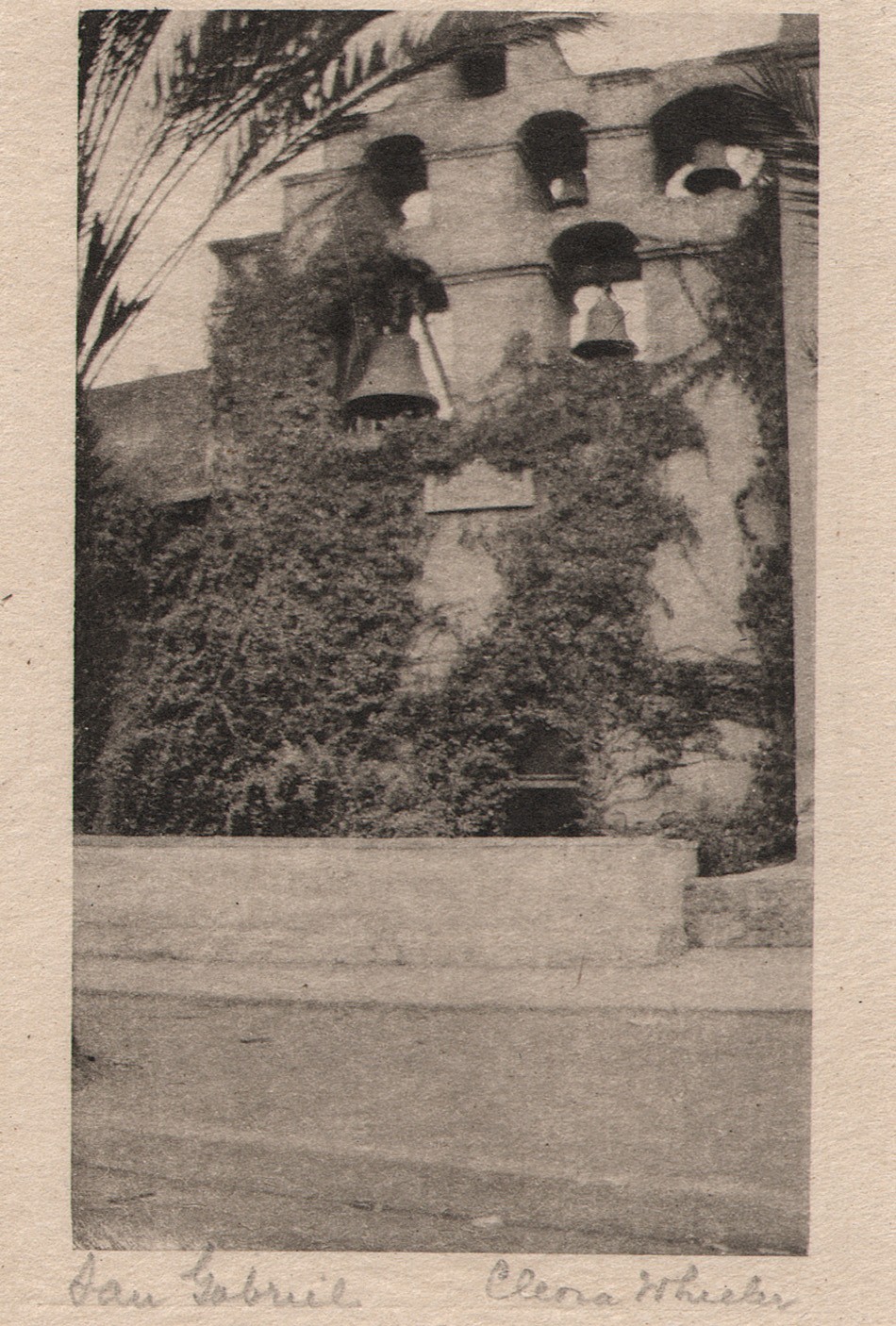 "San Gabriel": Cleora Clark Wheeler, American-1882-1980: ca. 1922: hand-pulled Japan-tissue photogravure: 10.5 x 6.3 | 21.0 x 15.2 Gampi | 24.2 x 38.0 off-white handmade paper (folded) | 33.0 x 25.0 cm olive-colored cardstock leaf. In California, the famous bell wall at the San Gabriel Spanish Mission is seen in this pictorial view by Wheeler. The California Missions Resource Center states: "Six bells occupy an espadaña or bell wall. The oldest bells were cast in Mexico City in 1795 by the famous bell maker, Paul Ruelas. The largest bell (dated 1830) weighs over a ton and was used for over a century to ring the Angelus, a prayer said at morning, noon, and evening in commemoration of the Incarnation." From: PhotoSeed Archive
"San Gabriel": Cleora Clark Wheeler, American-1882-1980: ca. 1922: hand-pulled Japan-tissue photogravure: 10.5 x 6.3 | 21.0 x 15.2 Gampi | 24.2 x 38.0 off-white handmade paper (folded) | 33.0 x 25.0 cm olive-colored cardstock leaf. In California, the famous bell wall at the San Gabriel Spanish Mission is seen in this pictorial view by Wheeler. The California Missions Resource Center states: "Six bells occupy an espadaña or bell wall. The oldest bells were cast in Mexico City in 1795 by the famous bell maker, Paul Ruelas. The largest bell (dated 1830) weighs over a ton and was used for over a century to ring the Angelus, a prayer said at morning, noon, and evening in commemoration of the Incarnation." From: PhotoSeed Archive
1922: The May 20th issue of American Art News prints a notice of Wheeler’s exhibition Atmospheric Studies:
“A collection of more than eighty prints of western scenes by Miss Cleora Wheeler, St. Paul artist, have been on exhibition at the St. Paul Public Library. They show a wide range of color and subject matter, and were done on trips which extended from the eastern reaches of the Rockies through the mountains and as far south as the Mexican border of California. -G.E.P.” (p. 7)
⎯ In June, the artist’s first known public exhibition of hand-colored pictorial photographs as well as a smaller series of original bookplates takes place from June 1-15 at the Saint Paul Public Library under the auspices of the Saint Paul Institute. A slim eight-page exhibition brochure is printed listing the following sub-headings for the 76 exhibited photographs:
Out Where The West Begins : Colorado; California: At Call-Of-The-Wild, California; Pacific Grove; California: The Seventeen-Mile Drive; Santa Barbara; Farther South; La Jolla; Old Town; San Diego; Minnesota: Senator Kellog’s Garden, St. Paul & White Bear Lake. A separate section for 14 original bookplates is also listed, and the entire list with all titles can be found on this website at a link featuring the original framed exhibition print Evening.
Some of the work for the exhibit was for sale, and a price list was printed on the last page of the brochure:
PRICE LIST
The prints in this exhibition are not for sale.
Duplicates can be ordered as follows:
SEPIA PRINTS
Large size, mounted as shown………$10.00
Smaller size, mounted as shown……..7.50
COLORED PRINTS
No. 34 ……………………………….$12.50
No. 40 ……………………………….. 20.00
No. 43 …………………………………10.00
All others …………………………….7.50
These prices include frames.
MINIATURE PRINTS
Made by hand from copper plates.
See sample book at desk.
Prints on Japanese tissue ……$1.00
No. 50, No. 60, No. 63, colored ink, with
envelope …………………………… .50
Folders tinted to order, with envelope $.40 and .50
Same without tinting ………… .15
Card without tinting …………. .10
CHRISTMAS CARDS
See sample books at desk.
Folders with Christmas wording.
Per 100 ………………………………$35.00 to $50.00
These may be ordered for fall delivery.
BOOKPLATE PRICES
Design ………………………………$25.00 up
Metal plate and prints are extra, cost depend-
ing on material. Allow six months for book-
plate orders. Estimates given.
1376 Summit Avenue Midway 0234
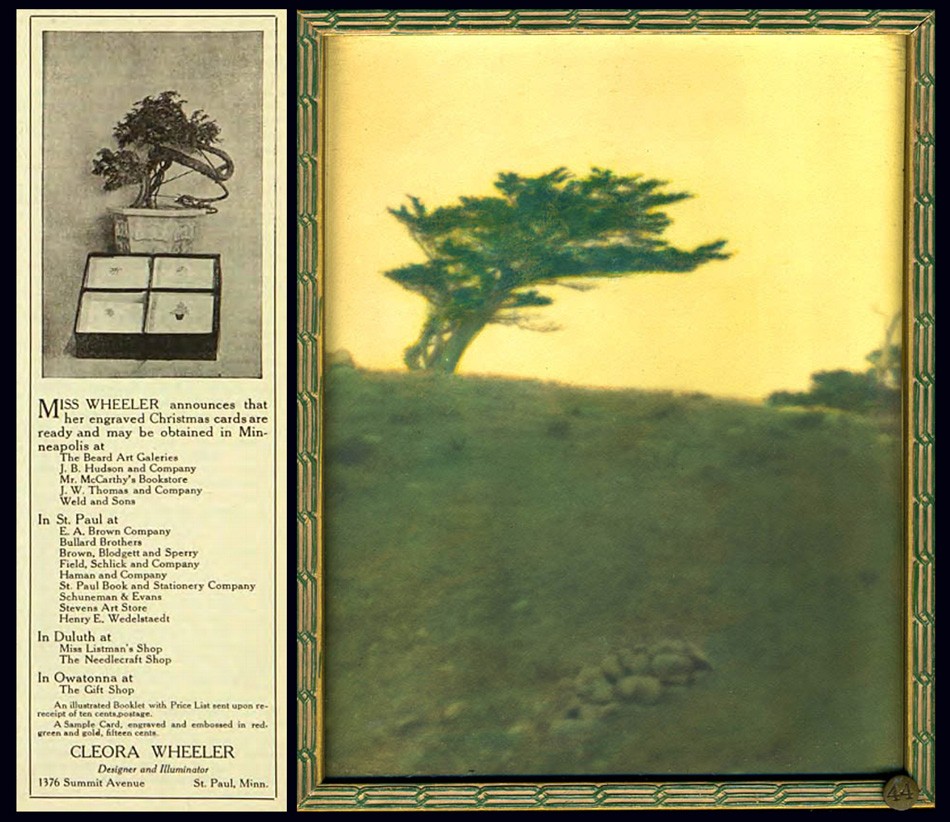 Left: Custom designed Christmas cards were a staple source of income for artist Cleora Wheeler as well as an important fund raiser for her fraternity. She produced them as early as 1915, when an advertisement similar to this one featuring a potted Bonsai tree was photographed alongside a box of cards featuring four different designs ran her Minnesota Alumni Weekly, (this ad from Dec. 1916) until the 1960's, when the cover of the December, 1963 issue of The Pen Woman magazine showcased card designs of Twin City churches. A 1944 article in the St. Cloud Daily Times newspaper of MN remarked: "Miss Wheeler has received nationwide recognition for her Christmas cards, hand-printed photogravures and hand stamped cards bearing her designs" Right: The Japanese inspired sensibility of Wheeler's design aesthetic can be seen carried over in this photographic landscape taken along California's Monterey coastline. In "Mustard Sky", a lone Cypress tree is shown atop an seaside ridge. This original hand-colored framed exhibition photograph was featured in her 1922 St. Paul, MN exhibition Atmospheric Studies, listed as #44 under the subheading "The Seventeen-Mile Drive". Courtesy: Grapefruit Moon Gallery auction listing, Minneapolis MN.
Left: Custom designed Christmas cards were a staple source of income for artist Cleora Wheeler as well as an important fund raiser for her fraternity. She produced them as early as 1915, when an advertisement similar to this one featuring a potted Bonsai tree was photographed alongside a box of cards featuring four different designs ran her Minnesota Alumni Weekly, (this ad from Dec. 1916) until the 1960's, when the cover of the December, 1963 issue of The Pen Woman magazine showcased card designs of Twin City churches. A 1944 article in the St. Cloud Daily Times newspaper of MN remarked: "Miss Wheeler has received nationwide recognition for her Christmas cards, hand-printed photogravures and hand stamped cards bearing her designs" Right: The Japanese inspired sensibility of Wheeler's design aesthetic can be seen carried over in this photographic landscape taken along California's Monterey coastline. In "Mustard Sky", a lone Cypress tree is shown atop an seaside ridge. This original hand-colored framed exhibition photograph was featured in her 1922 St. Paul, MN exhibition Atmospheric Studies, listed as #44 under the subheading "The Seventeen-Mile Drive". Courtesy: Grapefruit Moon Gallery auction listing, Minneapolis MN.
1924: In June, at the national Kappa convention held in Toronto, Canada at the Bigwin Inn, Wheeler makes 19 hand-cut silhouettes from black paper used as part of the Historical Pageant. The works were later reproduced in the October issue of The Key that year. (shown on pp. 250-253) Soon, Wheeler would take on the art of silhouette portraiture by means of photography. Additionally, a pictorial portrait of Kappa president May Whiting Westerman and Georgia Hayden Lloyd Jones, National Director of Provinces, appeared as a full page halftone in the issue and another pictorial photographic landscape: The White Birches of Bigwin, appeared on pages 248 and 255 respectively.
1925: Several California pictorial photographic works are published as halftones in the October issue of The Key with the following titles:
- Call-of-the-Wild, California
- San Juan Capistrano Mission-between Los Angeles and San Diego, California
 Left: Although Cleora Wheeler never held editorial positions for The Key, the quarterly magazine of Kappa Kappa Gamma, it featured notices of her progress as an artist, support of the fraternity's mission nationally via her election to various Kappa positions, including Grand Registrar in 1904 and Custodian of the Badge in 1911, and as a continual mouthpiece for advertisements in its' rear pages featuring original artwork for sale. This issue shows a new cover design which debuted in May, 1915 featuring a new crest (coat-of-arms) designed by recent Xi chapter graduate Ruth Anthony. Right: One large advertisement appearing in the October, 1930 issue of The Key showcased no less than 18 individual Kappa designs by Cleora Wheeler made into steel dies. These were used to emboss custom orders of stationary, all from the third floor studio of her St. Paul, MN home.
Left: Although Cleora Wheeler never held editorial positions for The Key, the quarterly magazine of Kappa Kappa Gamma, it featured notices of her progress as an artist, support of the fraternity's mission nationally via her election to various Kappa positions, including Grand Registrar in 1904 and Custodian of the Badge in 1911, and as a continual mouthpiece for advertisements in its' rear pages featuring original artwork for sale. This issue shows a new cover design which debuted in May, 1915 featuring a new crest (coat-of-arms) designed by recent Xi chapter graduate Ruth Anthony. Right: One large advertisement appearing in the October, 1930 issue of The Key showcased no less than 18 individual Kappa designs by Cleora Wheeler made into steel dies. These were used to emboss custom orders of stationary, all from the third floor studio of her St. Paul, MN home.
⎯ Three further California images appear in the December issue of The Key promoting the national convention that would be held at Mills College outside Oakland, CA the following summer. The frontis photograph for the issue featured a view of a lone cypress tree that had become Wheeler’s signature California image known as “Near Monterey” taken along the Seventeen Mile Drive and was darkened and hand-colored with a star placed in the sky and re-titled “Evening”.
The article published on pages 415-17 of the issue is titled:
An Invitation To California
“The California chapters together with all Kappa alumnae in this western province unite in inviting every Kappa, young and old, to come to convention in California during the first week of August in 1926.” …The convention will be held at Mills College, in the suburbs of Oakland, across the bay from San Francisco.”
The two additional halftones are titled:
- At the Beginning of The Seventeen Mile Drive
- The Cloister Stairway, San Gabriel Mission
 Left: "The Wraith": Cleora Clark Wheeler, American:1882-1980. Sepia gelatin silver print, ca. 1922. Courtesy: Grapefruit Moon Gallery auction listing, Minneapolis MN. Right: 'The Wraith": Hand-pulled Japan-tissue photogravure ca. 1922: 10.1 x 7.8 | 20.7 x 14.9 Gampi | 24.8 x 38.0 off-white handmade paper (folded) | 33.0 x 25.0 cm olive-colored cardstock leaf. Cypress trees, one living and the other dead, stand sentinel among a rock outcropping, with the Pacific Ocean beyond. The landscape was photographed by Wheeler along the famed Seventeen Mile Drive on the Monterey, California coastline. From: PhotoSeed Archive
Left: "The Wraith": Cleora Clark Wheeler, American:1882-1980. Sepia gelatin silver print, ca. 1922. Courtesy: Grapefruit Moon Gallery auction listing, Minneapolis MN. Right: 'The Wraith": Hand-pulled Japan-tissue photogravure ca. 1922: 10.1 x 7.8 | 20.7 x 14.9 Gampi | 24.8 x 38.0 off-white handmade paper (folded) | 33.0 x 25.0 cm olive-colored cardstock leaf. Cypress trees, one living and the other dead, stand sentinel among a rock outcropping, with the Pacific Ocean beyond. The landscape was photographed by Wheeler along the famed Seventeen Mile Drive on the Monterey, California coastline. From: PhotoSeed Archive
1925: Working out of her St. Paul home, Wheeler produced an unknown number of original artworks for the Buzza Company of Minneapolis in this year or before, with lithographed motto art being a specialty. (see example pulled from the web along with this post) Minnesota Historical Society author Moira F. Harris comments on the artist’s working methods:
Her studio was on the third floor of the family home at 1376 Summit Avenue. There she designed and engraved the plates for her cards and bookplates. Some cards she printed herself on a hand press, while others were printed on handmade paper by Brown & Bigelow and sold through the St. Paul Book & Stationery firm. (3.)
The Hennepin History Museum in Minneapolis, MN supplied this short overview of the Buzza Company as part of their 2016 exhibit “Greetings”:
A History of the Buzza Company
During its prime, the Minneapolis-based Buzza Company (1907-1942) was one of the nation’s largest manufacturers of greeting cards, framed mottos, gift books, and party stationery. GREETINGS tells the story of the company’s rise and fall, its larger-than-life founder, and the hundreds of artists, poets, printers, and others who produced, sold, and shipped many millions of items from the company’s Lake Street headquarters each year. (George Earl Buzza: 1883-1957)
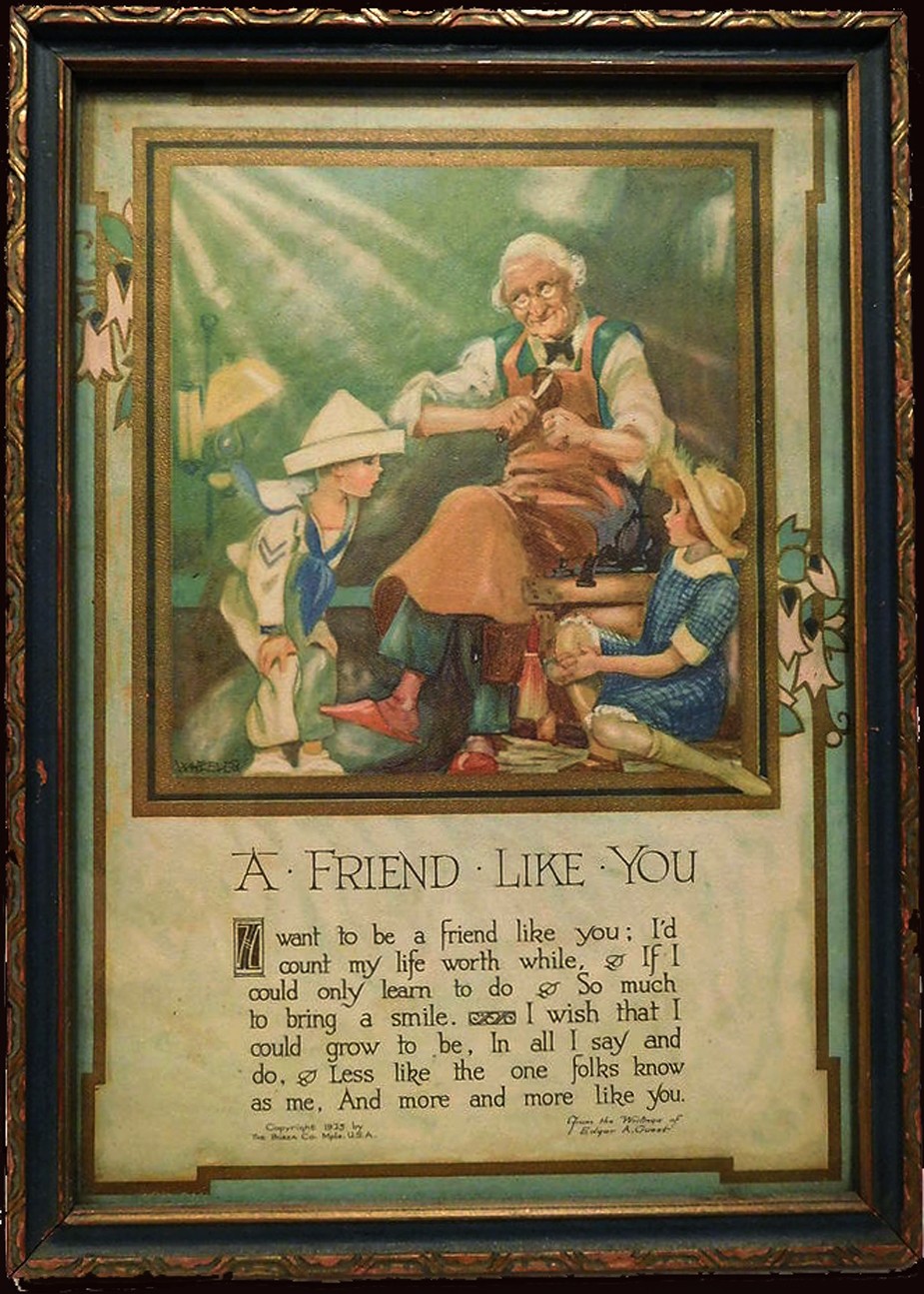 Around 1925 or before, Cleora Wheeler created original artwork like this example for the Minneapolis-based Buzza Company, which between 1907-1942 was one of the nation's largest manufacturers of greeting cards, framed mottos, gift books, and party stationery. This framed motto print made into a chromolithograph posted to Pinterest bears a 1925 Buzza copyright ("WHEELER" printed in lower left corner of artwork) and is titled "A Friend Like You": optimistic lines penned by the English-born American poet Edgar Albert Guest: 1881-1959.
Around 1925 or before, Cleora Wheeler created original artwork like this example for the Minneapolis-based Buzza Company, which between 1907-1942 was one of the nation's largest manufacturers of greeting cards, framed mottos, gift books, and party stationery. This framed motto print made into a chromolithograph posted to Pinterest bears a 1925 Buzza copyright ("WHEELER" printed in lower left corner of artwork) and is titled "A Friend Like You": optimistic lines penned by the English-born American poet Edgar Albert Guest: 1881-1959.
1926: Interestingly, a review of Wheelers 1922 exhibit Atmospheric Studies is published nearly four years later in the February issue of The Key, with insight stating the artist had “tramped the California mountains” “for two successive summers” to produce the views. This may indicate the entire body of California work was taken ca. 1920-21, as it’s known she made a Santa Barbara landscape dated 1921. The issue features a commercial portrait of Wheeler to accompany the article. Four additional halftones of California landscapes are further reproduced in the issue.
California Photographs by Kappa Artist
THE California photographs by Cleora Wheeler which are appearing in these issues of THE KEY are reproductions of a part of an exhibit of seventy or more prints in colors which were recently hung in the art gallery of the beautiful public library of St. Paul, under the auspices of the St. Paul Institute. This constituted the only exhibition during the year which filled this large gallery with the work of one person. The pictures are being reproduced for the first time in THE KEY, and as they are part of a professional record they bear the name of the member who made them. Miss Wheeler thinks of California as her second home, as she spent a year with Pi after graduating at Minnesota. For two successive summers she has tramped the California mountains, and as a result has produced the pictures which you are now enjoying at the request of Mrs. Westermann, and of which Arthur L. Wilhelm, the art critic, wrote the following:
UNUSUAL QUALITIES ARE DISPLAYED IN WORK OF MISS
CLEORA WHEELER; SUBJECT MATTER SELECTED
WITH VIEW OF UNUSUAL
BY ARTHUR L. WILHELM
There is on exhibition at the St. Paul Public library this week a collection of colored California prints by Cleora Wheeler, St. Paul artist and etcher. The St. Paul Institute is sponsoring the exhibit. In the collection of more than eighty prints are many that have unusual qualities. All are atmospheric studies and are colored, many of them with fine Japanese dyes, giving a wide color range and depth. Miss Wheeler has grasped the fine essentials of design in many of her studies. Many simple little prints take on glowing beauty under the touch of her brush. The subject matter is carefully selected with a· view of the unusual. Here, in one print, one sees a fine flowing rhythm. Again one feels the structure of design carried out to a fine point. Again there is quality of the color that charms. Always there is something unusual to attract.
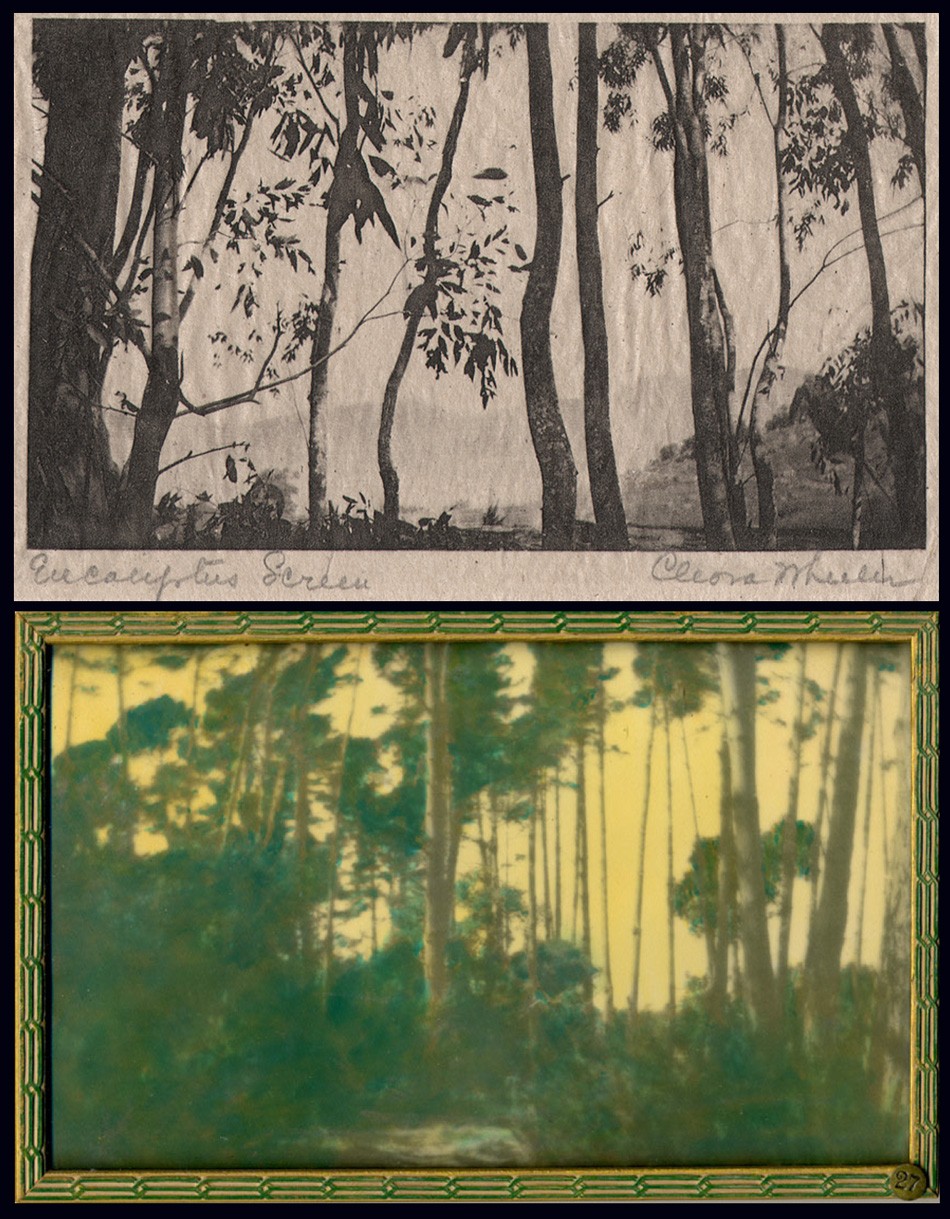 Top: "Eucalyptus Screen": Cleora Clark Wheeler, American: 1882-1980. Hand-pulled Japan-tissue photogravure ca. 1922: 6.3 x 10.5 cm | 14.9 x 20.4 Gampi | 38.0 x 24.5 cm off-white handmade paper (folded) | 33.0 x 25.0 cm olive-colored cardstock leaf. From: PhotoSeed Archive. Bottom: "A Forest Screen": ca. 1922: Cleora Clark Wheeler: hand-colored gelatin silver exhibition print from the artist's 1922 St. Paul exhibition Atmospheric Studies. "Screen-type" photographic landscapes by Wheeler show up frequently in her California work, with the latter print (#27 St. Paul) taken in the Pacific Grove region near Monterey and gravure believed to be from Santa Barbara. Courtesy: Grapefruit Moon Gallery auction listing, Minneapolis MN.
Top: "Eucalyptus Screen": Cleora Clark Wheeler, American: 1882-1980. Hand-pulled Japan-tissue photogravure ca. 1922: 6.3 x 10.5 cm | 14.9 x 20.4 Gampi | 38.0 x 24.5 cm off-white handmade paper (folded) | 33.0 x 25.0 cm olive-colored cardstock leaf. From: PhotoSeed Archive. Bottom: "A Forest Screen": ca. 1922: Cleora Clark Wheeler: hand-colored gelatin silver exhibition print from the artist's 1922 St. Paul exhibition Atmospheric Studies. "Screen-type" photographic landscapes by Wheeler show up frequently in her California work, with the latter print (#27 St. Paul) taken in the Pacific Grove region near Monterey and gravure believed to be from Santa Barbara. Courtesy: Grapefruit Moon Gallery auction listing, Minneapolis MN.
COLORADO-CALIFORNIA
Miss Wheeler has arranged the prints so that one follows her in her journey to the West, where the pictures were taken. First we see eight prints from Colorado, the first rampart range of the Rockies, a field of wild sunflowers with a great up-thrust of rock in the background, and others. Then we have what she terms the “Call of the Wild,” with a score of prints taken at random along the coast and in the big woods of the Sierras. There are many pictures that are romantic in feeling and others that have a rich poetic sentiment. The colors are soft and glowing or in the nocturnes are dimmed by the blue of night. There are ten prints taken at Pacific Grove which· include pictures of the woods and sea, pictures with the fog stealing in, and prints tinged with the sunset glow.
DRIVE PICTURES THE BEST
Perhaps the most charming group of the exhibition is that taken on the famous seventeen-mile drive at Monterey. Here the old cypresses are shown with all their varied forms. Also the rocks and the sea are most charmingly depicted. There are pictures of young eucalyptus groves with a bit of flaming sky showing through the foliage. One print, “The Old Witch,” is a portrait of a famous old tree which is known to the thousands of tourists who have made the trip. There is a group of prints from Santa Barbara and several from points farther South. The exhibition is enhanced by an oil painting, a landscape done by the mother of the artist, which has a fine feeling of harmony and color. The entire exhibition is both unusual and charming. (pp. 27-8)
1926: July. Fifteen silhouettes, this time by means of photography, are taken by Wheeler of Kappa members taking part in the Historical Pageant held as part of the California annual convention at Mills College. In addition, she takes scores of additional silhouettes of those attending the convention itself on banquet day. The silhouette photos of the pageant members are published in the October issue of The Key.
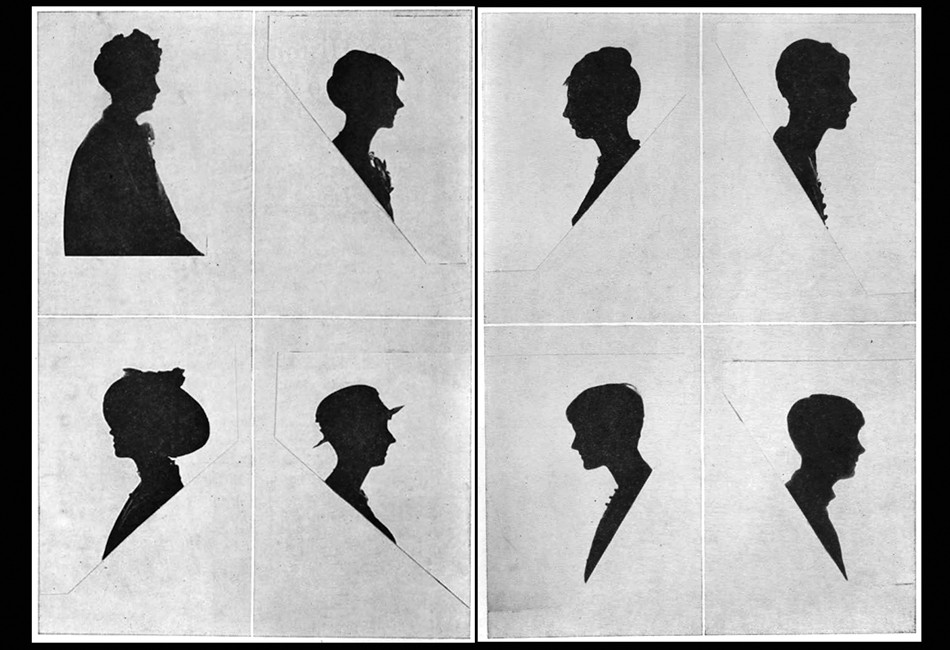 These two sets of photographic silhouette portraits taken by Cleora Wheeler were done in July, 1926 as part of the Historical Pageant held during the annual Kappa Kappa Gamma national convention at Mills College outside Oakland, California. The studies here reproduced as halftones were published in the October issue of The Key. "So far as I was able to find out, this was the first time the Oakland, Berkeley or San Francisco photographers had seen the experiment of silhouettes by this method, and they were interested" said Wheeler, in the article titled "Say It With Flowers … . Do It With Dishpans" published in the December, 1926 issue of The Key. Kappa chapter members were credited in the publication but in an unknown order. The first four are at left followed by 5-8 at right: 1. Loretta Shea of Lambda as "Alpha, 1870." 2. Mabel Paul, as "Beta Nu, 1888." 3. Beatrice Peters, as "Beta Omega, 1913." 4. Dorothy Fulton, as "Gamma Alpha, 1916." 5. Dorothy Lewis, as "Beta Rho, 1885, 1914." 6. Thelma Scheider, as "Beta Tau, 1883." 7. Martha Bordwell, as "Gamma Rho, 1888." 8. Abigail Semans, as "Rho, 1880, 1925."
These two sets of photographic silhouette portraits taken by Cleora Wheeler were done in July, 1926 as part of the Historical Pageant held during the annual Kappa Kappa Gamma national convention at Mills College outside Oakland, California. The studies here reproduced as halftones were published in the October issue of The Key. "So far as I was able to find out, this was the first time the Oakland, Berkeley or San Francisco photographers had seen the experiment of silhouettes by this method, and they were interested" said Wheeler, in the article titled "Say It With Flowers … . Do It With Dishpans" published in the December, 1926 issue of The Key. Kappa chapter members were credited in the publication but in an unknown order. The first four are at left followed by 5-8 at right: 1. Loretta Shea of Lambda as "Alpha, 1870." 2. Mabel Paul, as "Beta Nu, 1888." 3. Beatrice Peters, as "Beta Omega, 1913." 4. Dorothy Fulton, as "Gamma Alpha, 1916." 5. Dorothy Lewis, as "Beta Rho, 1885, 1914." 6. Thelma Scheider, as "Beta Tau, 1883." 7. Martha Bordwell, as "Gamma Rho, 1888." 8. Abigail Semans, as "Rho, 1880, 1925."
⎯ November. Calling Wheeler “a painter turned photographer”, partly referencing her motto work for the Buzza Company, an exhibition of her photographs-likely re-purposed from the 1922 Atmospheric Studies exhibition, are shown at Paul Elder & Company, a San Francisco bookseller & publisher. (1898-1968) The following notice for the show appeared in Bret Harte’s Overland Monthly and Out West Magazine that month:
A painter turned photographer will occupy the attention of the visitors at the Paul Elder Gallery October 25 to November 6. Miss Cleora Clark Wheeler, of St. Paul, Minnesota, gained a reputation as a painter before she took up photography as her medium. As a result, her prints have a feeling of conscious design and a quality of painting. Those exhibited at Paul Elder’s will be some of her atmospheric studies of California scenes and a group of miniature prints from copper plates.
⎯ December. In The Key, the artist describes how she made the silhouettes that year:
Say It With Flowers … . Do It With Dishpans
CLEORA WHEELER
So Many persons have been interested to know how the silhouettes which I made in California last summer were done, that 1 am very glad to tell. It was with two huge electric lights of a thousand watts each, set into two deep dishpans. After the dishpans had been located at a hardware store, and the sockets soldered into place, they were nailed to the top of two of Mother’s two-by-four tomato supports which I took to convention in my trunk. They in turn were nailed at base of two wooden boxes which the janitor at Olney Hall found for me, and before the lights were put into the sockets Mr. Gibson the head electrician at Mills College made some special fuses of thirty amperes each, one of which was installed in the switchboard where the electric wiring from the room ended. Without these special fuses not only all the lights at that end of Olney Hall, but the big lamps themselves would have gone out as soon as lighted. He even provided some fuses of forty amperes each, to be kept on hand for emergency, in case the big lamps should suddenly stop.
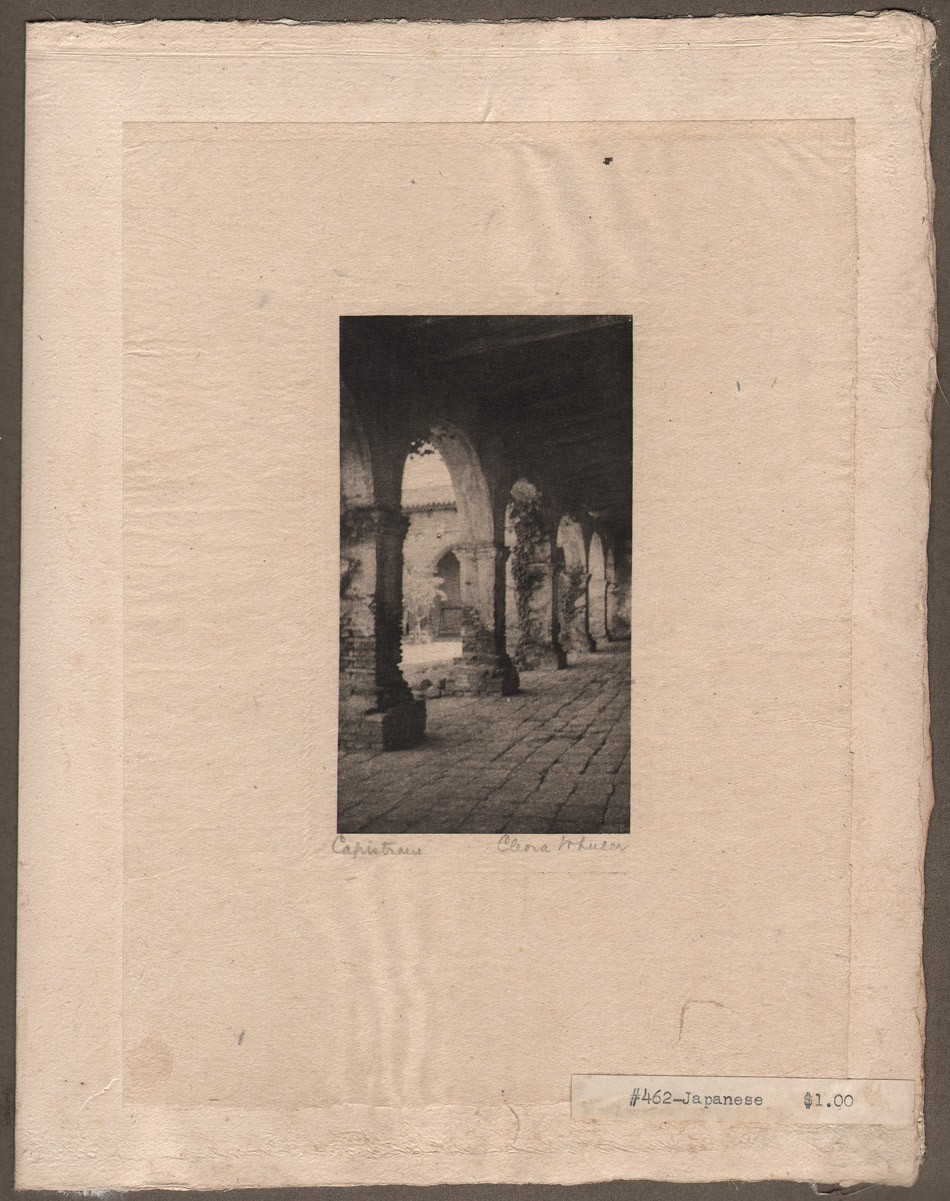 Arts & fine craftsmanship were integral to Cleora Wheeler's working methods, as evidenced by this representative leaf included in a California sample book she made featuring 23 hand-pulled, Japan-tissue photogravures individually mounted on hand-made paper contained within the ca. 1922 folio posted to PhotoSeed. This photograph is titled "Capistrano". Image and overall dimensions: 10.8 x 6.1 | 20.5 x 15.2 Gampi | 24.9 x 38.0 off-white handmade paper (folded) | 33.0 x 25.0 cm olive-colored cardstock leaf. The architectural study of archways was taken along the southern cloisters at the Capistrano Mission. From the missions online resource: "Mission San Juan Capistrano, became the seventh of twenty-one missions to be founded in Alta California. Like the previous six missions, San Juan Capistrano was established to expand the territorial boundaries of Spain, and to spread Christianity to the Native peoples of California." From: PhotoSeed Archive
Arts & fine craftsmanship were integral to Cleora Wheeler's working methods, as evidenced by this representative leaf included in a California sample book she made featuring 23 hand-pulled, Japan-tissue photogravures individually mounted on hand-made paper contained within the ca. 1922 folio posted to PhotoSeed. This photograph is titled "Capistrano". Image and overall dimensions: 10.8 x 6.1 | 20.5 x 15.2 Gampi | 24.9 x 38.0 off-white handmade paper (folded) | 33.0 x 25.0 cm olive-colored cardstock leaf. The architectural study of archways was taken along the southern cloisters at the Capistrano Mission. From the missions online resource: "Mission San Juan Capistrano, became the seventh of twenty-one missions to be founded in Alta California. Like the previous six missions, San Juan Capistrano was established to expand the territorial boundaries of Spain, and to spread Christianity to the Native peoples of California." From: PhotoSeed Archive
A huge sheet was stretched across one end of the room, the two lights were focused on its center, from the front, and the person who was to have her silhouette, sat in the shadow between the lamps and the camera. The stool she sat upon was set upon a certain square, chalked upon the floor. The camera tripod stood on a triangle also chalked upon the floor as they had to be an exact number of inches apart. The camera was equipped with a special portrait lens which can be bought at any camera store for a dollar or two and added to the front of a camera lens. Regulation roll film was used which was very quick to operate. As a result the silhouettes were taken at the rate of two seconds each.
In order that there might be no reflection from walls, on the side of the person next the camera, black cloth was hung on one wall and an Oxford gown was hung over the looking glass on the other. Black oilcloth was fastened over the glass of the door leading into the hall, and over the transom above, so that no light from the hall lamps might enter. The girls lined up outside the door evenings, registered by number and the films were marked with the same numbers. · In that way each received her own negative and print in the end.
The developing solution was a special one, a formula which I brought with me. The photographer who prepared it for me on the coast had none of one of the ingredients. When it was located and added, it ate up the first roll of films, then when used one-tenth the strength, it blistered the second roll. After eight hours of experimenting in the darkroom I emerged with the mystery solved, and from that time on the negatives went through like magic. So far as I was able to find out, this was the first time the Oakland, Berkeley or San Francisco photographers had seen the experiment of silhouettes by this method, and they were interested. But they didn’t know what in the world to do when that first film was eaten up.
The silhouettes of Ruth Rochford (Mrs. George W. Schmitz of Berkeley) and her children were made by a reverse method, using the light back of the sheet, and directly back of the figure, the figure being the only thing to prevent its shining into the lens of the camera. The sheet was a piece of architect’s tracing paper, this time, wide enough and long enough to fasten over the entire area of an open doorway. Tracing paper (not tracing cloth) gives a more satisfactory light than a sheet. It is almost transparent and the light is suffused around the figure. Only one light could be used by this method, and as the amount was therefore cut in two, the length of exposure was necessarily to be doubled. It is impossible to expect a little child of two and a half years, as the youngest was here, to sit still more than one second, surely not four seconds. So a graflex camera was used as it has a very fast lens. The exposures were one second.
Frances Murphy of the Oklahoma chapter, whose silhouette appears at the top of the page, was the first delegate to brave the array of dishpans. Dozens followed her, and anyone who saw the interested crowd getting their pictures on banquet night just before we all parted, will be sure it proved there is a way to have one’s picture taken without having one’s head turned.
 Left: This commercial portrait of Cleora Wheeler dates to the mid 1920's. A cropped variant accompanied a review published on her California photographs in the February, 1926 issue of The Key written years earlier by Arthur L. Wilhelm on her 1922 St. Paul exhibition Atmospheric Studies. An excerpt: "There are many pictures that are romantic in feeling and others that have a rich poetic sentiment. The colors are soft and glowing or in the nocturnes are dimmed by the blue of night." Photographic halftone courtesy: Helen Brainerd Lay Bookplate Collection, Mount Holyoke College Archives and Special Collections: Identifier: ms0048-s02-b02-f15-i010. Middle: Variations of this single advertisement for products bearing designs by Wheeler: letter stationary, place cards and matching envelopes among other things, illustrated with a small photographic halftone of the artist working at an embossing machine inside her St. Paul home studio, continued to appear with regularity in the back pages of the Kappa quarterly, The Key. Right: At 95 years of age, Cleora Wheeler was still very active in her Kappa Kappa Gamma fraternity. Here she is seen looking at a Ritual volume during an annual convention display. The original caption in the Fall, 1977 issue of The Key pointing out "that the cover had been hand-made by her!".
Left: This commercial portrait of Cleora Wheeler dates to the mid 1920's. A cropped variant accompanied a review published on her California photographs in the February, 1926 issue of The Key written years earlier by Arthur L. Wilhelm on her 1922 St. Paul exhibition Atmospheric Studies. An excerpt: "There are many pictures that are romantic in feeling and others that have a rich poetic sentiment. The colors are soft and glowing or in the nocturnes are dimmed by the blue of night." Photographic halftone courtesy: Helen Brainerd Lay Bookplate Collection, Mount Holyoke College Archives and Special Collections: Identifier: ms0048-s02-b02-f15-i010. Middle: Variations of this single advertisement for products bearing designs by Wheeler: letter stationary, place cards and matching envelopes among other things, illustrated with a small photographic halftone of the artist working at an embossing machine inside her St. Paul home studio, continued to appear with regularity in the back pages of the Kappa quarterly, The Key. Right: At 95 years of age, Cleora Wheeler was still very active in her Kappa Kappa Gamma fraternity. Here she is seen looking at a Ritual volume during an annual convention display. The original caption in the Fall, 1977 issue of The Key pointing out "that the cover had been hand-made by her!".
1932: A historian at heart, Wheeler writes the chapter on Kappa insignia and compiles extensive illustrations included in the weighty volume: The History of Kappa Kappa Gamma Fraternity, 1870-1930 published this year.
1930-1940’s: Advertisements for products bearing designs by Wheeler: book plates, stationary, etc, continue to appear with regularity in the back pages of the Kappa quarterly, The Key.
1952: The artist receives Kappa’s Alumnae Achievement Award, with the following notice appearring in the October issue of The Key:
Cleora Clark Wheeler, former grand registrar and custodian of the badge for the Fraternity, also prepared the text and illustrations on insignia which appears in the History of Kappa Kappa Gamma. Miss Wheeler is listed in Who’s Who in America and also in Who’s Who in American Art. She has recently served as national chairman of design for the National League of American Pen Women and holds certificates of proficiency in engineering drafting and advanced engineering drafting from the University of Minnesota. As a designer and illuminator of books and other publications, Miss Wheeler has gained national recognition. Her bookplate designs are represented in many collections. Of her work Miss Wheeler says: “The public seems to be especially interested in the fact that I learned’ the trade of steel-die stamping. It is a highly specialized field in the factories of wholesale stationery companies. It usually takes a girl nine years, stamping 1000 impressions a day by hand, to become an expert.” (p. 244)
1967: The following article published in the Mid-Winter issue of The Key gives a good overview of Cleora Wheeler’s accomplishments later in life:
CLEORA WHEELER, X-Minnesota, is one of America’s most distinguished artists in the rare field of illumination and etching. Forty three of her exquisitely fine drawings prepared as steel engravings, copper intaglio plates, and etchings on zinc and copper are on file in the Library of Congress, and in 28 university, historical and city libraries. She is listed in Who’s Who of American Women, Who’s Who in America, Who’s Who in American Art, and Who’s Who in the MidWest.
She has long made book plates, plaques, dedicatory scrolls, and coats-of-arms for New York firms, on special order for customers so discriminating they realize the surpassing quality of her workmanship. She is an honored member of the National League of American Pen Women, serving as national chairman of design (1944-46), of Heraldic Art (1954-56), and of Inscriptions, Illumination and Heraldic Art (1964-66). The work of the print maker is a dedicated one, and Miss Wheeler has experimented with the quiet and esoteric medium (as did Durer and Rembrandt) until her form of expression is close to perfection. In 1960 she went to Santa Barbara to extract the secrets of an early artist named Monsen, who washed glass slides with purple color, using other colors on top, to bring out rich values of greens in mountain landscapes. Miss Wheeler does many fraternity designs, seals, book covers, and Christmas cards. Her work requires space, and the entire third floor of her home is her shop, with the basement used for storing supplies.
1950-1977: A single advertisement for products bearing designs by Wheeler: letter stationary, place cards and matching envelopes among other things, illustrated with a small photographic halftone of the artist working at an embossing machine inside her St. Paul home studio, continue to appear with regularity in the back pages of the Kappa quarterly, The Key.
1980: Wheeler dies. Her obituary appears in the Spring issue of The Key:
Cleora Wheeler Dies
Kappa records with sorrow the death of Cleora Clark Wheeler, Minnesota, at age 97. She died of pneumonia February 24, 1980. Her BA in engineering and engraving was from Minnesota and she studied color harmony at New York School of Fine and Applied Art now Parsons School of Art) and is listed in Who’s Who of American Women. She began her career as a designer of Christmas cards and illuminator of books and publications. Her bookplates are on file in Paris, the Library of Congress and in 30 other libraries. They were exhibited at the Smithsonian Institution from 1946-1964 and at the International Ex Libris Association of Congress, Elsinore, Denmark, in 1972. Miss Wheeler received numerous awards for her work and served as president, chairwoman and judge of several national art associations. She was a member of the National Society of Magna Charta Dames, a past president of the Minnesota branch of the National League of American Pen Women, a member of the International Bookplate Association, held various offices in the Daughters of the American Revolution and was a life member of the American Association of University Women. Born July 8, 1882, Cleora Wheeler was initiated October 9, 1899 and served Kappa her entire life. She was an active delegate to the 1902 convention and an alumnae delegate to the 1908 convention. She was Grand Registrar of the Fraternity 1904-1906 and Custodian of the Badge 1911-1918. She received Kappa’s Achievement Award in 1952 and was the recipient of her 75 year pin.
Addendum: Wheeler family History
Described as “one of the best preserved upper-class Victorian promenade boulevards in America”, the homes along Summit Avenue in St. Paul, Minnesota- including one owned by Cleora Clark Wheeler at 1376 Summit Ave. where she maintained her studio for decades, were individually described for their architectural significance as part of the 2003 online posting: Thursday Night Hikes: Western Summit Avenue Hike Architecture Notes, Part 2.
Significant biographical background for Clark, her mother, father and extended family are included with the summary. It was compiled from public sources as well as from the University of Minnesota, Northwest Architectural Archives by historian Lawrence A. Martin. The following is his summary. I have only confirmed and filled in several birth and death dates for Cleora’s mother and father that were missing and added a few paragraph breaks for purposes of style:
1376 Summit Avenue: Rush B. Wheeler House; Built in 1909 (Ramsey County property tax records and Sandeen; 1909-1910 according to Larson;) Early Modern Rectilinear in style; Clarence H. Johnston, Sr., architect.
The structure is a two story, 2496 square foot, eight room, five bedroom, two bathroom, one half-bathroom, stucco house, with a detached garage. The house was constructed at a cost of $5,500 (Sandeen; $6,000 according to Larson.) In 1916, Rush B. Wheeler was a member of the Minnesota Historical Society and resided at this address. The 1918 and 1924 city directories indicate that Mr. and Mrs. R. B. Wheeler and their daughter resided at this address. The 1930 city directory indicates that Mrs. Harriet S. Wheeler, the widow of Rush B. Wheeler, resided at this address. In 1934, Harriet Clark Wheeler, the widow of Rush Wheeler, and Cleora Clark Wheeler resided at this address.
Rush B. Wheeler (1844-1930,) the son of Orange H. Wheeler and Eve Tucker Wheeler, was born in South Butler, Wayne County, New York, graduated from the Cazenovia Seminary in New York in 1867, was a graduate of Yale University in 1871, moved to Minnesota in 1873, resided in Austin, Minnesota, from 1873 until 1888, read the law in 1876, was a member of the board of directors of the First National Bank of Austin, Minnesota, from 1880 until 1883, moved to St. Paul in 1883, practiced law, was engaged in real estate and loans, was a member of the St. Paul Chamber of Commerce from 1885 until 1900, was president of the Real Estate Exchange of St. Paul from 1894 until 1896, resided at 520 Summit Avenue in 1907, and officed at the Pioneer Press Building in 1907.
Rush Wheeler married Harriet S. L. Clark in 1876. Harriet Clark Wheeler was a graduate of the University of Minnesota. Harriet Clark Wheeler and Cleora Clark Wheeler were members of the American Association of University Women and the Women’s City Club of St. Paul.
Cleora Clark Wheeler (1882-1980) was born in Austin, Minnesota, graduated with honors from St. Paul Central High School and from the University of Minnesota, received art training at the New York School of Fine and Applied Art/Parsons School of Art, opened a studio at this address, was a renowned artist, a designer, and an illuminator of books and other publications who received certificates of proficiency in advanced engineering drafting from the University of Minnesota, was a well-known bookplate and Christmas card designer, was also an architectural photographer and poet, was a wedding invitation designer, and was an expert in steel-die stamping with widespread recognition.
Cleora Clark Wheeler received an Alumnae Achievement Award from the Kappa Kappa Gamma Fraternity in 1952, after she served as the Fraternity’s Grand Registrar from 1904 to 1906 and as its representative to National Panhellenic Conference from 1905 to 1906, after she prepared a Song Leaflet and Manual of Information for distribution at the 1914 Estes Park Convention, after she attended the Fourth Inter-Sorority Conference in Chicago, where she was instrumental in bringing about the decision that the fraternities had the power of vote on recommendations only, not the power to legislate and hold their entire membership to rules passed by single representatives, after she served for seven years as the Fraternity’s Custodian of the Badge, after she prepared the text and illustrations on insignia which appeared in the 1930 History of Kappa Kappa Gamma, and after she created an official bookplate of the Fraternity.
Cleora Clark Wheeler was a member of the National Society Magna Charta Dames and Barons, whose membership is based upon the existence of a direct lineal descent from one or more of the twenty-five Sureties for the Magna Charta or from a Baron, Prelate, Knight, or other influential person present on the field of Runnemede, England, in June, 1215, was a judge for national achievement awards and was National Chairman of Heraldic Art of the National League of American Pen Women, and was state curator of the Nathan Hale chapter of the Minnesota Daughters of the American Revolution.
Cleora Wheeler also was a substitute teacher in the St. Paul Public Schools. Cleora Wheeler had an exhibition of her bookplate work, entitled “Atmospheric studies,” at the St. Paul Public Library in 1922, under the auspices of the Saint Paul Institute. Cleora Clark Wheeler was a niece of Charles A. Clark (1865-1929,) who was a Spanish-American War veteran and was a resident of the Far East. Clark airfield in Honolulu, Hawaii, was named for Clark’s son, Harold Melville Clark (1890-1919,) who died in a airplane crash. Rush B. Wheeler (1844 -1930) and Harriet S. Wheeler (1853-1938) both died in Ramsey County. Cleora Clark Wheeler (1882-1980) was born in Minnesota, had a mother with a maiden name of Clark, and died in Ramsey County. (current owner information as of 2003 was also included but has been left out here) (4.)
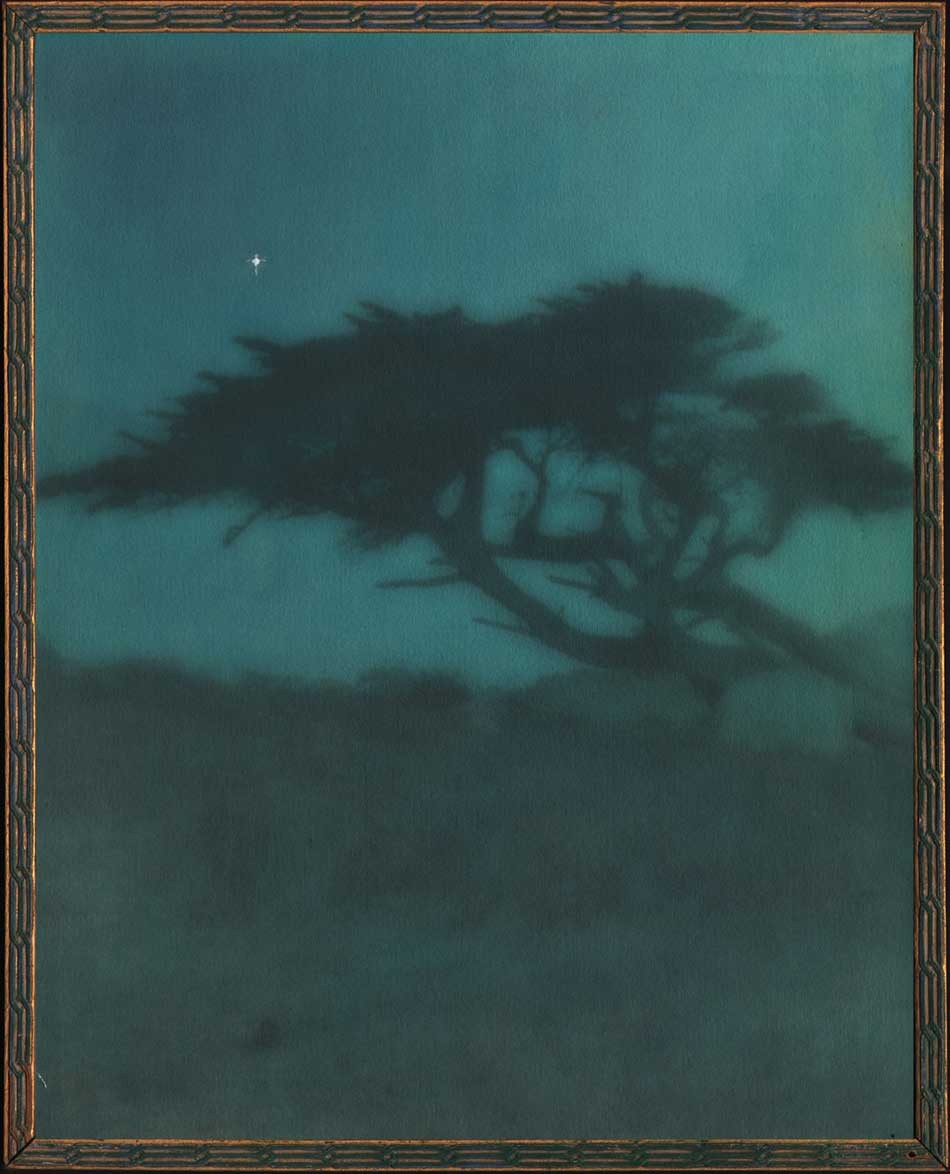 "Evening": Cleora Clark Wheeler, American: 1882-1980. Hand-colored gelatin silver print ca. 1922: image: 23.6 x 19.8 cm; frame: 24.7 x 19.8 cm: Believed to have been taken around 1920, the medium of fine Japanese dyes in hues of blue, green and yellow were used to color this double-weight, rough surface print, the view originally taken in daylight but manipulated as a much darker print in the artist's darkroom with the addition of a lone “twinkling” star added to the "night" sky. The variant daylight version is titled "Near Monterey", and a photogravure version pulled on Japanese tissue can be seen on this website. "Evening" was catalogued as #43, appearing under the sub-heading The Seventeen-Mile Drive as part of the artist's 1922 exhibit Atmospheric Studies: An Exhibition of the Work of Cleora Clark Wheeler, June 1-15, 1922. From: PhotoSeed Archive
"Evening": Cleora Clark Wheeler, American: 1882-1980. Hand-colored gelatin silver print ca. 1922: image: 23.6 x 19.8 cm; frame: 24.7 x 19.8 cm: Believed to have been taken around 1920, the medium of fine Japanese dyes in hues of blue, green and yellow were used to color this double-weight, rough surface print, the view originally taken in daylight but manipulated as a much darker print in the artist's darkroom with the addition of a lone “twinkling” star added to the "night" sky. The variant daylight version is titled "Near Monterey", and a photogravure version pulled on Japanese tissue can be seen on this website. "Evening" was catalogued as #43, appearing under the sub-heading The Seventeen-Mile Drive as part of the artist's 1922 exhibit Atmospheric Studies: An Exhibition of the Work of Cleora Clark Wheeler, June 1-15, 1922. From: PhotoSeed Archive
Notes:
1. “All About the Fraternity Coat-of-Arms”, Excerpt from January 2006 Historically Speaking, by Kay Smith Larson, Washington, History Chairman 2002-2006, excerpted in This is Kappa blog: accessed January, 2018.
2. The Journal of the Association of Collegiate Alumnae: Ithaca, NY: June, 1918: pp. 704-05
3. Citation #19: St. Paul Pioneer Press, Jan. 2, 1967, p. 13; Crump, Minnesota Prints, 173. Moira F. Harris: Season’s Greetings from Minnesota: Minnesota Historical Society magazine Winter 2011-12
4. Excerpt: Thursday Night Hikes: Western Summit Avenue Hike Architecture Notes, Part 2: Observations on Architectural Styles: Western Summit Avenue Hike Assembled by Lawrence A. Martin. Webpage Creation: October 20, 2003.
A Reevaluation: Clarence H. White
Posted October 2017 in Exhibitions, History of Photography, Painters|Photographers, Publishing, Significant Photographers
 "Clarence H. White Autograph": Black ink, 1916. By his own hand, White autographed a manilla card-stock mount (36.2 x 28.6 cm) featuring a portrait photograph of himself taken by student Ruth Anthony Davis during the Seventh Summer Session of the School of Photography at Stevens Farm in East Canaan, CT that year. Please see portrait below. From: PhotoSeed Archive
"Clarence H. White Autograph": Black ink, 1916. By his own hand, White autographed a manilla card-stock mount (36.2 x 28.6 cm) featuring a portrait photograph of himself taken by student Ruth Anthony Davis during the Seventh Summer Session of the School of Photography at Stevens Farm in East Canaan, CT that year. Please see portrait below. From: PhotoSeed Archive
When I remarried a dozen years ago, an obscure bit of farce entered the equation leading up to the “I do” moment. The fateful convolution? My beloved hailed from Newark, OH: the same Midwestern US city where pioneering art photographer Clarence Hudson White (1871-1925) had spent his formative years before leaving permanently along with his family to New York City in 1906.
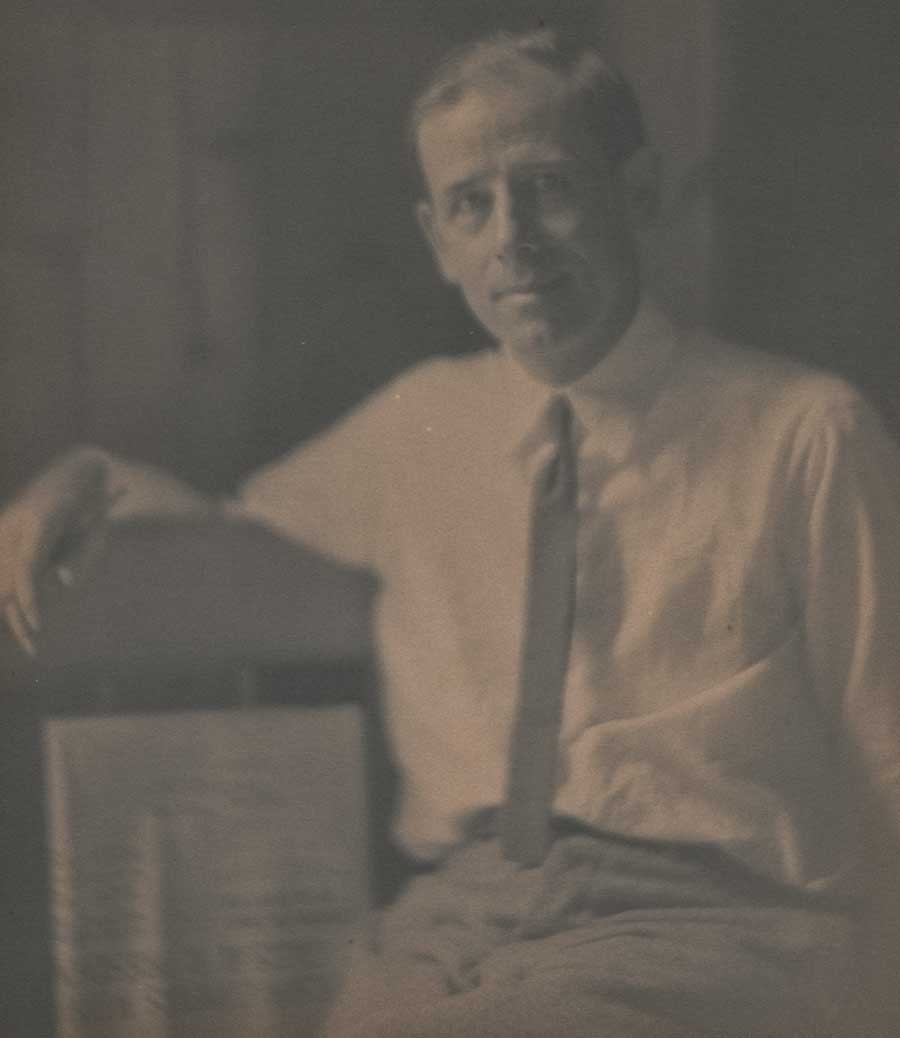 Detail: "Portrait of Clarence H. White": Ruth Anthony Davis, American (1880-1979): 1916: vintage platinum print: 24.2 x 19.3 cm | 29.0 x 21.5 cm Japan paper | 36.2 x 28.6 cm manilla card-stock: Davis, an early member of the Providence Camera Club, photographed her instructor Clarence Hudson White while she attended the Seventh Summer Session of the School of Photography at Stevens Farm in East Canaan, CT. A description of the school's location with emphasis on potential photographic subjects for students appeared in the March, 1916 issue of the International Studio: "The seventh summer session of the Clarence H. White School of Photography will be held at East Canaan, Connecticut, instead of Sequinland, Maine, as heretofore, during July and August. East Canaan is situated in a beautiful valley in the Berkshire Hills of Northern Connecticut, at an elevation of eight hundred feet above the sea level, and is surrounded by hills rising another eight hundred feet above the floor of the valley. The country furnishes abundance of photographic material, comprising, within easy walking distance, farms, rolling uplands, streams, rugged mountains and architecture of typically New England character, many of the buildings dating from Colonial times. Numerous industries, such as iron furnaces, lime kilns, and the like, afford abundant opportunity for pictorial work. The neighbourhood is by no means thickly settled, and those persons who enjoy the seclusion of country life will find it here. Not least among the attractions of this portion of Connecticut are the delightful climate and the practical freedom from mosquitoes." From: PhotoSeed Archive
Detail: "Portrait of Clarence H. White": Ruth Anthony Davis, American (1880-1979): 1916: vintage platinum print: 24.2 x 19.3 cm | 29.0 x 21.5 cm Japan paper | 36.2 x 28.6 cm manilla card-stock: Davis, an early member of the Providence Camera Club, photographed her instructor Clarence Hudson White while she attended the Seventh Summer Session of the School of Photography at Stevens Farm in East Canaan, CT. A description of the school's location with emphasis on potential photographic subjects for students appeared in the March, 1916 issue of the International Studio: "The seventh summer session of the Clarence H. White School of Photography will be held at East Canaan, Connecticut, instead of Sequinland, Maine, as heretofore, during July and August. East Canaan is situated in a beautiful valley in the Berkshire Hills of Northern Connecticut, at an elevation of eight hundred feet above the sea level, and is surrounded by hills rising another eight hundred feet above the floor of the valley. The country furnishes abundance of photographic material, comprising, within easy walking distance, farms, rolling uplands, streams, rugged mountains and architecture of typically New England character, many of the buildings dating from Colonial times. Numerous industries, such as iron furnaces, lime kilns, and the like, afford abundant opportunity for pictorial work. The neighbourhood is by no means thickly settled, and those persons who enjoy the seclusion of country life will find it here. Not least among the attractions of this portion of Connecticut are the delightful climate and the practical freedom from mosquitoes." From: PhotoSeed Archive
But this aside is merely an excuse for the real purpose of this post: today is the official public opening of an exciting and ground breaking new exhibit on Clarence White at the Princeton University Art Museum in Princeton, New Jersey. Clarence H. White and His World: The Art and Craft of Photography, 1895-1925 will be on display there from October 7, 2017 to January 7, 2018. But don’t despair if you can’t make it right away, because the show travels to an additional three US museums through early 2019. Venue details along with additional links including one for the first comprehensive monograph on White published in conjunction with the show and authored by Anne McCauley, David Hunter McAlpin Professor of the History of Photography and Modern Art at Princeton University, concludes this post.
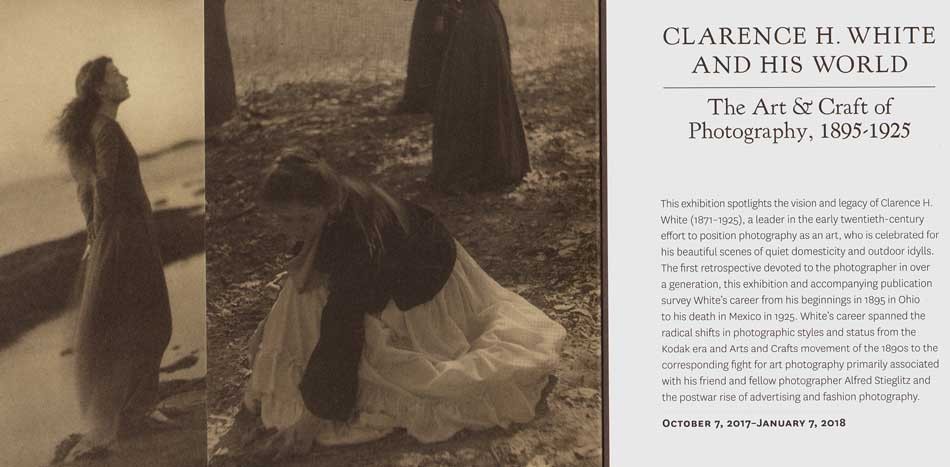 Detail: "Clarence H. White and His World: The Art and Craft of Photography, 1895-1925": composite gatefold brochure for exhibit at Princeton University Art Museum which runs from October 7, 2017-January 7, 2018. Photographic illustrations by White left and middle: The Sea (Rose Pastor Stokes, Caritas Island, Connecticut) (detail), 1909, printed after 1917. Palladium print. Princeton University Art Museum, Clarence H. White Collection; middle: In the Orchard, Newark, Ohio (detail), 1902, printed after 1917. Palladium print. The Museum of Modern Art. Gift of Jane Felix White, 1941. Courtesy: Princeton University Art Museum
Detail: "Clarence H. White and His World: The Art and Craft of Photography, 1895-1925": composite gatefold brochure for exhibit at Princeton University Art Museum which runs from October 7, 2017-January 7, 2018. Photographic illustrations by White left and middle: The Sea (Rose Pastor Stokes, Caritas Island, Connecticut) (detail), 1909, printed after 1917. Palladium print. Princeton University Art Museum, Clarence H. White Collection; middle: In the Orchard, Newark, Ohio (detail), 1902, printed after 1917. Palladium print. The Museum of Modern Art. Gift of Jane Felix White, 1941. Courtesy: Princeton University Art Museum
Several years before, I had taken a deep-dive into the remarkable life of White, whose arc resonated with me on many levels, especially his love for breaking the rules as applied to photographic lighting. To wit: what do you mean I can’t photograph my subject backlit? A simple optical concept today perhaps but in the late 1890’s? Revolutionary. I kid you not.
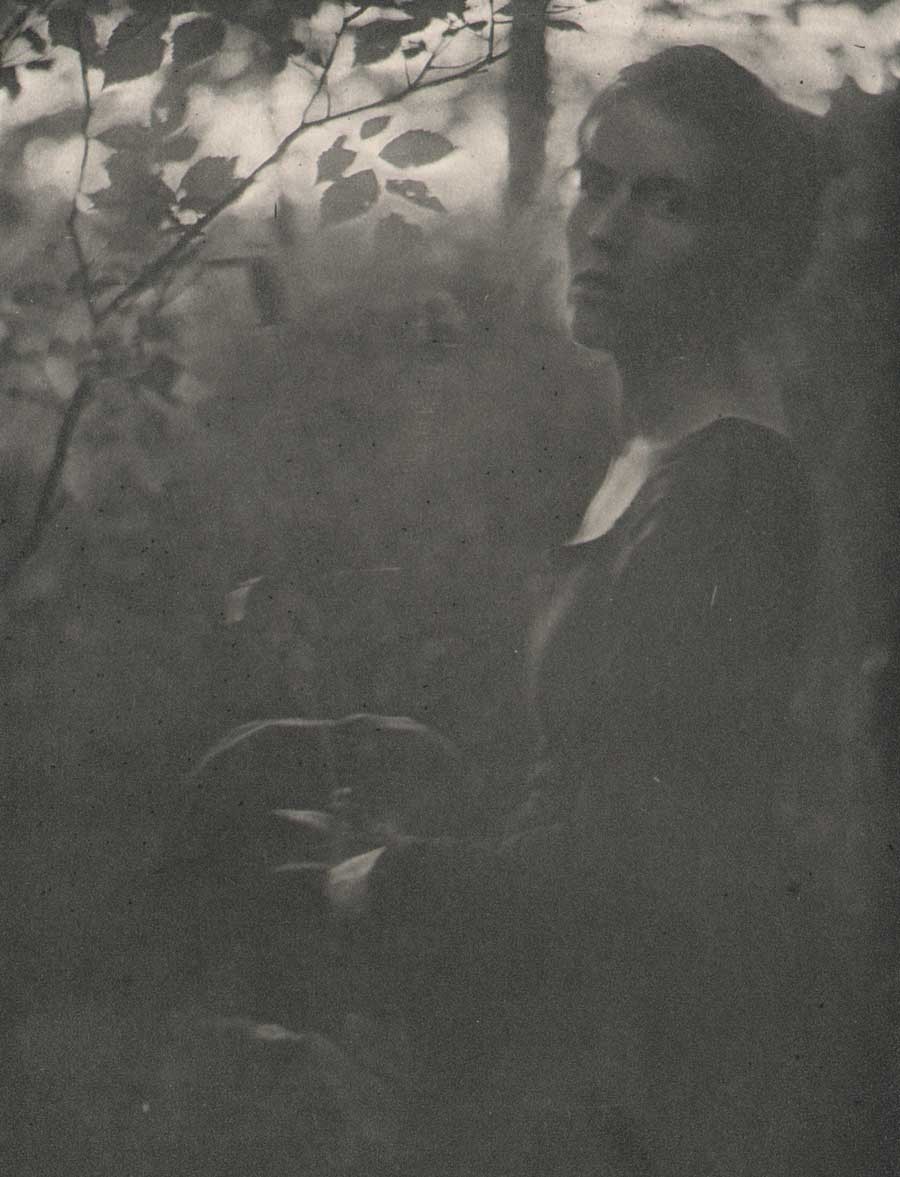 Detail: "At the Edge of the Woods ⎯ Evening": Clarence H. White, American (1871-1925): Chine-collé photogravure from Camera Notes, Vol. IV, April 1901: 14.4 x 10.1 cm | 28.6 x 19.6 cm uncut: The photographer’s sister-in-law, Letitia Felix is shown at twilight in a wooded setting. Alternately titled as In the Woods; Evening, the photograph was first exhibited in the Third Philadelphia Photographic Salon the same year. (cat.# 202) Later that year, it was exhibited as part of the Newark Camera Club’s exhibition in the town’s Association Building from November 28-December 1, 1900 where it was titled as Edge of the Woods ⎯Evening. The catalogue issued for the exhibit reproduced the photo as the frontis gravure for the publication. From: PhotoSeed Archi
Detail: "At the Edge of the Woods ⎯ Evening": Clarence H. White, American (1871-1925): Chine-collé photogravure from Camera Notes, Vol. IV, April 1901: 14.4 x 10.1 cm | 28.6 x 19.6 cm uncut: The photographer’s sister-in-law, Letitia Felix is shown at twilight in a wooded setting. Alternately titled as In the Woods; Evening, the photograph was first exhibited in the Third Philadelphia Photographic Salon the same year. (cat.# 202) Later that year, it was exhibited as part of the Newark Camera Club’s exhibition in the town’s Association Building from November 28-December 1, 1900 where it was titled as Edge of the Woods ⎯Evening. The catalogue issued for the exhibit reproduced the photo as the frontis gravure for the publication. From: PhotoSeed Archi
In groundbreaking photographs by White such as his brooding landscape figure study At the Edge of the Woods ⎯Evening (1900), a remarkable twilight composition showing his sister-in-law Letitia Felix emerging from a thicket with just a hint of light on the horizon became just one example of his early output. White’s decidedly masterful reinterpretation of the possibilities of light and the photographic medium done with artistic intent was quickly getting accolades in the press, and his work was soon honored in salons the world over beginning at the end of the 19th century.
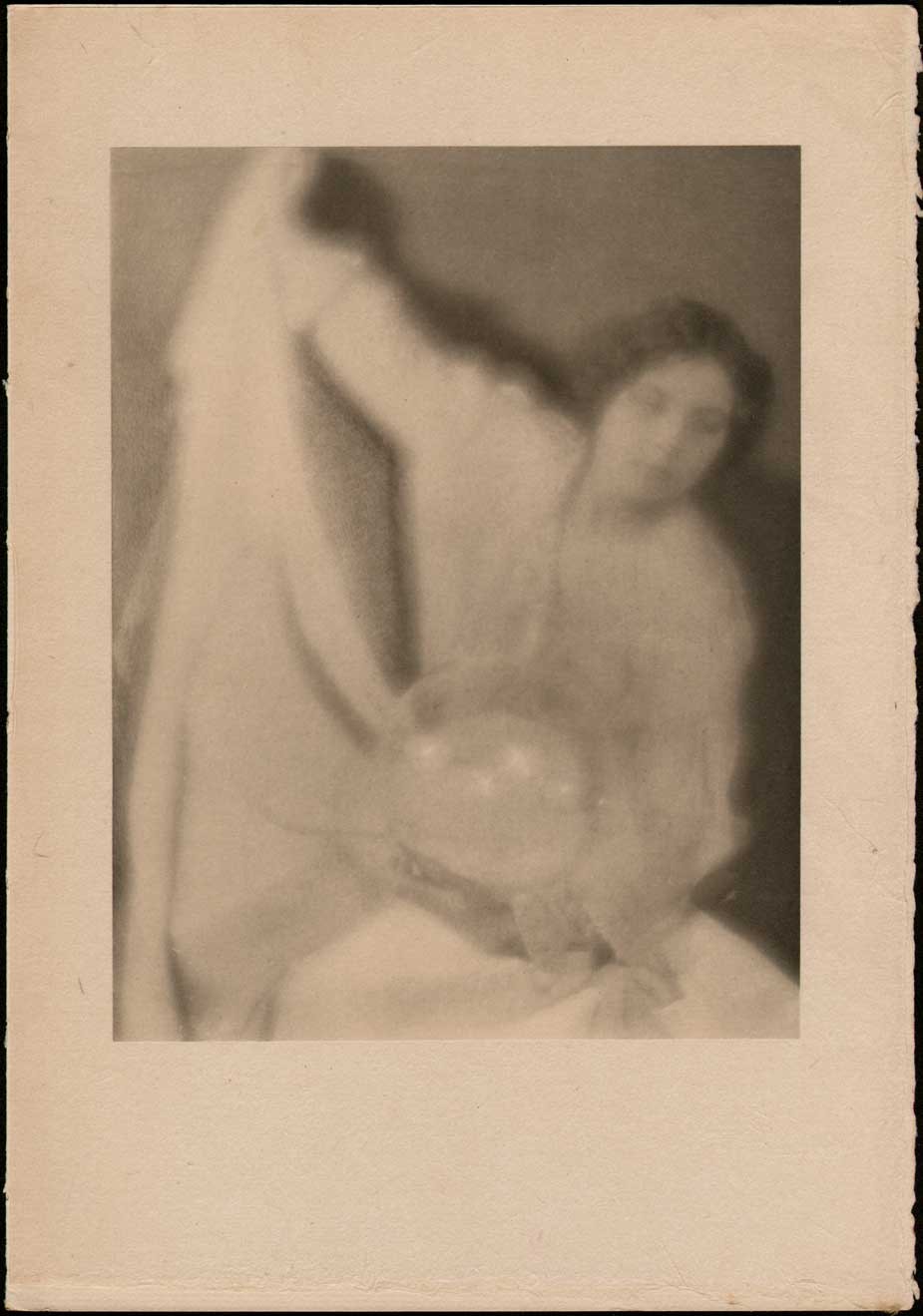 "Experiment 28": Alfred Stieglitz 1864-1946 & Clarence White 1871-1925, Americans: vintage japanese tissue photogravure published in Camera Work XXVII: 1909: 20.6 x 15.9 | 30.2 x 21.1 cm: In 1907, the year after Clarence White arrived in New York City, he collaborated with Photo-Secession founder Alfred Stieglitz on a series of portraits featuring two models. Shown here holding a glass globe, California model Mabel Cramer poses in a portrait later reproduced as a plate in Camera Work. Said to be a friend of the German American photographer Arnold Genthe and possessing a face worthy of Cleopatra, Cramer and a woman known only as a Miss Thompson, posed for a series of photographs intended to promote photography as an equivalent medium to painting. It was the only time Stieglitz would ever work in tandem with another photographer and shows the extent to which the photographers were allied aesthetically and technically. From: PhotoSeed Archive
"Experiment 28": Alfred Stieglitz 1864-1946 & Clarence White 1871-1925, Americans: vintage japanese tissue photogravure published in Camera Work XXVII: 1909: 20.6 x 15.9 | 30.2 x 21.1 cm: In 1907, the year after Clarence White arrived in New York City, he collaborated with Photo-Secession founder Alfred Stieglitz on a series of portraits featuring two models. Shown here holding a glass globe, California model Mabel Cramer poses in a portrait later reproduced as a plate in Camera Work. Said to be a friend of the German American photographer Arnold Genthe and possessing a face worthy of Cleopatra, Cramer and a woman known only as a Miss Thompson, posed for a series of photographs intended to promote photography as an equivalent medium to painting. It was the only time Stieglitz would ever work in tandem with another photographer and shows the extent to which the photographers were allied aesthetically and technically. From: PhotoSeed Archive
Not bad for a man with limited means and a high school education. Employed as a bookkeeper in 1890’s Newark nearly seven days a week for the same wholesale grocery firm his father worked at, (the family had moved there in 1887 from nearby West Carlisle, OH), White first took up amateur photography a year after his 1893 marriage to Jane Felix, with the young photographer diligently saving weekly spare change from his salary for camera and darkroom supplies. Reportedly, his reality of only being able to afford the exposure of several glass plates a week necessitated lots of planning in order to make successful photographs. With outdoor locations previously scouted throughout Licking County and interiors often taken in the darkened homes of family and friends, these same subjects were further cajoled into wearing fashions from the American Civil-War era or earlier in order to evoke feelings of times gone by for the compositions.
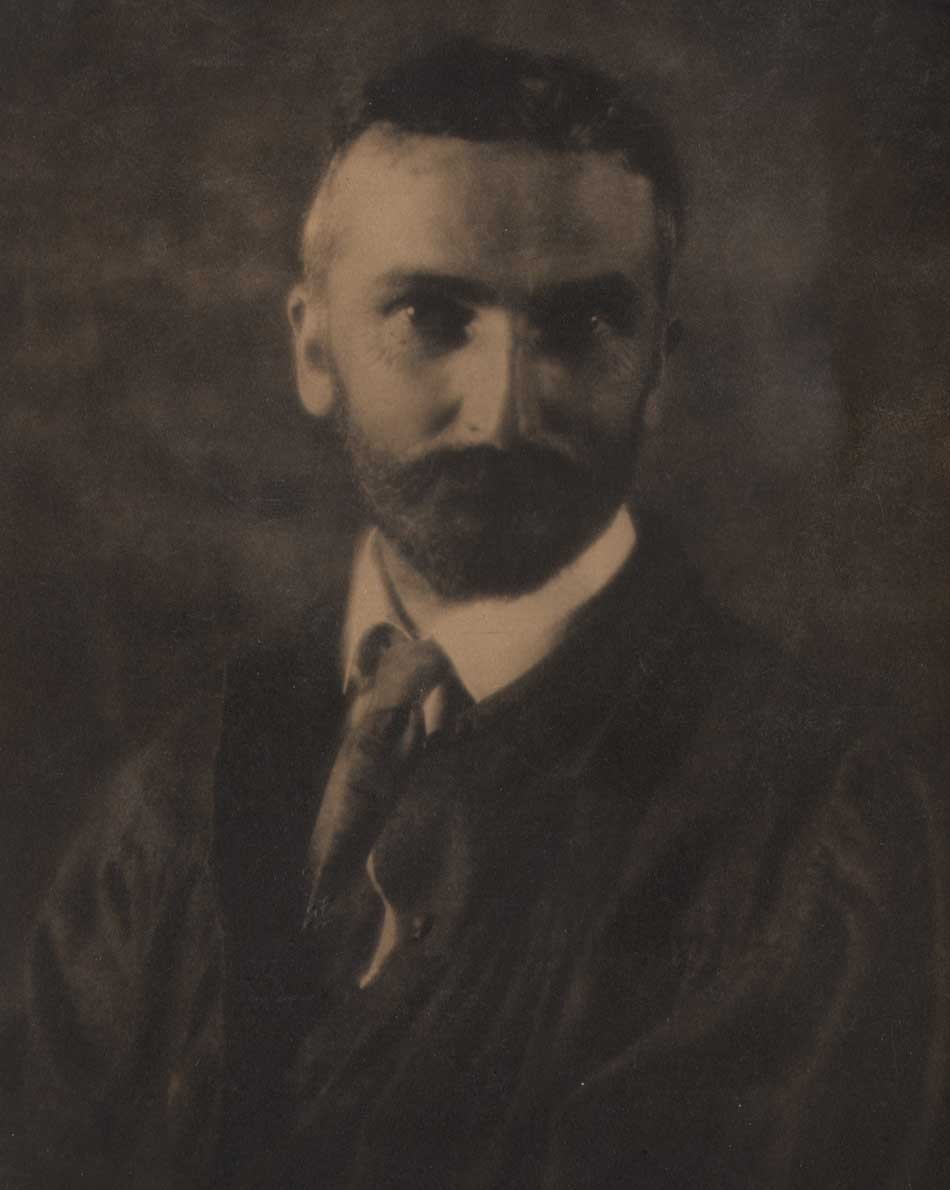 Detail: "Portrait of Arthur Wesley Dow": Clarence H. White, American (1871-1925): vintage waxed platinum print, unmounted: 22.1 x 16.6 cm. From the Princeton University Museum website: "White was hired by Arthur Wesley Dow at Teachers College in 1907 and shared Dow’s philosophy that students of the fine and the applied arts should have the same fundamental training based on design principles (anticipating the approach of the Bauhaus in the 1920s)." from: PhotoSeed Archive
Detail: "Portrait of Arthur Wesley Dow": Clarence H. White, American (1871-1925): vintage waxed platinum print, unmounted: 22.1 x 16.6 cm. From the Princeton University Museum website: "White was hired by Arthur Wesley Dow at Teachers College in 1907 and shared Dow’s philosophy that students of the fine and the applied arts should have the same fundamental training based on design principles (anticipating the approach of the Bauhaus in the 1920s)." from: PhotoSeed Archive
A founding member of the American Photo-Secession movement begun in 1902 by Alfred Stieglitz, White’s transition from Newark to New York City in 1906 began a new chapter of teaching by the photographer, who soon made the acquaintance of artist and arts educator Arthur Wesley Dow, (1857-1922) who hired White as an instructor at Columbia University’s Teachers College in 1907. White would go on to found his own groundbreaking schools of artistic photography utilizing a modern pedagogy learned from Dow among others: first in Maine beginning in 1910 and then in New York City in 1914. Besides emphasizing pictorial photographic technique as well as numerous technical processes as part of the school curriculum, modern composition as espoused by Dow was taught along with art history through lecture format in classes by artists including early American cubist painter Max Weber (1881-1961) and later by artists including Charles James Martin (1886-1955) in the early 1920’s.
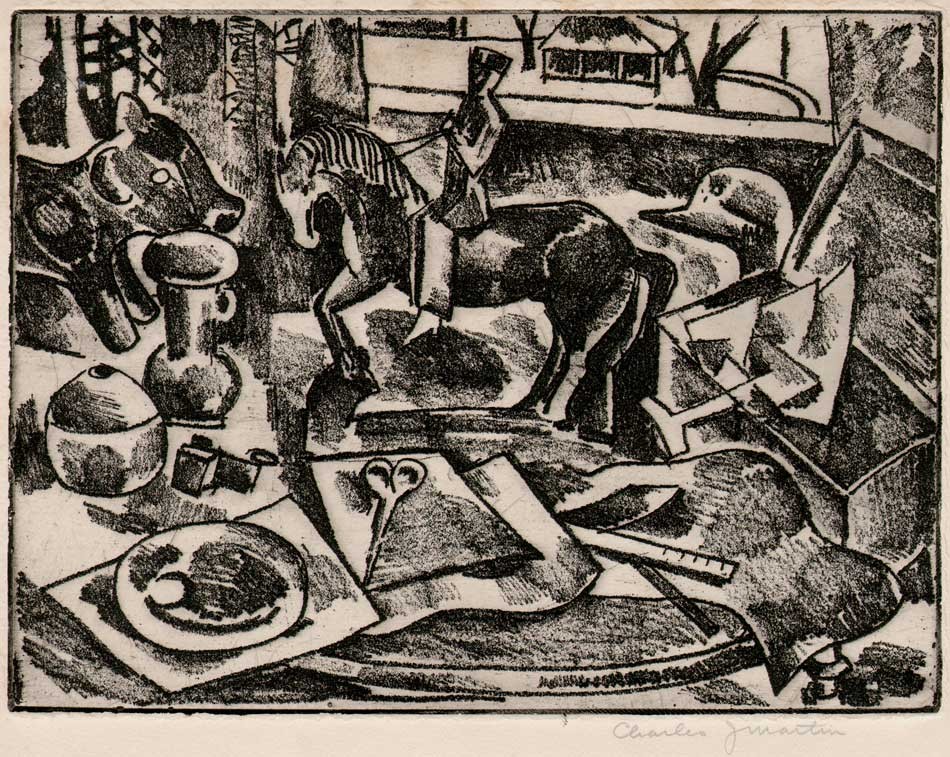 "Interior Composition with Figurines": Charles James Martin, American (1886-1955): vintage etching on plate paper ca. 1915-20: 15.1 x 20.1 | 18.8 x 24.8 cm (trimmed): Martin studied with Arthur Wesley Dow, and later taught alongside him at Columbia University Teachers College. At TC, he also studied photography with Clarence H. White, and became an instructor at White’s School of Photography in 1918. Martin began teaching at the Art Students League of New York in 1921. The following background on Martin and his involvement with the White school appeared in the February, 1921 issue of "The Touchstone and the American Art Student Magazine": "The Clarence H. White School of Photography announces a course of instruction in Print Making by Prof. Charles J. Martin of the Department of Fine Arts, Columbia University. The purpose of the course is to develop an appreciation of prints through a study of fine examples and particularly through practice in etching plates, cutting blocks and printing. There will be also an opportunity to do photo-engraving such as the line cut and photogravure. The course will consist of twenty sessions. The earlier sessions are now under way, and the response to this announcement gives evidence that the student of the Photographic Arts is endeavoring to gain practical knowledge as well as artistic reproduction." p. 406: from: PhotoSeed Archive
"Interior Composition with Figurines": Charles James Martin, American (1886-1955): vintage etching on plate paper ca. 1915-20: 15.1 x 20.1 | 18.8 x 24.8 cm (trimmed): Martin studied with Arthur Wesley Dow, and later taught alongside him at Columbia University Teachers College. At TC, he also studied photography with Clarence H. White, and became an instructor at White’s School of Photography in 1918. Martin began teaching at the Art Students League of New York in 1921. The following background on Martin and his involvement with the White school appeared in the February, 1921 issue of "The Touchstone and the American Art Student Magazine": "The Clarence H. White School of Photography announces a course of instruction in Print Making by Prof. Charles J. Martin of the Department of Fine Arts, Columbia University. The purpose of the course is to develop an appreciation of prints through a study of fine examples and particularly through practice in etching plates, cutting blocks and printing. There will be also an opportunity to do photo-engraving such as the line cut and photogravure. The course will consist of twenty sessions. The earlier sessions are now under way, and the response to this announcement gives evidence that the student of the Photographic Arts is endeavoring to gain practical knowledge as well as artistic reproduction." p. 406: from: PhotoSeed Archive
At 54, Clarence White died of a heart attack while accompanying photo students during a summer session of his school in Mexico City in 1925. Besides his important contributions as a ground-breaking photographic artist in the late 19th and early 20th century, his legacy as a teacher is perhaps more important as we finally begin to reevaluate his importance in the larger history of early artistic photography. The Princeton exhibition and accompanying monograph-the first truly comprehensive volume on White ever published, will further our understanding and appreciation for this gentleman.
PhotoSeed is honored to have played a small role in the exhibition showcasing Clarence White’s talents at photographic book illustration. A slim volume loaned for the show, Songs of All Seasons, published in 1904 with prose by his uncle Ira Billman and photographs by White, will be included in an exhibit display case. An additional rare illustrated copy of Irving Bacheller’s best-selling novel Eben Holden from 1903, with photogravure plates by White, will also appear after it was acquired by Princeton from this archive. This site further intends to publish additional posts over the next several years chronicling White’s groundbreaking schools of photography as well as other aspects of his early and later life in Newark, OH and New York.
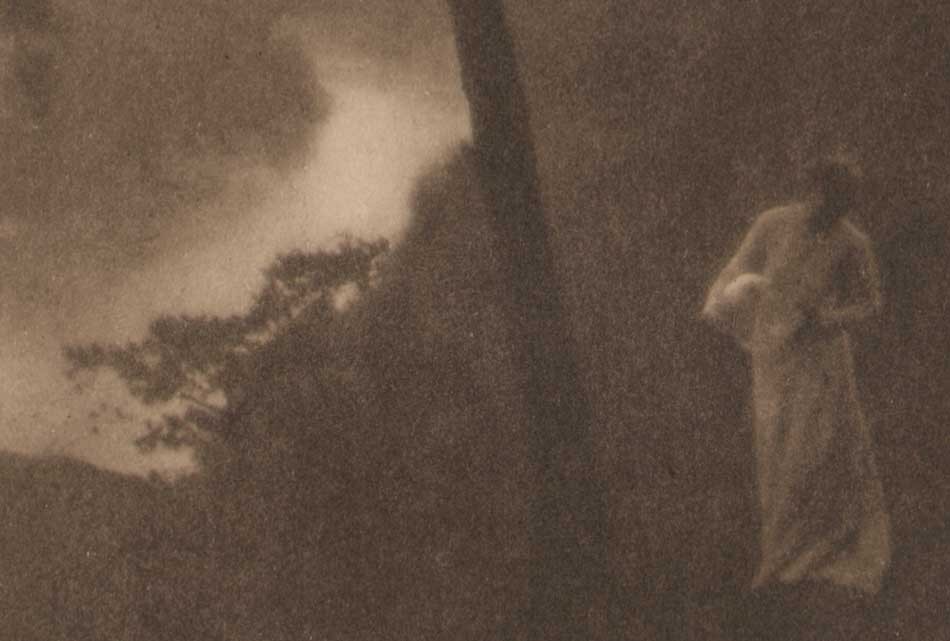 Detail: "Morning": Clarence H. White, American (1871-1925): 1905: vintage photogravure published in the volume "The Artistic Side of Photography" by A.J. Anderson: London, Stanley Paul & Co., 1910. 11.9 x 9.3 | 22.5 x 15.1 cm. The plate, titled "A Landscape", from a platinotype in the collection of A.L. Coburn, appears on p. 155. This moody landscape photograph with figure was taken by White on the bluffs in Newark, Ohio overlooking the Licking River, a location that appears in several of the photographer's compositions. From the Metropolitan Museum of Art Website, which holds an original platinum print dated to 1905 bequeathed by Alfred Stieglitz: "Morning perfectly embodies the tenets of Pictorialism: expressive, rather than narrative or documentary, content; craftsmanship in the execution of the print; and a carefully constructed composition allied to Impressionist and American Tonalist painting and to popular Japanese prints. His photographs from the period before he moved to New York in 1906 signaled a remove from the modern urban world. Neither genre scene nor narrative tableau, this photograph is a retreat into domesticized nature." From: PhotoSeed Archive
Detail: "Morning": Clarence H. White, American (1871-1925): 1905: vintage photogravure published in the volume "The Artistic Side of Photography" by A.J. Anderson: London, Stanley Paul & Co., 1910. 11.9 x 9.3 | 22.5 x 15.1 cm. The plate, titled "A Landscape", from a platinotype in the collection of A.L. Coburn, appears on p. 155. This moody landscape photograph with figure was taken by White on the bluffs in Newark, Ohio overlooking the Licking River, a location that appears in several of the photographer's compositions. From the Metropolitan Museum of Art Website, which holds an original platinum print dated to 1905 bequeathed by Alfred Stieglitz: "Morning perfectly embodies the tenets of Pictorialism: expressive, rather than narrative or documentary, content; craftsmanship in the execution of the print; and a carefully constructed composition allied to Impressionist and American Tonalist painting and to popular Japanese prints. His photographs from the period before he moved to New York in 1906 signaled a remove from the modern urban world. Neither genre scene nor narrative tableau, this photograph is a retreat into domesticized nature." From: PhotoSeed Archive
EXHIBITION SCHEDULE: Clarence H. White and His World: The Art and Craft of Photography, 1895-1925
Princeton University Art Museum (10/07/17–01/07/18)
Further link to the exhibit at Princeton
Video: Breaking down photographic processes used by Pictorialist photographers: a collaboration between the Princeton University Art Museum and the Yale Institute for the Preservation of Cultural Heritage.
Davis Museum, Wellesley College
(02/13/18–06/10/18)
Portland Museum of Art, Maine
(06/22/18–09/16/18)
Cleveland Museum of Art
(10/21/18–01/21/19)
Book link:
October 31, 2017
408 pages, 10 x 11 1/2
346 color + b/w illus.
ISBN: 9780300229080
Hardcover
Distributed for the Princeton University Art Museum
Stages for Ages
Posted April 2016 in Exhibitions, History of Photography, New Additions, Publishing, Significant Photographers
All the world’s a stage, And all the men and women merely players: They have their exits and their entrances; And one man in his time plays many parts, His acts being seven ages.
-From As You Like It, Act II. Scene VII, Jaques’s speech
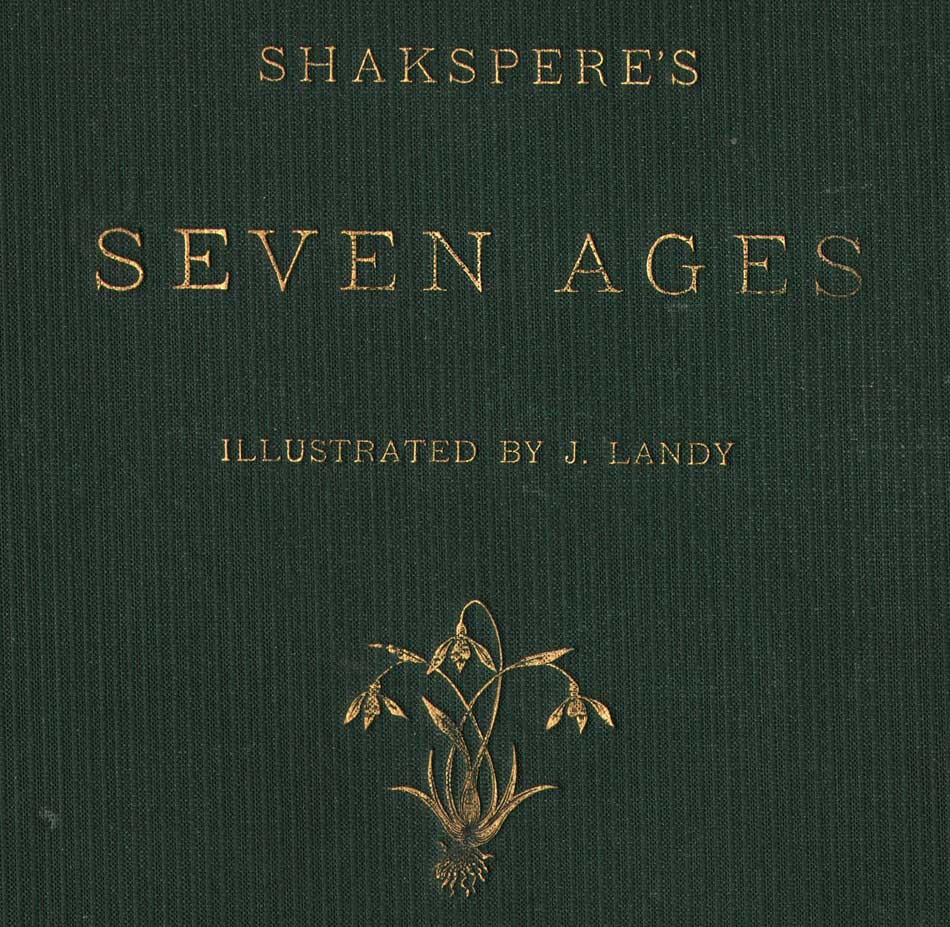 Detail: book cover: "Shakspere’s Seven Ages" Illustrated by J. Landy: Octavo with letterpress and seven individual pasted albumen portrait photographs by Landy: Cincinnati: Robert Clarke & Co., 1876: from: PhotoSeed Archive
Detail: book cover: "Shakspere’s Seven Ages" Illustrated by J. Landy: Octavo with letterpress and seven individual pasted albumen portrait photographs by Landy: Cincinnati: Robert Clarke & Co., 1876: from: PhotoSeed Archive
In life, Birthdays typically get all the attention. At least while your friends are around. Not so much death. But for certain souls long departed this mortal coil, it’s just as important. This is especially true for English playwright and poet William Shakespeare, whose passing on April 23, 1616 at 52 years of age- or 400 years ago today- seems like a perfectly good excuse to throw a party as well. Cincinnati portrait photographer James M. Landy (1838-1897) would have readily agreed, and he used the excuse of another anniversary-America’s first Centennial held in 1876 in Philadelphia- to showcase his new series of “character photographs” illustrating the Bard’s Seven Ages of Man from his play As You Like It . (1.)
Come along on a short photographic journey exploring these ages of the male species, according to Shakespeare. Have they changed with the passage of time?
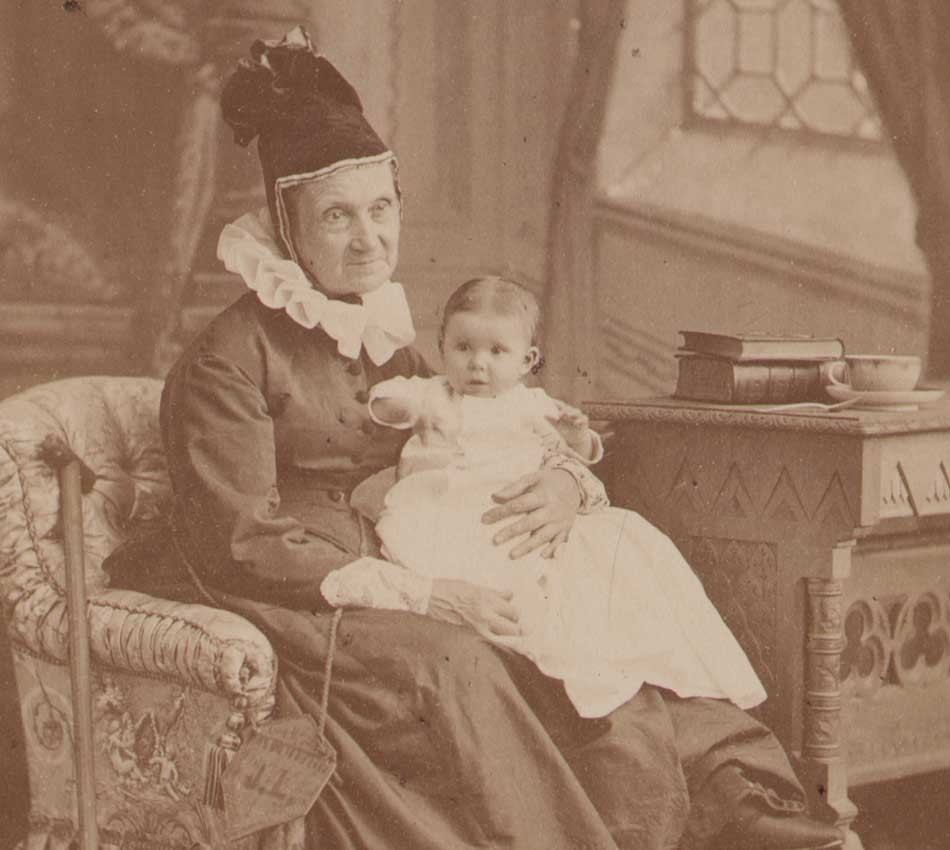 The First Age: Detail: "The Infant" : James M. Landy, American: 1876: pasted albumen print included in the volume "Shakspere’s Seven Ages": 14.0 x 9.9 | 24.7 x 19.0 cm: Cincinnati: Robert Clarke & Co., 1876. Captioned text opposite book plate: "At first the infant, Mewling and puking in the nurse’s arms.": From: PhotoSeed Archive
The First Age: Detail: "The Infant" : James M. Landy, American: 1876: pasted albumen print included in the volume "Shakspere’s Seven Ages": 14.0 x 9.9 | 24.7 x 19.0 cm: Cincinnati: Robert Clarke & Co., 1876. Captioned text opposite book plate: "At first the infant, Mewling and puking in the nurse’s arms.": From: PhotoSeed Archive
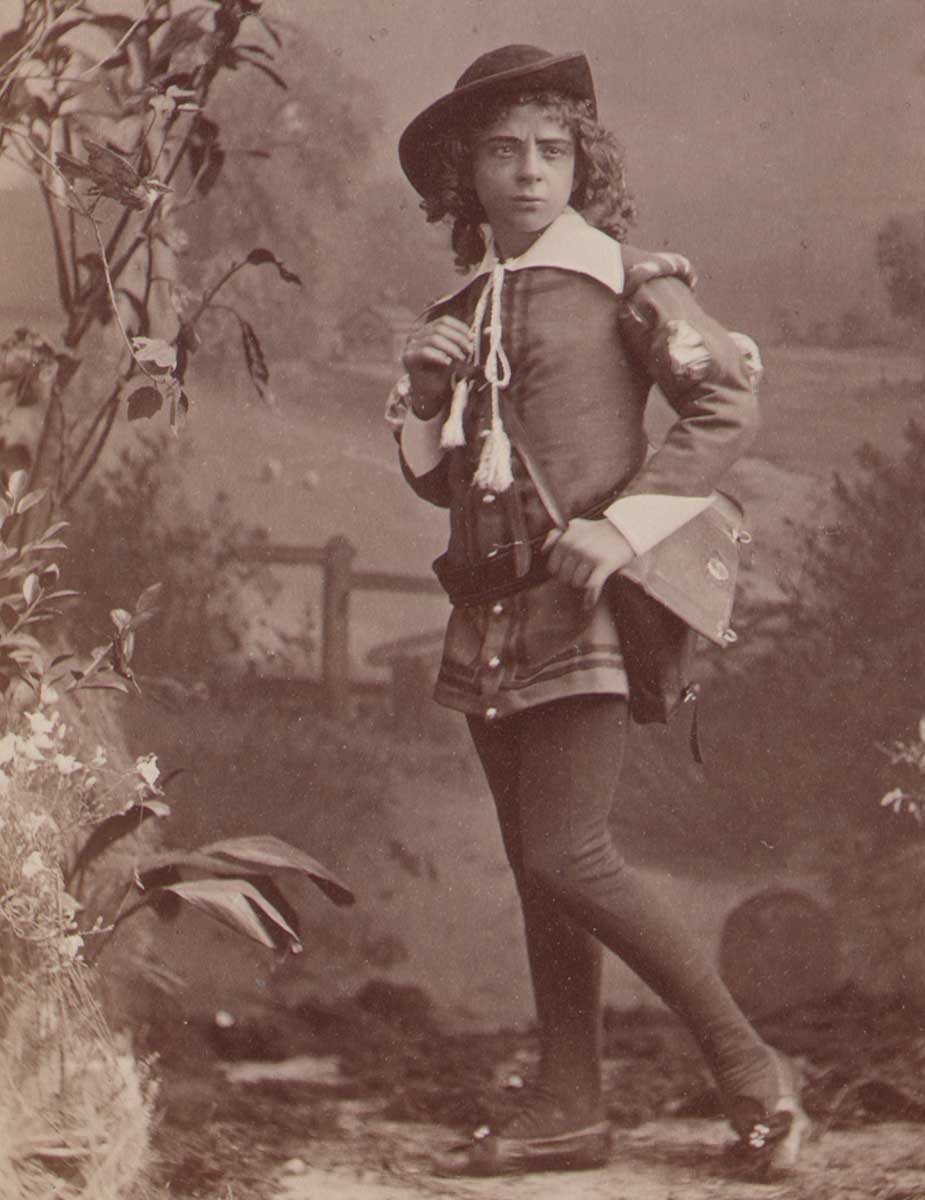 The Second Age: Detail: "The Schoolboy": James M. Landy, American: 1876: pasted albumen print included in the volume "Shakspere’s Seven Ages": 14.0 x 9.9 | 24.7 x 19.0 cm: Cincinnati: Robert Clarke & Co., 1876. Captioned text opposite book plate: "Then the whining school-boy, with his satchel, And shining morning face, creeping like snail Unwillingly to school." From: PhotoSeed Archive
The Second Age: Detail: "The Schoolboy": James M. Landy, American: 1876: pasted albumen print included in the volume "Shakspere’s Seven Ages": 14.0 x 9.9 | 24.7 x 19.0 cm: Cincinnati: Robert Clarke & Co., 1876. Captioned text opposite book plate: "Then the whining school-boy, with his satchel, And shining morning face, creeping like snail Unwillingly to school." From: PhotoSeed Archive
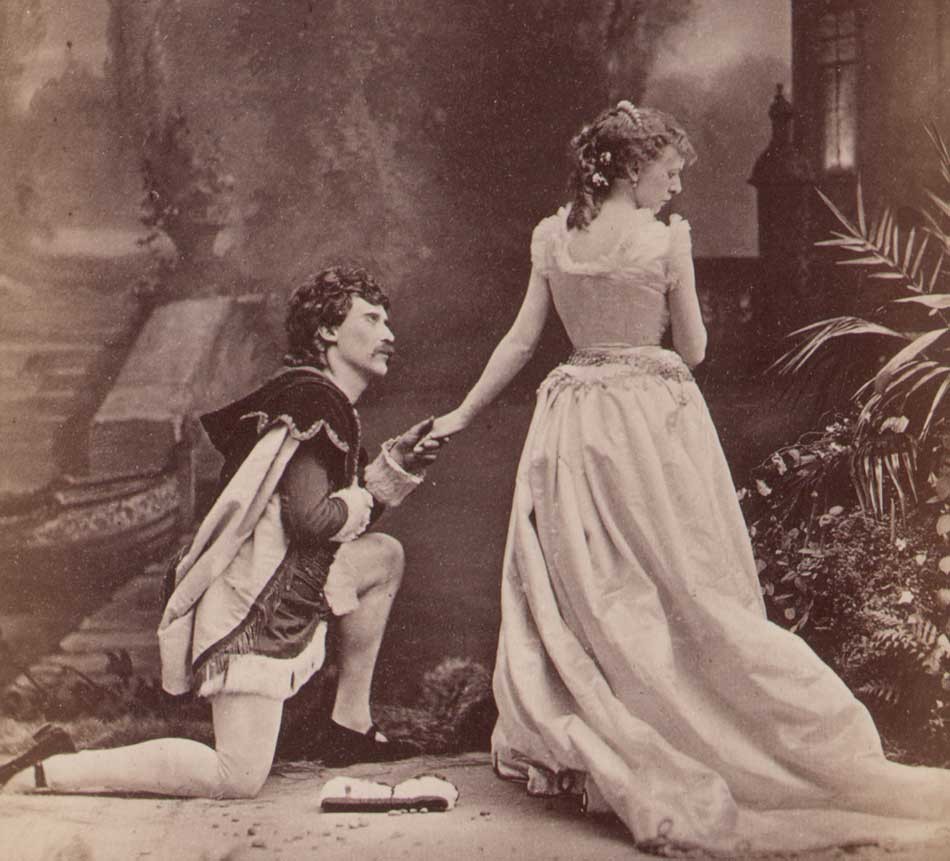 The Third Age: Detail: "The Lover": James M. Landy, American: 1876: pasted albumen print included in the volume "Shakspere’s Seven Ages": 14.3 x 9.9 | 24.7 x 19.0 cm: Cincinnati: Robert Clarke & Co., 1876. Captioned text opposite book plate: "And then the lover, Sighing like furnace, with a woful ballad Made to his mistress’ eyebrow." From: PhotoSeed Archive
The Third Age: Detail: "The Lover": James M. Landy, American: 1876: pasted albumen print included in the volume "Shakspere’s Seven Ages": 14.3 x 9.9 | 24.7 x 19.0 cm: Cincinnati: Robert Clarke & Co., 1876. Captioned text opposite book plate: "And then the lover, Sighing like furnace, with a woful ballad Made to his mistress’ eyebrow." From: PhotoSeed Archive
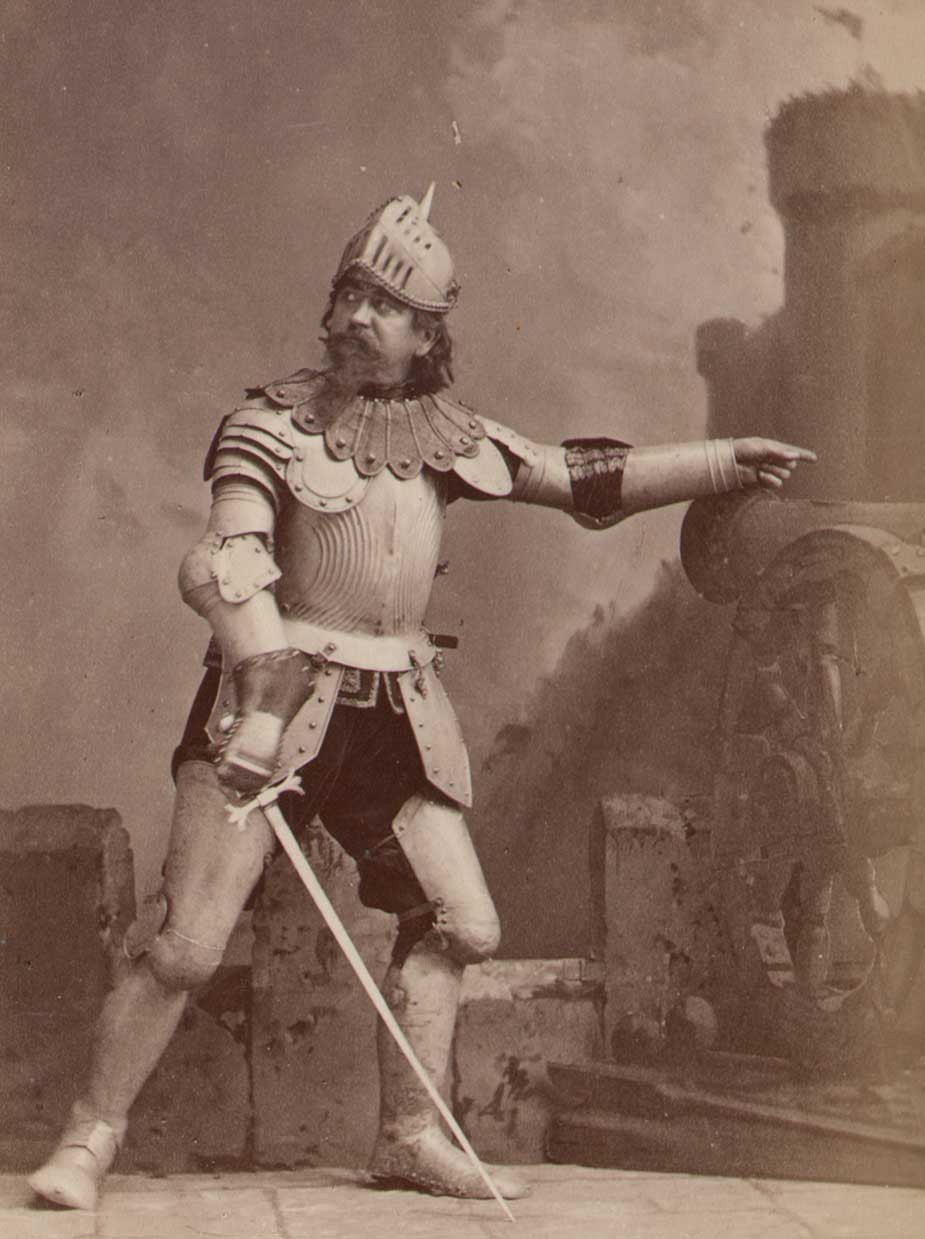 The Fourth Age: Detail: "The Soldier": James M. Landy, American: 1876: pasted albumen print included in the volume "Shakspere’s Seven Ages": 14.0 x 9.9 | 24.7 x 19.0 cm: Cincinnati: Robert Clarke & Co., 1876. Captioned text opposite book plate: "Then a soldier, Full of strange oaths, and bearded like the pard, Jealous in honor, sudden and quick in quarrel, Seeking the bubble reputation Even in the cannon’s mouth." From: PhotoSeed Archive
The Fourth Age: Detail: "The Soldier": James M. Landy, American: 1876: pasted albumen print included in the volume "Shakspere’s Seven Ages": 14.0 x 9.9 | 24.7 x 19.0 cm: Cincinnati: Robert Clarke & Co., 1876. Captioned text opposite book plate: "Then a soldier, Full of strange oaths, and bearded like the pard, Jealous in honor, sudden and quick in quarrel, Seeking the bubble reputation Even in the cannon’s mouth." From: PhotoSeed Archive
 The Fifth Age: "The Justice": James M. Landy, American: 1876: pasted albumen print included in the volume "Shakspere’s Seven Ages": 14.3 x 9.7 | 24.7 x 19.0 cm: Cincinnati: Robert Clarke & Co., 1876. Captioned text opposite book plate: "And then the Justice, In fair round belly, with good capon lin'd, With eyes severe, and beard of formal cut, Full of wise saws and modern instances; And so he plays his part." From: PhotoSeed Archive
The Fifth Age: "The Justice": James M. Landy, American: 1876: pasted albumen print included in the volume "Shakspere’s Seven Ages": 14.3 x 9.7 | 24.7 x 19.0 cm: Cincinnati: Robert Clarke & Co., 1876. Captioned text opposite book plate: "And then the Justice, In fair round belly, with good capon lin'd, With eyes severe, and beard of formal cut, Full of wise saws and modern instances; And so he plays his part." From: PhotoSeed Archive
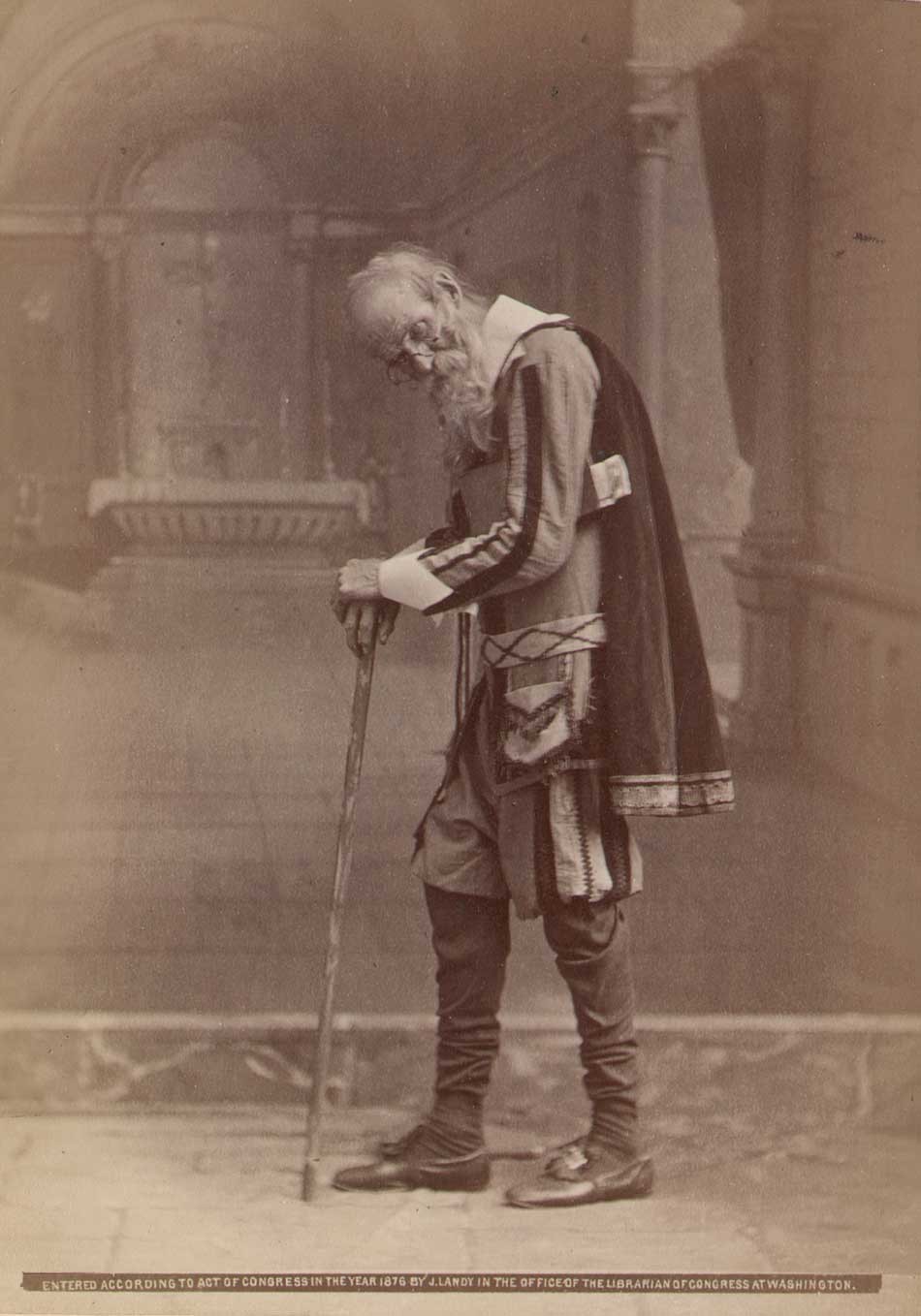 The Sixth Age: "The Lean and Slipper’d Pantaloon": James M. Landy, American: 1876: pasted albumen print included in the volume "Shakspere’s Seven Ages": 14.0 x 9.9 | 24.7 x 19.0 cm: Cincinnati: Robert Clarke & Co., 1876. Captioned text opposite book plate: "The sixth age shifts Into the lean and slipper’d pantaloon, With spectacles on nose and pouch on side, His youthful hose well saved, a world too wide For his shrunk shank; and his big manly voice, Turning again toward childish treble, pipes And whistles in his sound." From: PhotoSeed Archive
The Sixth Age: "The Lean and Slipper’d Pantaloon": James M. Landy, American: 1876: pasted albumen print included in the volume "Shakspere’s Seven Ages": 14.0 x 9.9 | 24.7 x 19.0 cm: Cincinnati: Robert Clarke & Co., 1876. Captioned text opposite book plate: "The sixth age shifts Into the lean and slipper’d pantaloon, With spectacles on nose and pouch on side, His youthful hose well saved, a world too wide For his shrunk shank; and his big manly voice, Turning again toward childish treble, pipes And whistles in his sound." From: PhotoSeed Archive
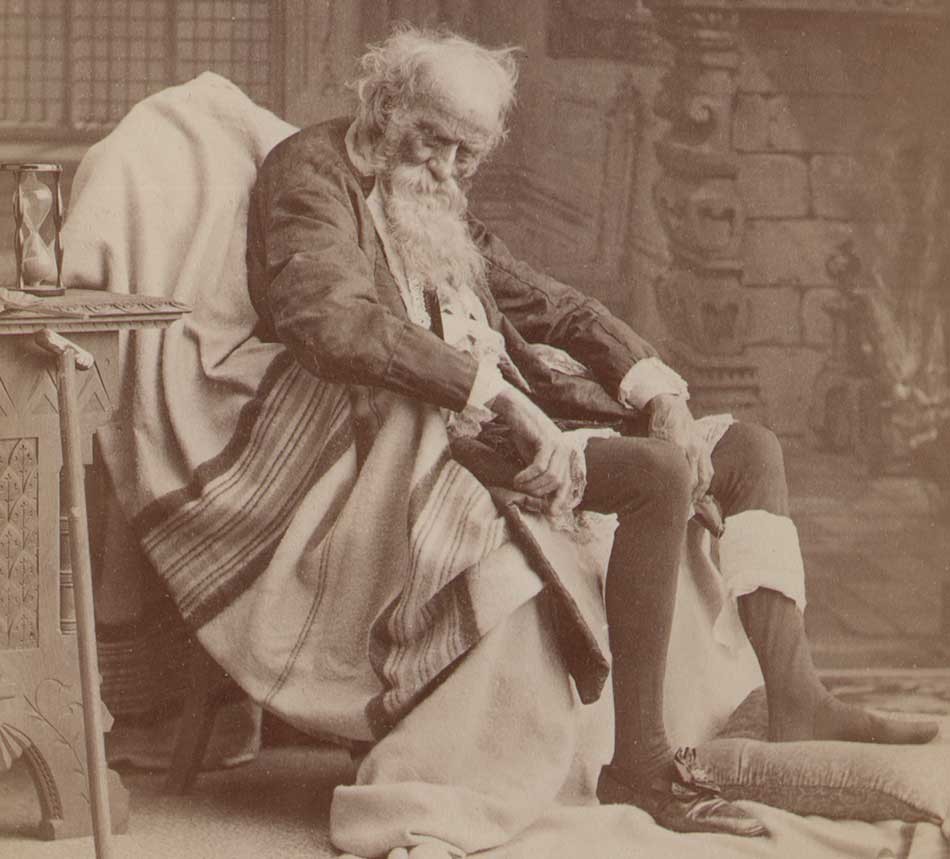 The Seventh Age: Detail: "Sans Teeth, Sans Eyes, Sans Taste, Sans Everything": James M. Landy, American: 1876: pasted albumen print included in the volume "Shakspere’s Seven Ages": 14.0 x 9.9 | 24.7 x 19.0 cm: Cincinnati: Robert Clarke & Co., 1876. Captioned text opposite book plate: "Last scene of all That ends this strange eventful history, Is second childishness and mere oblivion— Sans teeth, sans eyes, sans taste, sans everything.” From: PhotoSeed Archive
The Seventh Age: Detail: "Sans Teeth, Sans Eyes, Sans Taste, Sans Everything": James M. Landy, American: 1876: pasted albumen print included in the volume "Shakspere’s Seven Ages": 14.0 x 9.9 | 24.7 x 19.0 cm: Cincinnati: Robert Clarke & Co., 1876. Captioned text opposite book plate: "Last scene of all That ends this strange eventful history, Is second childishness and mere oblivion— Sans teeth, sans eyes, sans taste, sans everything.” From: PhotoSeed Archive
1. James Landy: from: Artists in Ohio, 1787-1900: A Biographical Dictionary, Mary Sayre Haverstock et al: Kent State University Press, 2000: p. 506
California Pipe Dreamer
Posted January 2016 in Alternate Processes, History of Photography, Journals, New Additions, Publishing, Texts
Sigismund Blumann, (1872-1956) an American who became an important editor and photographer after moving to San Francisco, California from New York City in the early 1880’s is our subject for this post, along with his involvement with and history of Camera Craft magazine. Never heard of him? A few relevant but by no means comprehensive list of details about this gentleman whose friends addressed him as “Sig” for short:
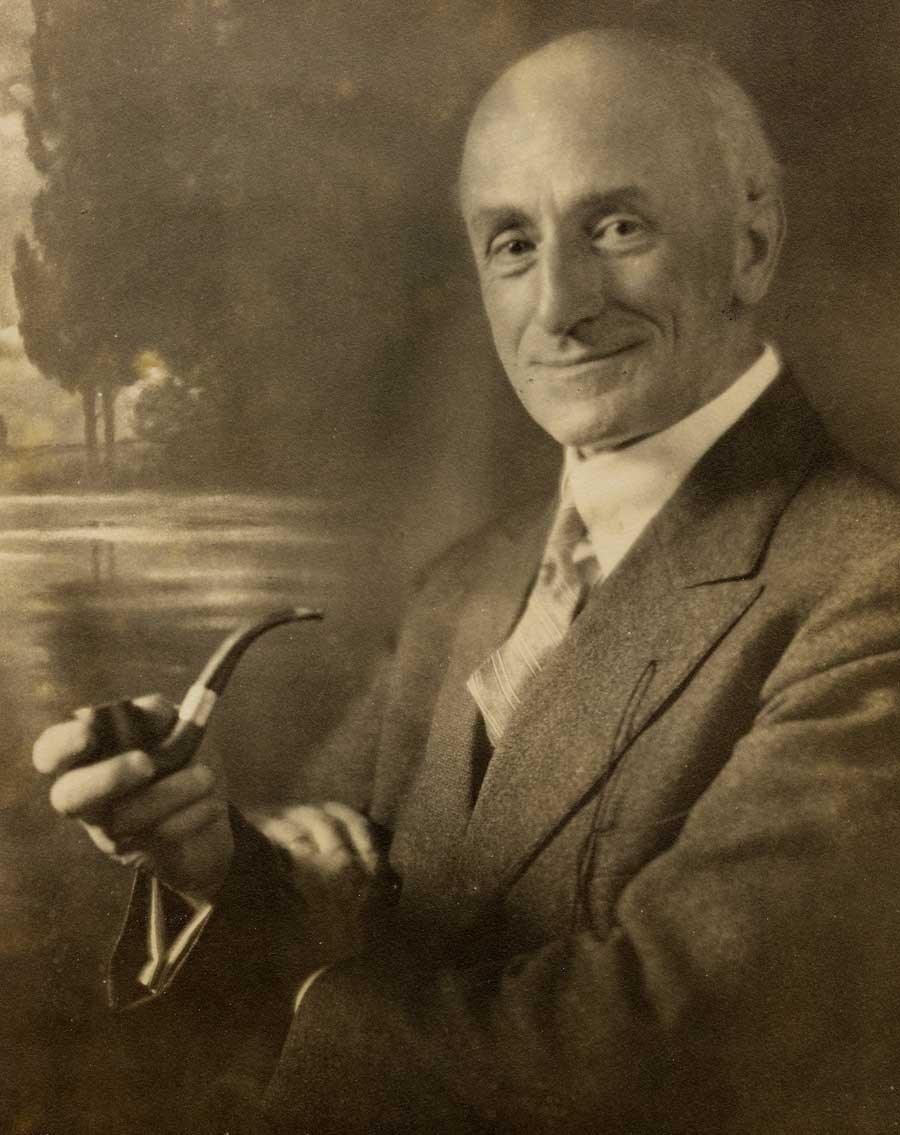 Detail: "Self-Portrait of Sigismund Blumann" (1872-1956) : American: gelatin silver print ca. 1930: Blumann was editor-in-chief of San Francisco-based Camera Craft magazine from 1924-1933: Photograph courtesy Thomas High
Detail: "Self-Portrait of Sigismund Blumann" (1872-1956) : American: gelatin silver print ca. 1930: Blumann was editor-in-chief of San Francisco-based Camera Craft magazine from 1924-1933: Photograph courtesy Thomas High
⌘ West Coast champion for photography in his role as Editor-in-Chief of Camera Craft magazine from 1924-1933. Prolific writer for said journal whose love of language sometimes lead to his mangling of it, but only with the best of intentions.
⌘ Significant pictorialist photographer from the same period and earlier whose darkroom work was equally inventive and important.
⌘ Poet.
⌘ So gregarious in affect, photographic historian Christian A. Peterson duly notes, (1.) that as editor, he personally answered all correspondence sent to him by his 8000 monthly Camera Craft readers in addition to his regular duties of penning multiple articles for each issue.
⌘ Possession of a sly sense of humor: look no further than a ca. 1930 self-portrait in which his suit lapel sprouts a long cable release rather than a floral boutonnière.
⌘ Conservative writer in print who often took a while to accept new ideas: as one example, Peterson notes his use of the made-up word “Sewereelism” included in a 1938 editorial written by him on his feelings towards the failings of the art movements Surrealism and Dada for the magazine Photo Art Monthly, a publication he owned himself. (2.)
⌘ Pipe smoker extraordinaire. Featured not only in the above referenced self-portrait but immortalized by artist W.R. Potter in print every month as artistic caricature shown smoking and reading a book used for his Under the Editor’s Lamp column in Camera Craft beginning in April 1926.
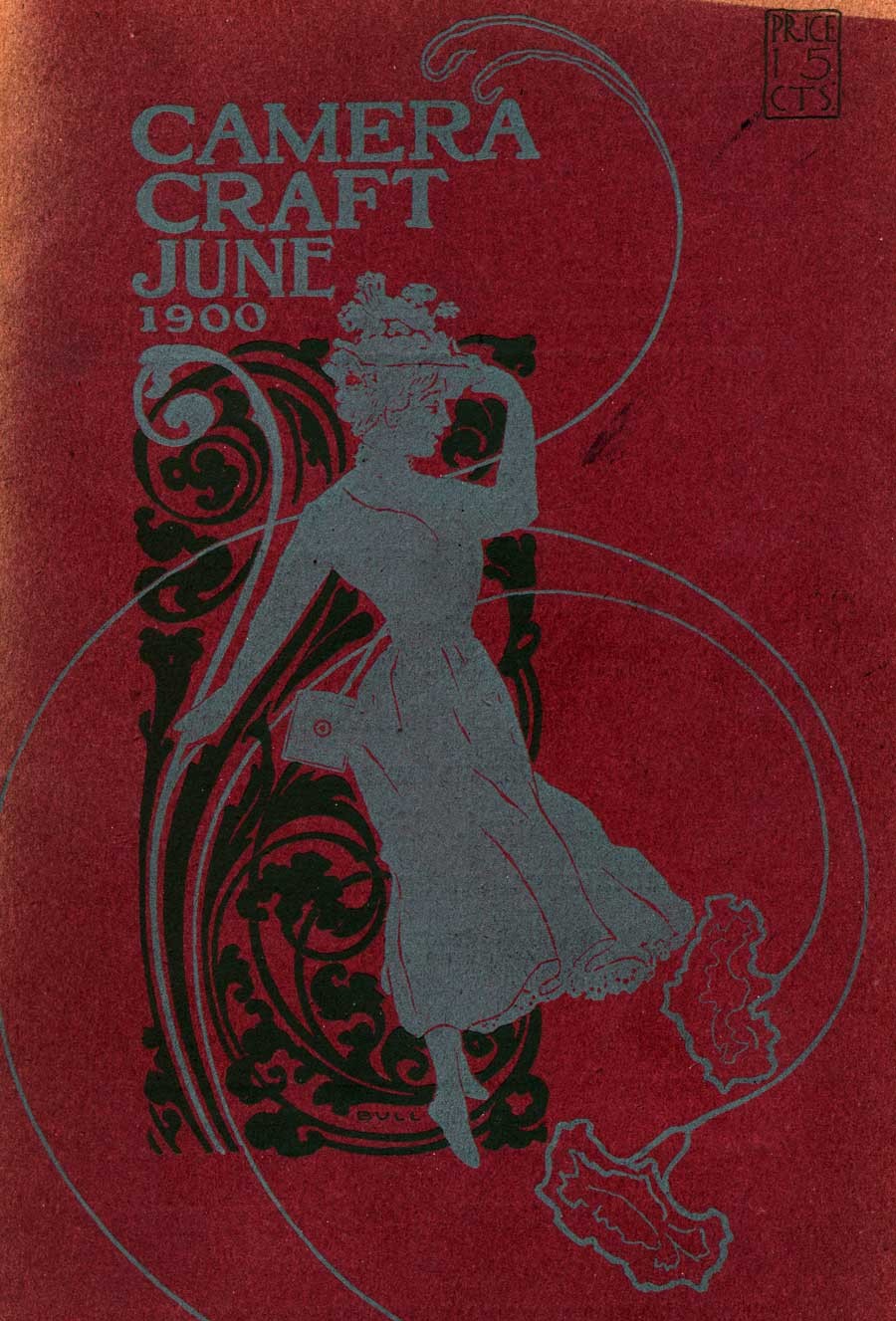 Detail: Cover Design: Camera Craft magazine: June, 1900: William Howell Bull: 1851-1940: American-California: 26.0 x 17.5 cm: two-color wood engraving : Sunset Press & Photo Engraving Company - San Francisco: cover price at upper right corner 15¢. Although this was the second issue of the magazine to appear, the first issue for May used the same cover design showing this stylish woman done in the Art-Nouveau style with small box camera slung on her side. From: PhotoSeed Archive
Detail: Cover Design: Camera Craft magazine: June, 1900: William Howell Bull: 1851-1940: American-California: 26.0 x 17.5 cm: two-color wood engraving : Sunset Press & Photo Engraving Company - San Francisco: cover price at upper right corner 15¢. Although this was the second issue of the magazine to appear, the first issue for May used the same cover design showing this stylish woman done in the Art-Nouveau style with small box camera slung on her side. From: PhotoSeed Archive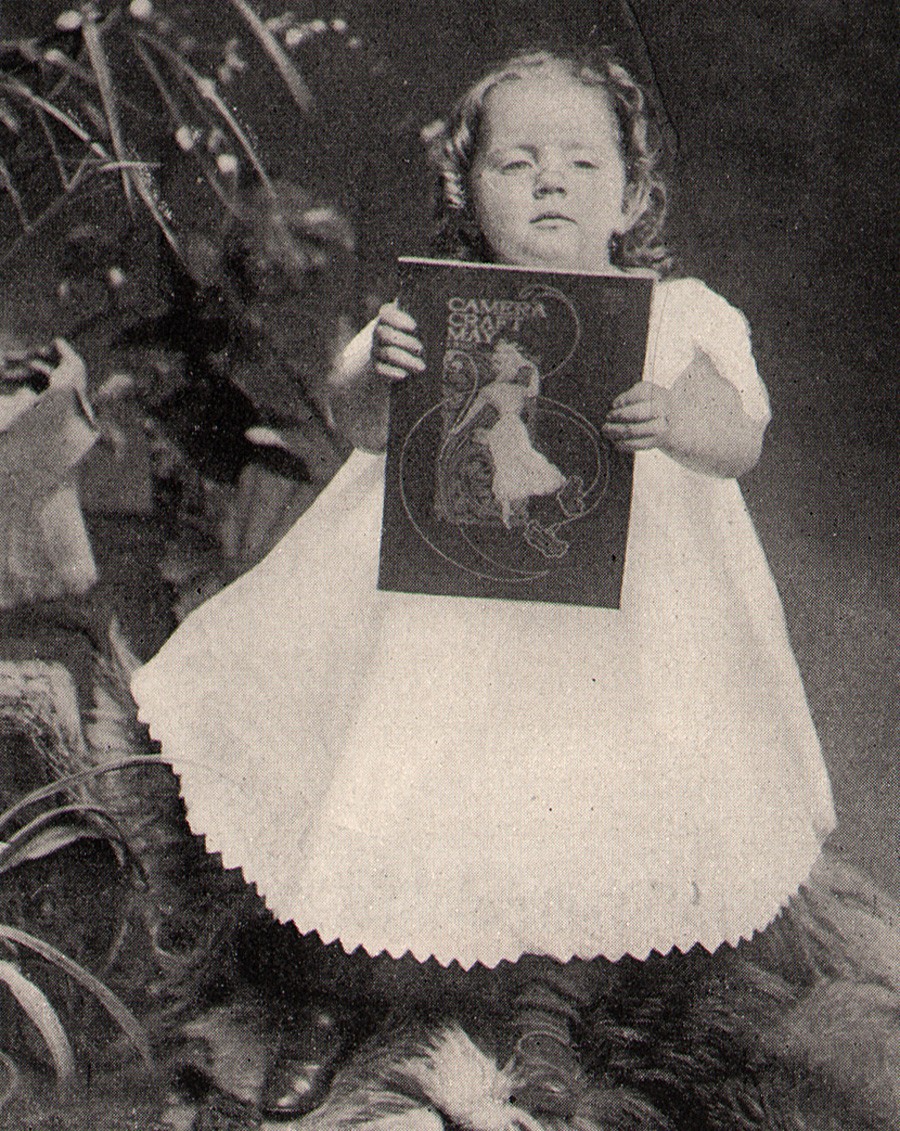 Detail: "Everyone Reads It": Mrs. C.S. Smith, American: Marysville (CA): halftone from June, 1900 Camera Craft magazine p. 57: 10.6 x 8.1 cm: A young girl holds up the very first issue of Camera Craft dated May, 1900. The design by California artist W.H. Bull was also used as the cover for June, 1900. From: PhotoSeed Archive
Detail: "Everyone Reads It": Mrs. C.S. Smith, American: Marysville (CA): halftone from June, 1900 Camera Craft magazine p. 57: 10.6 x 8.1 cm: A young girl holds up the very first issue of Camera Craft dated May, 1900. The design by California artist W.H. Bull was also used as the cover for June, 1900. From: PhotoSeed Archive
Sigismund Blumann: Short Biography
For the past three years, I’ve had the distinct pleasure of corresponding with Thomas High, Sigismund Blumann’s grandson, and been equally fortunate in acquiring a small archive of Sig’s vintage work for PhotoSeed previously kept in the family. Unlike Sig’s friends, Tom tells me, as a boy of perhaps five or six, he would of course address him as Grampa Blumann. Tom goes on to say:
”I only wish I had known him better – he died when I was a child, and my only real memories of him were playing rummy and whist with him.”
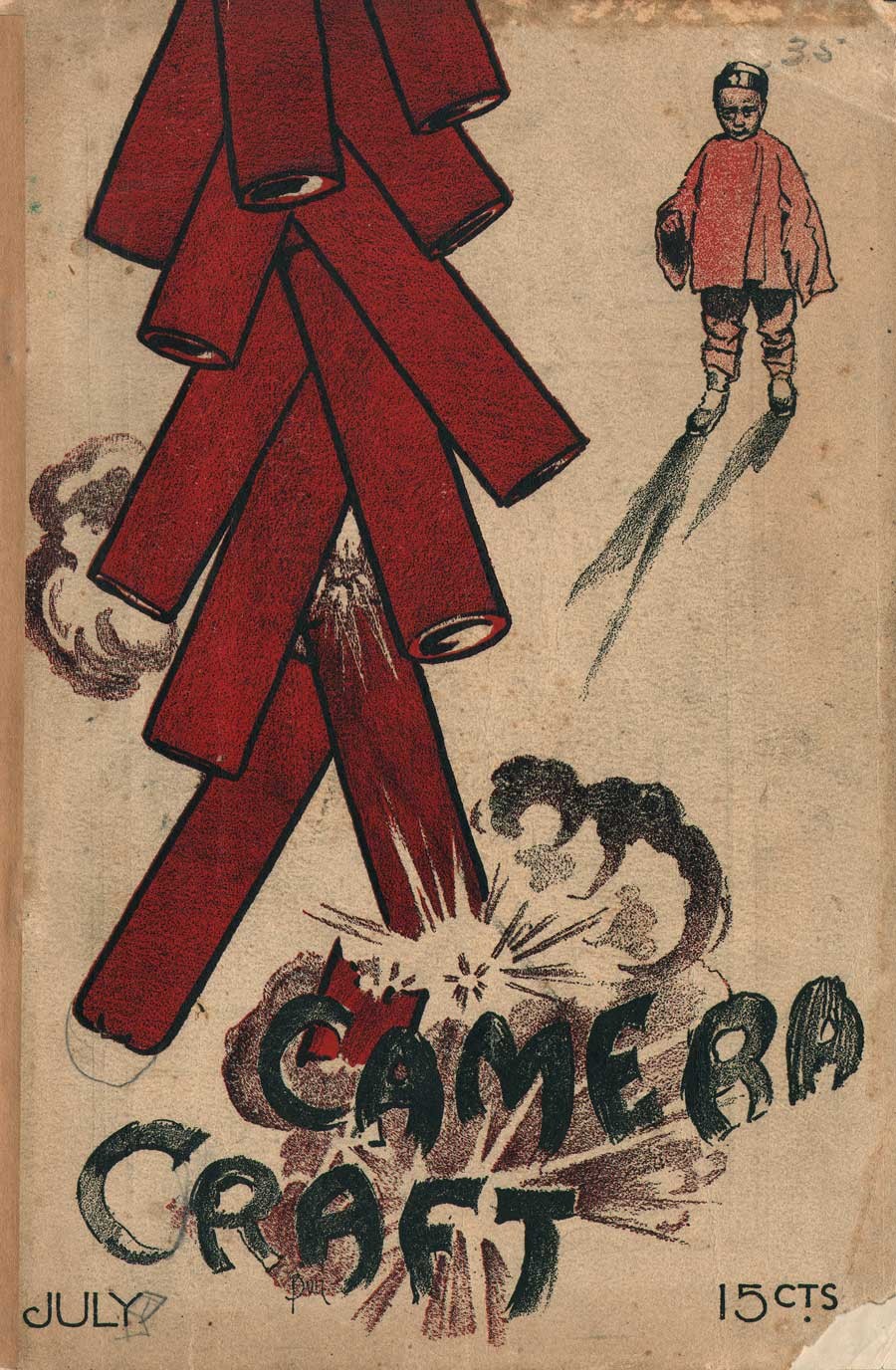 Cover Design: Chinese Firecrackers: Camera Craft magazine: July, 1900: William Howell Bull: 1851-1940: American-California: 26.0 x 17.5 cm: two-color wood engraving : Sunset Press & Photo Engraving Company - San Francisco: cover price at lower right corner 15¢. From: PhotoSeed Archive
Cover Design: Chinese Firecrackers: Camera Craft magazine: July, 1900: William Howell Bull: 1851-1940: American-California: 26.0 x 17.5 cm: two-color wood engraving : Sunset Press & Photo Engraving Company - San Francisco: cover price at lower right corner 15¢. From: PhotoSeed ArchiveTom has also agreed to let me reprint for purposes of introduction the following short biography of his grandfather written in October, 2009, for which I’m very grateful.
Sigismund Blumann (1872-1956) by Thomas High
Sigismund Blumann was born on September 13, 1872, in New York City, the son of Alexander Blumann and Rosalie (Price) Blumann. He came to San Francisco with his parents in late 1881 or 1882, and subsequently became a professional pianist and music teacher.
Sigismund Blumann married first on August 30, 1894, to Adele Morgenstern. They divorced in May of 1895. He married second on June 4, 1901, to Hilda Axelina Johansson and they subsequently had four daughters, Ethel, Amy, Lorna, and Vera.
In the 1890s, Sigismund Blumann became interested in photography and had begun taking photos seriously by 1900 while living in San Francisco. At the time of the San Francisco earthquake on April 9, 1906, he and his wife were still living with his parents on Army Street. He volunteered to help the recovery and, with his official permits, got through the lines and took a number of photographs.
Mr. Blumann was also a prolific writer and he authored numerous articles, commentaries, and poems.
After the 1906 earthquake, the Blumanns moved to Davis Street in Fruitvale (later part of Oakland). From that time, all of his photographic work was done in his darkroom at the Davis Street home.
Photography increased in importance in his life, and at the 1915 Panama-Pacific International Exposition he combined all of his talents: he played in an orchestra, photographed the Fair, and worked as a correspondent for the New York Tribune and other newspapers.
In the early 1920s, Sigismund retired from an active career in music and entered the profession of efficiency engineering, with offices in the Monadnock Building in San Francisco. His principal client was the Forster Music Publishing Company.
He continued his interest in photography and in 1924 he became editor of Camera Craft magazine. In addition to editing the publication and writing numerous articles for it, he also wrote the Photographic Workroom Handbook, published by Camera Craft in 1927.
Mr. Blumann’s last issue as editor of Camera Craft was in August of 1933. Several months later, he launched his own magazine, Photo Art Monthly, which he edited and published until 1940. During this period, he also produced several more manuals for amateur photographers, including the Photographic Handbook, Photographic Greetings - How to Make Them, Enlarging Manual, and Toning Processes.
In 1940, he sold the Photo Art Monthly to his assistant, Franke Unger (who married photographer Adolf Fassbender about the same time). She soon closed the magazine.
The Blumanns continued to live at their Davis Street home for the rest of their lives, joined by their unmarried daughters, Ethel and Lorna Blumann, both librarians. He produced little photographic work in the 1940s and 1950s, contenting himself to dabble in photography and discuss it with his new son-in-law, William A. High, who married his daughter, Vera, in February of 1943. Bill High was a commercial photographer before World War II, a combat photographer for the US Army during the war, and the founder of the photography department at Oakland’s Laney Trade School (later Peralta Junior College) thereafter.
Sigismund Blumann died in Oakland on July 9, 1956, and Hilda Blumann died on February 1, 1958, also in Oakland.
Sigismund Blumann’s photos are in the Oakland Museum, Minneapolis Institute of Art, High Museum in Atlanta, and elsewhere.
For further information, see “Sigismund Blumann, California Editor and Photographer,” by Christian A. Peterson, in History of Photography, vol. 26, no. 1. (Spring 2002).
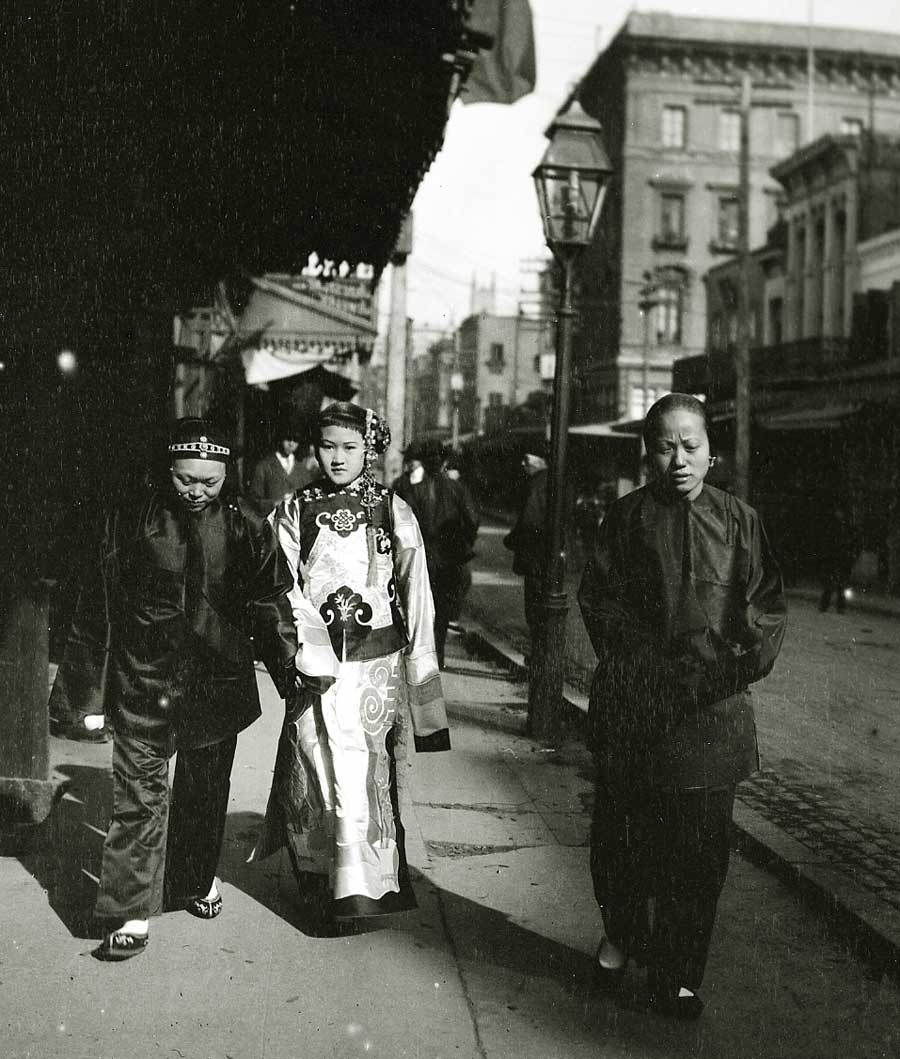 Detail: "Highborn Lady With Duenna": Sigismund Blumann: American: ca. 1901: This view is from a collection of at least 43 documentary photographs, with several corresponding paper negative envelopes dated 1901 by Blumann donated by his family to the California Historical Society. They can be viewed there as part of the collection “The Chinese in California: 1850-1925.” Photograph courtesy Thomas High
Detail: "Highborn Lady With Duenna": Sigismund Blumann: American: ca. 1901: This view is from a collection of at least 43 documentary photographs, with several corresponding paper negative envelopes dated 1901 by Blumann donated by his family to the California Historical Society. They can be viewed there as part of the collection “The Chinese in California: 1850-1925.” Photograph courtesy Thomas High
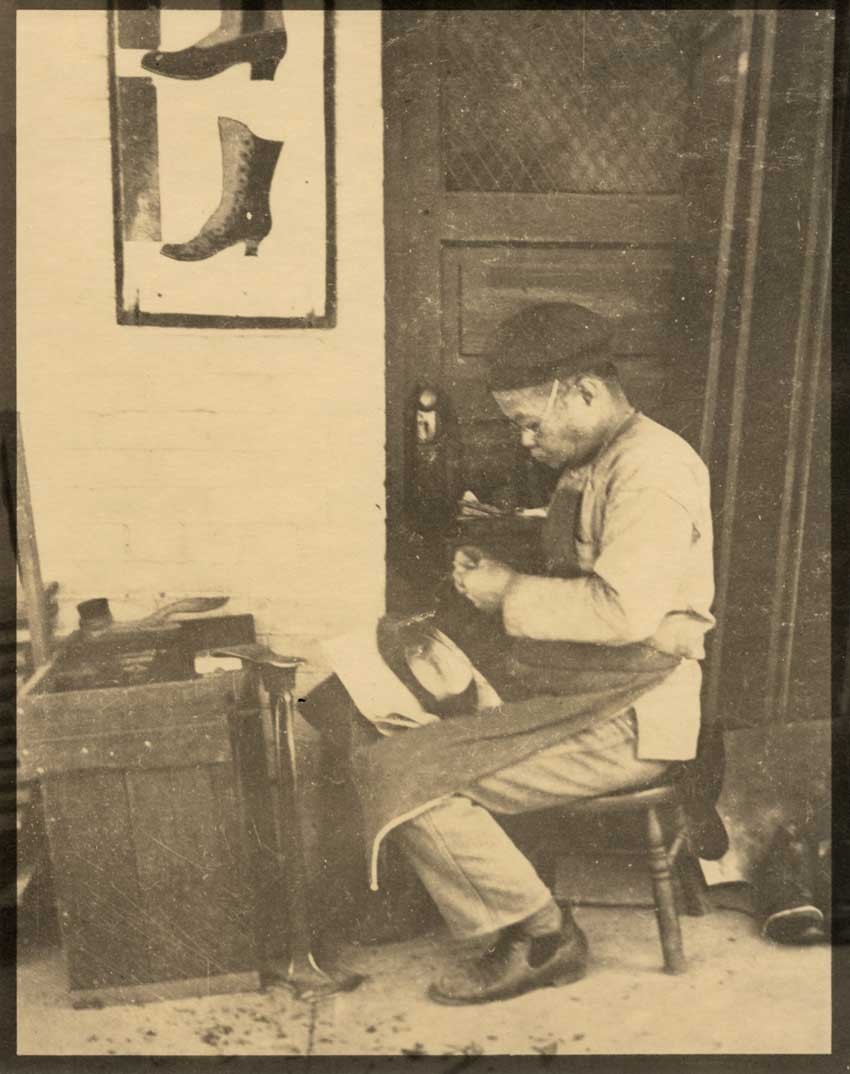 "Chinese Cobbler": San Francisco Chinatown: Sigismund Blumann: American: ca. 1901, printed early 1920s: gelatin silver print- app. 8 7/8 x 7.0": variant: "Shoe Mender": from California Historical Society collection: FN-34374: Photograph courtesy Thomas High
"Chinese Cobbler": San Francisco Chinatown: Sigismund Blumann: American: ca. 1901, printed early 1920s: gelatin silver print- app. 8 7/8 x 7.0": variant: "Shoe Mender": from California Historical Society collection: FN-34374: Photograph courtesy Thomas High
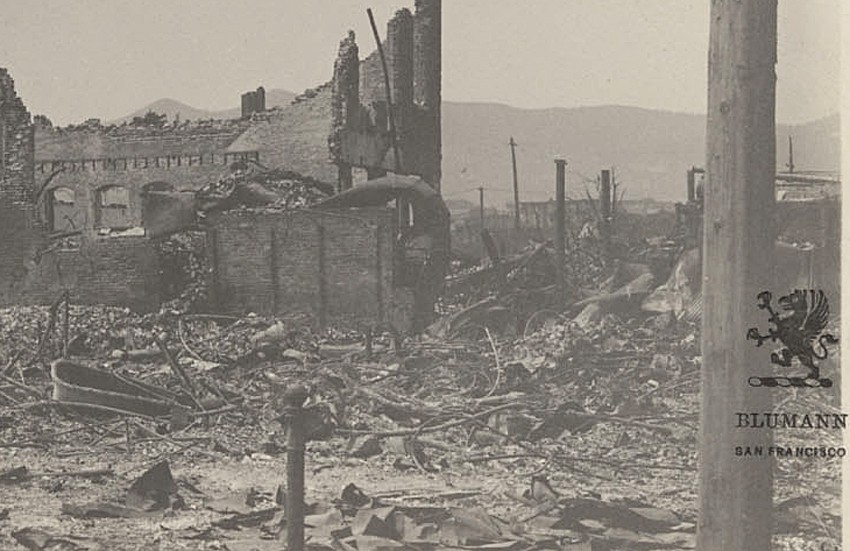 Detail: "Ruins" (San Francisco Earthquake): Sigismund Blumann: American: ca. 1906: gelatin silver print: 13.0 x 18.0 cm: overprinted with Blumann's winged griffin monogram at lower right: Photograph courtesy: California Historical Society: The 1906 San Francisco Earthquake and Fire Digital Collection: Local Call # FN-33293
Detail: "Ruins" (San Francisco Earthquake): Sigismund Blumann: American: ca. 1906: gelatin silver print: 13.0 x 18.0 cm: overprinted with Blumann's winged griffin monogram at lower right: Photograph courtesy: California Historical Society: The 1906 San Francisco Earthquake and Fire Digital Collection: Local Call # FN-33293
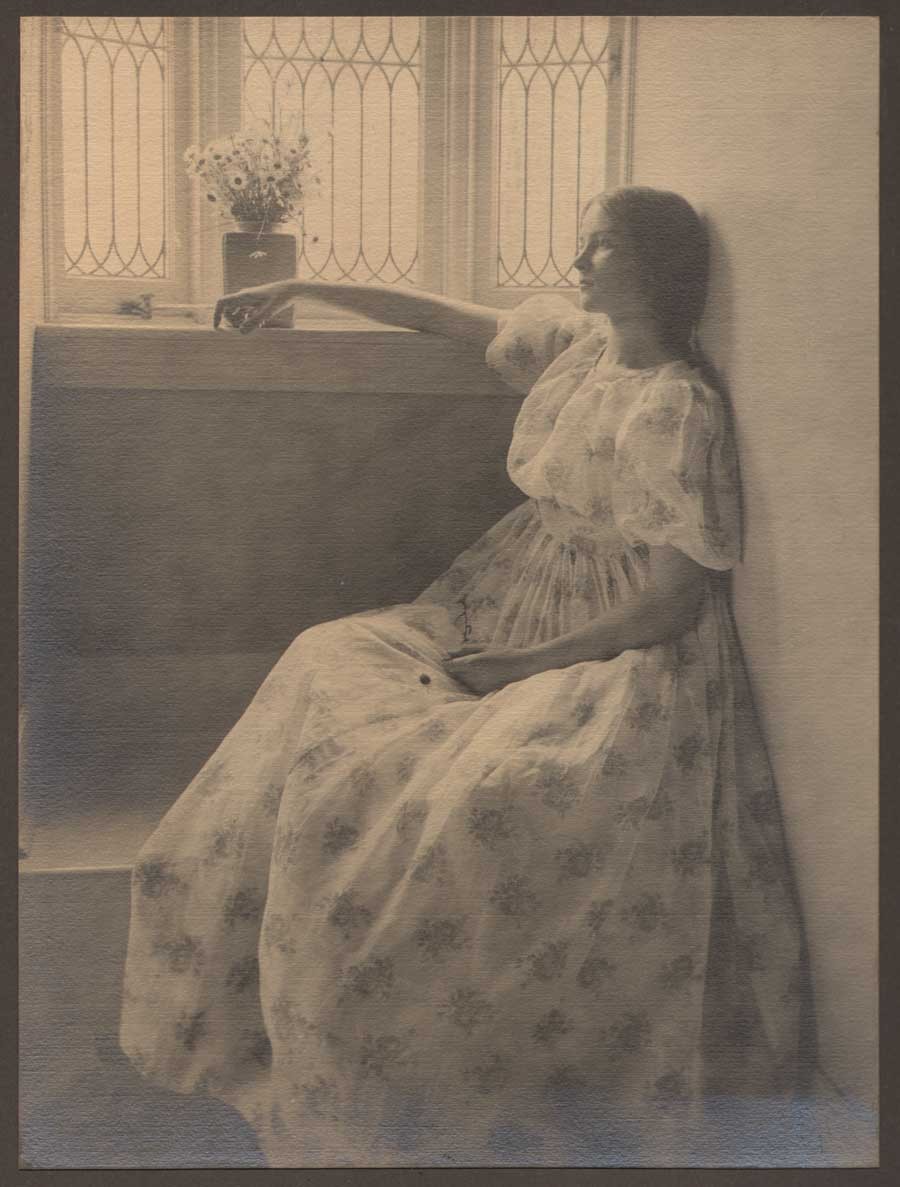 "Day Dreams" : Charles Rollins Tucker 1868-1956: American: gelatin silver print: June, 1906 printed 1915: 27.3 x 20.4 | 43.2 x 35.5 cm : First titled "Study in Home Portraiture" and published full page in the Oct. 1906 Photographic Times, this interior study later appeared as a full-page halftone in the July, 1907 Camera Craft magazine, and is a representative example of the pictorialist work that regularly appeared in its pages. Coincidentally, imagery like this was also gaining popularity during this time among amateur and professional photographers, and Sigismund Blumann was no exception, teaming up with fellow photographer Jacques Tillmany in 1907 on a part-time basis offering in-home photographic portraiture. From: PhotoSeed Archive
"Day Dreams" : Charles Rollins Tucker 1868-1956: American: gelatin silver print: June, 1906 printed 1915: 27.3 x 20.4 | 43.2 x 35.5 cm : First titled "Study in Home Portraiture" and published full page in the Oct. 1906 Photographic Times, this interior study later appeared as a full-page halftone in the July, 1907 Camera Craft magazine, and is a representative example of the pictorialist work that regularly appeared in its pages. Coincidentally, imagery like this was also gaining popularity during this time among amateur and professional photographers, and Sigismund Blumann was no exception, teaming up with fellow photographer Jacques Tillmany in 1907 on a part-time basis offering in-home photographic portraiture. From: PhotoSeed Archive
Beginnings in Word and Photography
Writing under his infrequent pen name Charles H. Fitzpatrick in Camera Craft in 1925, (3.) Sig most likely gives us a small hint of his own beginnings in photography, a passion that would soon evolve into his extensive documentation of life of San Francisco’s bustling Chinatown neighborhood in 1901. (4.) Later in this capacity as street shooter, he played the role of documentarian in the aftermath of the destruction of San Francisco in the 1906 earthquake and subsequent job as part-time portrait photographer after relocating to neighboring Oakland in 1907 due to the destruction. (5.) all while making his living as musical performer and teacher) :
Having become interested in Photography back in 1900 as an amateur with an old style Adlake plate camera, and two years later as a professional with a studio— and almost continuously since in Commercial Photography the author has had a wonderful opportunity to study composition both by experience and observation of the work of others. (6.)
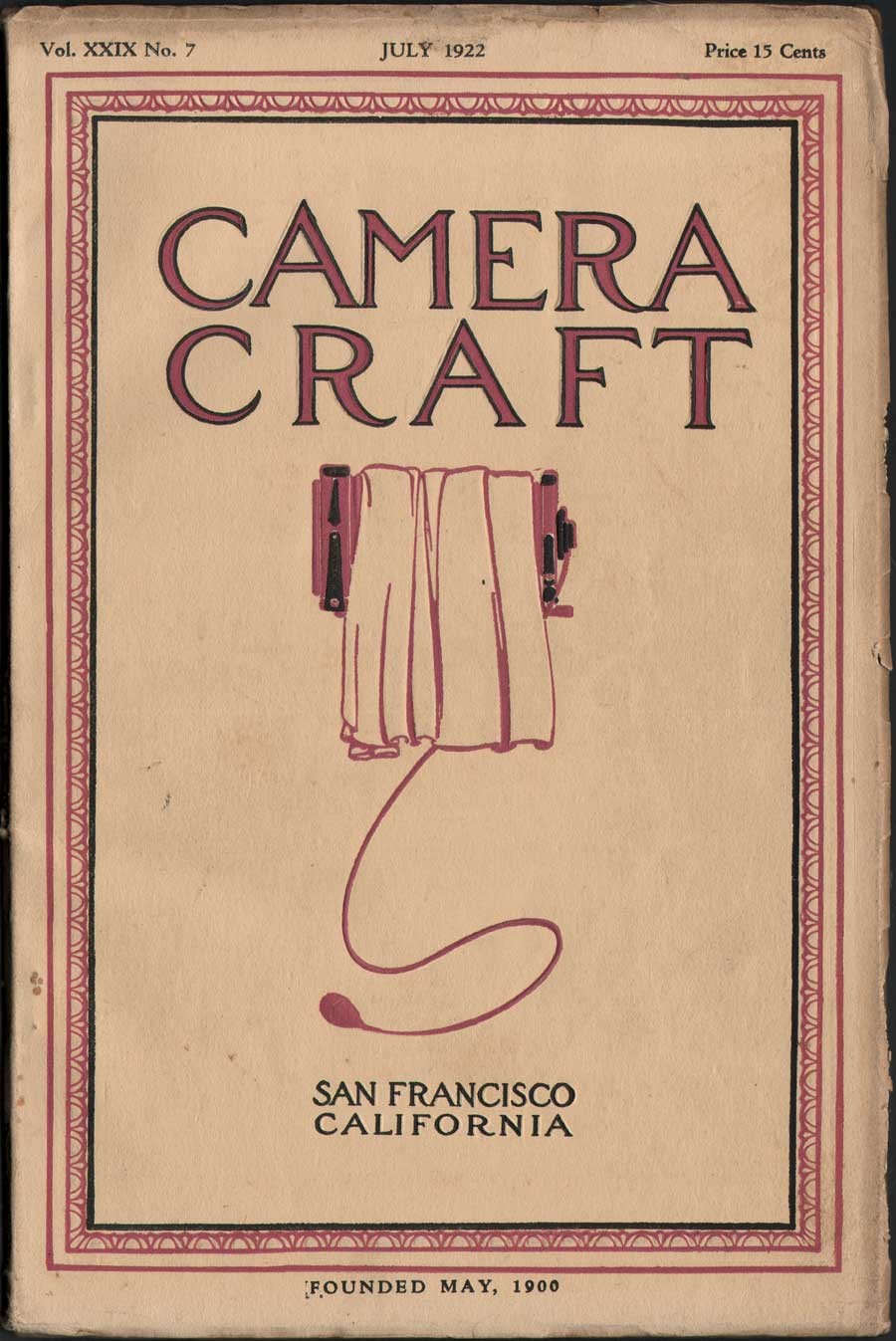 Cover Design: Camera Craft magazine: San Francisco, CA: July, 1922: 26.5 x 17.5 cm: two-color wood engraving : unknown artist and printer: cover price at upper right corner 15¢. This uncredited Camera Craft cover design first debuted with the January 1913 issue and featured a simple design of a plate camera shown in profile(lens board on right side) with dark cloth draped at center and bulb shutter release cable hanging down. This design lasted through the June, 1923 issue and was replaced with illustrations of architectural landmarks, notable western scenery and other thematic drawings done by San Francisco artist W.R. Potter through the September, 1924 issue. From: PhotoSeed Archive
Cover Design: Camera Craft magazine: San Francisco, CA: July, 1922: 26.5 x 17.5 cm: two-color wood engraving : unknown artist and printer: cover price at upper right corner 15¢. This uncredited Camera Craft cover design first debuted with the January 1913 issue and featured a simple design of a plate camera shown in profile(lens board on right side) with dark cloth draped at center and bulb shutter release cable hanging down. This design lasted through the June, 1923 issue and was replaced with illustrations of architectural landmarks, notable western scenery and other thematic drawings done by San Francisco artist W.R. Potter through the September, 1924 issue. From: PhotoSeed Archive
It was sometime in the 1890s, photographic historian Christian A. Peterson notes, that he “first used his wife’s Kodak camera to make snapshots and soon began searching the photographic periodicals for information and advice.” (7.) His editorship of Camera Craft as momentous professional occasion aside, Sig’s immersion in all things Photographic may very well have reached a high-point by 1933, the year he became a charter member of the Photographic Society of America as well as being honored a Fellow of the Royal Photographic Society.
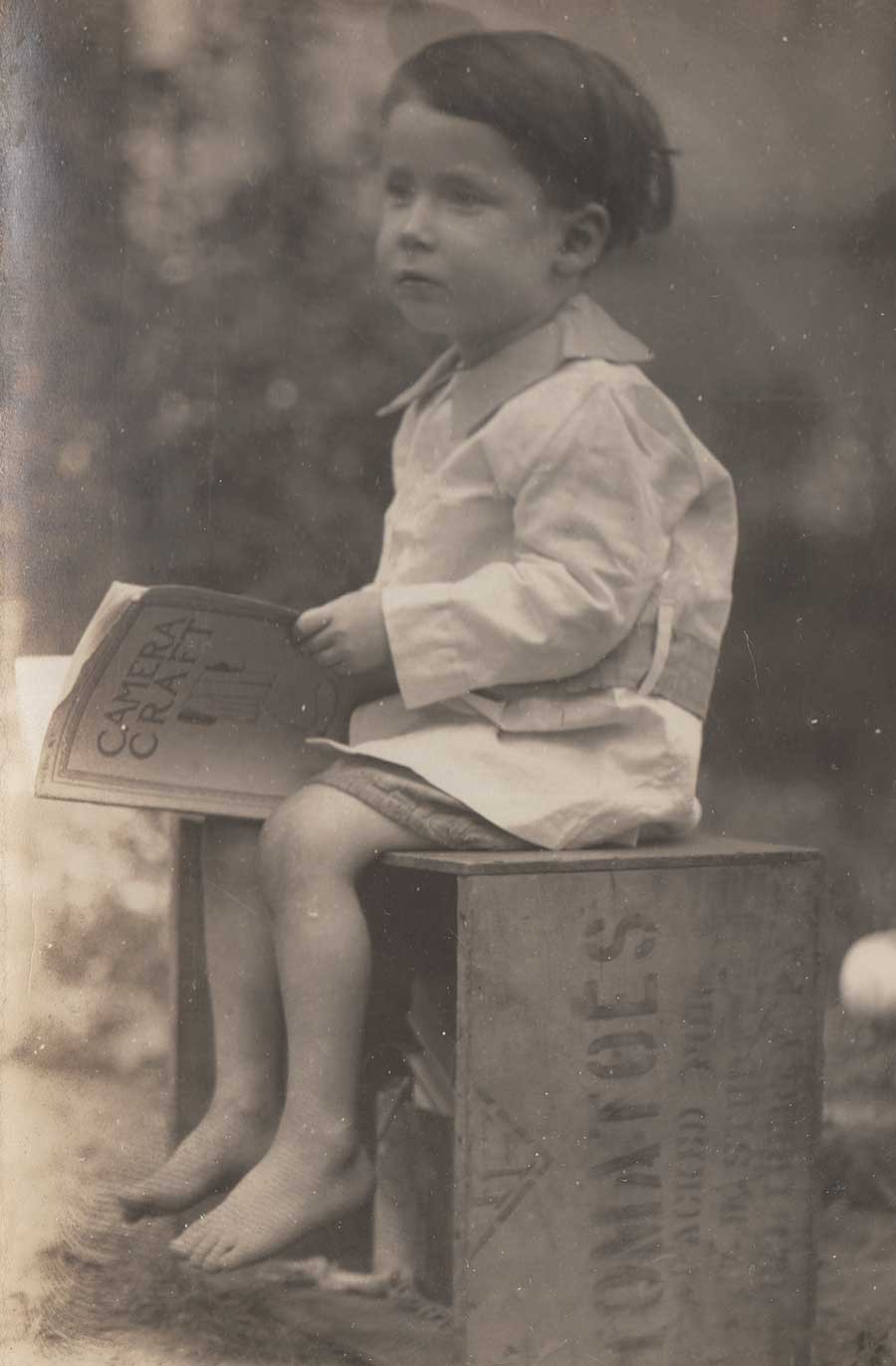 Detail: "Child Sitting on Tomato Crate Holding Camera Craft Magazine": by anonymous American photographer printed as unmailed postcard: gelatin silver print ca. 1920-25: 11.6 x 8.8 | 13.8 x 8.8 cm: written in graphite on verso: "with Love. Ellsworth" with the name "Walter" opposite address field. Child sits on crate stenciled on side as being from Pennsylvania-indicated "Packed For….PA " on side, with photo purchased from Parma, MI collector. From: PhotoSeed Archive
Detail: "Child Sitting on Tomato Crate Holding Camera Craft Magazine": by anonymous American photographer printed as unmailed postcard: gelatin silver print ca. 1920-25: 11.6 x 8.8 | 13.8 x 8.8 cm: written in graphite on verso: "with Love. Ellsworth" with the name "Walter" opposite address field. Child sits on crate stenciled on side as being from Pennsylvania-indicated "Packed For….PA " on side, with photo purchased from Parma, MI collector. From: PhotoSeed Archive
Photography in itself however was not his only reason for being during his professional career as editor, and even earlier as a musician. This was because Sig was a romantic at heart, a dreamer who had a great fondness for language, and the will to commit it to paper. Starting out for example, only in his early 20’s, he composed the following poem for the April, 1895 issue of the California-based magazine Overland Monthly:
PLEASURE.
PLEASURE is like perfect liquor,
Sweet to taste and after taste,
And like, too, in that when gotten
We imbibe too much, then waste,
And we find when pleasure passes
Life is empty as the glasses.
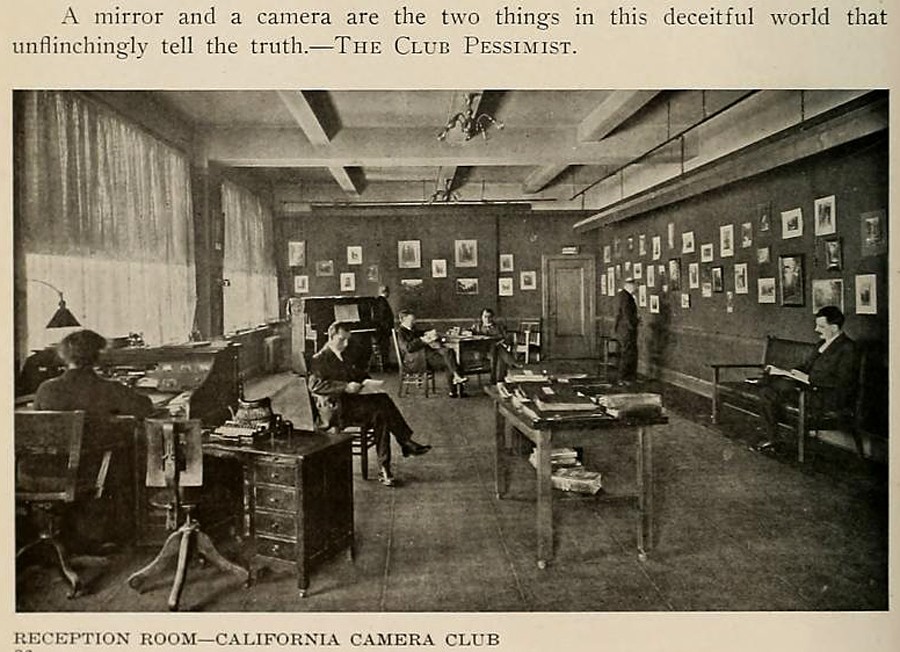 "Reception Room— California Camera Club": 1914: taken by an unknown photographer, this image appeared as a halftone illustration in the February, 1914 issue of Camera Craft for a story on the club, founded in 1890. At the time this appeared the club was located at 833 Market Street in San Francisco. The scene shows members seated with an exhibit of photographs on display at rear and on wall at right. Camera Craft regularly featured news of this important club, and future editor of the magazine Sigismund Blumann, although not a member, attended and was an occasional speaker. Photographic historian Christian A. Peterson notes Blumann spoke at this club in 1916 and much later, between 1934-40 attended gatherings here as well as at the Leica Club of Oakland, East Bay Camera Club, Golden Gate Miniature Camera Club, Photographic Society of San Francisco, San Jose Camera Club, and Western Amateur Camera Conclave. From: California State Library: Archive.org
"Reception Room— California Camera Club": 1914: taken by an unknown photographer, this image appeared as a halftone illustration in the February, 1914 issue of Camera Craft for a story on the club, founded in 1890. At the time this appeared the club was located at 833 Market Street in San Francisco. The scene shows members seated with an exhibit of photographs on display at rear and on wall at right. Camera Craft regularly featured news of this important club, and future editor of the magazine Sigismund Blumann, although not a member, attended and was an occasional speaker. Photographic historian Christian A. Peterson notes Blumann spoke at this club in 1916 and much later, between 1934-40 attended gatherings here as well as at the Leica Club of Oakland, East Bay Camera Club, Golden Gate Miniature Camera Club, Photographic Society of San Francisco, San Jose Camera Club, and Western Amateur Camera Conclave. From: California State Library: Archive.org
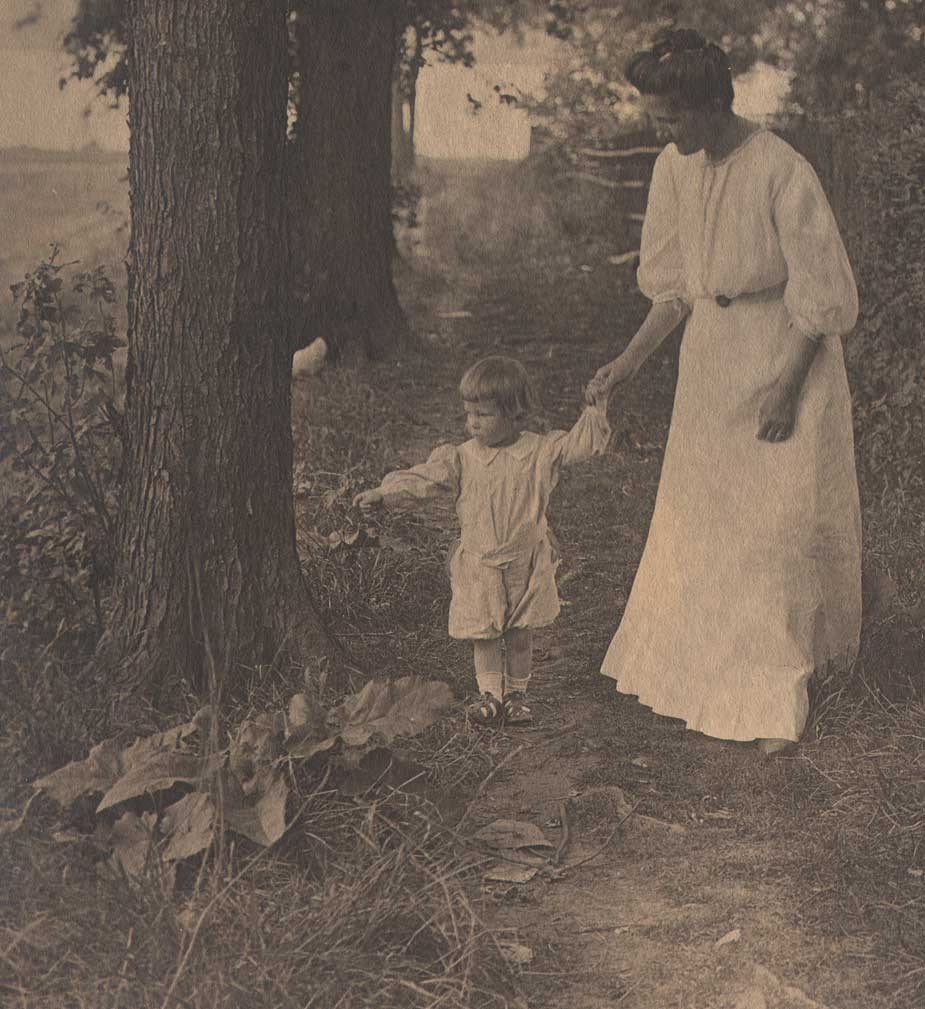 Detail: "Up the Path": Chester Moulton Whitney: American, b. 1873: 1914 or earlier: gelatin silver print: 24.8 x 19.3 cm: This photograph was illustrated as a full-page halftone with printed ornamental Art-Nouveau frame border in the August, 1914 Camera Craft, p. 422, and is a representative example of the pictorialist work that regularly appeared in its pages. From: PhotoSeed Archive
Detail: "Up the Path": Chester Moulton Whitney: American, b. 1873: 1914 or earlier: gelatin silver print: 24.8 x 19.3 cm: This photograph was illustrated as a full-page halftone with printed ornamental Art-Nouveau frame border in the August, 1914 Camera Craft, p. 422, and is a representative example of the pictorialist work that regularly appeared in its pages. From: PhotoSeed Archive
Wearing the hat of Poet-in-Residence at Camera Craft, Sig never neglected this early love of poetry for the publication, often combining his own photographic efforts alongside original compositions. One example, which he titled Lugubrio, though technically not even a real word, appeared in April, 1927, and was his way of simply assigning a mournful, or lugubrious meaning to his own photograph depicting jagged rocks and crashing waves-seen in his dramatic coastal landscape most likely taken on the Pacific coast:
LUGUBRIO
By Sigismund Blumann
The drowned and dead, now turned to stone,
Stand watching by the shore
And you may hear them through the night,
From set of sun to morning light,
As they shall do for evermore,
Weep as they watch, and moan. (p. 177)
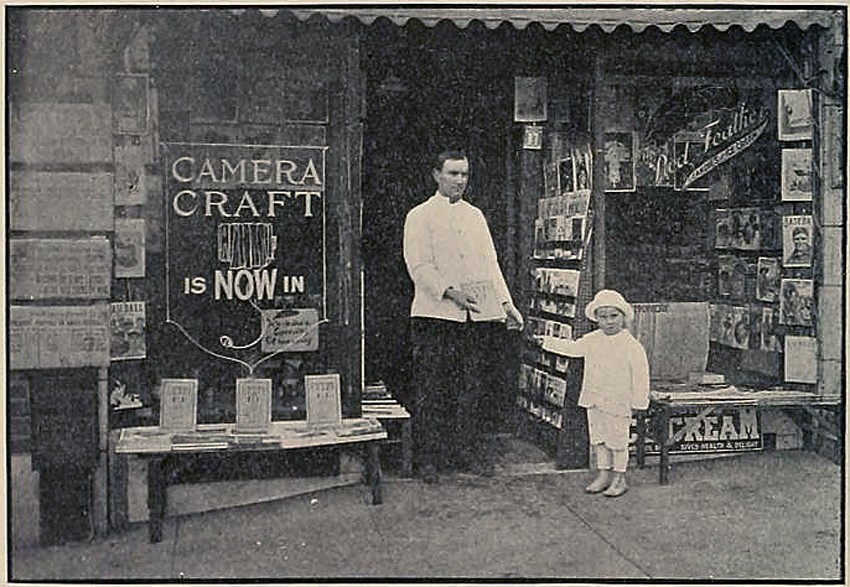 "Camera Craft is Now In": 1914: taken by an unknown photographer and used as a form of soft advertising, this image appeared as a halftone illustration in the June, 1917 issue of Camera Craft. It shows San Francisco business owner J.F. Brandert, owner of the Red Feather Store at 435 Jones Street, handing off a copy of the journal to a young visitor, with a display of three issues propped up on a bench at left in front of a window lettered with a graphic of the journal's cover: "CAMERA CRAFT IS NOW IN". From: California State Library: Archive.org
"Camera Craft is Now In": 1914: taken by an unknown photographer and used as a form of soft advertising, this image appeared as a halftone illustration in the June, 1917 issue of Camera Craft. It shows San Francisco business owner J.F. Brandert, owner of the Red Feather Store at 435 Jones Street, handing off a copy of the journal to a young visitor, with a display of three issues propped up on a bench at left in front of a window lettered with a graphic of the journal's cover: "CAMERA CRAFT IS NOW IN". From: California State Library: Archive.org
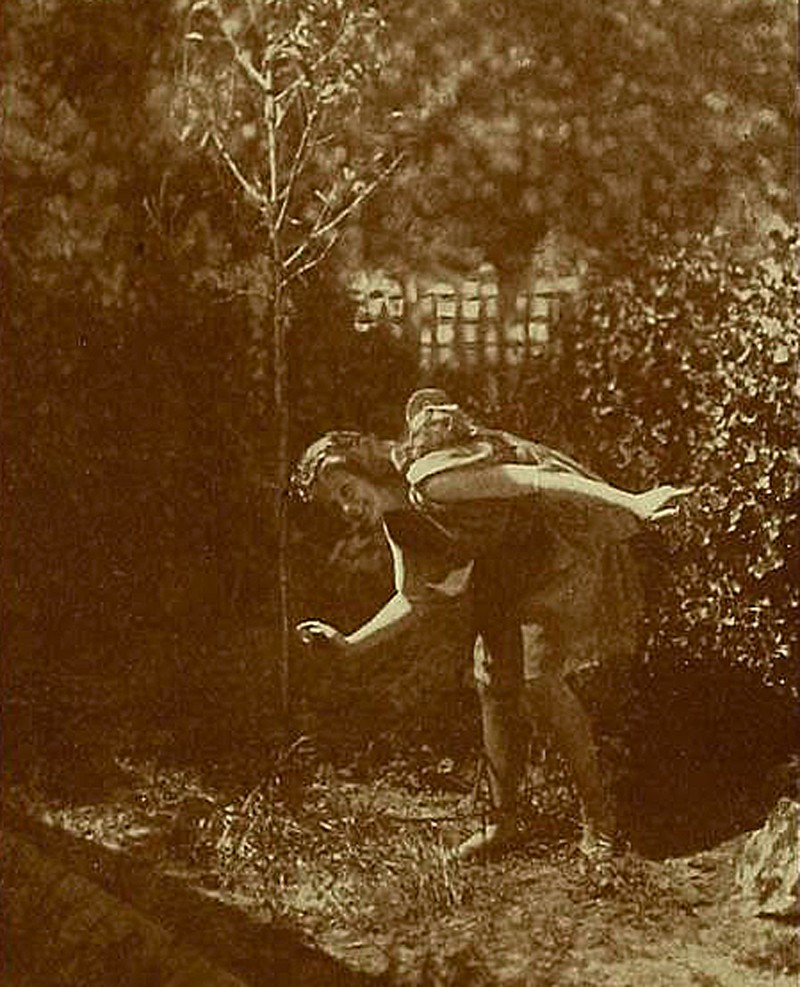 "When From Behind the Moondipt Bush Titania Floated in a Silver Haze": 1917 or before: Sigismund Blumann, American: This photograph was used as the frontis halftone for the July, 1917 issue of Camera Craft helping to illustrate the article "Poetry and Photography" written by Blumann. The photo shows Vera Hahn, a childhood friend of his eldest daughter Ethel Blumann. (b. 1902) He said of the photo: "She was costumed for a pageant and we all wanted a memento of the charming vision she made in our garden, among the green plants." This early example of Blumann's work also included one of his original poems titled "To Childhood": the first stanza: "Oh blessed youth! When from the enchanted page | Fancy stepped forth and made the unreal real, | When from behind the moondipt bush | Titania floated in a silver haze and greeted me! From: California State Library: Archive.org
"When From Behind the Moondipt Bush Titania Floated in a Silver Haze": 1917 or before: Sigismund Blumann, American: This photograph was used as the frontis halftone for the July, 1917 issue of Camera Craft helping to illustrate the article "Poetry and Photography" written by Blumann. The photo shows Vera Hahn, a childhood friend of his eldest daughter Ethel Blumann. (b. 1902) He said of the photo: "She was costumed for a pageant and we all wanted a memento of the charming vision she made in our garden, among the green plants." This early example of Blumann's work also included one of his original poems titled "To Childhood": the first stanza: "Oh blessed youth! When from the enchanted page | Fancy stepped forth and made the unreal real, | When from behind the moondipt bush | Titania floated in a silver haze and greeted me! From: California State Library: Archive.org
Camera Craft: Western Photographic Journal
Although he’d been a contributor to its’ pages in words and photos after the first decade of being founded, it would be 24 years from the journal’s 1900 founding until Sig would begin to establish an enduring legacy in the history of photography via his role as Editor-in-Chief of Camera Craft. Some historical background on the intents and purposes for this ground-breaking publication are in order.
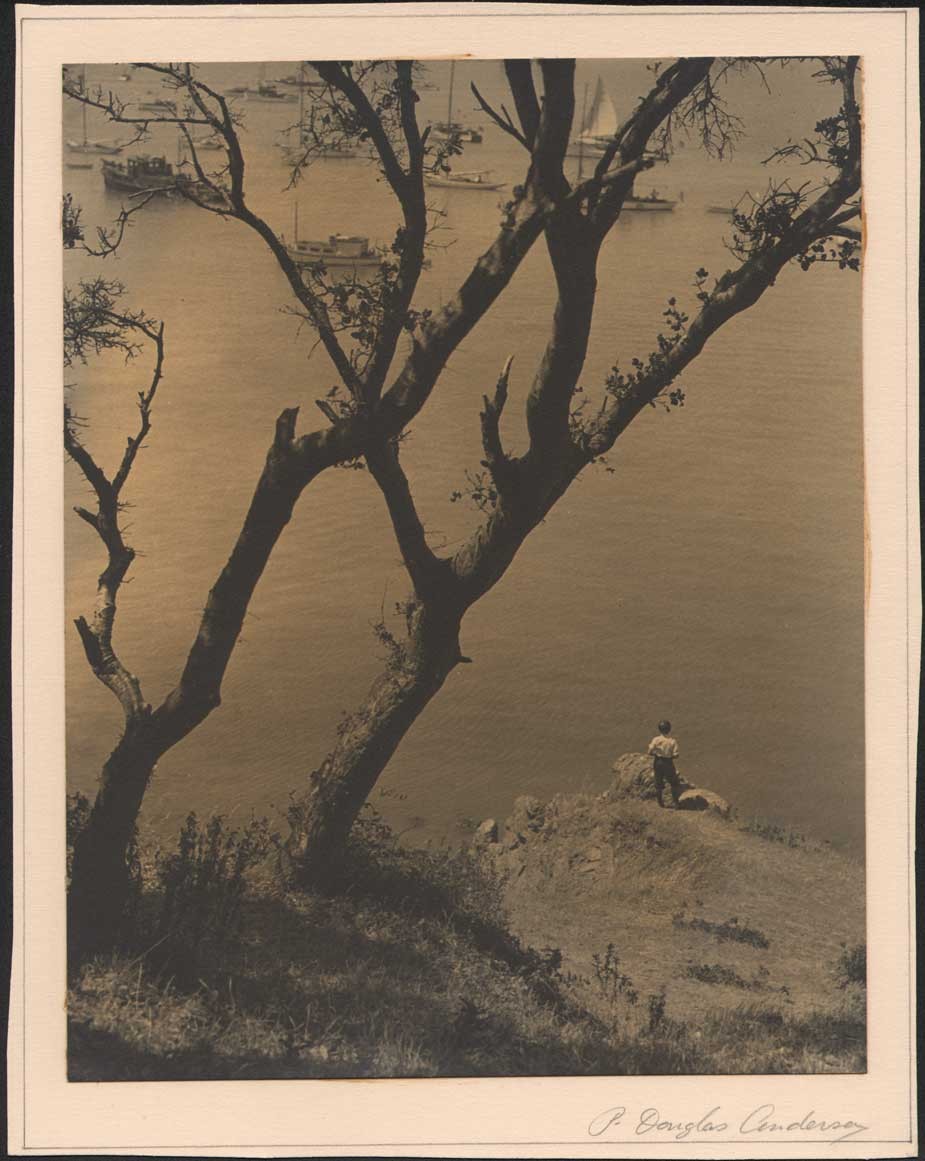 "Boy Looking out onto Bay" (San Francisco?-title supplied by this archive): ca. 1920-25: Paul Douglas Anderson, American 1887-1964: toned bromide or gelatin silver print: 24.2 x 19.0 | 27.5 x 21.6 cm: P. Douglas Anderson was an associate editor of Camera Craft beginning in May, 1923 & became editor-in-chief by January, 1924, continuing through the July issue. He was replaced by Sigismund Blumann the following month. Active in photography between 1910-1940's, Anderson was a member of the Camera Pictorialists of Los Angeles and Pictorial Photographers of America. From: PhotoSeed Archive
"Boy Looking out onto Bay" (San Francisco?-title supplied by this archive): ca. 1920-25: Paul Douglas Anderson, American 1887-1964: toned bromide or gelatin silver print: 24.2 x 19.0 | 27.5 x 21.6 cm: P. Douglas Anderson was an associate editor of Camera Craft beginning in May, 1923 & became editor-in-chief by January, 1924, continuing through the July issue. He was replaced by Sigismund Blumann the following month. Active in photography between 1910-1940's, Anderson was a member of the Camera Pictorialists of Los Angeles and Pictorial Photographers of America. From: PhotoSeed Archive
First based in San Francisco at 120 Sutter Street and issued monthly by the Camera Craft Publishing Company under the direction of editor W.G. Woods, the photographic journal Camera Craft was founded on the principles the West Coast of the United States should have an equal geographical mouthpiece of influence to counter that of the East Coast in promoting photography-for both professional and amateur workers. (to this end a separate page was devoted monthly to the happenings of many California amateur clubs) For the first issue of May, 1900, the following observations and arguments were made by the journal in support of these ideals:
The growth of photography, the introduction of simplifying methods in scientific picture-making, during the past twenty-five years is one of the wonders of the century. The phenomenal strides made by the photographic inventors of the world, resulting in the production of simple devices and convenient appliances, have made photography in all of its branches an almost universal fad. The Pacific Coast, ever ready to appreciate the merits of an innovation, has kept well abreast in the steady march of progress.
The wonderful climate of California lends itself enthusiastically to the wants of the photographer. The hand of Nature has reared, in eternal beauty, scenic effects unequaled elsewhere on earth. The very atmosphere of the Far West encourages the artistic impulse of its people. With such great natural advantages it is small wonder that when the western photographer has seen fit to cross the continent to compete with the eastern brotherhood he returns with laurels upon his brow. Not less wonderful is the existence of the largest Camera Club in the world in the city of the Golden Gate.
Yet, strange as it may seem, this great class of enthusiasts, this immense body of earnest workers has never been represented by a publication worthy of its trust. The photographers of the West have for years depended upon the journals of the East for enlightenment, but have looked in vain for recognition in their columns. It is to remedy this condition that Camera Craft now makes its bow to the public.
As to the scope of Camera Craft nothing can be said; it will have to speak for itself. The only promise made is the sincere intent on the part of the publishers to improve with each succeeding issue. The one hope of the magazine is that it may be so conducted as to meet the approbation of its readers and lend its aid to the material welfare of all interested in photography, whether for pleasure or for profit. (p. 26)
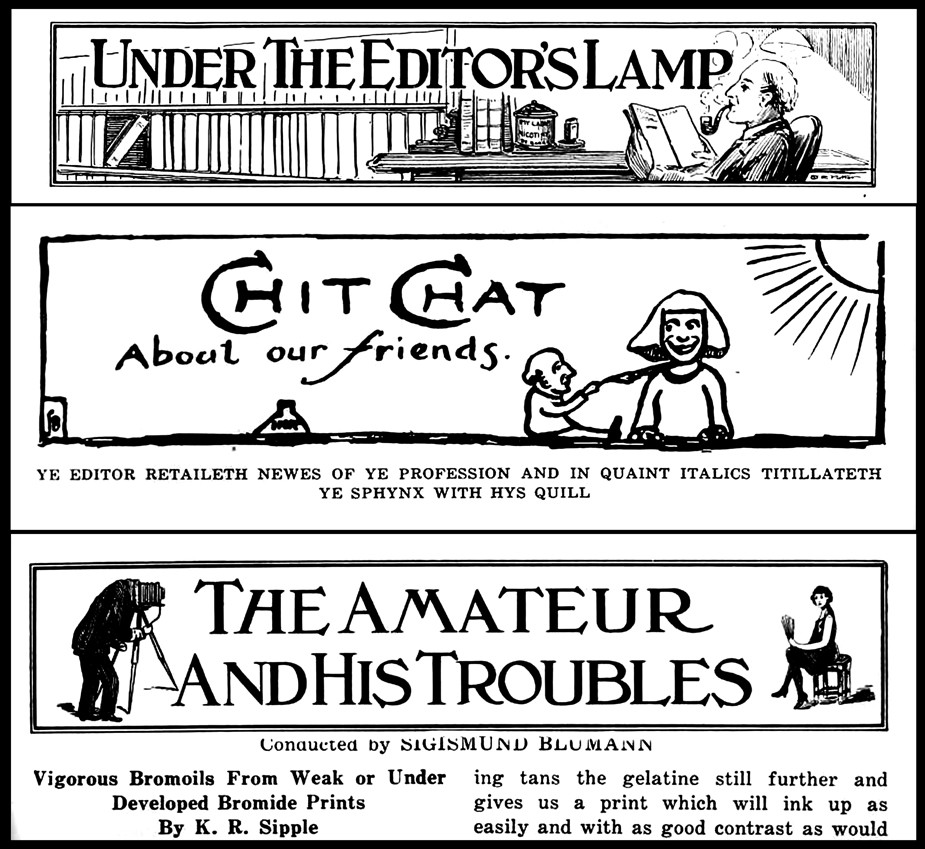 This triptych shows the three different Camera Craft magazine columns editor-in-chief Sigismund Blumann was involved with during his tenure at the journal from 1924-1933. "Under The Editor's Lamp" at top featured a caricature of the editor puffing a way on his trusty pipe while "Chit Chat About our Friends" at middle is comically subtitled "Ye Editor Retaileth Newes of Ye Profession And In Quaint Italics Titillateth Ye Sphynx With Hys Quill". "The Amateur And His Troubles", "conducted", appropriately enough by the man who had once made his living as a musician and orchestra leader, who already a feature of the publication when Blumann took over. From: PhotoSeed Archive
This triptych shows the three different Camera Craft magazine columns editor-in-chief Sigismund Blumann was involved with during his tenure at the journal from 1924-1933. "Under The Editor's Lamp" at top featured a caricature of the editor puffing a way on his trusty pipe while "Chit Chat About our Friends" at middle is comically subtitled "Ye Editor Retaileth Newes of Ye Profession And In Quaint Italics Titillateth Ye Sphynx With Hys Quill". "The Amateur And His Troubles", "conducted", appropriately enough by the man who had once made his living as a musician and orchestra leader, who already a feature of the publication when Blumann took over. From: PhotoSeed Archive
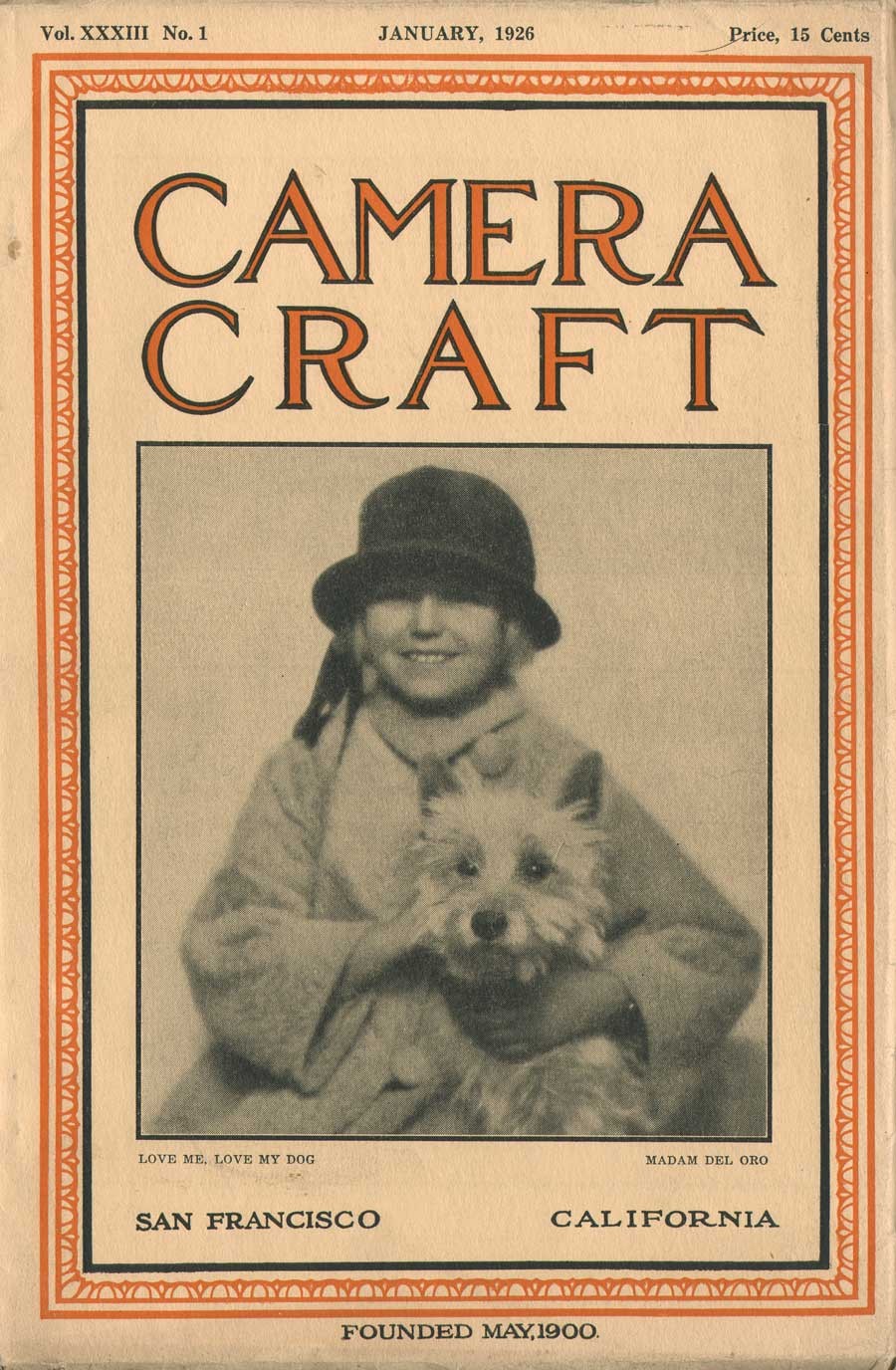 Cover Design: Camera Craft magazine: San Francisco, CA: January, 1926: Press of the Hansen Company, San Francisco: 26.5 x 17.5 cm: two-color wood engraved border design with inset halftone photograph: "Love Me, Love My Dog" by Madam Del Oro: American? 13.3 x 12.1 cm : cover price at upper right corner 15¢. One of the journal's seemingly obvious decisions, at least for the time, was to feature an actual photograph as a cover illustration for Camera Craft. Editor Blumann made this decision beginning with the October, 1924 issue. From: PhotoSeed Archive
Cover Design: Camera Craft magazine: San Francisco, CA: January, 1926: Press of the Hansen Company, San Francisco: 26.5 x 17.5 cm: two-color wood engraved border design with inset halftone photograph: "Love Me, Love My Dog" by Madam Del Oro: American? 13.3 x 12.1 cm : cover price at upper right corner 15¢. One of the journal's seemingly obvious decisions, at least for the time, was to feature an actual photograph as a cover illustration for Camera Craft. Editor Blumann made this decision beginning with the October, 1924 issue. From: PhotoSeed Archive
With its second issue for June, ambitions quickly shifted in support of the establishment of a West-Coast professional organization:
“Camera Craft intends to agitate the question of a Pacific Coast Convention of photographers. General inquiry throughout the state has led to the belief that such a convention is not only desirable but an actual need to those who make their living through the lens and shutter.” …We recall instances where photographers of this coast have attended conventions in the East and have returned with easy honors. Camera Craft would be pleased to learn of a serious consideration of the idea. A convention held in San Francisco with a first-class salon as an adjunct would undoubtedly lead to a permanent organization, and result in the advancement of the craft in a manner hitherto untried.” (p. 68)
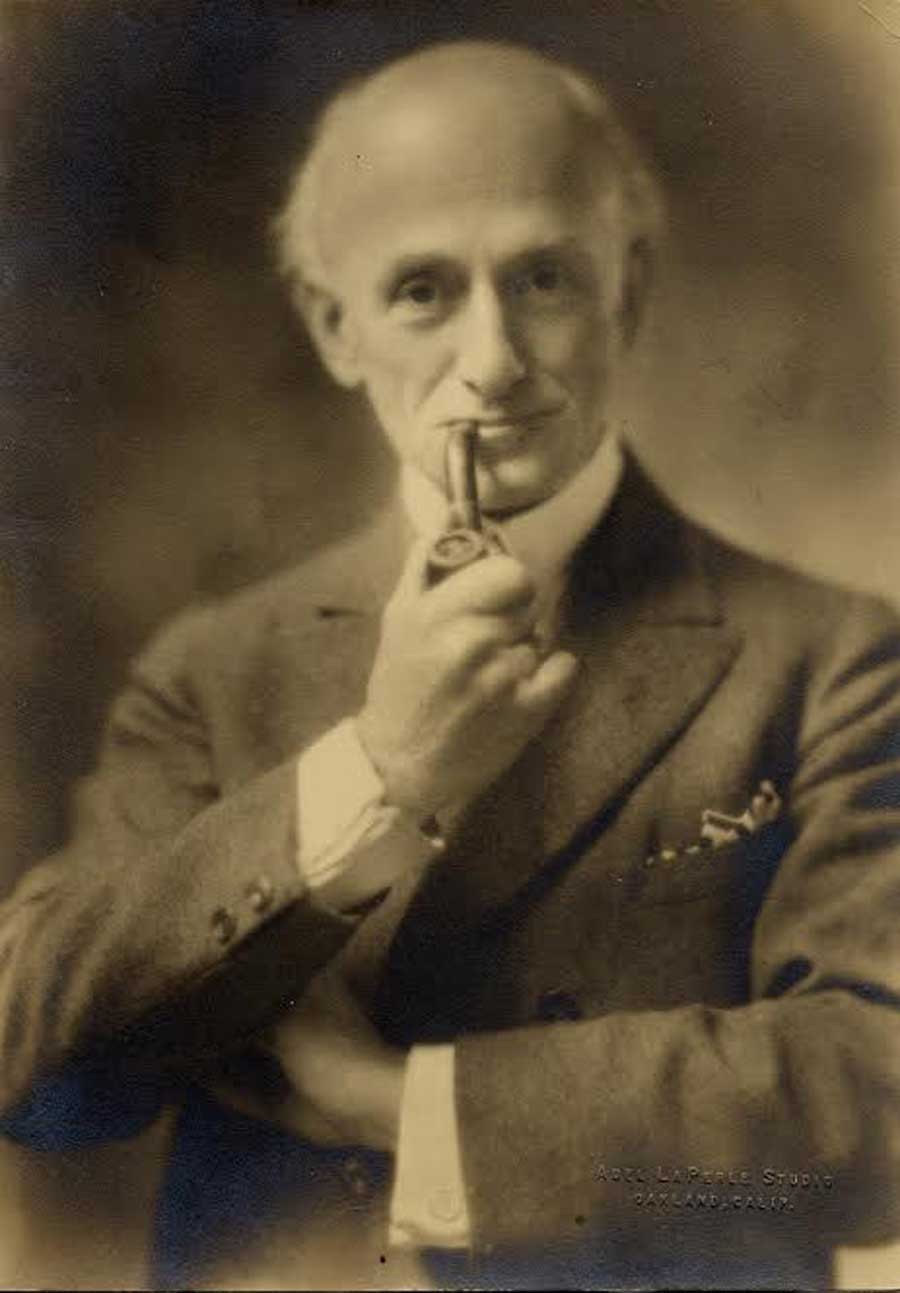 "Portrait of Sigismund Blumann": ca. 1928: Adel LaPerle Studio, Oakland, CA: gelatin silver print: Blumann was editor-in-chief of San Francisco-based Camera Craft magazine from 1924-1933: Photograph courtesy Thomas High
"Portrait of Sigismund Blumann": ca. 1928: Adel LaPerle Studio, Oakland, CA: gelatin silver print: Blumann was editor-in-chief of San Francisco-based Camera Craft magazine from 1924-1933: Photograph courtesy Thomas High
Although preceded geographically and in scope by the Pacific Coast Photographer, a short-lived monthly established in 1892 and believed to have ceased publication several years later, Camera Craft thrived as a robust Western photographic journal for the next 41 years. It first accomplished this under the capable tenure of editor Fayette J. Clute in the early decades of the publication before Sig took over in 1924, and was carried forward by him and others until the economic and human realities of World War II forced it’s hand. This occurred after the March, 1942 issue, when Camera Craft ironically headed back East so to speak, when it was absorbed by the Boston-based American Photography magazine. An editorial appearing in the final issue stated the decision to cease publishing was made because editor George Allen Young was taking his place in the armed services among other realities.
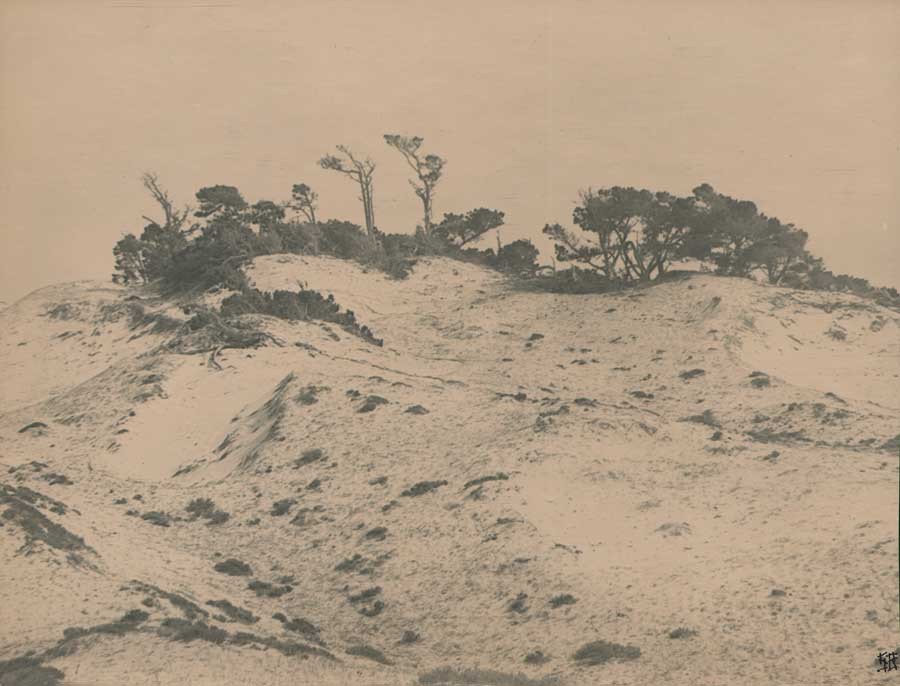 "Japonica" : Sigismund Blumann, American: ca 1920-40. gelatin silver print: 17.2 x 22.3 cm : This is a fine example of Blumann's pictorialist landscape work showing sand dunes and scrub trees, and was most likely taken on the West coast of the United States. Variants of this photograph have been similarly titled by the artist "Dune Pattern" and "Japanesque". This example signed in stylized Japanese initials at lower right corner: "SB". Three variants held by Minneapolis Institute of Arts: Accession #s: 99.230. (13-15) : From: PhotoSeed Archive
"Japonica" : Sigismund Blumann, American: ca 1920-40. gelatin silver print: 17.2 x 22.3 cm : This is a fine example of Blumann's pictorialist landscape work showing sand dunes and scrub trees, and was most likely taken on the West coast of the United States. Variants of this photograph have been similarly titled by the artist "Dune Pattern" and "Japanesque". This example signed in stylized Japanese initials at lower right corner: "SB". Three variants held by Minneapolis Institute of Arts: Accession #s: 99.230. (13-15) : From: PhotoSeed Archive
Sig As Camera Craft Editor: 1924-33
Photographic historian Christian A. Peterson, who called Camera Craft “the leading West Coast photographic monthly” and whose in-depth reassessment of Sigismund Blumann’s life and career was cited at the conclusion of Tom High’s short biography of his grandfather, called Sigismund Blumann:
”a prominent tastemaker in Californian photography during the 1920s and 1930s”. (8.)
Having an audience of 8000 monthly Camera Craft readers after coming aboard as chief editor in 1924 was surely a great start to becoming a tastemaker, but Sig proved his worth during the following nine years for his ability to impart to readers the essential knowledge of the ever-changing progress of photography. This took place in conjunction with his maintaining the vision of remaining true to himself-no matter how quirky some of his readers undoubtedly perceived him- while unashamedly promoting photographic talent in the pages of the magazine where he saw fit.
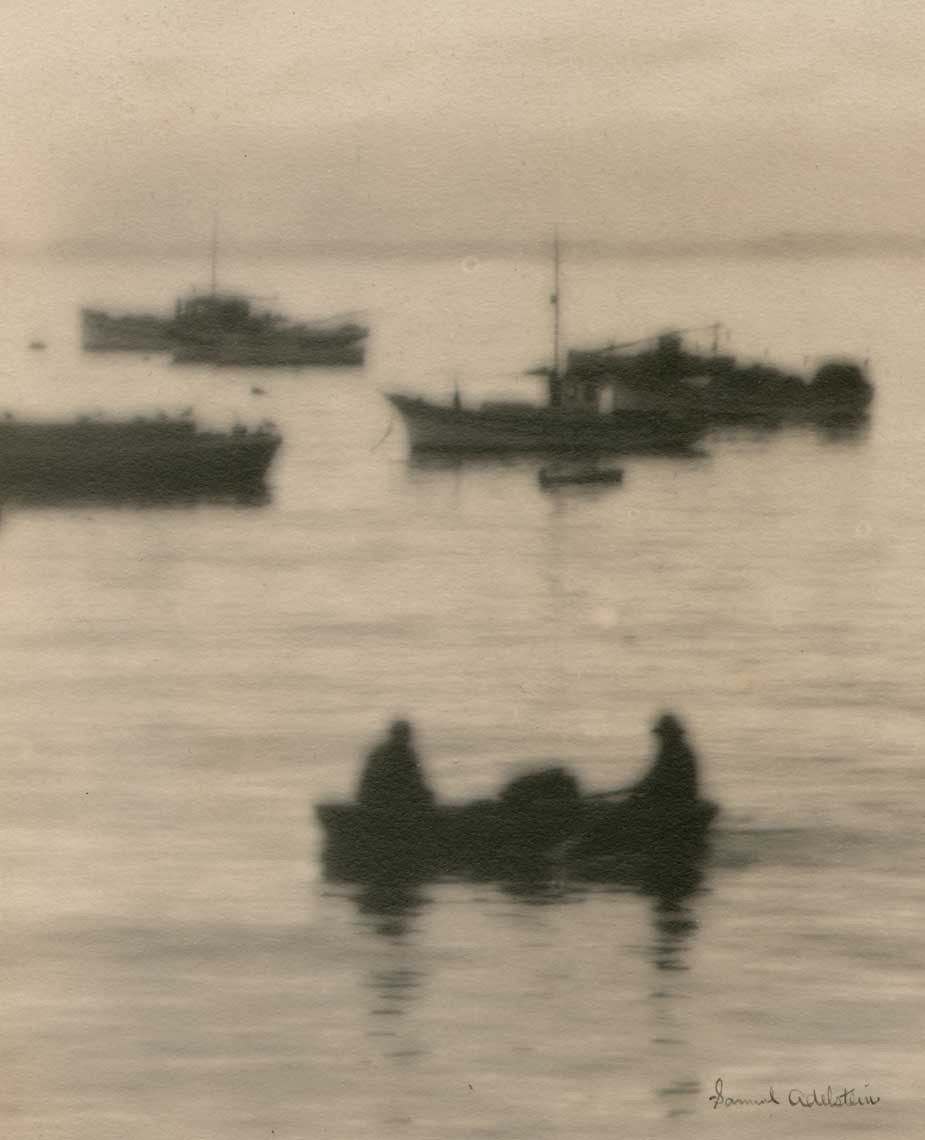 Detail: "Fishing Boats at Anchor" (probably Monterey Bay, CA) Samuel Adelstein, American, California: b. 1866?-d. 1934: silver bromide print ca. 1920-25: 18.5 x 13.6 | 40.6 x 25.4 cm: Adelstein was an active member of the California Camera Club whose pictorial works including a series of nude studies were published in Camera Craft in January, 1918 as part of the article: "An Enthusiast's Experience". The year before, the journal stated he was "an enthusiastic amateur photographer, a native son, a Director of the California Camera Club, and one of the Board of Governors of the Civic League of Improvement Clubs and Associations": Immersing himself in the art of photography around 1916, he specialized in making enlargements (from sharp negatives) with a soft-focus Verito lens. From: PhotoSeed Archive
Detail: "Fishing Boats at Anchor" (probably Monterey Bay, CA) Samuel Adelstein, American, California: b. 1866?-d. 1934: silver bromide print ca. 1920-25: 18.5 x 13.6 | 40.6 x 25.4 cm: Adelstein was an active member of the California Camera Club whose pictorial works including a series of nude studies were published in Camera Craft in January, 1918 as part of the article: "An Enthusiast's Experience". The year before, the journal stated he was "an enthusiastic amateur photographer, a native son, a Director of the California Camera Club, and one of the Board of Governors of the Civic League of Improvement Clubs and Associations": Immersing himself in the art of photography around 1916, he specialized in making enlargements (from sharp negatives) with a soft-focus Verito lens. From: PhotoSeed Archive
But some things remained the same after he took over. One, perhaps appropriate considering his musical background, was his retention of the subhead: “Conducted by Sigismund Blumann” for the journal’s long-established editorial column The Amateur And His Troubles previously edited by Paul Douglas Anderson. This time, an actual orchestra conductor was indeed stepping in to conduct editorial affairs! Keeping this personal touch intact-especially to those who knew him as someone passionate of music his entire life, was just one way of his remaining connected with readers as well as professional and social acquaintances in the Bay Area. Under Sig’s moderation, the column continued to offer advice dispensed by any number of well regarded authors who broke down and offered solutions to problems encountered by amateurs in the field relating to anything from photographic equipment to darkroom dilemmas.
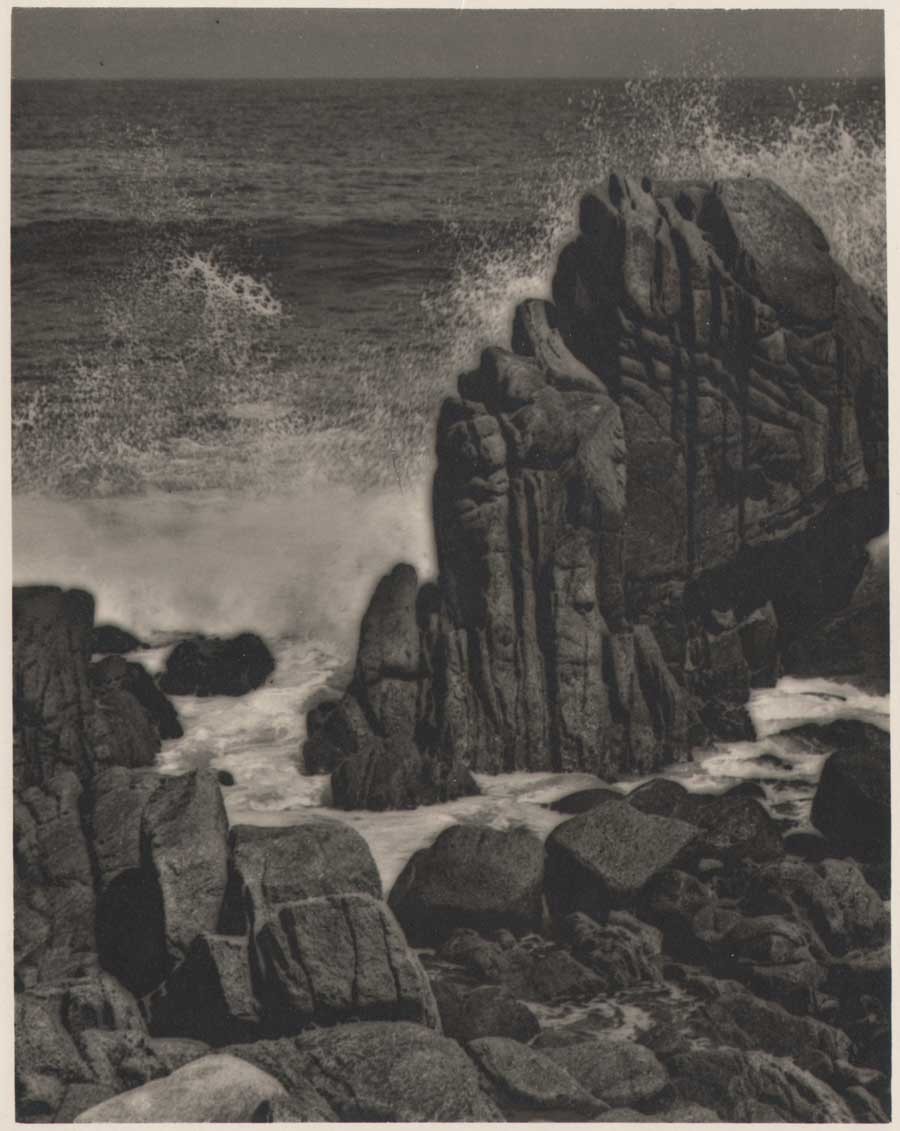 "Lugubrio": Sigismund Blumann, American: 1927 or before: gelatin silver print: 20.8 x 16.4 | 25.3 x 20.1 cm: This image, reproduced as a large halftone, was published on the same page as an accompanying poem of the same title for the April, 1927 issue of Camera Craft. The scene was most likely taken along the Pacific coastline. From: PhotoSeed Archive
"Lugubrio": Sigismund Blumann, American: 1927 or before: gelatin silver print: 20.8 x 16.4 | 25.3 x 20.1 cm: This image, reproduced as a large halftone, was published on the same page as an accompanying poem of the same title for the April, 1927 issue of Camera Craft. The scene was most likely taken along the Pacific coastline. From: PhotoSeed Archive
His second column, a new feature which debuted with the November, 1924 issue, was called CHIT CHAT About our friends. A vehicle for Sig’s effusive boosterism of photography in general, both professional and amateur, it was written in a style that might best be described, amusingly, as slightly syrupy in tone but delivered with erudition. Profiles on photographers he found interesting, and news of California camera clubs were a constant monthly feature of the column in addition to news of major upcoming exhibitions as well as critiques and results from those salons happening not only on the West Coast but throughout the United States and beyond. Comically subtitled: “Ye Editor Retaileth Newes of Ye Profession And In Quaint Italics Titillateth Ye Sphynx With Hys Quill”, the column’s “titillations” were often just longish aphorisms managing implied or direct associations to something photographic. Appearing rather infrequently at the column’s outset and disappearing altogether by August, 1931 when this inventive take on the English language was eliminated, they appeared from time to time, with several reprinted below for his January, 1926 column:
“Every time you get the best of a customer you have cheated yourself.”
“The most expensive lens may not be the best but the cheapest is pretty sure to be the worst.”
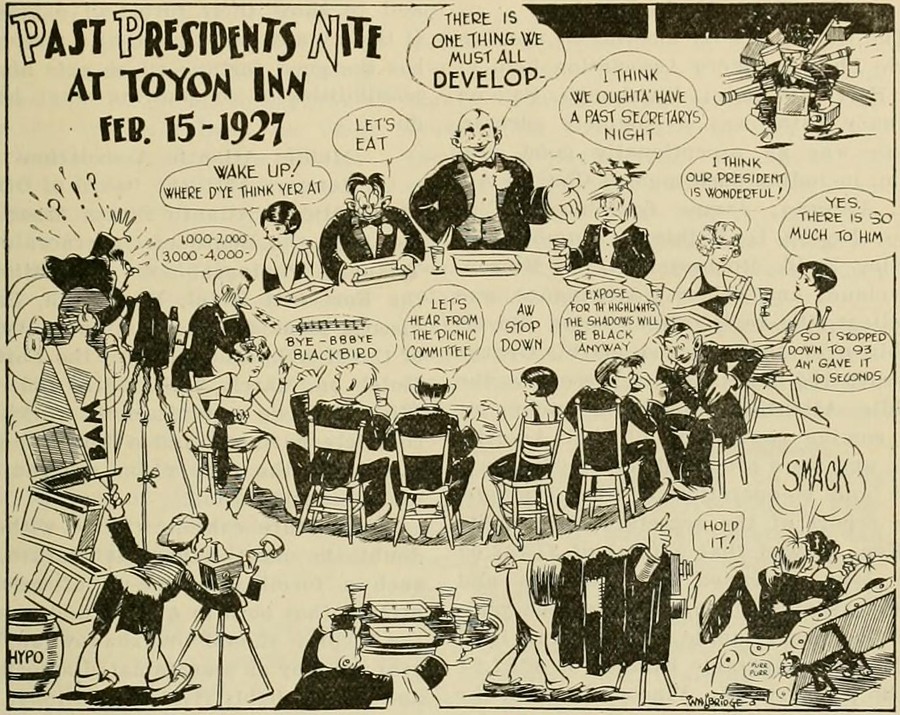 "Past Presidents Nite At Toyon Inn Feb. 15- 1927" : by artist W.A. Bridge, American -California? : Used as a halftone in the March, 1927 issue of Camera Craft, this humorous cartoon illustrated a dinner dance commemorating a gathering of past presidents of the Pacific International Photographers' Association which took place at San Leandro's Toyon Inn on Feb. 15, 1927. Sigismund Blumann, who served as host of the event, made sure to comment in the pages of Camera Craft magazine that "refreshments" of a most unusual kind: ie: inebriating, were served at the event during the era of American Prohibition. From: California State Library: Archive.org
"Past Presidents Nite At Toyon Inn Feb. 15- 1927" : by artist W.A. Bridge, American -California? : Used as a halftone in the March, 1927 issue of Camera Craft, this humorous cartoon illustrated a dinner dance commemorating a gathering of past presidents of the Pacific International Photographers' Association which took place at San Leandro's Toyon Inn on Feb. 15, 1927. Sigismund Blumann, who served as host of the event, made sure to comment in the pages of Camera Craft magazine that "refreshments" of a most unusual kind: ie: inebriating, were served at the event during the era of American Prohibition. From: California State Library: Archive.org
Lastly, and most importantly, one of the most personal reasons for Camera Craft’s success under Sig was his entirely self-written Under the Editor’s Lamp column, debuting with the April, 1926 issue. Already a fixture by means of the pen to his many readers-in prose as well as poetry- the column gave a final say so to speak to his personal views-conservative to be sure-on just about anything going on regarding photography and musings on current events. With accompanying column artwork by California artist W.R. Potter portraying Sig kicking back while puffing his pipe and seated at a library desk, the column became an effective way for this journal’s Editor-in-Chief to assume the role of oracle and brand ambassador. Sig’s short forward for his first Under the Editor’s Lamp :
When the desk is cleared of paste-pot and shears and the lamp is lit, it is good to put a match to the freshly loaded, old pipe and take a puff or two, letting the mind’s mind relax into mere dreams. The lamp is a sentimental fiction, of course, being a standardized glass bowl with a bulb glowing through, but the pipe is real, the mood is sincere, and we hope the mind exists, more or less.
Out go our thoughts to readers unseen, perhaps never to be met except as a large, critical, voracious body of men and women who consume the forty-eight pages of pictures and text and off-hand decide the fare has been very good, fair, or rotten. Little do they care what labor, what hopes, what ambitions went into every line and every illustration. Why should they. The best is no better than their due. (p.180)
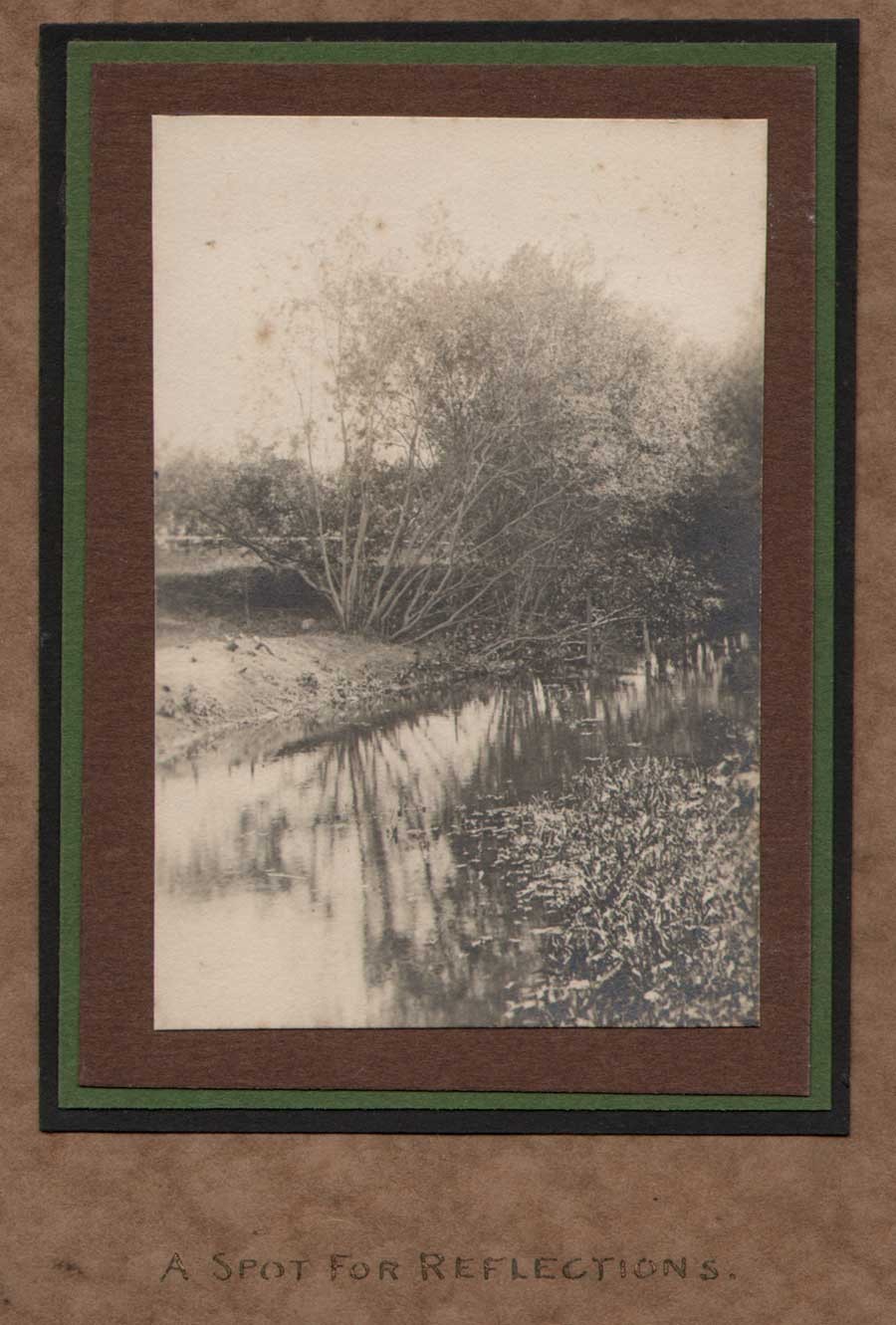 "A Spot for Reflections": Sigismund Blumann, American: ca. 1925-30: gelatin silver print : 9.8 x 6.5 | 18.2 x 14.5 cm : perhaps taken in Oakland or the Inverness area of Marin County, CA, this is a fine example of Blumann's pictorialist work in which he has titled the composition in gold lettering and triple-mounted the image onto fine art paper supports. From: PhotoSeed Archive
"A Spot for Reflections": Sigismund Blumann, American: ca. 1925-30: gelatin silver print : 9.8 x 6.5 | 18.2 x 14.5 cm : perhaps taken in Oakland or the Inverness area of Marin County, CA, this is a fine example of Blumann's pictorialist work in which he has titled the composition in gold lettering and triple-mounted the image onto fine art paper supports. From: PhotoSeed Archive
M.Q. Developer to Develop Good Feeling
Because Camera Craft billed itself the official organ of the Pacific International Photographers’ Association, (PIPA) with owner Ida M. Reed acting as Secretary and headquartered in the same San Francisco offices as the journal, (703 Market in Claus Spreckles Building) news of the Association-which covered a wide western geographic area including membership from Alaska, Alberta, Arizona, British Columbia, California, the Hawaiian Islands, Idaho, Montana, Nevada, Oregon, Utah and Washington states- became a regular monthly feature of the previously discussed Chit-Chat column. By 1927, Sig was hitting full-stride at Camera Craft, his writing skills undoubtedly honed through his reminisces featured in the Editor’s Lamp column.
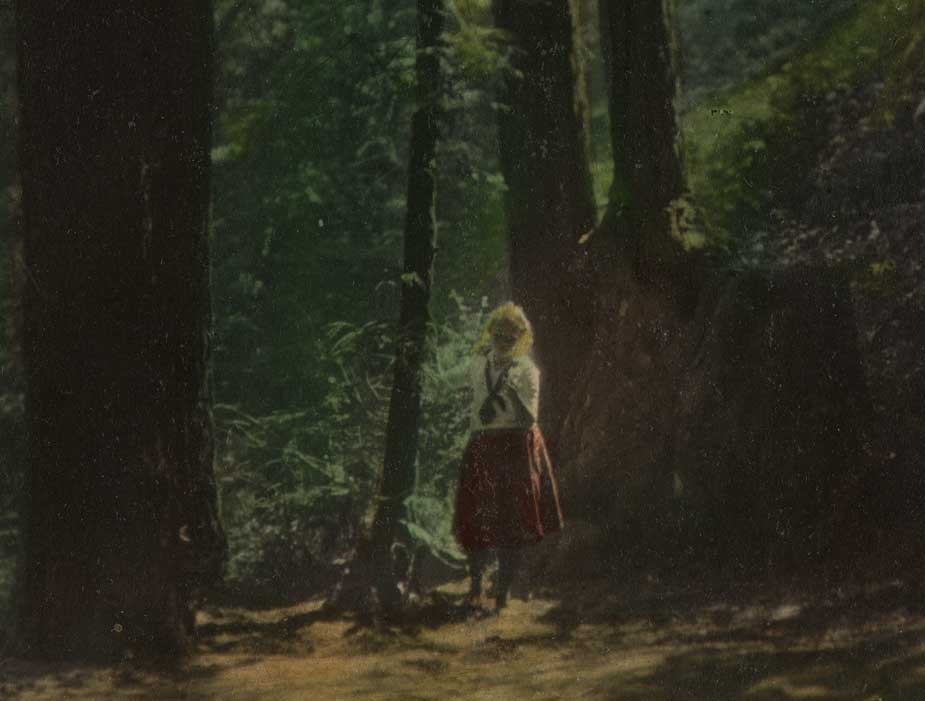 Detail: "Vera in the Woods": Sigismund Blumann, American: 1920-25: hand-colored gelatin silver print: 24.2 x 18.6 cm: Taken among a stand of Redwood trees, perhaps in the present-day Muir Woods National Monument in Marin County, CA, the subject of this photograph is believed to show the photographer's youngest daughter Vera Blumann, b. 1911. Blumann was in love with the outdoors, and frequently took part in extended camping trips with family members to hike and photograph areas of beauty in California and the Pacific Northwest-trips he wrote about in the pages of Camera Craft. See variant: Minneapolis Institute of Arts: Accession #99.231.15. From: PhotoSeed Archive
Detail: "Vera in the Woods": Sigismund Blumann, American: 1920-25: hand-colored gelatin silver print: 24.2 x 18.6 cm: Taken among a stand of Redwood trees, perhaps in the present-day Muir Woods National Monument in Marin County, CA, the subject of this photograph is believed to show the photographer's youngest daughter Vera Blumann, b. 1911. Blumann was in love with the outdoors, and frequently took part in extended camping trips with family members to hike and photograph areas of beauty in California and the Pacific Northwest-trips he wrote about in the pages of Camera Craft. See variant: Minneapolis Institute of Arts: Accession #99.231.15. From: PhotoSeed Archive
The following account is a result of this, of Sig’s prodigious social engagement with members active in the Bay-area camera club scene. In a humorous yet telling example of his own admission to preserve the rightful history of one particular PIPA (often referred to as a club) meeting for Chit-Chat, the March, 1927 issue duly reported on the Past Presidents Night dinner dance at San Leandro’s Toyon Inn on Feb. 15, 1927. Taking place when Prohibition was still the law of the land in America, (9.) Sig’s account made sure to include the lengths employed at the soirée in order for those attending to enjoy the social, and inebriating benefits of some “liquid cheer”:
But hold, before we close it must be chronicled as it shall be inscribed in the archives of the club that each guest found a developing tray and two glass graduates before him. It was a paper tray, so that when dropped the falling tray might not raise the deuce. In one of the two ounce graduates water was served and in the other M.Q. developer to develop good feeling. A bucket of Hypo was kept in the ante-room to fix the police, and everything was provided to make a perfect picture except bromide. If any was needed it was the next morning. (p. 145: M.Q. was an alkaline developer for gelatine emulsions combining Metol and hydroquinone)
 "Yosemite Falls | Yosemite Valley": Sigismund Blumann, American: dated 1926 & signed: "Dry Point Etching" ie: most likely a Kallitype or bleached and toned print on Vitava E (tching) chlorobromide paper: 13.1 x 9.0 | 23.7 x 16.5 cm: A specialist in alternative darkroom processes, particularly Kallitype, Blumann perfected his "Dry Point Etching" process and described it in lengthy articles in Camera Craft in 1925 and later in July, 1934 for his own Photo Art monthly using the pen name "Charles H. Fitzpatrick." This finished etching showing Yosemite Falls was originally taken as a photograph by Blumann in the Spring of 1925. Both photo and etching were illustrated side-by-side as halftones in the October, 1925 Camera Craft article titled "Making Photographs Into Dry Point Etchings". See the following citation at end of this caption in Notes field for a working description of the "Dry Point Etching" process. (11.) From: PhotoSeed Archive
"Yosemite Falls | Yosemite Valley": Sigismund Blumann, American: dated 1926 & signed: "Dry Point Etching" ie: most likely a Kallitype or bleached and toned print on Vitava E (tching) chlorobromide paper: 13.1 x 9.0 | 23.7 x 16.5 cm: A specialist in alternative darkroom processes, particularly Kallitype, Blumann perfected his "Dry Point Etching" process and described it in lengthy articles in Camera Craft in 1925 and later in July, 1934 for his own Photo Art monthly using the pen name "Charles H. Fitzpatrick." This finished etching showing Yosemite Falls was originally taken as a photograph by Blumann in the Spring of 1925. Both photo and etching were illustrated side-by-side as halftones in the October, 1925 Camera Craft article titled "Making Photographs Into Dry Point Etchings". See the following citation at end of this caption in Notes field for a working description of the "Dry Point Etching" process. (11.) From: PhotoSeed Archive
Camera Nut to the End
Considering he was having an awfully good time in his position as Editor-in Chief, an observation certainly not witnessed by this writer but most obvious by the written evidence left for posterity, Sig’s resignation at the end of July, 1933 does seem a bit abrupt. Historian Christian A. Peterson speculates he and owner Ida M. Reed “parted ways over deep differences.” (10.) But with the installation of Camera Craft veteran George Allen Young to replace him, Sig was none the less given deserved praise by owner Ida Reed the following month:
Since 1924 we, and the readers of this magazine, have enjoyed his contagious enthusiasm, and his wide technical knowledge of photography,. He leaves with our best wishes for success and happiness. (p. 387)
Earlier, for his final Under the Editor’s Lamp column written in July, 1933 and published the next month, his nine-year run at the journal concludes with a perhaps knowing, but certainly wistful remembrance of his good times spent there. Recounting adventures in photography that summer while traveling the California High Sierra, Sig first gives accolades to the efforts U.S. President Theodore Roosevelt was giving to get American industry moving again during the ongoing Great Depression before concluding by stating his own continued love affair with photography:
Does thinking of Yosemite and speaking of photography seem like reductum ad absurdum to you? It should not for I can allow myself so very short a time in that garden of The God and I can so effectively carry some of its glory and inspiration over the rest of the year with what my camera has enabled me to bring home, that it is natural to raise the picture, as near as imagination makes possible, to the original.
As I look at the screen and project the pictures, studying how to express my reactions when on the spot, I once again smell the pines and hear the rush of the Merced as it boils over the Happy Isles. In the quiet and the benignancy of the red light fancy builds Half Dome, El Capitan, and the Domes anew.
The old rags that made us free. The open spaces that made us immortal in spiritual disembodiment. The camera that vitalized every hour of the day with its assurance of creative picture making. Friends, I am glad, very glad, to be a camera Nut. (p. 343)
With that, a poem by Sig somehow seems a good fit in ending this remembrance about the young boy who moved to California and proceeded through hard work and perseverance to embrace the Golden State as his own. Along with possessing the gift of innumerable talents and more than a few dreams, he managed to share them with many others.
THE QUIET CORNER by Sigismund Blumann
A PIPE, some books, a flower or two,
The picture of one gone before
Who stands without the open door
And shall not die.
When work is through
Some day, some day, when rest is won
And the long, long duty-season done,
I’ll sit me down to taste the best
Of books, tobacco, men and things:
To listen when the spring-bird sings—
Looking in peace toward the West.
Against that day, and I am spared,
My quiet corner stands prepared.
To see all work by Sigismund Blumann in the PhotoSeed Archive please go here.
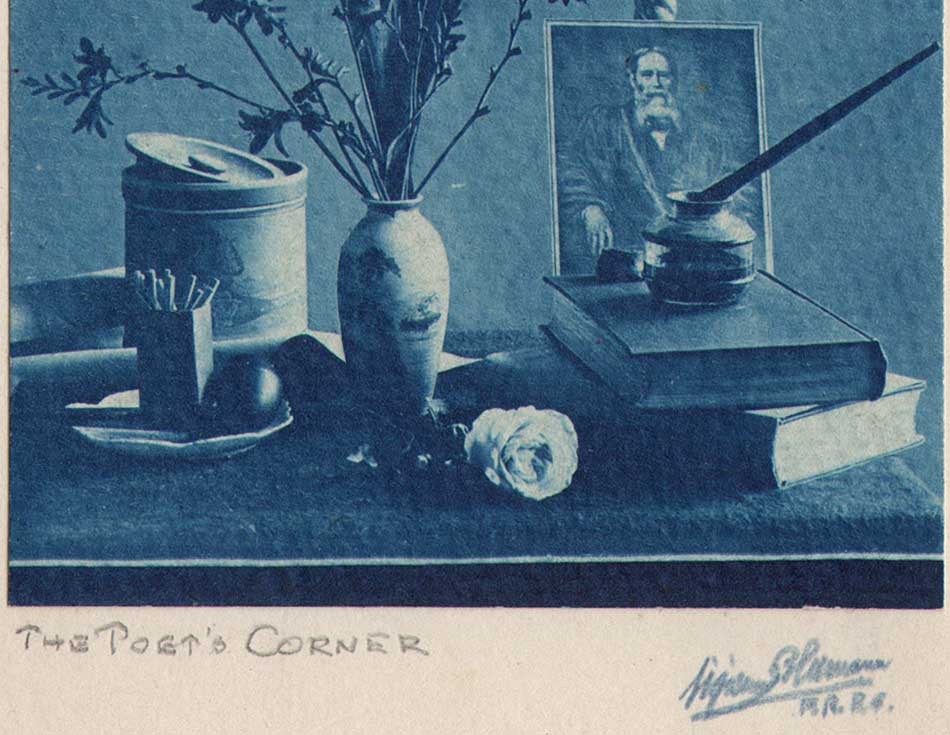 Detail: "The Poet's Corner" or "The Quiet Corner": Sigismund Blumann, American: 1933 or later: toned pigment print: 10.6 x 7.5 | 16.9 x 11.6 cm: The author's trusty pipe can be seen at left in this still-life table top study reproduced as the frontis halftone illustration for the August, 1927 issue of Camera Craft. From: PhotoSeed Archive
Detail: "The Poet's Corner" or "The Quiet Corner": Sigismund Blumann, American: 1933 or later: toned pigment print: 10.6 x 7.5 | 16.9 x 11.6 cm: The author's trusty pipe can be seen at left in this still-life table top study reproduced as the frontis halftone illustration for the August, 1927 issue of Camera Craft. From: PhotoSeed Archive
NOTES:
1. see: Early Years in Photography: “Sigismund Blumann, California Editor and Photographer”, by Christian A. Peterson in History of Photography, vol. 26, no. 1. (Spring 2002) p. 59.
2. Ibid: in: Photo Art Monthly, 1933-40: p. 73
3. It would not be until July, 1934, in an updated version of this 1925 Camera Craft article on describing the process of turning photographs into dry point etchings in Photo-Art Monthly, that evidence of Fitzpatrick and Blumann being the same person would seem to be confirmed. In it, the illustrated example of Blumann’s credited photograph titled “Land’s End” is also shown reproduced into the converted dry point etching with credit given to Fitzpatrick. Editorially, it might seem odd to continue this pen-name fiction with Blumann even going to lengths to construct a suspect history in 1925 of “Fitzpatrick’s” own beginnings although the reason was most likely intended as another way of imparting education on a topic deemed worthy and educational enough in the eyes and mind of the editor himself.
4. Copies of at least 43 documentary photographs, with several corresponding paper negative envelopes dated 1901 by Sigismund Bluman, were donated by his family to the California Historical Society where they can be viewed as part of the collection “The Chinese in California: 1850-1925.” The following link includes a smaller sampling of later printed examples, (some hand-colored) along with a rare surviving example titled “Ruin” (a detail included with this post) from 1906 of earthquake damage taken by the photographer as well as several portraits of Sig taken by others.
5. see: citation #1: p. 54.
6. excerpt: introduction: Making Photographs Into Dry Point Etchings: by Charles H. Fitzpatrick Illustrated by the Author: in: Camera Craft: October, 1925: San Francisco: p. 485.
7. see: citation #1 p. 54
8. Ibid: introduction: p. 53
9. American Prohibition was a nationwide constitutional ban on the sale, production, importation, and transportation of alcoholic beverages.
10. see: citation #1 p. 65
11. In order to make one of these etchings, the article instructs that after first selecting a printed photograph with little detail, the next step is to: “draw as much as he can on the photograph, using Higgins’ Water Proof India Ink. When this is absolutely dry the silver is completely bleached out with Bichloride of Mercury or Iodine-Iodide bleachers. The pen shading and finishing is then done with care, when the bleached and washed print has been dried.” From here, the article states a copy negative must then be made which is used to make the final second-generation finished (and reduced for effect) “etchings” using various grades of photographic paper: “The method of reproducing drawings is very simple. Place drawing on wall or easel and camera on firm support exactly centering lens on drawing, making exposure on a slow copy plate by diffused daylight or electric light, and develop for contrast. In copying it is advisable to reduce the image one-third smaller than the original as a finer line is thus secured which improves the finished print. The writer prefers a buff stock, matt paper of medium grade and heavy; and has found Vitava E just right: This is a matter of choice, however, as good prints may be secured on Azo, Velox, Cyco, Kruxo, Defender, Haloid, Barston, Charcoal Black or other matt papers. Proceed as in ordinary photographic printing then tone by re-development, using whatever process you prefer. I use Royal-Re-developer with pleasing results.” In the later 1934 article: “Etchings From and With Photographs”, “Fitzpatrick”goes further in depth on this etching process, adding that after the second-generation reduced copy print is made, the print could be “treated through all the usual solutions in the usual way and may be developed in any of the prescribed formulae for blue-black, jet-black, warm-black, or dark brown tones. Or it may be subsequently toned by the bleach and redevelop methods. The particular brown of an etching is easily gotten on Vitava Athena with a developer containing Athenon. Azo P-2 or 3, Vitava Athena E, Novira in the matt smooth or rough are all fine for the purpose. Gevalux gives a wonderful image in a true carbon black color and velvet crayon patine.” Continuing, the article offers a summary of the entire process: “That is all there is to the whole thing. You could not complicate it if you tried. Just make an enlargement, work on it with pen and ink, bleach out the silver leaving the ink image, photograph the line drawing, make as many etching-prints from the copy negative as you wish. Where can you go wrong? How can you fail?” He concludes by saying the maker of these etchings could also go “one step further by using hand-sensitized photographic papers for this final second-generation completed “etching”: “Furthermore, should you desire to print on colored papers or card- board of such surface as cannot be bought ready sensitized it will be a simple matter to sensitize any stock with the well known Blue Print solutions, or if the various shades of brown and black are wanted to resort to Kallitype. These processes are as cheap as they are easy to compound and use; they work on any paper not too saturated with chlorides or unfixed dyes. Kallitype is moreover a beautiful process in itself and prints endure according to the care in making them.”
A Merry Christmas to All
Posted December 2015 in Engraving, Painters|Photographers, PhotoSeed, Publishing, Typography
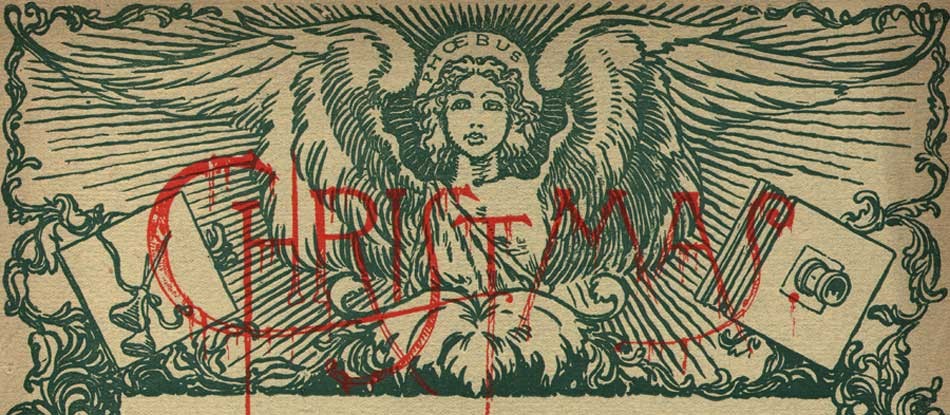 Detail: "Phoebus": by George Wharton Edwards: American 1859-1950: multiple-color woodcut used as part of cover illustration for periodical "Sun & Shade": New York: December, 1890: whole #28: N.Y. Photo-Gravure Co.: 32.1 x 25.3 cm | 35.3 x 28.0 cm: from: PhotoSeed Archive
Detail: "Phoebus": by George Wharton Edwards: American 1859-1950: multiple-color woodcut used as part of cover illustration for periodical "Sun & Shade": New York: December, 1890: whole #28: N.Y. Photo-Gravure Co.: 32.1 x 25.3 cm | 35.3 x 28.0 cm: from: PhotoSeed Archive
 "Christmas Eve": by Sir John Everett Millais: English 1829-1896: photogravure published in periodical "Sun & Shade": New York: December, 1890: whole #28: N.Y. Photo-Gravure Co.: 19.2 x 15.7 cm | 34.9 x 27.2 cm: from: PhotoSeed Archive
"Christmas Eve": by Sir John Everett Millais: English 1829-1896: photogravure published in periodical "Sun & Shade": New York: December, 1890: whole #28: N.Y. Photo-Gravure Co.: 19.2 x 15.7 cm | 34.9 x 27.2 cm: from: PhotoSeed Archive
 Detail: "A Merry Christmas": Emilie V. Clarkson: American 1863-1946: photogravure published in periodical "Sun & Shade": New York: December, 1890: whole #28: N.Y. Photo-Gravure Co.: 20.1 x 14.5 cm | 34.9 x 27.2 cm: from: PhotoSeed Archive
Detail: "A Merry Christmas": Emilie V. Clarkson: American 1863-1946: photogravure published in periodical "Sun & Shade": New York: December, 1890: whole #28: N.Y. Photo-Gravure Co.: 20.1 x 14.5 cm | 34.9 x 27.2 cm: from: PhotoSeed Archive
 Detail: "We Praise Thee O Lord" ("Sang with many a change Christmas carols until morn.": Emilie V. Clarkson: American 1863-1946: photogravure published in periodical "Sun & Shade": New York: December, 1890: whole #28: N.Y. Photo-Gravure Co.: 20.0 x 15.5 cm | 34.9 x 27.2 cm: from: PhotoSeed Archive
Detail: "We Praise Thee O Lord" ("Sang with many a change Christmas carols until morn.": Emilie V. Clarkson: American 1863-1946: photogravure published in periodical "Sun & Shade": New York: December, 1890: whole #28: N.Y. Photo-Gravure Co.: 20.0 x 15.5 cm | 34.9 x 27.2 cm: from: PhotoSeed Archive
 Detail: "Christmas Morning by the Sea" (alt: Winter's Touch on Land And Sea": Mrs. J.M. Appleton: American: photogravure published in periodical "Sun & Shade": New York: December, 1890: whole #28: N.Y. Photo-Gravure Co.: 10.5 x 16.1 cm | 34.9 x 27.2 cm: from: PhotoSeed Archive
Detail: "Christmas Morning by the Sea" (alt: Winter's Touch on Land And Sea": Mrs. J.M. Appleton: American: photogravure published in periodical "Sun & Shade": New York: December, 1890: whole #28: N.Y. Photo-Gravure Co.: 10.5 x 16.1 cm | 34.9 x 27.2 cm: from: PhotoSeed Archive
Oh, Dear, My Thanksgiving Dinner!
Posted November 2015 in New Additions, Publishing
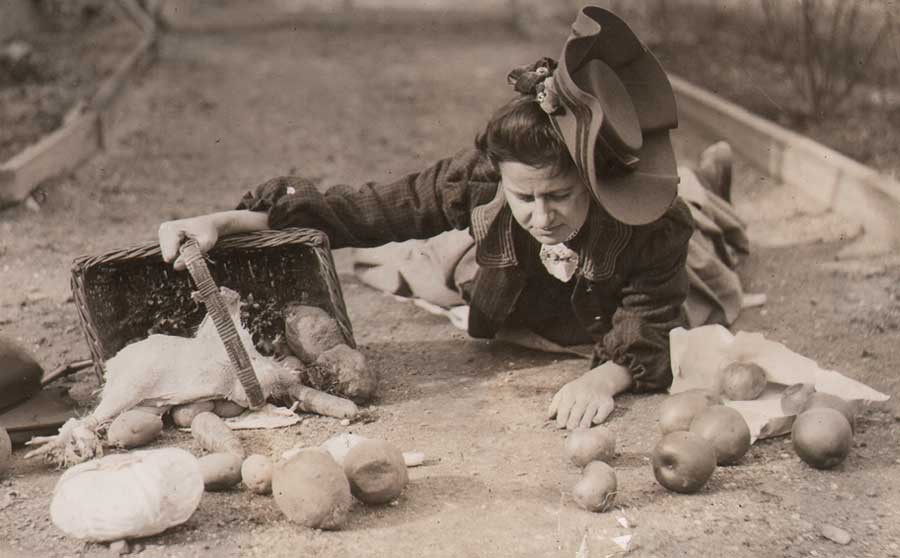 Detail: "Oh, Dear, My Thanksgiving Dinner!" c. 1907 by Jeanette Bernard: American, born Germany: (1855-1941) gelatin silver print c. 1935-40 from original glass plate negative acquired by Culver Service : 15.6 x 20.0 cm: from PhotoSeed Archive
Detail: "Oh, Dear, My Thanksgiving Dinner!" c. 1907 by Jeanette Bernard: American, born Germany: (1855-1941) gelatin silver print c. 1935-40 from original glass plate negative acquired by Culver Service : 15.6 x 20.0 cm: from PhotoSeed Archive
Hope & Yearning for Light
Posted October 2015 in Alternate Processes, Painters|Photographers, Publishing
Photography up to our modern day is by definition “Drawing with Light”, whereby the permanent recording of an object is achieved via electronic or chemical action. Simplistically this makes sense, but in order to make the outcome relevant and interesting enough to matter, especially in our visually overloaded present, practitioners to put it mildly need to include a bit of heart and soul into their efforts.
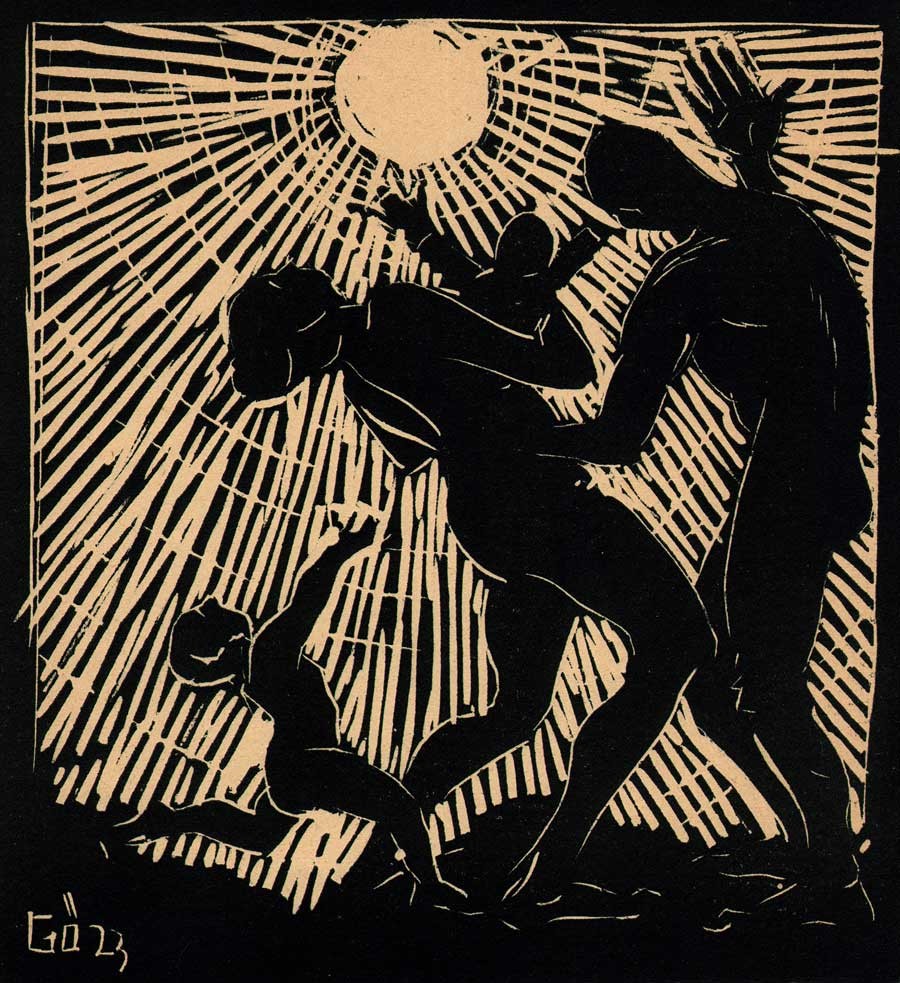 Detail: Linoleum cut: "Family in an Explosion of Light" : (20.5 x 18.8 cm impression | 28.9 x 25.0 cm paper) 1925 print by Emery Gondor, American (b. Hungary) : included in unpublished folio: "Sehnsucht nach Licht" (Yearning for Light) : "8 Original Linoleum schnitte von Emerich Göndör" (8 original Linoleum cuts by Emerich Göndör) from: PhotoSeed Archive
Detail: Linoleum cut: "Family in an Explosion of Light" : (20.5 x 18.8 cm impression | 28.9 x 25.0 cm paper) 1925 print by Emery Gondor, American (b. Hungary) : included in unpublished folio: "Sehnsucht nach Licht" (Yearning for Light) : "8 Original Linoleum schnitte von Emerich Göndör" (8 original Linoleum cuts by Emerich Göndör) from: PhotoSeed Archive
Emery Gondor (Emerich Göndör: 1896-1977) had these last two qualities in abundance. A Hungarian artist of prodigious talent who worked in multiple artistic disciplines including photography, the recent acquisition by this archive of some of his signed 1925 linocuts prove a teachable moment for why the manipulations of light and dark in another medium are instructive for creative souls in the present.
Some background, including the reality and history of turbulence in early 20th Century Europe, are critical to our understanding in how artists like Gondor could not be defeated by hatred which destroyed millions of lives and split apart society’s fabric there.
Indeed, his empathy for those shattered lives were taken to heart in the aftermath of his three and a half year service as a soldier in World War I which changed his life forever. Combined with his interest in progressive art education for children discovered in the early 1920’s while attending Vienna’s Academy of Industrial Arts and his work with emotionally disturbed children at the University Clinic there gave him an outlet and purpose for artistic expression, and would culminate towards the end of his career in the 1960’s as director of the art program at the Institute for Mental Retardation at New York Medical College (today : Westchester Institute for Human Development) after earning a degree in Clinical Psychology from New York State University. (1.)
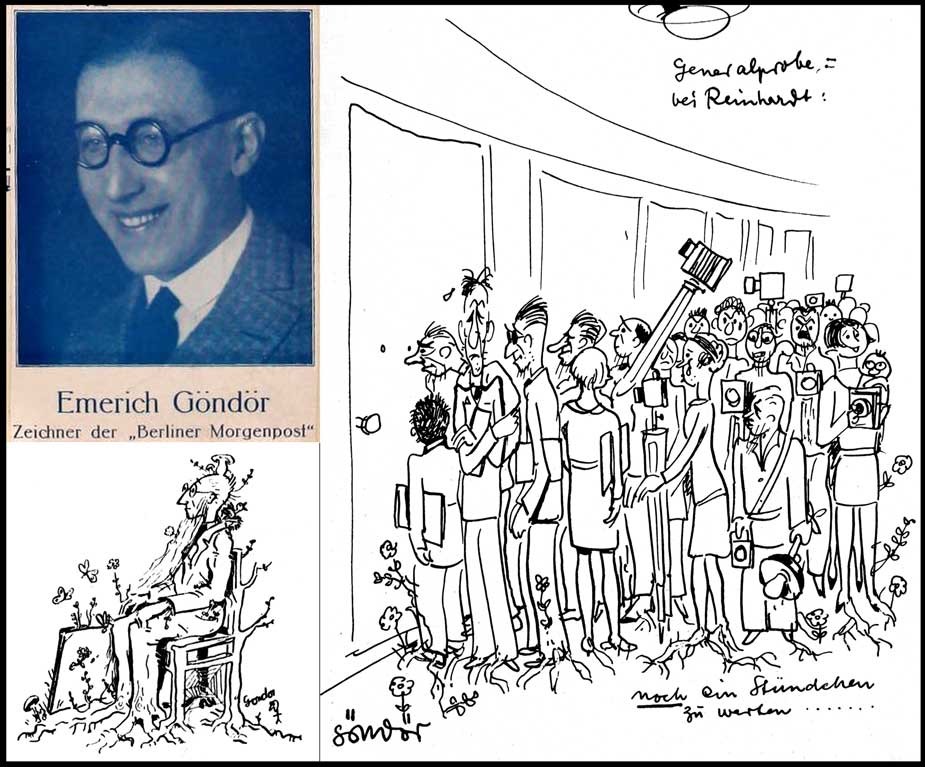 Upper left: 1929 photograph of Emery Gondor when employed as artist for Berliner Morgenpost newspaper in Germany. Bottom left: humorous caricature from early 1920's shows the artist seated with legs growing into the ground like roots. His cartoon poking fun at an interminable wait to see an editor at Berlin's Ullstein Verlag publishing house earned him a twelve year career there, where he excelled in multiple artistic disciplines including press photography with theatre subjects a specialty. Right: cartoon titled "Generalprobe bei Reinhardt" (Rehearsal at the Reinhardt) shows the artist (first figure standing at left wearing glasses) along with other members of the press waiting outside the Deutsches Theater to be let in for a press review. The drawing appeared in the May, 1930 issue of Blätter Des Deutschen Theaters. (Journal of the German Theater of Berlin) Surreally, the first name in a contributing, alphabetical list of well known actors, artists, writers and composers for the issue was Benno von Arent, an art director and production designer who became a ranking member of the Nazi SS responsible for art, theatres and cinema for Hitler. sources: portrait and theatre cartoon: Series V: Clippings and Scrapbooks, 1909-1935: Emery and Bertalan Gondor Collection; Leo Baeck Institute; lower left: illustration from graphic arts journal PM, 1936: New York: "Mr. Gondor comes to America".
Upper left: 1929 photograph of Emery Gondor when employed as artist for Berliner Morgenpost newspaper in Germany. Bottom left: humorous caricature from early 1920's shows the artist seated with legs growing into the ground like roots. His cartoon poking fun at an interminable wait to see an editor at Berlin's Ullstein Verlag publishing house earned him a twelve year career there, where he excelled in multiple artistic disciplines including press photography with theatre subjects a specialty. Right: cartoon titled "Generalprobe bei Reinhardt" (Rehearsal at the Reinhardt) shows the artist (first figure standing at left wearing glasses) along with other members of the press waiting outside the Deutsches Theater to be let in for a press review. The drawing appeared in the May, 1930 issue of Blätter Des Deutschen Theaters. (Journal of the German Theater of Berlin) Surreally, the first name in a contributing, alphabetical list of well known actors, artists, writers and composers for the issue was Benno von Arent, an art director and production designer who became a ranking member of the Nazi SS responsible for art, theatres and cinema for Hitler. sources: portrait and theatre cartoon: Series V: Clippings and Scrapbooks, 1909-1935: Emery and Bertalan Gondor Collection; Leo Baeck Institute; lower left: illustration from graphic arts journal PM, 1936: New York: "Mr. Gondor comes to America".
In an 1936 artist profile published in the graphic arts journal PM Magazine soon after his immigration to the United States from Europe, Emery Gondor writes:
”But my real interest and love is children. I illustrated many children’s books for the “Union Verlag” Stuttgart, the biggest children’s publishing house, and other youth-publications.” …I made up many hundreds of games for children, puzzles for adults, comic strips. I exhibited again and wrote many articles about humorous observations of children. I always received hundreds of fan letters from my children friends.” (2.)
The Germinal Circle
As a young artist living and just getting by in Vienna after WWI, Gondor did not shy away from progressive ideas as well as the opportunity to sell his original artwork while promoting himself. Traveling to London in late 1923, he did live caricature sketches of poems read aloud by their authors on November 5th and 23rd as an invited guest of the Germinal Circle. Organized by the Italian anarchist Silvio Corio and his lover Sylvia Pankhurst, a like-minded British writer whose mother Emmeline Pankhurst was the leader of the British suffragette movement, the circle was an artistic and literary salon for their short-lived political and cultural monthly magazine Germinal founded the same year. (3.)
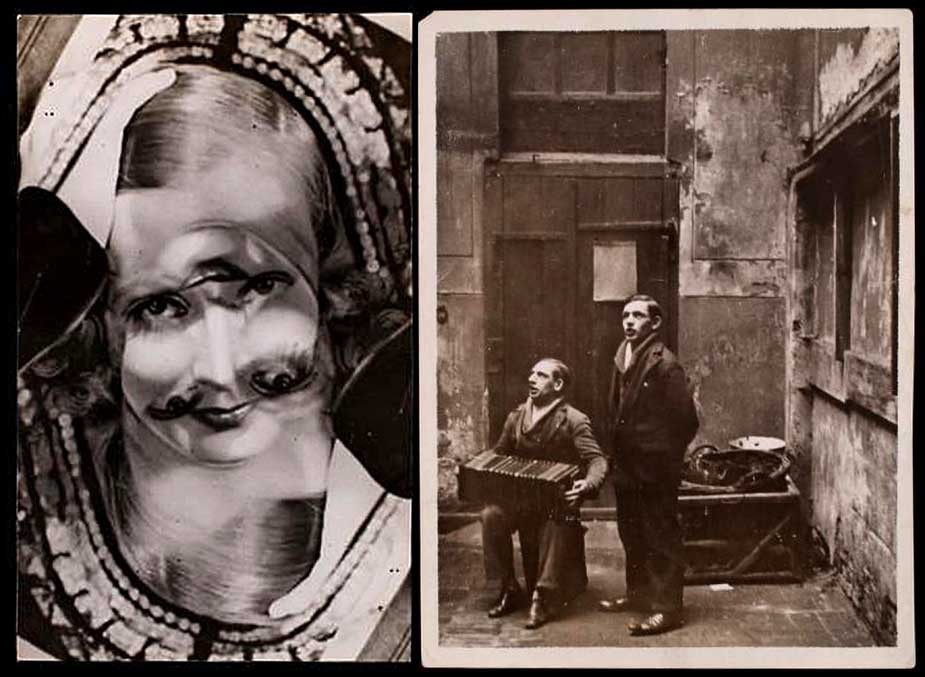 Although better known as an artist, Emery Gondor was an accomplished photographer whose work appeared in some of the largest European newspapers (principally German) from the mid 1920's into the 1930's. Work contained in his archive at the Leo Baeck Institute in New York City shows a talent equally adept at documentary in addition to staged subject matter including theatrical. Hartmuth Merleker, his former editor at the Ullstein newspapers Tempo and Berliner Montagspost, describes Gondor as not only an artist but a press photographer for the publications between 1929-1933. After learning his grandfather was a lithographer and father an engraver, an excerpt from his 1936 profile by the artist states further on the subject of photography: "I have always had an interest in the problems of reproduction technique. I learned press-photography too. In a short time I learned all the chemical and technical details. I worked one year for the "B.Z. am Mittag," the quickest German daily paper, as press photographer, and in accordance with my plan Ullstein built eight dark rooms for their daily paper photo service." Photographs by Gondor shown here: left: photomontage likely from the late 1920's of a theatrical subject. It likely appeared in one of Ullstein's German publications. Right: documentary subject of street musicians from early 1930's Europe or possibly 1940's New York; with Gondor's red-ink New York City stamp on print verso. Sources for both: Emery I. Gondor Collection; AR 25397; Box 2; Folder #49; Leo Baeck Institute.
Although better known as an artist, Emery Gondor was an accomplished photographer whose work appeared in some of the largest European newspapers (principally German) from the mid 1920's into the 1930's. Work contained in his archive at the Leo Baeck Institute in New York City shows a talent equally adept at documentary in addition to staged subject matter including theatrical. Hartmuth Merleker, his former editor at the Ullstein newspapers Tempo and Berliner Montagspost, describes Gondor as not only an artist but a press photographer for the publications between 1929-1933. After learning his grandfather was a lithographer and father an engraver, an excerpt from his 1936 profile by the artist states further on the subject of photography: "I have always had an interest in the problems of reproduction technique. I learned press-photography too. In a short time I learned all the chemical and technical details. I worked one year for the "B.Z. am Mittag," the quickest German daily paper, as press photographer, and in accordance with my plan Ullstein built eight dark rooms for their daily paper photo service." Photographs by Gondor shown here: left: photomontage likely from the late 1920's of a theatrical subject. It likely appeared in one of Ullstein's German publications. Right: documentary subject of street musicians from early 1930's Europe or possibly 1940's New York; with Gondor's red-ink New York City stamp on print verso. Sources for both: Emery I. Gondor Collection; AR 25397; Box 2; Folder #49; Leo Baeck Institute.
Several of Gondor’s original linocuts, including one incorporated into an advertisement showing a figure with outstretched arms standing next to a grouping of over-sized flowers facing emanating sun rays were reproduced as part of promotional literature in Germinal. The artist from this period is described in a typescript document held with the reproduction in the library of the Leo Baeck Institute in New York City:
The Germinal Circle has pleasure in introducing the work of Emerich Gondor, a young Hungarian artist, who has not previously exhibited in this country. A rapid caricaturist and cartoonist, he works with equal facility through lithography, wood-cuts, lino-cuts and many other mediums. (4.)
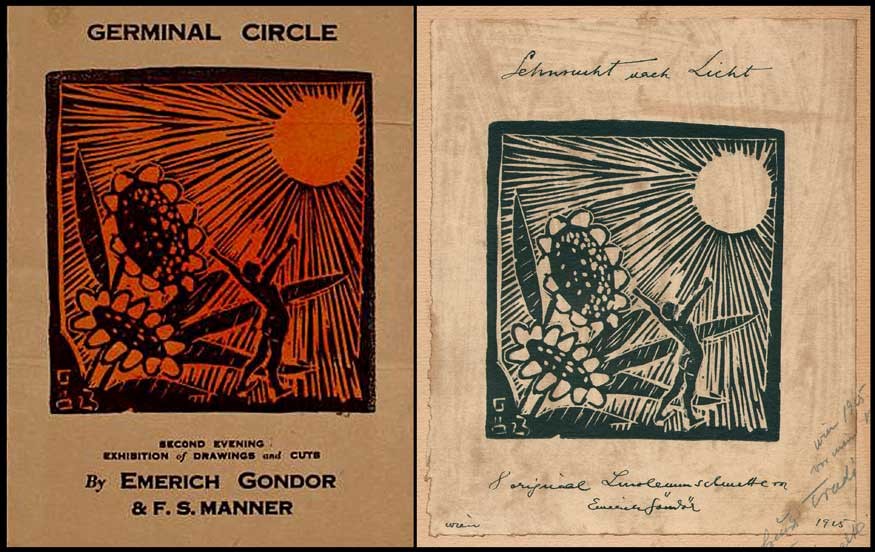 Left: detail: 1923 linoleum cut in two colors by Emery Gondor used as program advertisement for the Germinal Circle art salon's "Second Evening Exhibition of Drawings and Cuts which took place at the Ashburton Restaurant in London on November 28, 1923. source: Emery and Bertalan Gondor Collection; Leo Baeck Institute. Right: detail: same illustration with impression pulled in 1925 (20.5 x 18.8 cm ) used as cover maquette for Gondor's unpublished folio: "Sehnsucht nach Licht" (Yearning for Light) : "8 Original Linoleum schnitte von Emerich Göndör" (8 original Linoleum cuts by Emerich Göndör) from: PhotoSeed Archive
Left: detail: 1923 linoleum cut in two colors by Emery Gondor used as program advertisement for the Germinal Circle art salon's "Second Evening Exhibition of Drawings and Cuts which took place at the Ashburton Restaurant in London on November 28, 1923. source: Emery and Bertalan Gondor Collection; Leo Baeck Institute. Right: detail: same illustration with impression pulled in 1925 (20.5 x 18.8 cm ) used as cover maquette for Gondor's unpublished folio: "Sehnsucht nach Licht" (Yearning for Light) : "8 Original Linoleum schnitte von Emerich Göndör" (8 original Linoleum cuts by Emerich Göndör) from: PhotoSeed Archive
Sehnsucht nach Licht: Yearning for Light
Emery Gondor’s style in his surviving linoleum cuts from the early 1920’s were certainly influenced by the German Expressionists, and of the heartbreak and for many, hope in the aftermath of the first World War. With emotional joy and pathos rendered in exaggerated strokes of light and dark, the symbolism of the sun and its streaming rays reaching out to embrace humankind is duly represented by his hopeful thematic subjects among others including a family, baby, old man, a blind man, and prisoner locked in a cell as well as the artist himself in signed impressions, several of which are seen here.
The original 1925 cover maquette linoleum cut by Gondor, featuring the aforementioned figure with outstretched arms, has the hopeful title Sehnsucht nach Licht . (Yearning for Light) Featuring eight original linoleum cuts with the themes outlined above, the work is not believed to have been published other than several copies, although seven of the eight plates as well as the maquette can be found here on this website as well as the full compliment and other examples of Gondor’s artwork from his career at the Baeck Institute online site.
 Detail: Linoleum cut: "Old Prisoner gazing at the Light" : (20.0 x 18.7 cm impression | 28.5 x 25.0 cm paper) 1925 print by Emery Gondor, American (b. Hungary) : included in unpublished folio: "Sehnsucht nach Licht" (Yearning for Light) : "8 Original Linoleum schnitte von Emerich Göndör" (8 original Linoleum cuts by Emerich Göndör) from: PhotoSeed Archive
Detail: Linoleum cut: "Old Prisoner gazing at the Light" : (20.0 x 18.7 cm impression | 28.5 x 25.0 cm paper) 1925 print by Emery Gondor, American (b. Hungary) : included in unpublished folio: "Sehnsucht nach Licht" (Yearning for Light) : "8 Original Linoleum schnitte von Emerich Göndör" (8 original Linoleum cuts by Emerich Göndör) from: PhotoSeed Archive
Sobering, but Necessary
Eventually, Gondor’s talents paid off. Besides honed artistic chops, abundant energy, charisma and a sunny disposition as evidenced by his ever-present smile seen in surviving photographs, he attained the title of Art Director for the Ullstein Verlag publishing house of Berlin, the largest concern in Europe. But then in 1933, the Nazis came, he wrote in the 1936 PM profile, and everything changed and was lost. In September of 1935, Gondor’s former editor Hartmuth Merleker of the Ullstein newspapers Tempo and Berliner Montagspost wrote a glowing review of his talents which spoke of this fine character giving him the needed credibility in the eyes of German authorities and the right to emigrate for his new life in America:
”He worked mainly as comic and propaganda artist and as a theater photographer and absolved himself to everyone’s satisfaction. He tactfully refrained from attending any non-artistic, non-photographic activities, and as a Hungarian citizen was never known to abuse the right to hospitality he enjoyed in Germany to Germany’s disadvantage.” (5.)
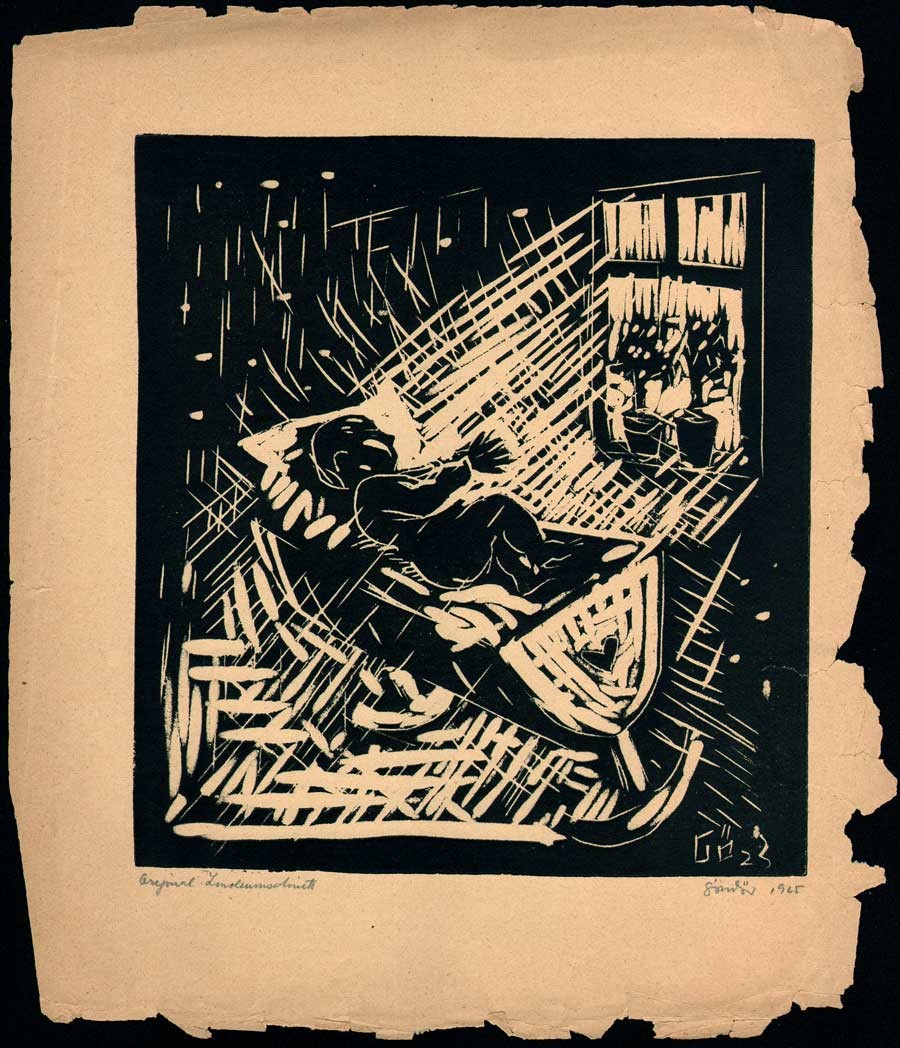 Linoleum cut: "Child in an Explosion of Light" : (20.5 x 18.8 cm impression | 28.9 x 24.8 paper) 1925 print by Emery Gondor, American (b. Hungary) : included in unpublished folio: "Sehnsucht nach Licht" (Yearning for Light) : "8 Original Linoleum schnitte von Emerich Göndör" (8 original Linoleum cuts by Emerich Göndör) from: PhotoSeed Archive
Linoleum cut: "Child in an Explosion of Light" : (20.5 x 18.8 cm impression | 28.9 x 24.8 paper) 1925 print by Emery Gondor, American (b. Hungary) : included in unpublished folio: "Sehnsucht nach Licht" (Yearning for Light) : "8 Original Linoleum schnitte von Emerich Göndör" (8 original Linoleum cuts by Emerich Göndör) from: PhotoSeed Archive
Sobering in hindsight of course. What true artist in their own mind could “tactfully refrain from “any non-artistic, non-photographic activities” during the course of his or her work? Fortunately for us, Emery Gondor had a bit of luck going his way as well, with earlier examples of his artistic legacy preserved here for posterity and later career achievements benefiting those children he helped and inspired a testament to the abundant light emanating from his own oversized heart and soul.
David Spencer- October, 2015
Notes:
1. background: Emery Gondor: Biographical/Historical Note: from: Emery I. Gondor Collection: Leo Baeck Institute online archive accessed Oct. 2015. In Gondor’s 1954 application to publisher Doubleday for his book Art and Play Therapy published the same year, it stated he “is a sensitive clinician of long and varied experience. Early in his career he had no intention of becoming a psychologist or psychotherapist, but began as an artist and teacher of art after attending the Royal Hungarian University and receiving his diplomas from the Federal Academy of Art in Budapest. As a young art teacher, however, he was faced with the misery of children who suffered tremendously during and after the first World War, and felt that he had to understand more about their problems in order to be able to help them. Thus began his interest in the study of psychology.”
2. PM: 1936: Mr. Gondor comes to America: p. 7
3. Germinal, a quarto monthly ran for two issues in July, 1923 and one other unknown issue published in 1924. “This illustrated journal published fiction by Gorky, drama by Ernest Toller, poetry by Alexander Blok, by Anna Akhmatova and by Pankhurst.” see: Morag Shiach: Modernism, Labour and Selfhood in British Literature and Culture, 1890-1930: Sylvia Pankhurst: labour and representation: 2004: p. 103
4. see: The Germinal Circle: Leo Baeck Institute Archives: New York: Folder 1/16: Call number AR 25397
5. translated, hand-written copy of Sept 7, 1935 letter by editor Hartmuth Merleker contained in Leo Baeck Institute online archives.